-
 Title (black and red): ANTIQUITATES CHRISTIANÆ: |—| OR, THE | HISTORY | OF THE | LIFE AND DEATH | OF THE | HOLY JESUS: | AS ALSO THE Lives, Acts and Martyrdoms | OF HIS | APOSTLES. |—| IN TWO PARTS. |—| The Firƒt Part, containing The Life of CHRIST, written by | Jer. Taylor, Late Lord Bishop of Down and Connor. | The Second, Containing The Lives of the APOSTLES, with an | Enumeration, and ƒome Brief Remarks upon their firƒt Successors in | the Five Great APOSTOLICAL CHURCHES, | By WILLIAM CAVE, D. D. Chaplain in | Ordinary to His MAJESTY. | By whom alƒo is added an APPARATUS, or Diƒcourƒe Introductory to the whole Work, | concerning the Three Great Diƒpenƒations of the Church, Patriarchal, Moƒaical, and Evangelical. |—| THE EIGHTH EDITION. |—| Orig. contr. Celƒ. lib. 1. in Proœm. p. 1, 2. | [text in Greek] |—| LONDON, | Printed by R. N. for Luke Meredith, at the Sign of the Star in | St. Paul's Church-Yard, MDCXCIV. Collation of this book is unusual, it is called "Folio in 6s" (three sheets are folded in half to create a gathering of 6 leaves). Two unsigned leaves: (1) Engraved frontispiece "The Annunciation" by Willian Faithorne "the Elder" (British, 1616 – 1691), recto blank; (2) engraved title by the same engraver, verso blank; (*) gathering of 4: black and red title page, verso blank; epistle; to reader; imprim. (A6 to Sƒ6) Engraved portrait of Jeremy Taylor by Pierre Lombart (French, 1612 – 1682); faux title page: "The Great Exemplar of Sanctity and Holy Life... MDCXCIII"; dedication; contents, then to the end of the first book. (A-Z4 Aa-Bb4 Cc2) The second book has collation in quarto: Faux title page: "Antiquitates Christianæ: or the Lives, Acts and Martyrdoms... MDCXCIV", etc. to the end. Full formula: π2 *4 a-c6 d8 A-Z6 Aa-Sƒ6 A-Z4 Aa-Bb4 Cc2 Pagination: [12] I-LI [LII] [12] I-XXVIII, i-vi, (1st book): [2] I-145 [146-150] 151-432 [12]; (2nd book): [8] i-xiv, 1-188. 22 plates : frontis., t.p., portrait, one folding before p. 65, two after pp. [146], [150], 282, 304, 364, 386, 414, [422], and numerous head-pieces. Size: 36 x 23.5 x 5.7 cm Binding: full calf with the later spine, raised bands; front board with remnants of gilt ruling and blind stamped border, back bord probably original with a blind-stamped centre panel with fleurons.
Title (black and red): ANTIQUITATES CHRISTIANÆ: |—| OR, THE | HISTORY | OF THE | LIFE AND DEATH | OF THE | HOLY JESUS: | AS ALSO THE Lives, Acts and Martyrdoms | OF HIS | APOSTLES. |—| IN TWO PARTS. |—| The Firƒt Part, containing The Life of CHRIST, written by | Jer. Taylor, Late Lord Bishop of Down and Connor. | The Second, Containing The Lives of the APOSTLES, with an | Enumeration, and ƒome Brief Remarks upon their firƒt Successors in | the Five Great APOSTOLICAL CHURCHES, | By WILLIAM CAVE, D. D. Chaplain in | Ordinary to His MAJESTY. | By whom alƒo is added an APPARATUS, or Diƒcourƒe Introductory to the whole Work, | concerning the Three Great Diƒpenƒations of the Church, Patriarchal, Moƒaical, and Evangelical. |—| THE EIGHTH EDITION. |—| Orig. contr. Celƒ. lib. 1. in Proœm. p. 1, 2. | [text in Greek] |—| LONDON, | Printed by R. N. for Luke Meredith, at the Sign of the Star in | St. Paul's Church-Yard, MDCXCIV. Collation of this book is unusual, it is called "Folio in 6s" (three sheets are folded in half to create a gathering of 6 leaves). Two unsigned leaves: (1) Engraved frontispiece "The Annunciation" by Willian Faithorne "the Elder" (British, 1616 – 1691), recto blank; (2) engraved title by the same engraver, verso blank; (*) gathering of 4: black and red title page, verso blank; epistle; to reader; imprim. (A6 to Sƒ6) Engraved portrait of Jeremy Taylor by Pierre Lombart (French, 1612 – 1682); faux title page: "The Great Exemplar of Sanctity and Holy Life... MDCXCIII"; dedication; contents, then to the end of the first book. (A-Z4 Aa-Bb4 Cc2) The second book has collation in quarto: Faux title page: "Antiquitates Christianæ: or the Lives, Acts and Martyrdoms... MDCXCIV", etc. to the end. Full formula: π2 *4 a-c6 d8 A-Z6 Aa-Sƒ6 A-Z4 Aa-Bb4 Cc2 Pagination: [12] I-LI [LII] [12] I-XXVIII, i-vi, (1st book): [2] I-145 [146-150] 151-432 [12]; (2nd book): [8] i-xiv, 1-188. 22 plates : frontis., t.p., portrait, one folding before p. 65, two after pp. [146], [150], 282, 304, 364, 386, 414, [422], and numerous head-pieces. Size: 36 x 23.5 x 5.7 cm Binding: full calf with the later spine, raised bands; front board with remnants of gilt ruling and blind stamped border, back bord probably original with a blind-stamped centre panel with fleurons. -
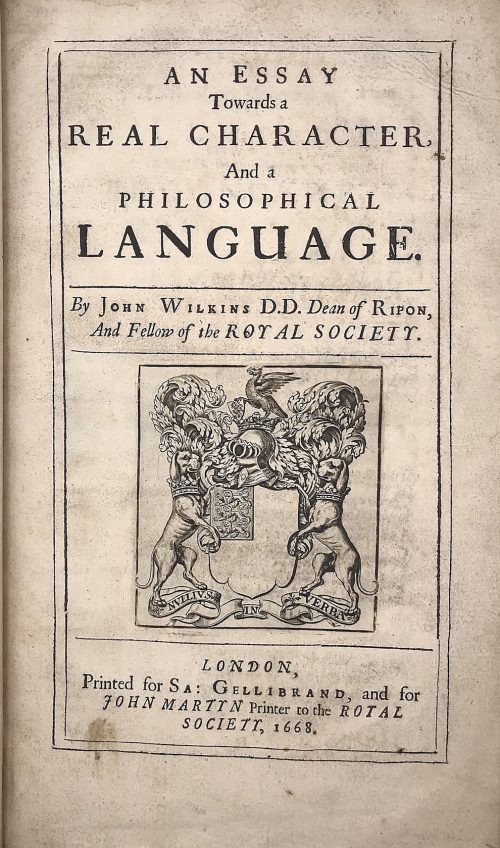 Title: AN ESSAY | Towards a | REAL CHARACTER, | And a | PHILOSOPHICAL | LANGUAGE. | By John Wilkins D.D. Dean of Ripon, | And Fellow of the ROYAL SOCIETY. |—| [armorial device] |—| LONDON, | Printed for Sa: Gellibrand, and for | JOHN MARTYN Printer to the ROYAL | SOCIETY, 1668. Pagination: [2] blank/order, [2] t.p./blank, [16], 1-454; + 79 leaves of Dictionary, unpaginated (158 pages); Illustrations: folding plates before pp. 167, 187, and two folding plates before p. 443. Collation: π2 a-d2 B-Z4 Aa-Zz4 Aaa-Lll4 Mmm3 aaa4 Aaa-Sss4 ttt3 Size: 4to, 32 x 20 x 5 cm; Binding: Full speckled calf, later polished calf spine with raised bands, double fillet ruled gilt compartments, crimson label with gilt lettering, margins sprinkled red. The work of John Wilkins is dedicated to the problem of the universal language. Wilkins was the Dean of Ripon from 1663 to 1672 and one of the founders of the Royal Society.
Title: AN ESSAY | Towards a | REAL CHARACTER, | And a | PHILOSOPHICAL | LANGUAGE. | By John Wilkins D.D. Dean of Ripon, | And Fellow of the ROYAL SOCIETY. |—| [armorial device] |—| LONDON, | Printed for Sa: Gellibrand, and for | JOHN MARTYN Printer to the ROYAL | SOCIETY, 1668. Pagination: [2] blank/order, [2] t.p./blank, [16], 1-454; + 79 leaves of Dictionary, unpaginated (158 pages); Illustrations: folding plates before pp. 167, 187, and two folding plates before p. 443. Collation: π2 a-d2 B-Z4 Aa-Zz4 Aaa-Lll4 Mmm3 aaa4 Aaa-Sss4 ttt3 Size: 4to, 32 x 20 x 5 cm; Binding: Full speckled calf, later polished calf spine with raised bands, double fillet ruled gilt compartments, crimson label with gilt lettering, margins sprinkled red. The work of John Wilkins is dedicated to the problem of the universal language. Wilkins was the Dean of Ripon from 1663 to 1672 and one of the founders of the Royal Society. -
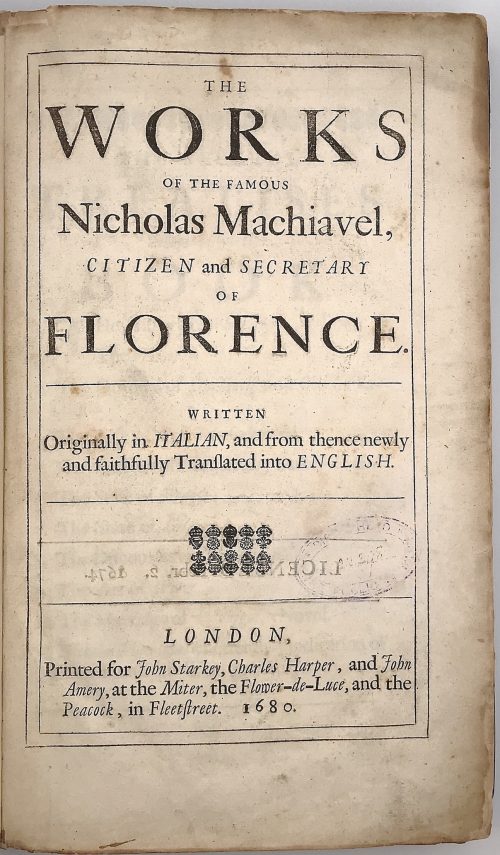 Title: THE | WORKS | OF THE FAMOUS | Nicholas Machiavel, | CITIZEN and SECRETARY | OF | FLORENCE. |—| WRITTEN | Originally in ITALIAN, and from thence newly | and faithfully Tranſlated into ENGLISH. |—|[ornament]|—| LONDON, | Printed for John Starkey, Charles Harper, and John | Amery, at the Miter, the Flower-de-Luce, and the | Peacock, in Fleetstreet. 1680. Content: (1) The history of Florence; (2) The Prince; (3) The Original of the Guelf and Ghibilin Factions; (4) The Life of Castruccio Castracani; (5) The Murther of Vitelli, etc. by Duke Valentino; (6) The State of France; (7) The State of Germany; (8) The Discourses on Titus Livius; (9) The Art of War; (10) The Marriage of Belphegor, a Novel; (11) Nicholas Machiavel's Letter in Vindication of Himself and His Writings. Pagination: ffl, 24 unnumbered pages before the first numbered: [2] – tp / license], [2] – contents / blank], [2] ftp “Florence” / blank, [3] – epistle to Clement VII, [3] – introduction, [12] – table; Misnumbering (X instead of Y format – X/Y): History of Florence: 1- 28/24, 19/91, 198/98, 180/108, 190/109, 174/164, 175/ 165, 179/169, 180/170, 185/175, 186/176, 188/178, 189/179, [190/180 blank]; The Prince, Lucca, State of France: [4] 199-262; State of Germany: 256/263, 266/264, 267/265 [268/266]; Discourses: [4] 267-314, 317-431 [432]; Art of War: [4] 433-528; [4] – publisher, [12] –Machiavelli’s letter, bfl. Collation: π3 Aa3 b-d2 B-Z4 Aa-Bb2 Cc-Zz4 Aaa-Yyy4 (*)-(**)4 Binding: Original mottled leather boards with embossing, later leather spine with 5 raised bands, crimson label with gilt lettering. Size: 32.4 x 21.0 x 4.0 cm Provenance: Bradford H. Gray This is the second edition; despite misnumbering, the collation is correct and all pages present. The first edition of this book was published in 1675 by Robert Bolter (British, fl. 1666 – 1683).
Title: THE | WORKS | OF THE FAMOUS | Nicholas Machiavel, | CITIZEN and SECRETARY | OF | FLORENCE. |—| WRITTEN | Originally in ITALIAN, and from thence newly | and faithfully Tranſlated into ENGLISH. |—|[ornament]|—| LONDON, | Printed for John Starkey, Charles Harper, and John | Amery, at the Miter, the Flower-de-Luce, and the | Peacock, in Fleetstreet. 1680. Content: (1) The history of Florence; (2) The Prince; (3) The Original of the Guelf and Ghibilin Factions; (4) The Life of Castruccio Castracani; (5) The Murther of Vitelli, etc. by Duke Valentino; (6) The State of France; (7) The State of Germany; (8) The Discourses on Titus Livius; (9) The Art of War; (10) The Marriage of Belphegor, a Novel; (11) Nicholas Machiavel's Letter in Vindication of Himself and His Writings. Pagination: ffl, 24 unnumbered pages before the first numbered: [2] – tp / license], [2] – contents / blank], [2] ftp “Florence” / blank, [3] – epistle to Clement VII, [3] – introduction, [12] – table; Misnumbering (X instead of Y format – X/Y): History of Florence: 1- 28/24, 19/91, 198/98, 180/108, 190/109, 174/164, 175/ 165, 179/169, 180/170, 185/175, 186/176, 188/178, 189/179, [190/180 blank]; The Prince, Lucca, State of France: [4] 199-262; State of Germany: 256/263, 266/264, 267/265 [268/266]; Discourses: [4] 267-314, 317-431 [432]; Art of War: [4] 433-528; [4] – publisher, [12] –Machiavelli’s letter, bfl. Collation: π3 Aa3 b-d2 B-Z4 Aa-Bb2 Cc-Zz4 Aaa-Yyy4 (*)-(**)4 Binding: Original mottled leather boards with embossing, later leather spine with 5 raised bands, crimson label with gilt lettering. Size: 32.4 x 21.0 x 4.0 cm Provenance: Bradford H. Gray This is the second edition; despite misnumbering, the collation is correct and all pages present. The first edition of this book was published in 1675 by Robert Bolter (British, fl. 1666 – 1683). -
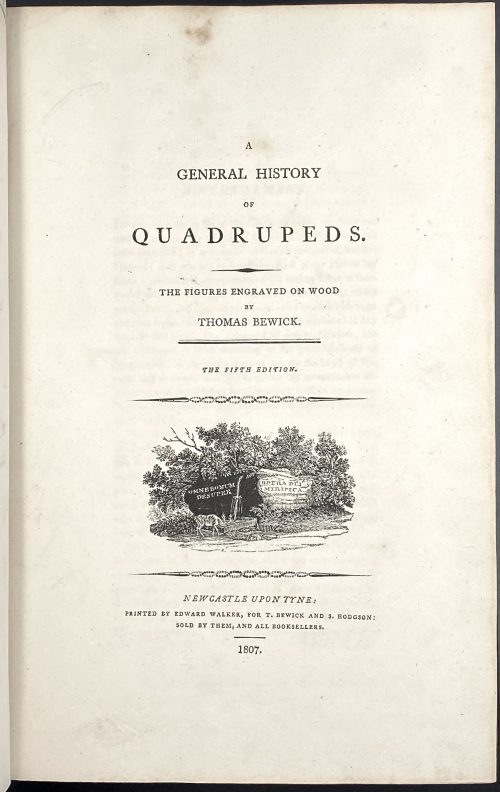 Title: A | GENERAL HISTORY | OF | QUADRUPEDS. | – | THE FIGURES ENGRAVED ON WOOD | BY | THOMAS BEWICK. | — | THE FIFTH EDITION | {vignette} | NEWCASTLE UPON TYNE: | PRINTED BY EDWARD WALKER, FOR T. BEWICK AND S. HODGSON: | SOLD BY THEM, AND ALL BOOKSELLERS. | 1807. Pagination: [2 blanks], [i, ii] – t.p. / blank], [iii, iv] – advertisement, [v] vi-x – index, [1] 2-525 [526 advert. of British Birds] [2 blanks]. Collation: Royal 8vo in fours; π (engraved title), a4 A-3T4 χ3T3. F2 signed 2F, 2E2 unsigned, p. 131 numbered correctly, p. 257 numbered 572. Size: 26 x 17 cm; page 24.5 x 16 cm (royal). Woodcuts: 302 descriptions of quadrupeds, 225 figures and 112 vignettes, tail-pieces, etc. Binding: Full diced brown calf, embossed blind corner fleurons, gilt-tooled border inside and outside, AEG, spine with raised bands, gilt in compartments, lettering; binding restored; armorial bookplate "Thorpe" to front pastedown. Likely to be Thomas Thorpe (1791 – 1851), a prominent bookseller in London: Bedford Street, Covent Garden; started in 1818, went bankrupt on Dec. 31, 1825. Thorpe's family coat of arms: stag standing on a crown and a lion rampant. Catalogue raisonné: S. Roscoe (1953): pp. 23-27. Hugo (1866): pp. 22-24.
Title: A | GENERAL HISTORY | OF | QUADRUPEDS. | – | THE FIGURES ENGRAVED ON WOOD | BY | THOMAS BEWICK. | — | THE FIFTH EDITION | {vignette} | NEWCASTLE UPON TYNE: | PRINTED BY EDWARD WALKER, FOR T. BEWICK AND S. HODGSON: | SOLD BY THEM, AND ALL BOOKSELLERS. | 1807. Pagination: [2 blanks], [i, ii] – t.p. / blank], [iii, iv] – advertisement, [v] vi-x – index, [1] 2-525 [526 advert. of British Birds] [2 blanks]. Collation: Royal 8vo in fours; π (engraved title), a4 A-3T4 χ3T3. F2 signed 2F, 2E2 unsigned, p. 131 numbered correctly, p. 257 numbered 572. Size: 26 x 17 cm; page 24.5 x 16 cm (royal). Woodcuts: 302 descriptions of quadrupeds, 225 figures and 112 vignettes, tail-pieces, etc. Binding: Full diced brown calf, embossed blind corner fleurons, gilt-tooled border inside and outside, AEG, spine with raised bands, gilt in compartments, lettering; binding restored; armorial bookplate "Thorpe" to front pastedown. Likely to be Thomas Thorpe (1791 – 1851), a prominent bookseller in London: Bedford Street, Covent Garden; started in 1818, went bankrupt on Dec. 31, 1825. Thorpe's family coat of arms: stag standing on a crown and a lion rampant. Catalogue raisonné: S. Roscoe (1953): pp. 23-27. Hugo (1866): pp. 22-24. -
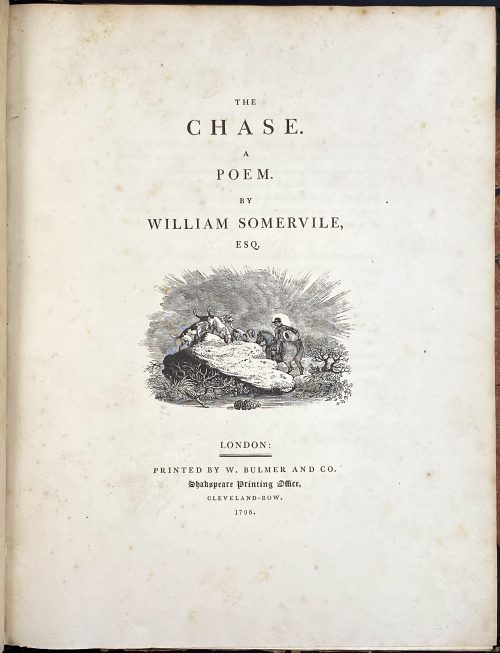 Royal 4to, 29.8 x 23.5 cm, contemporary half brown morocco, marbled boards gilt ruled, spine with gilt-ruled raised bands, gilt title lettering; "William Gore" armorial bookplate to front pastedown. Title page: THE | CHASE. | A | POEM. | BY | WILLIAM SOMERVILLE, | ESQ. | [VIGNETTE] | LONDON : | PRINTED BY W. BULMER AND CO. | Shakespeare Printing Office, | CLEVELAND-ROW. | 1796. Collation: without signatures. — Pagination: [i-v] vi-xv [xvi], [i] ii-vii [viii], [1-5] 6-126; illustrations: engraved title, 4 running titles, 4 headpieces, 4 tailpieces – 13 altogether, all drafted by John Bewick, 12 executed by Thomas Bewick and the last one by Charlton Nesbit. Catalogue Raisonné: Thomas Hugo. The Bewick Collector, vol. 1 (1866): p. 38, № 94: "The first edition... was printed in royal 4to". John Bewick made all the drawing on the blocks but was not able to execute the engravings himself "because of ill-health. They were engraved by Thomas Bewick, with the exception of the tail-piece at the end of the volume, which was engraved by Nesbit". Thomas Bewick (c. 11 August 1753 – 8 November 1828); John Bewick (1760 – 1795), the younger brother of Thomas, died at the age of 35. Christie's, who sold a similar copy on 29 Oct 2012, provides for the size 2°.
Royal 4to, 29.8 x 23.5 cm, contemporary half brown morocco, marbled boards gilt ruled, spine with gilt-ruled raised bands, gilt title lettering; "William Gore" armorial bookplate to front pastedown. Title page: THE | CHASE. | A | POEM. | BY | WILLIAM SOMERVILLE, | ESQ. | [VIGNETTE] | LONDON : | PRINTED BY W. BULMER AND CO. | Shakespeare Printing Office, | CLEVELAND-ROW. | 1796. Collation: without signatures. — Pagination: [i-v] vi-xv [xvi], [i] ii-vii [viii], [1-5] 6-126; illustrations: engraved title, 4 running titles, 4 headpieces, 4 tailpieces – 13 altogether, all drafted by John Bewick, 12 executed by Thomas Bewick and the last one by Charlton Nesbit. Catalogue Raisonné: Thomas Hugo. The Bewick Collector, vol. 1 (1866): p. 38, № 94: "The first edition... was printed in royal 4to". John Bewick made all the drawing on the blocks but was not able to execute the engravings himself "because of ill-health. They were engraved by Thomas Bewick, with the exception of the tail-piece at the end of the volume, which was engraved by Nesbit". Thomas Bewick (c. 11 August 1753 – 8 November 1828); John Bewick (1760 – 1795), the younger brother of Thomas, died at the age of 35. Christie's, who sold a similar copy on 29 Oct 2012, provides for the size 2°. -
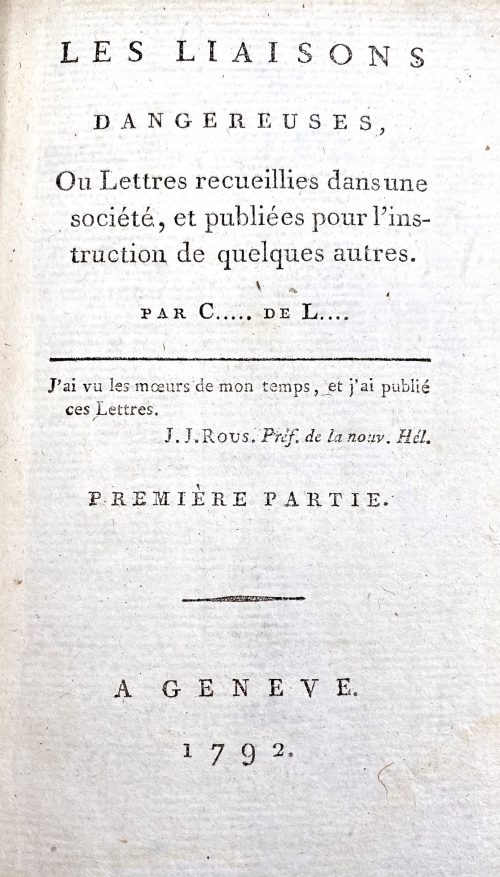 Four parts bound in two 18mo volumes (1-2 & 3-4), half polished brown calf, dot-ruled, flat spine with gilt bands and lettering, marbled boards, some plates with guard sheets, margins sparkled red. Title-page: LES LIAISONS | DANGEREUSES, | Ou Lettres recueillies dans une | société, et publiées pour l’ins- | truction de quelques autres. | par C….. de L… | — | J’ai vu les mœurs de mon temps, et j’ai publié | ces Lettres. | J. J. Rous. Préf. De la nouv. Hél. | PREMIÈRE PARTIE. | — | A GENEVE. | 1792. || Vol. 1: Pagination: ffep, blank, [2] – h.t., [i, ii] – t.p. part one, [iii] iv-xxij, [1] 2-245 [246] + 2 plates (p. 26 & p. 75); [1, 2] – h.t., [3, 4] – t.p. part two, [5] 6-233 [234], fep + 2 plates (p. 59 & p. 222). Collation: part 1: a12, A-M18 N5; part 2: A-M18 N9, plus four plates by various engravers after Le Barbier. Vol. 2: Pagination: ffep, blank, [1, 2] – h.t., [3, 4] – t.p. part three, [5] 6-225 [226] + 2 plates (p. 69 & p. 215); [1, 2] – h.t., [3, 4] – t.p. part four, [5] 6-250, fep + 2 plates (p. 25 & p. 201). Collation: part 3: A-M18 N5; part 4: A-N18 O5, plus four plates by various engravers after Le Barbier. Illustrations: After Le Barbier, engravers: Halbou (1), Simonet (1), N. Thomas (2), Dambrun (2), and Delignon (2). In the first illustration (vol. 1, part one, p. 26) Le Barbier signed “Le Barbier Jnv. 1794”, however, the edition was published (anonymously) in 1792. Cohen-De Ricci mentions an edition of 1794 (Paris: Maradan) and 1801 (Genéve) with the same plates. Lewine mentions a reprint of 1794 without naming the publisher. Catalogue raisonné: Cohen-De Ricci: 234-5, Ray: p. 79; Lewine: 109-10. Contributors: Choderlos de Laclos, Pierre Ambroise François (French, 1741 – 1803) – author. Le Barbier, Jean-Jacques-François (French, 1738 – 1826) – artist Engravers: Dambrun, Jean (French, 1741 – c. 1808) Delignon, Jean Louis (French, 1755 – 1804) Halbou, Louis Michel (1730 – 1809) Thomas, N. (French, c. 1750 – 1812) Simonet, Jean-Baptiste Blaise (French, 1742 – 1813)
Four parts bound in two 18mo volumes (1-2 & 3-4), half polished brown calf, dot-ruled, flat spine with gilt bands and lettering, marbled boards, some plates with guard sheets, margins sparkled red. Title-page: LES LIAISONS | DANGEREUSES, | Ou Lettres recueillies dans une | société, et publiées pour l’ins- | truction de quelques autres. | par C….. de L… | — | J’ai vu les mœurs de mon temps, et j’ai publié | ces Lettres. | J. J. Rous. Préf. De la nouv. Hél. | PREMIÈRE PARTIE. | — | A GENEVE. | 1792. || Vol. 1: Pagination: ffep, blank, [2] – h.t., [i, ii] – t.p. part one, [iii] iv-xxij, [1] 2-245 [246] + 2 plates (p. 26 & p. 75); [1, 2] – h.t., [3, 4] – t.p. part two, [5] 6-233 [234], fep + 2 plates (p. 59 & p. 222). Collation: part 1: a12, A-M18 N5; part 2: A-M18 N9, plus four plates by various engravers after Le Barbier. Vol. 2: Pagination: ffep, blank, [1, 2] – h.t., [3, 4] – t.p. part three, [5] 6-225 [226] + 2 plates (p. 69 & p. 215); [1, 2] – h.t., [3, 4] – t.p. part four, [5] 6-250, fep + 2 plates (p. 25 & p. 201). Collation: part 3: A-M18 N5; part 4: A-N18 O5, plus four plates by various engravers after Le Barbier. Illustrations: After Le Barbier, engravers: Halbou (1), Simonet (1), N. Thomas (2), Dambrun (2), and Delignon (2). In the first illustration (vol. 1, part one, p. 26) Le Barbier signed “Le Barbier Jnv. 1794”, however, the edition was published (anonymously) in 1792. Cohen-De Ricci mentions an edition of 1794 (Paris: Maradan) and 1801 (Genéve) with the same plates. Lewine mentions a reprint of 1794 without naming the publisher. Catalogue raisonné: Cohen-De Ricci: 234-5, Ray: p. 79; Lewine: 109-10. Contributors: Choderlos de Laclos, Pierre Ambroise François (French, 1741 – 1803) – author. Le Barbier, Jean-Jacques-François (French, 1738 – 1826) – artist Engravers: Dambrun, Jean (French, 1741 – c. 1808) Delignon, Jean Louis (French, 1755 – 1804) Halbou, Louis Michel (1730 – 1809) Thomas, N. (French, c. 1750 – 1812) Simonet, Jean-Baptiste Blaise (French, 1742 – 1813) -
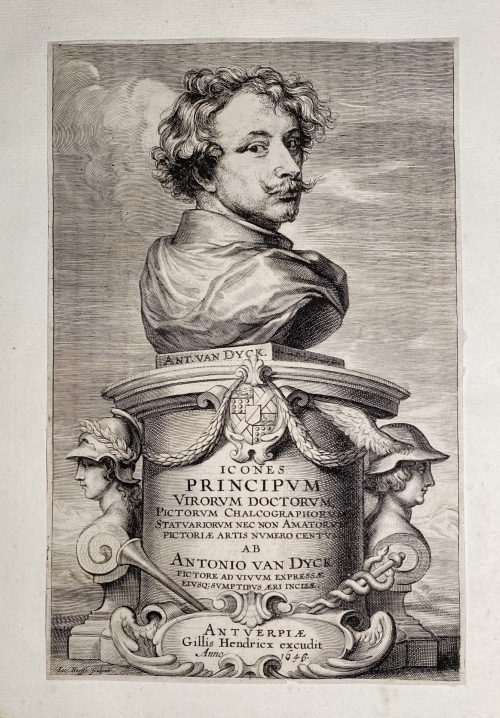 A book of sixty-eight copperplate engravings (burin and etching) by various artists after Anthony van Dyck, and one engraving by Lucas Vorsterman I, printed in black on laid paper, bound in full calf with a blind-stamped double-fillet ruling to the boards, spine with raised bands, gilt floral lozenges in compartments, gilt lettering "RECUE DE FIGUR", all margins sprinkled red, marbled end-papers. Engravers: Adriaen Lommelin (French engraver, 1637 – c. 1673) : 12 plates: №№ 3, 17, 18, 20, 21, 24, 25, 26, 28, 30, 35, and 48. Anthony van Dyck (Flemish, 1599 – 1641) : partially engraved himself 1 plate: № 53. Antoine Couchet (Flemish, 1630 – 1678) : 1 plate № 30. Conrad Waumans [Woumans] (Flemish engraver, 1619 – after 1675) : 6 plates: №№ 5, 32, 36, 57, 64, and 66. Cornelis Galle the Younger (Flemish engraver, 1615 – 1678) : 5 plates: №№ 2, 7, 10, 29, and 33. Hendrick Snyers (Flemish engraver, 1611 – 1644) : 1 plate: № 9. Jacob Neefs, or Neeffs (Flemish engraver, 1610 – after 1660): 4 plates: №№ 1, 16, 45, and 67. Johannes [Jan] Meyssens (Flemish engraver and publisher, 1612 – 1670) : engraved 6 plates: №№ 4, 22, 31, 51, 61, and 62. Lucas Vorsterman the Elder (Flemish engraver, 1595 – 1675) : engraved 7 plates: №№ 11, 15, 55, 58, 59, 65, and 69. Michael Natalis, or Noël (Flemish engraver, 1610 – 1668) : 1 plate: № 34 Paulus Pontius (Flemish engraver, 1603 – 1658) : 2 plates: №№ 37 and 52. Peeter Clouwet (Flemish engraver, 1629 – 1670) : 3 plates: №№ 13, 27, and 49. Peeter van Lisebetten (Flemish engraver, 1630 – 1678) : 1 plate: № 56. Pieter de Bailliu (Flemish engraver, 1613 – after 1660) : 4 plates: №№ 8, 14, 44, and 54. Pieter de Jode II (Flemish, 1606 – 1670/74) : 7 plates: №№ 12, 19, 23, 46, 47, 50, and 60. Richard Gaywood (British, fl. 1644 – 1668) : 1 plate: № 63. Robert van Voerst (Dutch, 1597 – 1636) : 1 plate: № 6. Schelte Adamsz. Bolswert (Flemish, c. 1586 – 1659) : 2 plates: №№ 18 and 68. Wenceslaus Hollar (Bohemian, 1607 – 1677) : 6 plates: №№ 38, 39, 40, 41, 42, and 43. Publishers: 36 prints were printed/published by Johannes [Jan] Meyssens (Flemish, 1612 – 1670) : (2), (4), (5), (7), (8), (9), (10), (12), (14), (22), (29), (31), (32), (33), (34), (36), (37), (39), (40), (41), (42), (43), (44), (45), (46), (51), (53), (54), (56), (57), (60), (61), (62), (64), (66), (67). Gillis Hendricx (fl. 1640 – 1677) published 11 prints, including the title page: (1), (13), (18), (26), (30), (47), (48), (50), (59), (65), (68). N. Burgund. Cons. Brab : (20); John Overton (British, 1639/40 – 1713) : (63); Hendrik van der Borcht II (Dutch, 1614 – c. 1690) : (38); Peter Stent (British, fl. c. 1637 – 1665) : (63). Description of plates:
A book of sixty-eight copperplate engravings (burin and etching) by various artists after Anthony van Dyck, and one engraving by Lucas Vorsterman I, printed in black on laid paper, bound in full calf with a blind-stamped double-fillet ruling to the boards, spine with raised bands, gilt floral lozenges in compartments, gilt lettering "RECUE DE FIGUR", all margins sprinkled red, marbled end-papers. Engravers: Adriaen Lommelin (French engraver, 1637 – c. 1673) : 12 plates: №№ 3, 17, 18, 20, 21, 24, 25, 26, 28, 30, 35, and 48. Anthony van Dyck (Flemish, 1599 – 1641) : partially engraved himself 1 plate: № 53. Antoine Couchet (Flemish, 1630 – 1678) : 1 plate № 30. Conrad Waumans [Woumans] (Flemish engraver, 1619 – after 1675) : 6 plates: №№ 5, 32, 36, 57, 64, and 66. Cornelis Galle the Younger (Flemish engraver, 1615 – 1678) : 5 plates: №№ 2, 7, 10, 29, and 33. Hendrick Snyers (Flemish engraver, 1611 – 1644) : 1 plate: № 9. Jacob Neefs, or Neeffs (Flemish engraver, 1610 – after 1660): 4 plates: №№ 1, 16, 45, and 67. Johannes [Jan] Meyssens (Flemish engraver and publisher, 1612 – 1670) : engraved 6 plates: №№ 4, 22, 31, 51, 61, and 62. Lucas Vorsterman the Elder (Flemish engraver, 1595 – 1675) : engraved 7 plates: №№ 11, 15, 55, 58, 59, 65, and 69. Michael Natalis, or Noël (Flemish engraver, 1610 – 1668) : 1 plate: № 34 Paulus Pontius (Flemish engraver, 1603 – 1658) : 2 plates: №№ 37 and 52. Peeter Clouwet (Flemish engraver, 1629 – 1670) : 3 plates: №№ 13, 27, and 49. Peeter van Lisebetten (Flemish engraver, 1630 – 1678) : 1 plate: № 56. Pieter de Bailliu (Flemish engraver, 1613 – after 1660) : 4 plates: №№ 8, 14, 44, and 54. Pieter de Jode II (Flemish, 1606 – 1670/74) : 7 plates: №№ 12, 19, 23, 46, 47, 50, and 60. Richard Gaywood (British, fl. 1644 – 1668) : 1 plate: № 63. Robert van Voerst (Dutch, 1597 – 1636) : 1 plate: № 6. Schelte Adamsz. Bolswert (Flemish, c. 1586 – 1659) : 2 plates: №№ 18 and 68. Wenceslaus Hollar (Bohemian, 1607 – 1677) : 6 plates: №№ 38, 39, 40, 41, 42, and 43. Publishers: 36 prints were printed/published by Johannes [Jan] Meyssens (Flemish, 1612 – 1670) : (2), (4), (5), (7), (8), (9), (10), (12), (14), (22), (29), (31), (32), (33), (34), (36), (37), (39), (40), (41), (42), (43), (44), (45), (46), (51), (53), (54), (56), (57), (60), (61), (62), (64), (66), (67). Gillis Hendricx (fl. 1640 – 1677) published 11 prints, including the title page: (1), (13), (18), (26), (30), (47), (48), (50), (59), (65), (68). N. Burgund. Cons. Brab : (20); John Overton (British, 1639/40 – 1713) : (63); Hendrik van der Borcht II (Dutch, 1614 – c. 1690) : (38); Peter Stent (British, fl. c. 1637 – 1665) : (63). Description of plates: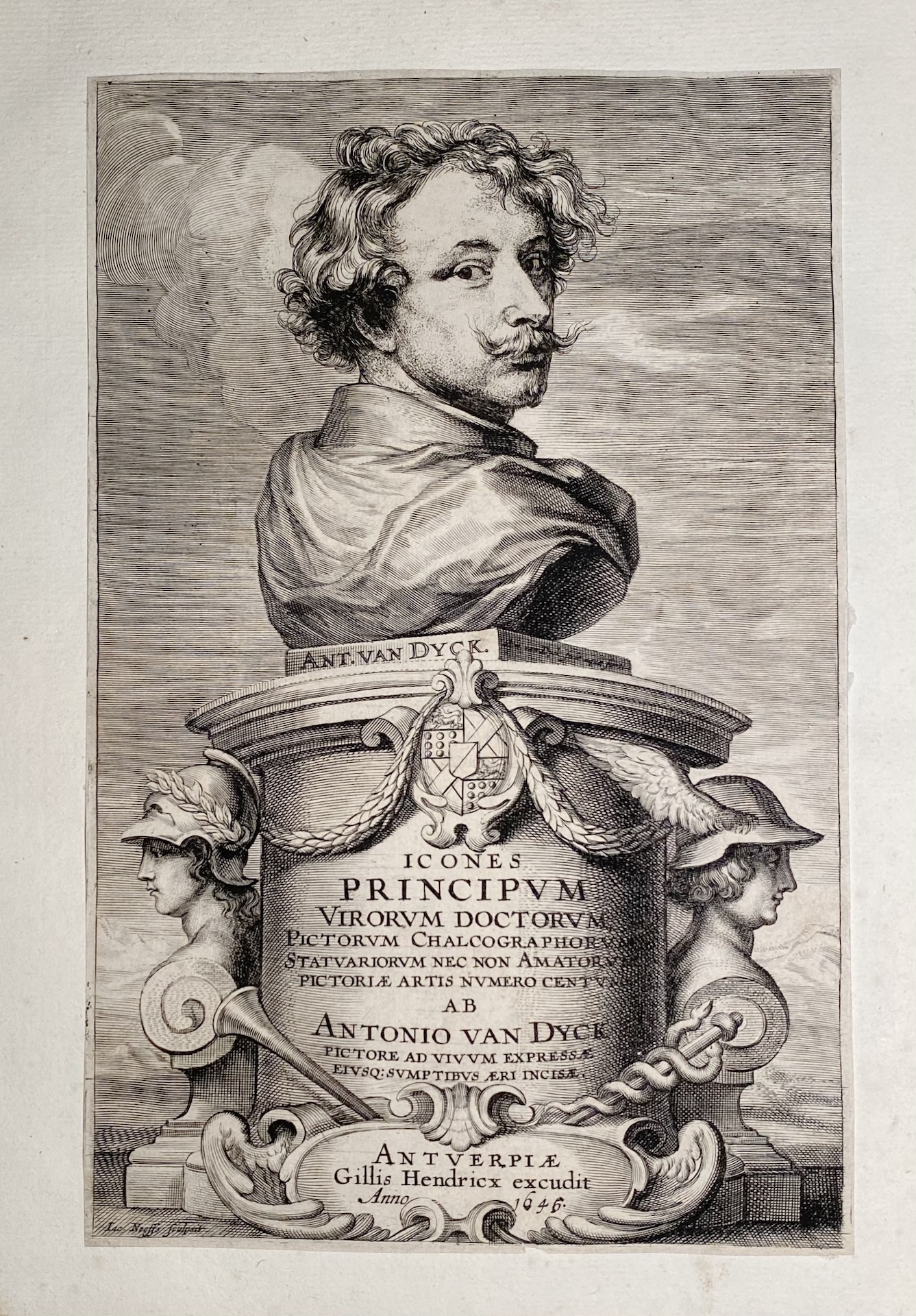
1. Engraved title page by Jacob Neeffs in 1646. On the slab supporting the bust, left: “ANT. VAN DYCK”, right: “Ant. van Dyck fecit aqua forti”. On the face of pedestal: “PRINCIPVM | VIRORVM DOCTORVM, | PICTORVM CHALCOGRAPHORVM, | STATVARIORVM NEC NON AMATORVM | PICTORIÆ ARTIS NVMERO CENTVM | AB | ANTONIO VAN DYCK, | PICTORE AD VIVVM EXPRESSÆ | EIVSQ: SVMPTIBVS ÆRI INCISÆ.” In cartouche: “ANTVERPIÆ | Gillis Hendricx excudit | Anno 1645” (corrected by hand “1646”). At lower left margin: “Iac. Neeffs Sculpsit.” The print with cut off margins pasted to the bound-in leaf. Size of the print: 24.3 x 15.8 cm. 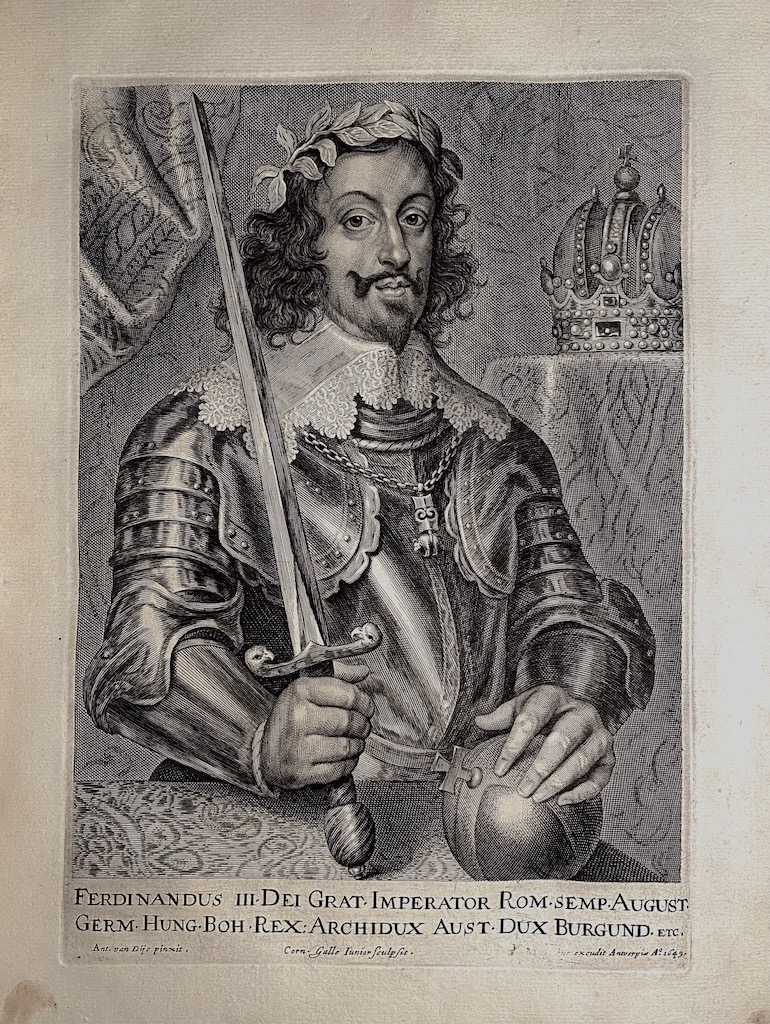
2. Ferdinand III, Holy Roman Emperor and King of Hungary and Bohemia (1608 – 1657); engraved by Cornelis Galle the Younger (Flemish, 1615–1678) in 1649. Inscription: “FERDINANDUS III. DEI GRAT. IMPERATOR ROM.SEMP.AUGUST. | GERM. HUNG. BOH. REX: ARCHIDICUX AU ST. DUX BURGUND. ETC.”. Below: “Ant. van Dÿc pinxit” <–> “Corn. Galle Iunior sculp∫it.”<–> “…excudit Antuerpiæ A.o 1649”. Second state with Meyssens’ name burnished. 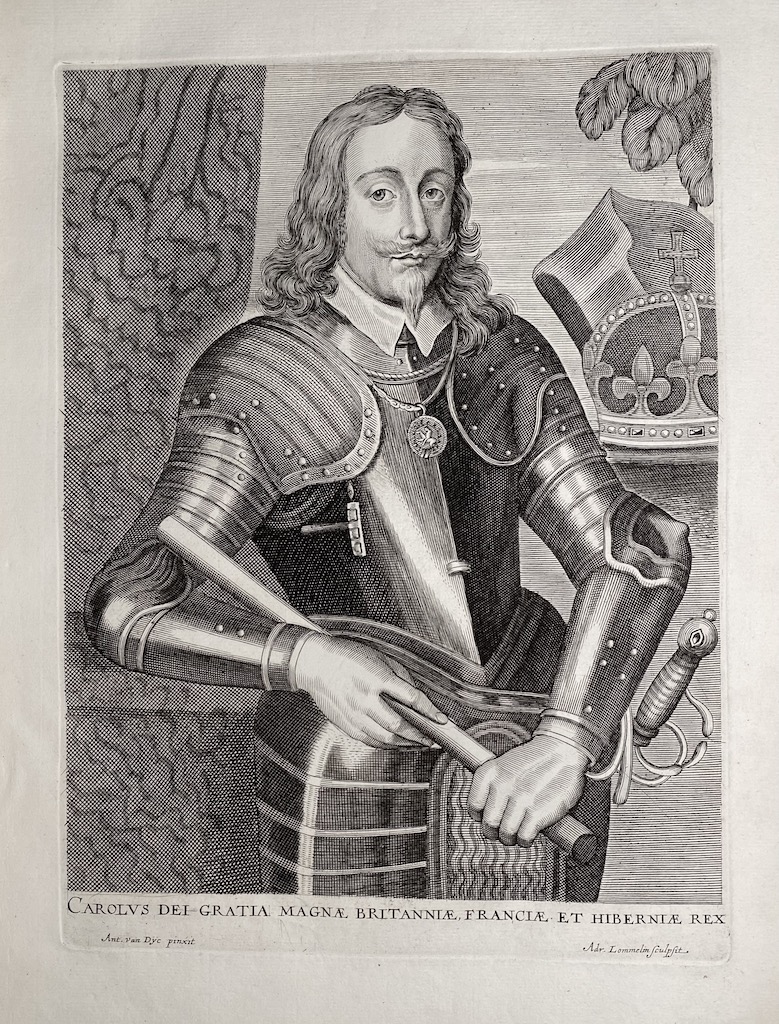
3. Charles I, King of England, Scotland, and Ireland (British, 1600 – 1649); engraved by Adriaen Lommelin (French, 1637 – c. 1673). Inscription: “CAROLVS DEI GRATIA MAGNÆ BRITANNIÆ, FRANCIÆ ET HIBERNIÆ REX”. Below: “Ant. van Dÿc pinxit” <–> “Adr. Lommelin sculpsit”. 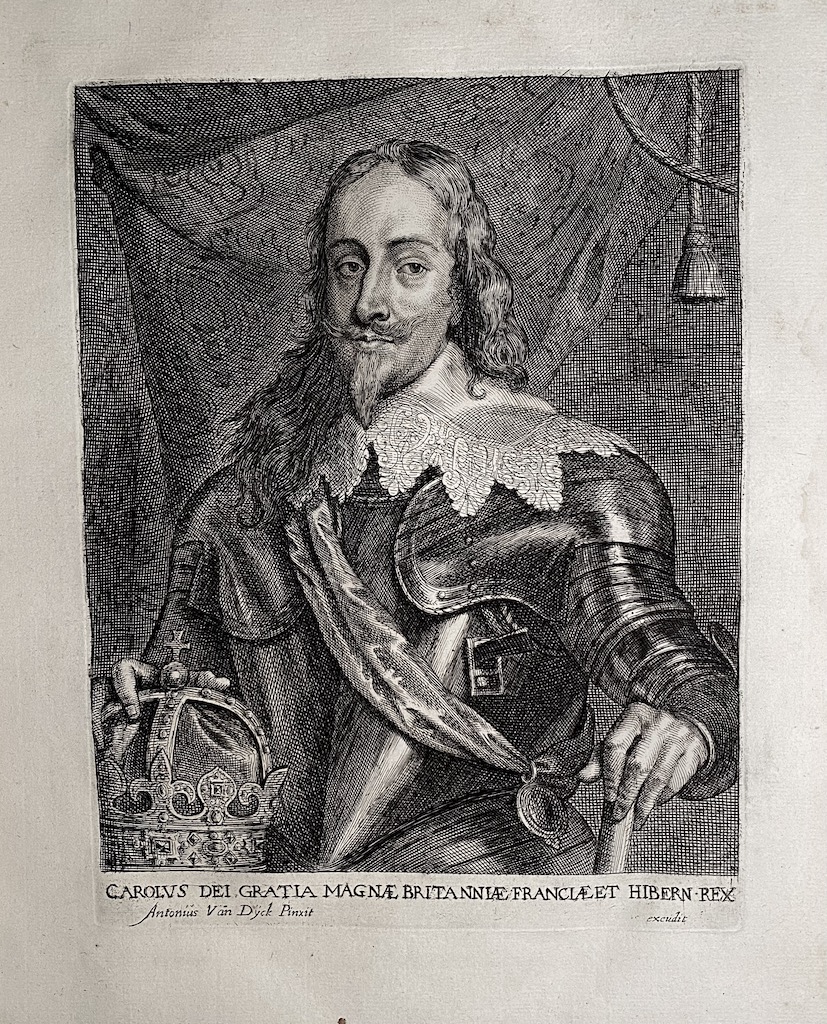
4. Charles I, King of England, Scotland, and Ireland (British, 1600 – 1649); engraved by Johannes [Jan] Meyssens (Flemish, 1612 – 1670). Inscription: “CAROLVS DEI GRATIA MAGNÆ BRITANNIÆ, FRANCIÆ ET HIBERNIÆ REX”. Below: Antonius Van Dÿck eques pinxit” <–> “...excudit”. Meyssens’ name burnished. [See similar print №61 with Ioannes Meysens name present]. 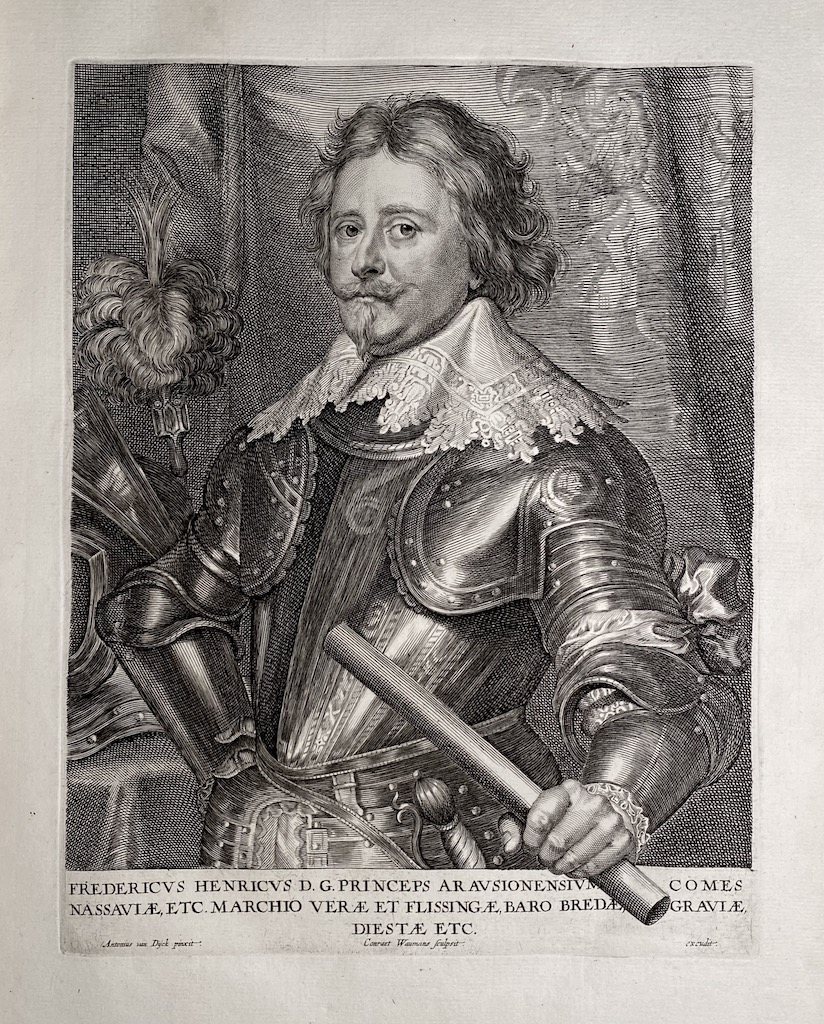
5. Frederick Henry, Prince of Orange, Count of Nassau (Dutch, 1584 – 1647); engraved by Conrad Waumans [Woumans] (Flemish, 1619 – after 1675). Inscription: “FREDERICVS HENRICVS, D.G. PRINCEPS ARAVSIONENSIVM, COMES | NASSAVIÆ, ETC. | MARCHIO VERÆ ET FLISSINGÆ, BARO BREDÆ GRAVÆ, | DIESTÆ ETC.” Below: “Antonius van Dÿck pinxit” <–> “Conraet Waumans sculpsit” <–> “…excudit”. Meyssens’ name burnished. [Similar to №57, but with Ioannes Meyssens name in place]. 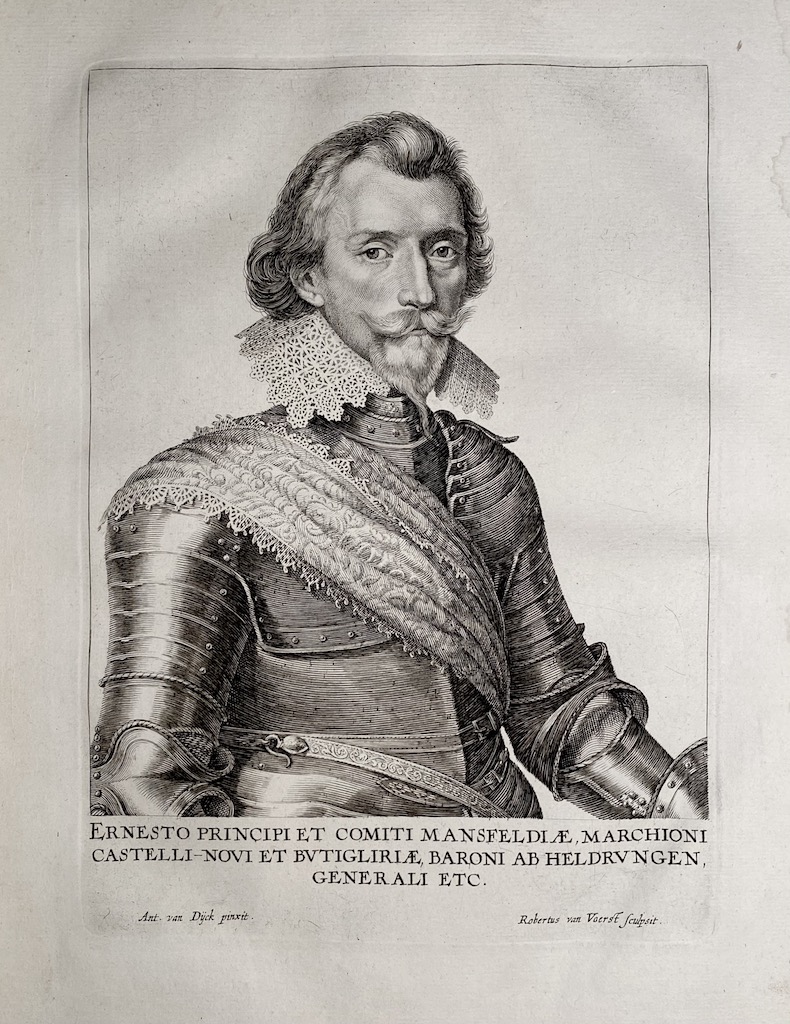
6. Count Ernst von Mansfield (German, 1580 – 1626); engraved by Robert van Voerst (Dutch, 1597 – 1636). Inscription: “ERNESTO PRINCIPI ET COMITI MANSFELDIÆ, MARCHIONI | CASTELLI-NOVI ET BUTIGLIRIÆ, BARONI AB HELDRUNGEN, GENERALI ETC.” Below “Ant. Van Dÿck pinxit” <–> “Robertus van Voerst Sculpsit”. 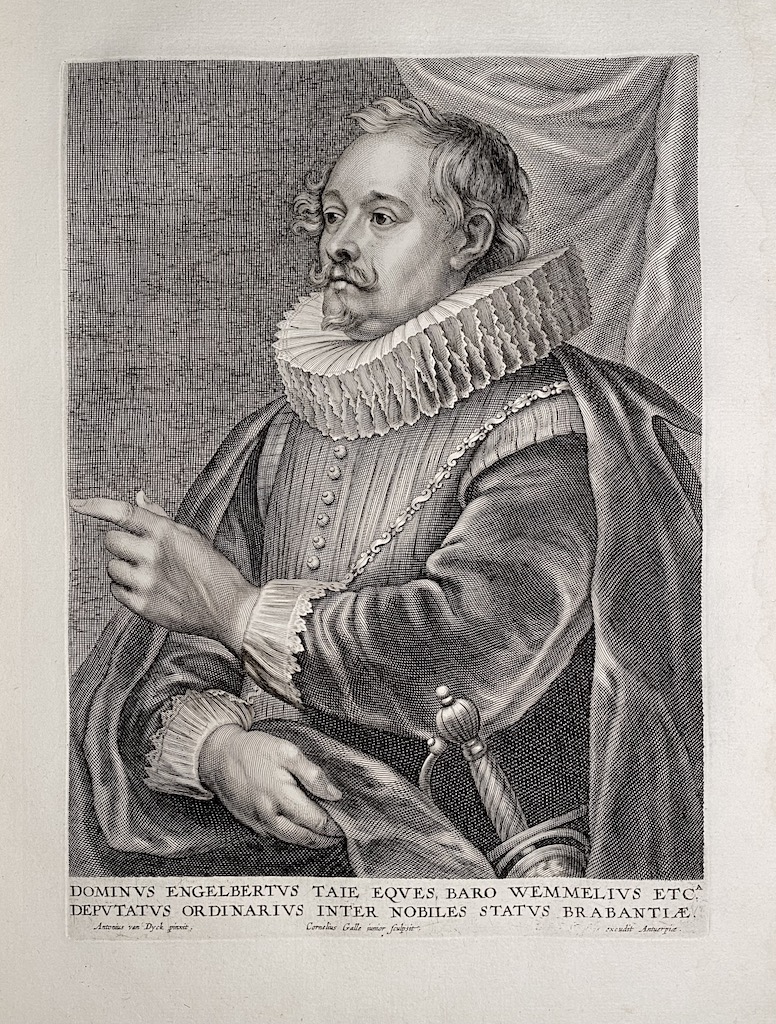
7. Engelbert Taye, Baron of Wemmel (Flemish, ? – 1638); engraved by Cornelis Galle the Younger. “DOMINVS ENGELBERTVS TAIE EQVES, BARO WEMMELIVS ETC.A | DEPVTATVS ORDINARIVS INTER NOBILES STATVS BRABANTIÆ.”. Below: “Antonius van Dyck pinxit”, “Cornelius Galle iunior ∫culpsit” <–> “…excudit Antuerpiæ.”. Second state, with “Ioannes Meyssens” erased. 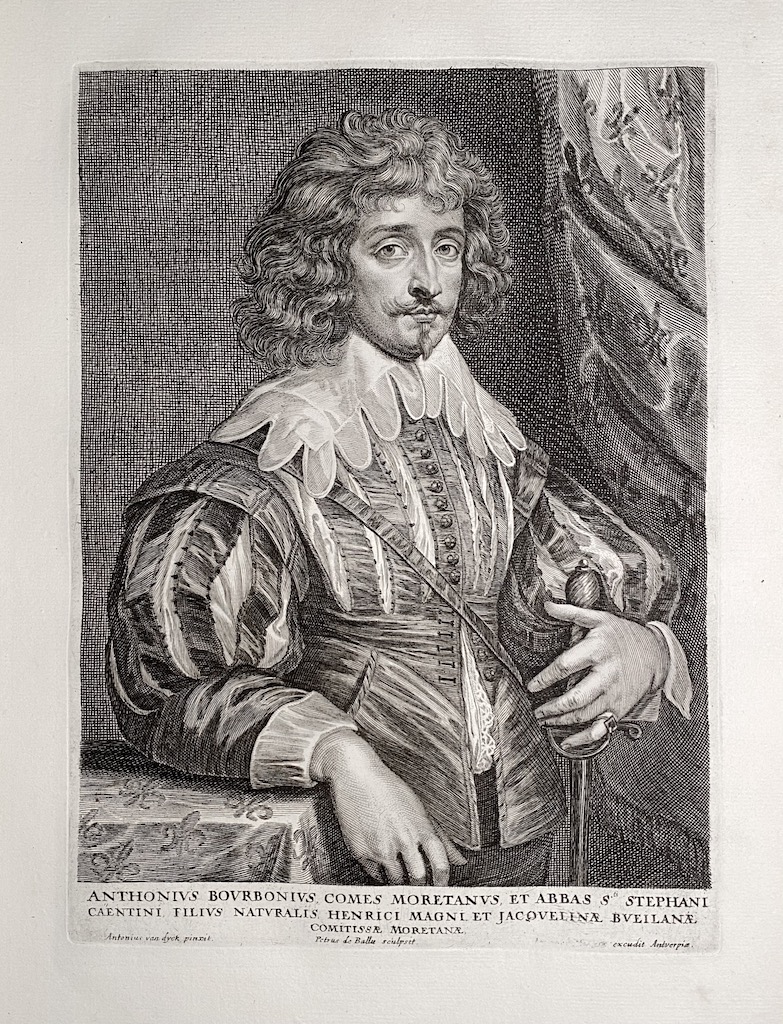
8. Antoine de Bourbon, comte de Moret (French, 1607 – 1632); engraved by Pieter de Bailliu (Flemish, 1613 – after 1660). Inscription: “ATHONIVS BOVRBONIVS, COMES MORETANVS, ET ABBAS S.TI STEPHANI | CAENTINI, FILIVS NATVRALIS, HENRICI MAGNI ET JACQVELINÆ BVEILANÆ | COMITISSÆ MORETANÆ,”. Below: “Antonius van dyck pinxit.” <–> “Petrus de Ballu sculpsit.” <–>“… excudit Antverpiæ.”. Second state with “Ioannes Meyssens” erased. Antoine de Bourbon was the illegitimate son of Henri IV, Roi de France and Jacqueline de Bueil, Comtesse de Moret. 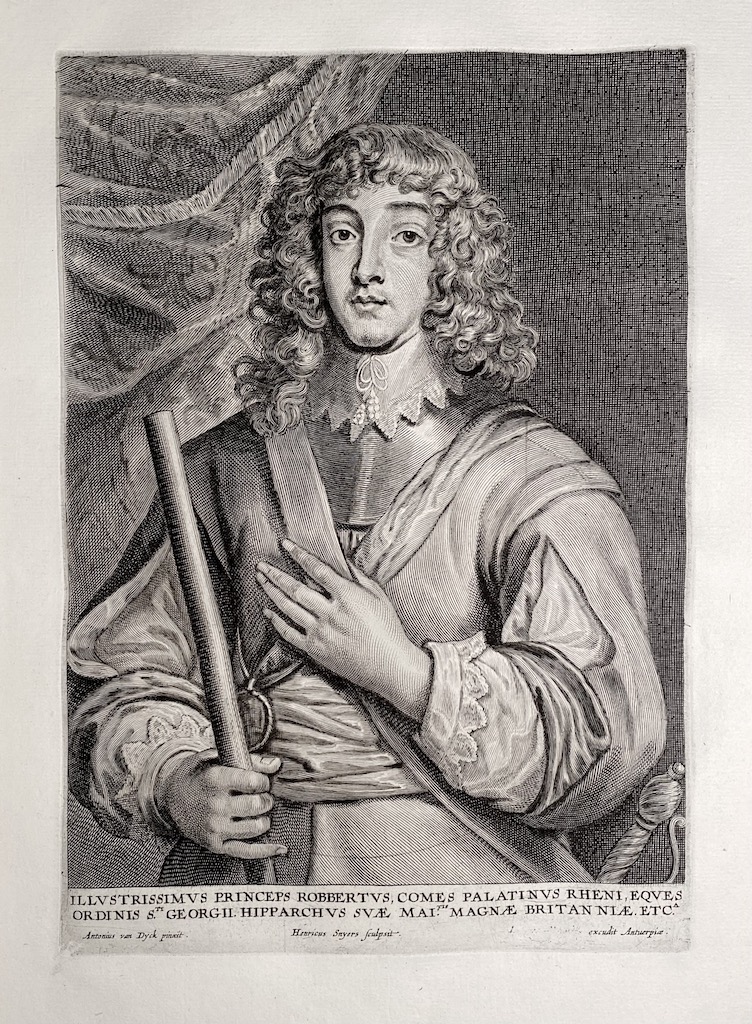
9. Prince Rupert of the Rhine (German, Bohemian, 1619 –1682); engraved by Hendrick Snyers (Flemish, 1611 – 1644). Inscription: “ILLVSTRISSIMVS PRINCEPS ROBBERTVS, COMES PALATINVS RHENI, EQVES | ORDINIS S.TI GEORGII. HIPPARCHVS SVÆ MAI.TIS MAGNÆ BRITANNIÆ. ETC.A”. Below: “Antonius van Dyck pinxit” <–> “Henricus Snyers sculpsit” <–> “...excudit Antuerpiæ.”. Second state with “Ioannes Meyssens” erased. 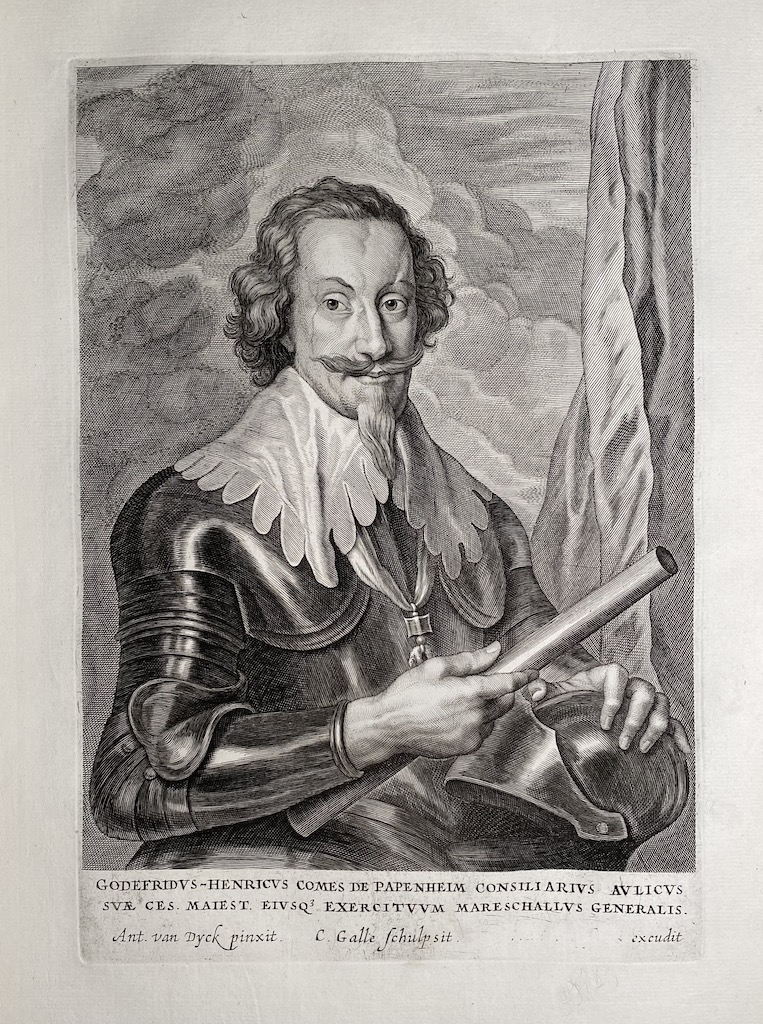
10. Gottfried-Heinrich, Count of Pappenheim; engraved by Cornelis Galle the Younger. Inscription: “GODEFRIDVS-HENRICVS COMES DE PAPENHEIM CONSILIARIVS AVLICVS | SVÆ CES. MAIES. EIVSQ³ EXERCITVVM MARESCHALLVS GENERALIS.” Lettered with production details below: “Ant. van Dyck pinxit” <–> “C. Galle ∫chulpsit.” <–> “…excudit”. Second state with “Ioan. Meyßens” erased. 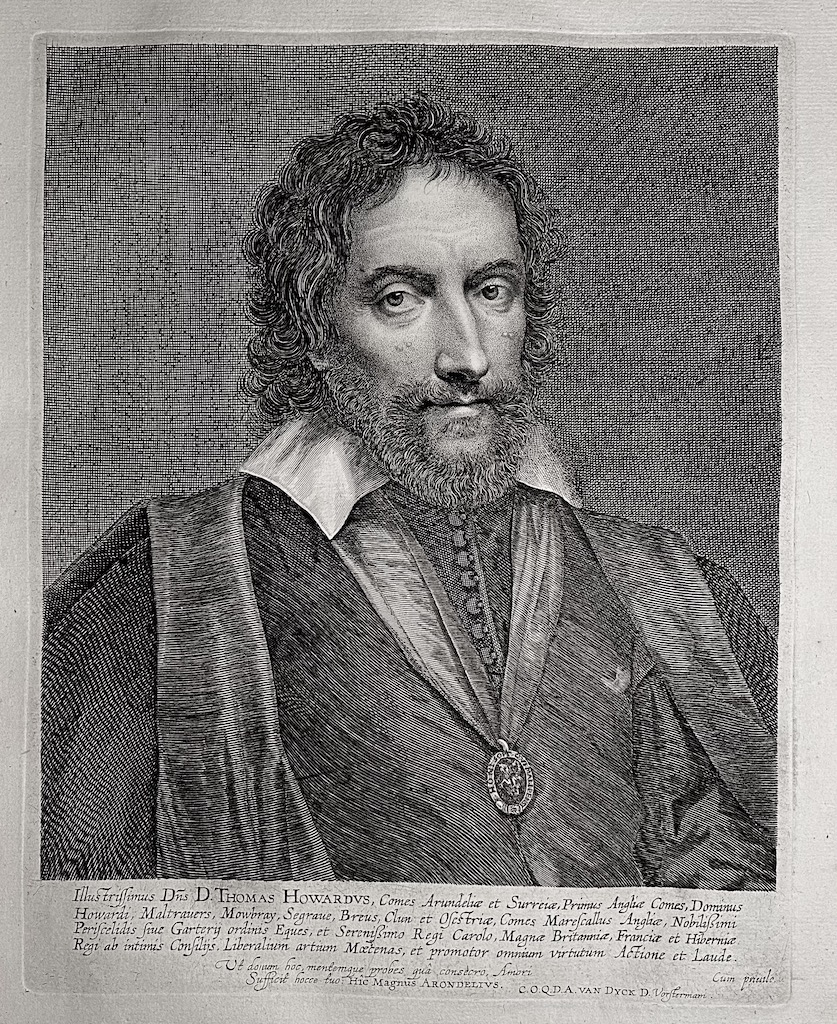
11. Thomas Howard, 14th Earl of Arundel (British, 1585 – 1646); engraved by Lucas Vorsterman the Elder (1595–1675). Inscription: “Illustri∫∫imus Dñs. D.Thomas Howardvs, Comes Arundeliæ et Surreiæ, Primus Angliæ Comes, Dominus | Howardi, Maltrauers, Mowbray, Segraue, Breus, Clun et O∫estriæ, Comes Mare∫callus Angliæ, Nobilißimi | Pericelidis ∫iue Garterij ordinis Eques, et Serenißimo Regi Carolo, Magnæ Britaniæ, Franciæ et Hiberniæ | Regi ab intimis Consilijs, Liberalium artium Mæcenas, et promotor omnion virtutum Actione et Laude.”. Below: “Ut donum hoc, mantenque probes qua consecro, Amori | Sufficit hocci tuo: Hic Magnvs ARONDELIVS”, “C.O.Q.D.A. VAN DYCK D. Vor∫termani.”, “Cum priuile.”. Third state with ‘Opera Vorstermanni’ burnished and two lines of Latin added below the four lines of the title. 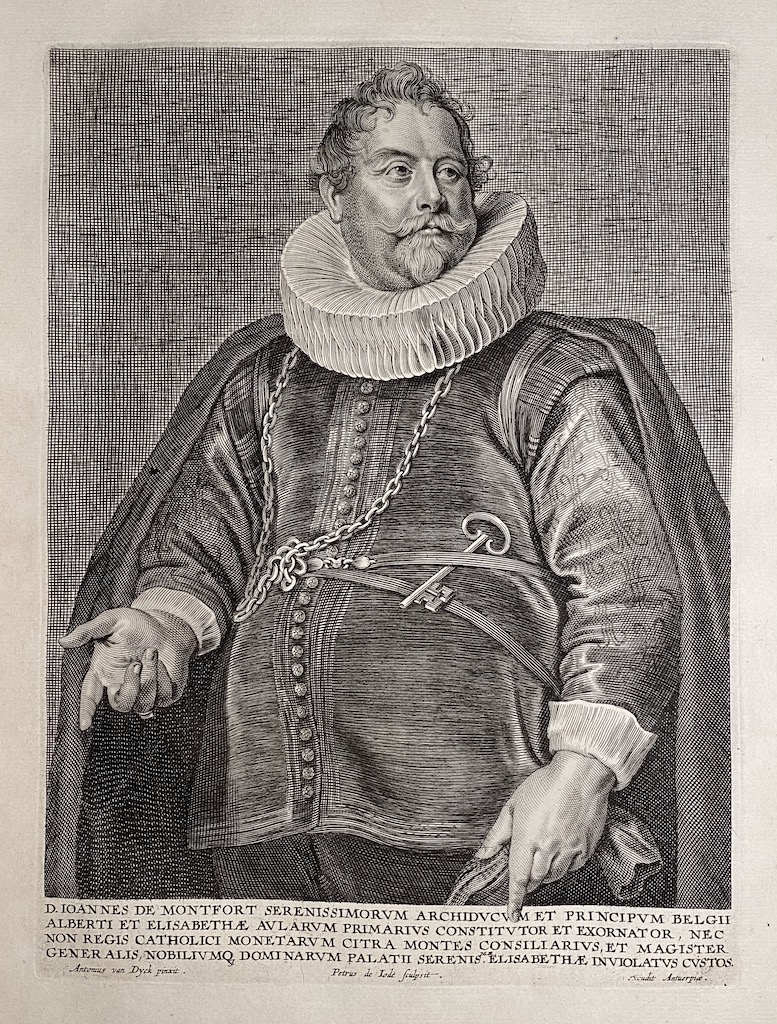
12. Jan van Montfort [Jean de Montfort] (Flemish, 1567 – 1648); engraved by Pieter de Jode II (Flemish, 1606 – 1670/74). Inscription: “D. IOANNES DE MONTFORT SERENISSIMORVM ARCHIDVCVM ET PRINCIPVM BELGII | ALBERTI ET ELISABETHÆ AVLARVM PRIMARIVS CONSTITVTOR ET EXORNATOR, NEC | NON REGIS CATHOLICI MONETARVM CITRA MONTES CONSILIARIVS, ET MAGISTER. | GENERALIS, NOBILIVMQ3 DOMINARVM PALATII SERENIS.MÆ ELISABETHÆ INVIOLATVS CVSTOS.” Below: “Antonius van Dyck pinxit.” <–> “Petrus de Iode sculpsit.” <–> “…excudit Antuerpiæ”. Second state with “Ioannes Meyssens” erased. 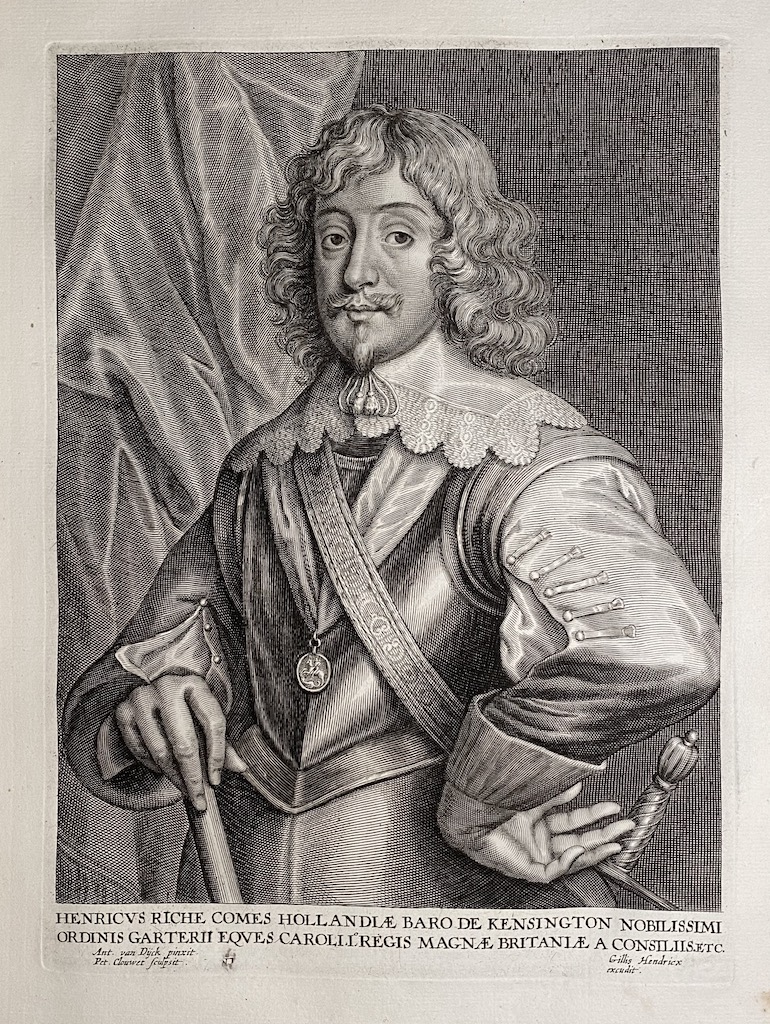
13. Henry Rich, 1st Earl of Holland (British, 1590 – 1649), engraved by Pieter Clouwet (Flemish, 1629 – 1670). Inscription: “HENRICVS RICHE COMES HOLLANDIÆ BARO DE KENSINGTON NOBILISSIMI | ORDINIS GARTERII EQVES CAROLI. LOREGIS MAGNÆ BRITANIÆ A CONSILIIS. ETC.”. Below: “Ant. van Dÿck pinxit.” | “Pet. Clouwet sculpsit” <–> “Gillis Hendricx | excudit”. Third state with the title added and production details re-engraved. 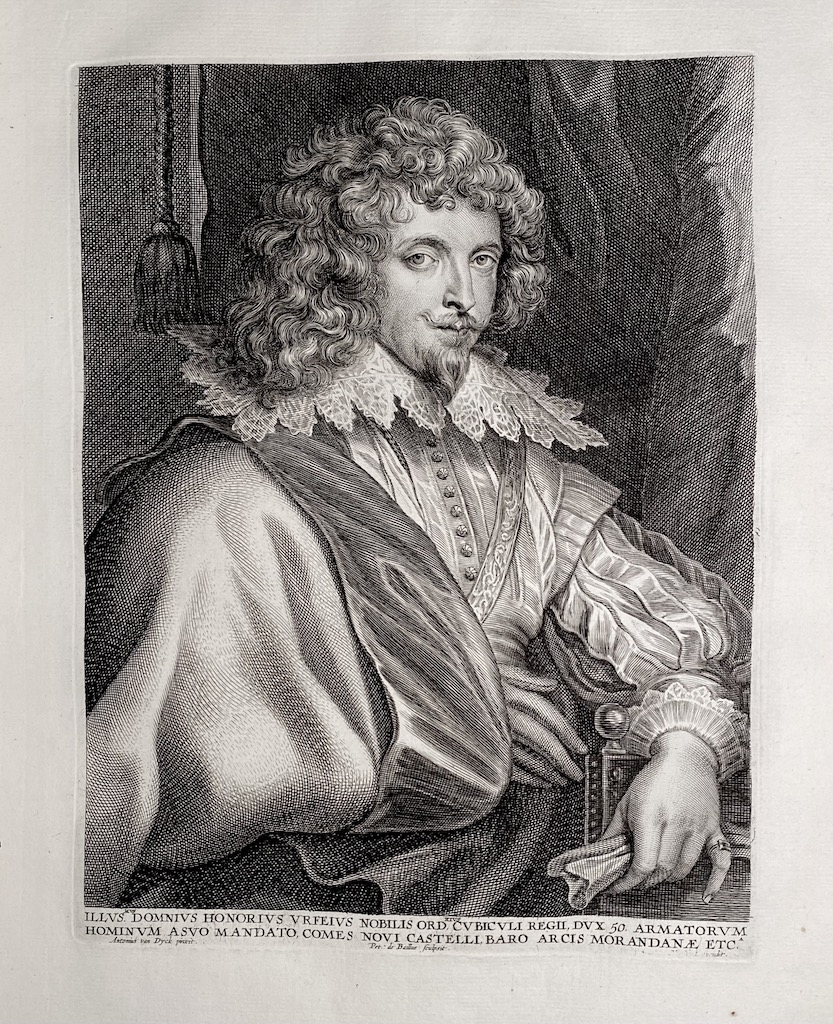
14. Honoré d’Urfé, marquis de Valromey, comte de Châteauneuf (French, 1568 – 1625); engraved by Pieter de Bailliu (Flemish, 1613 – 1660). Inscription: “ILLVS.MVS DOMNIVS HONORIVS VRFEIVS NOBILIS ORD.RIVS CVBICVLI REGII, DVX 50. ARMATORVM | HOMINVM A SVO MANDATO, COMES NOVI CASTELLI, BARO ARCIS MORANDANÆ ETC.A”. Below: “Antonius van Dyck pinxit” <–> “Pet. de Bailliue sculpsit.” <–> “… excudit”. Second lettered state with title and production details, with “Ioannes Meyssens” erased. [There is another copy in this binding, №54, where Ioannes Meysens' name is in place]. 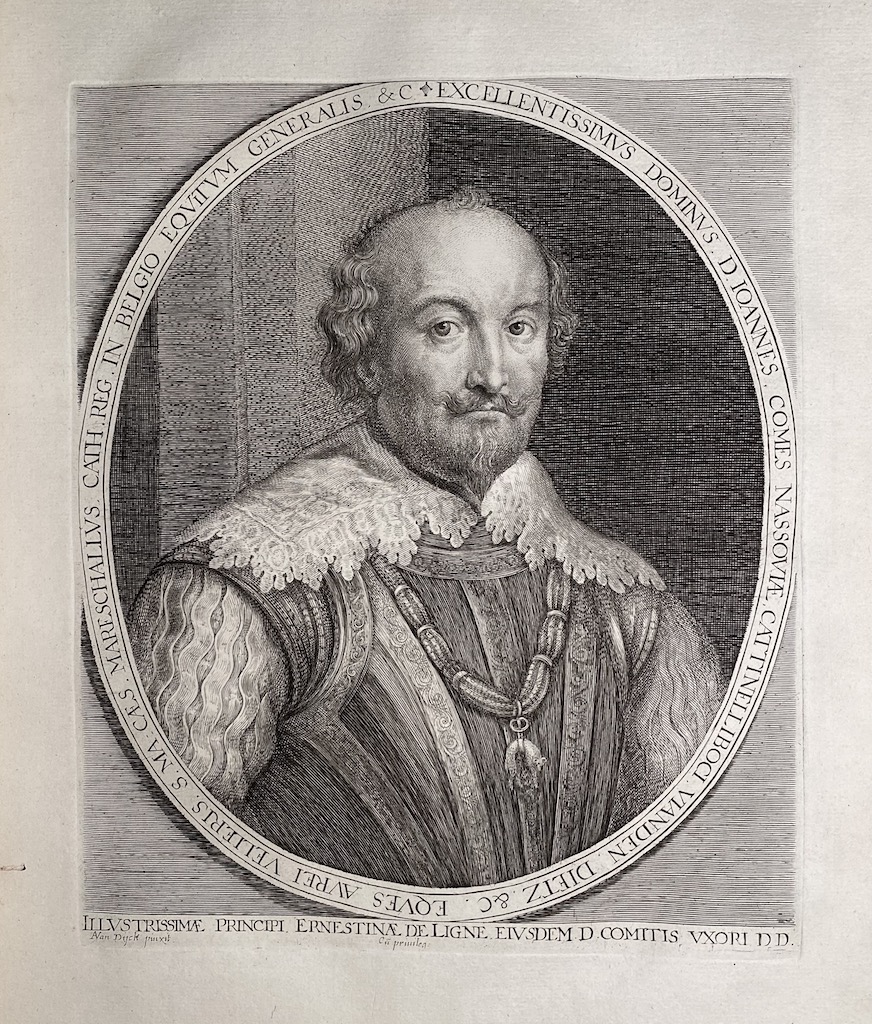
15. Johannes [John VIII], Count of Nassau-Siegen (German, 1583 – 1638); engraved by Lucas Vorsterman I (Flemish, 1595 – 1675). Inscription: in the oval around the portrait “EXCELLENTISSIMVS DOMINVS: D. IOANNES, COMES NASSAOVIÆ, CATTNELLIBOCI: VIANDEN, DIETZ, &C. EQVES AVREI VELLERIS. S. MA: CÆS, MARESCHALIVS, CATH. REG. IN BELGIO. EQVITVM GENERALIS. &C”, in lower margin: “ILLVSTRISSIMÆ PRINCIPI ERNESTINÆ DE LIGNE EIVSDEM D. COMITIS VXORI DD.”, and “AVan Dÿck pinxit.” <–> “Cu Priuleg”. Fourth state with Vorsterman’s address burnished. [For the third state with “Lucas Vorsterman exc” present see № 55]. 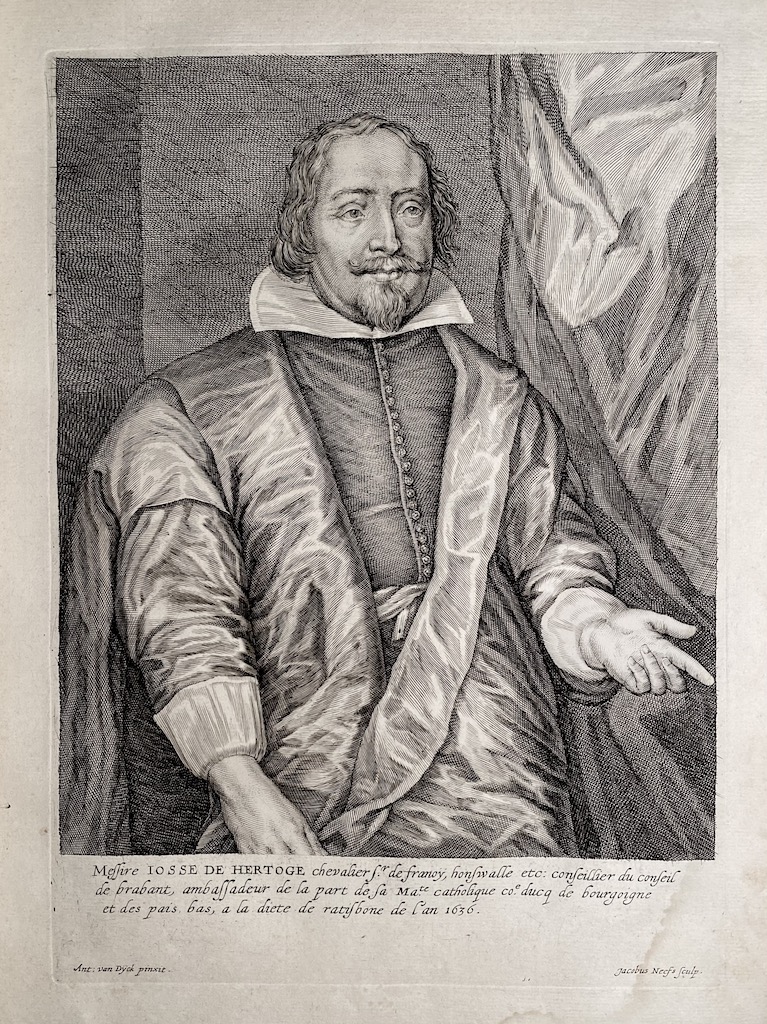
16. Joost de Hertoghe (Flemish, ? –1638); engraved by Jacobus Neefs. Inscription: "Me∫∫ire IOSSE DE HERTOGE chevalier ∫.r de franoÿ, hon∫walle etc: con∫eillier du conseil | de brabant, amba∫∫adeur de la part de ∫a Ma.te catholique co.e ducq de bourgoigne | et des pais bas, a la diete de rati∫bone de l'an 1636." In Lower margine: "Ant: van Dÿck pinxit.", <–>"Jacobus Neefs ∫culp.". Second, lettered state with the title and production details added. 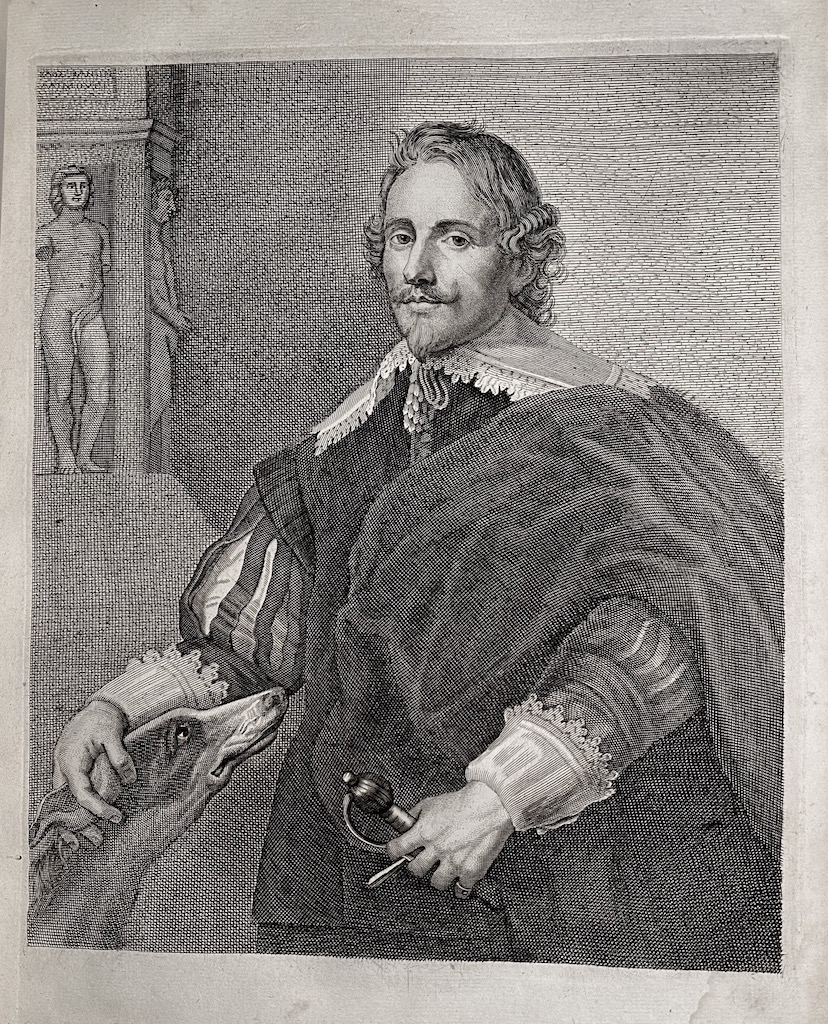
17. Philippe Le Roy (Flemish, 1596 – 1679). No inscription. The printmaker is unidentified but is possibly Adriaen Lommelin. The print is a copy of the print by Vorsterman and Pontius. 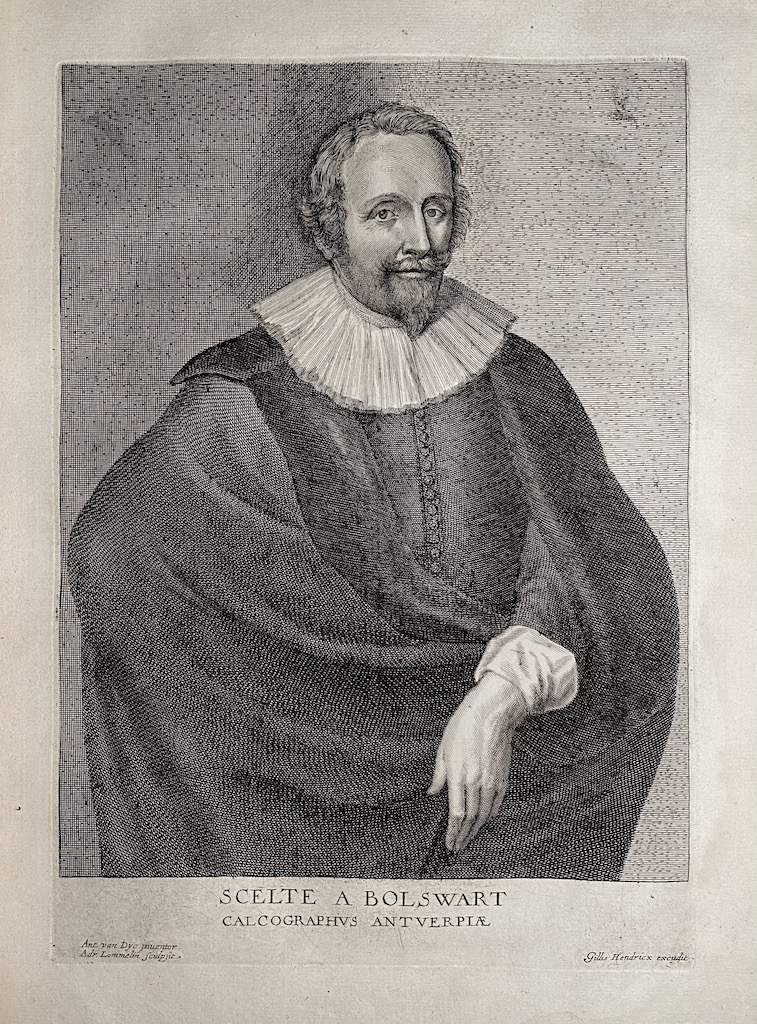
18. Schelte Adamsz. Bolswert (Flemish, c. 1586 – 1659); engraved by Adriaen Lommelin, published by Gillis Hendricx. Inscription: “SCELTE A BOLSWART | CALCOGRAPHVS ANTVERPIÆ”. In lower margin: “Ant. van Dÿc inuentor | Adr. Lommelin sculpsit” <–> “Gillis Hendricx excudit”. Third state with an entirely different head, title and production details added. 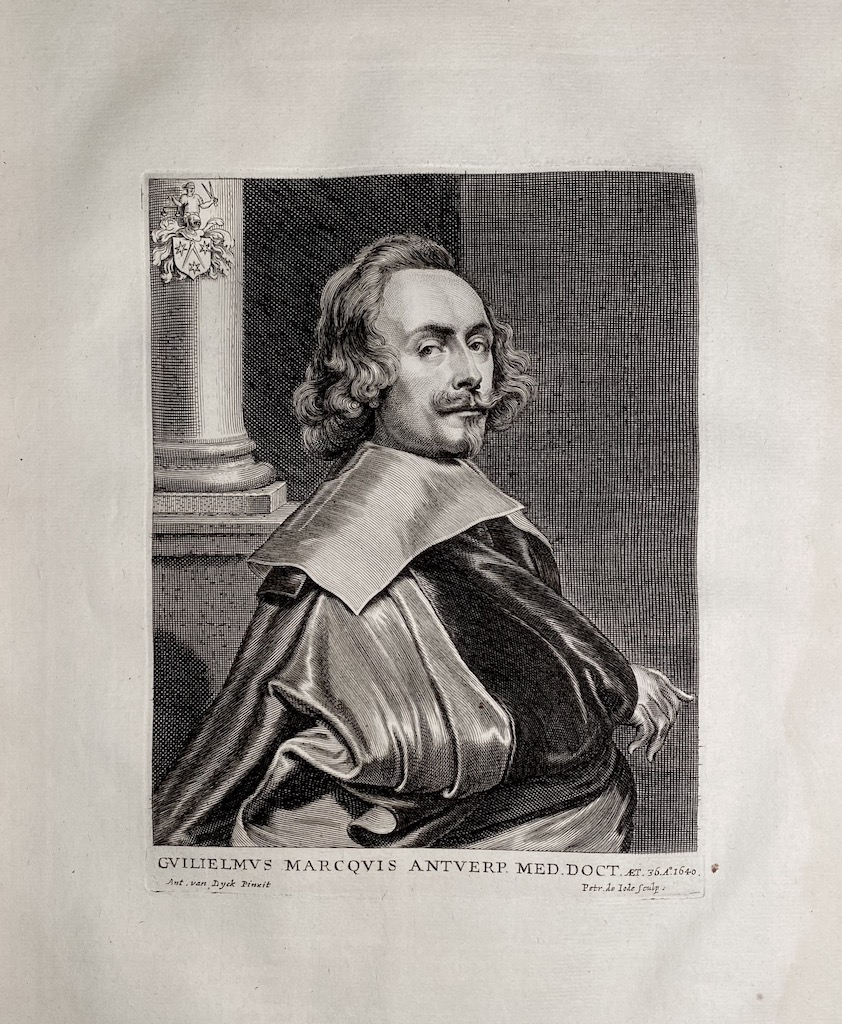
19. Willem Marquis (Flemish, 1604 – 1640); engraved by Pieter de Jode II. Inscription: “GVILIELMVS MARCQUIS ANTVERP. MED. DOCT. ÆT. 36.A.O 1640.” In lower margin: “Ant. van Dyck Pinxit” <–> “Petr. de Iode sculp.”. Second, lettered state with Borreken’s name burnished and replaced by Van Dyck’s. 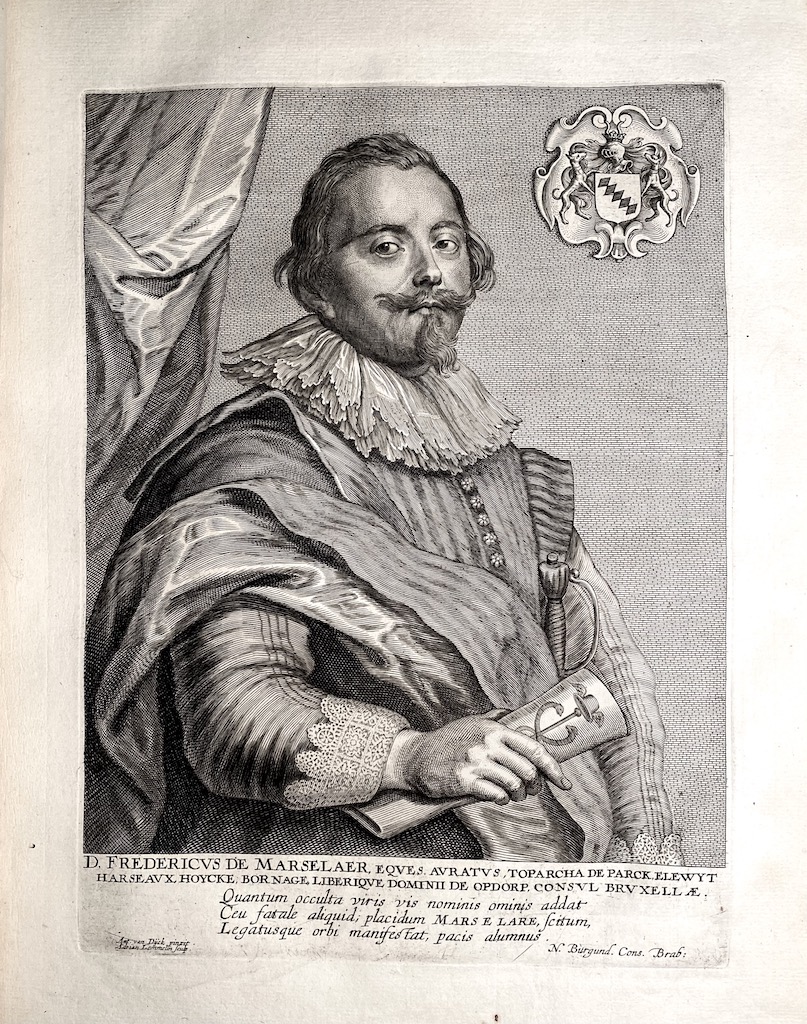
20. Frederik de Marselaer (Flemish, 1584 – 1670); engraved by Adriaen Lommelin. Inscription: “D. FREDERICVS DE MARSELAER, EQVES AVRATVS, TOPARCHA DE PARCK, ELEWYT | HARSEAVX, HOYCKE, BORNAGE, LIBERIQUE DOMINII DE OPDORP, CONSVL BRVXELLÆ.” Three lines of verse below: “Quantum occulta viris vis nominis ominis addat | Ceu fatale aliuid; placidum Mars E Lare, scitum, | Legatusue orbi manifestat, pacis alumnus.”. In lower margin: “Ant. van Dÿck pinxit | Adrian Lommelin sculpsit” <–> “N. Burgund. Cons. Brab:”. Third state with the roll of paper rounded. 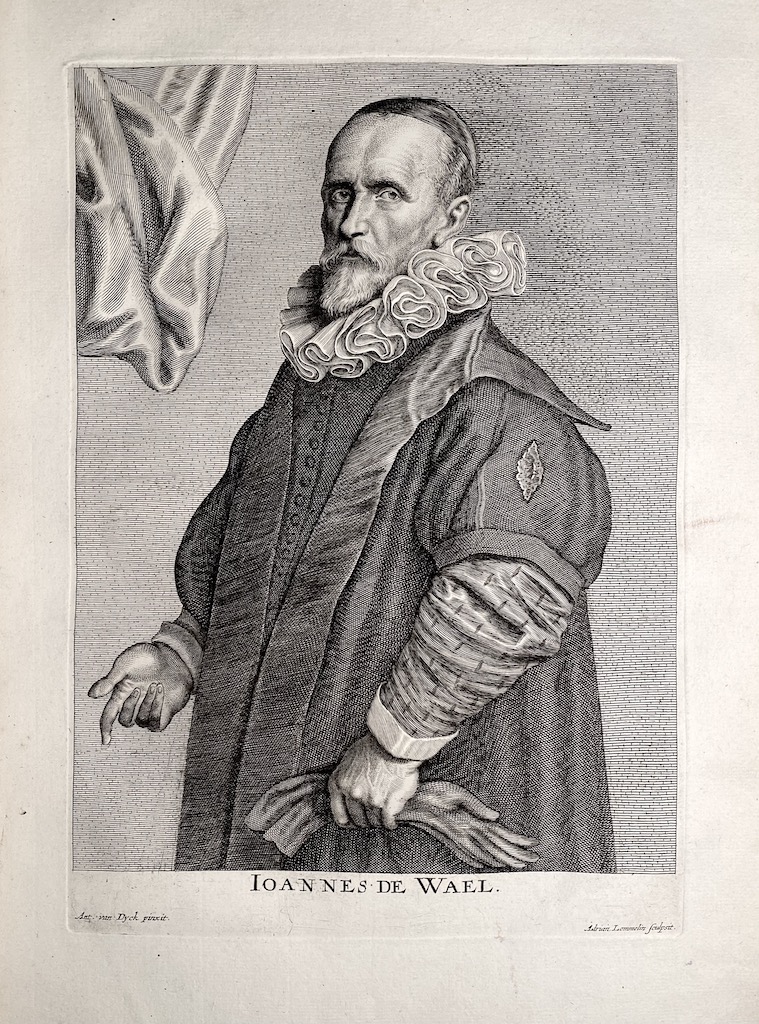
21. Jan Baptist de Wael I (Flemish, 1558 – 1633); engraved by Adriaen Lommelin. Inscription: “IOANNES DE WAEL.”. In lower margin: “Ant. van Dyck pinxit.”<–> and “Adrian Lommelin sculpsit.”. Second, lettered state with the title and production details. British Museum № 1872,1012.4168. 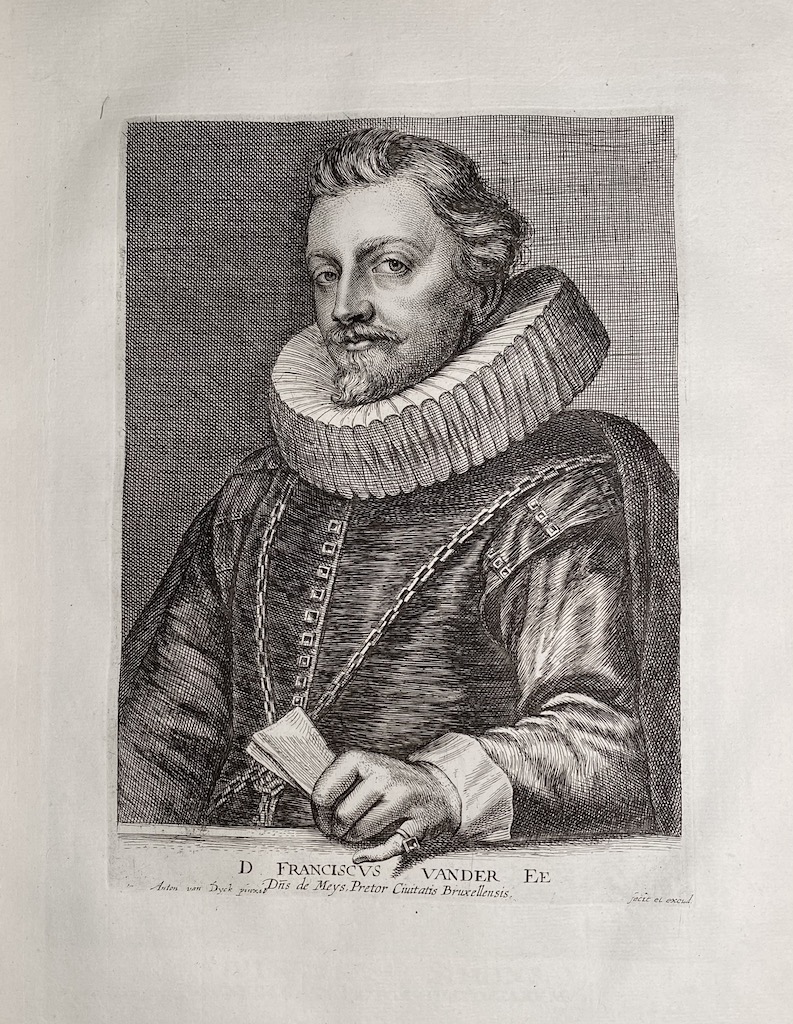
22. François van der Ee (Flemish, ? – 1645); engraved and published by Johannes Meyssens. Inscription: “D . FRANCISCVS VANDER EE | Dñs de Meys, Pretor Ciuitatis Bruxellensis”. In lower margin: “Anton van Dyck pinxit”, and “fecit et excud.”. Fourth, lettered state, finished with the burin, with second line added to the title, with address “Ioannes Meyssens” almost completely burnished. 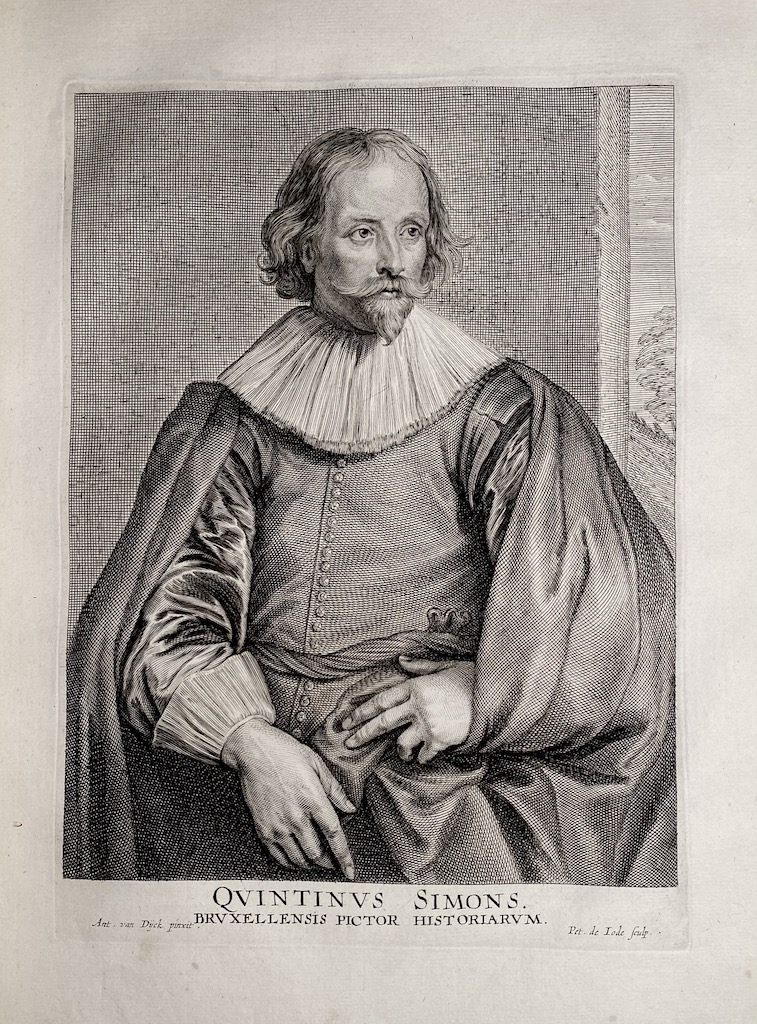
23. Quintijn Simons (Flemish, 1592 – after 1634); engraved by Pieter de Jode II. Inscription: “QVINTINVS SIMONIS. | BRVXELLENSIS PICTOR HISTORIARVM.”. In lower margin: “Ant. van Dijck pinxit.” <–> “Pet. de Iode sculp.”. Third state with second line of title added. 
24. Adriaan Stevens (Flemish, 1561 – 1640); engraved by Adriaen Lommelin. Inscription: "INTEGERRIMVS VIR ADRIANVS STEVENS / S.P.Q. ANTVERP. AB ELEMOSYNIS.". In lower margin:"Ant van Dÿc pinxit." <–> "A. Lommelin sculp.". British Museum # R,1b.20. 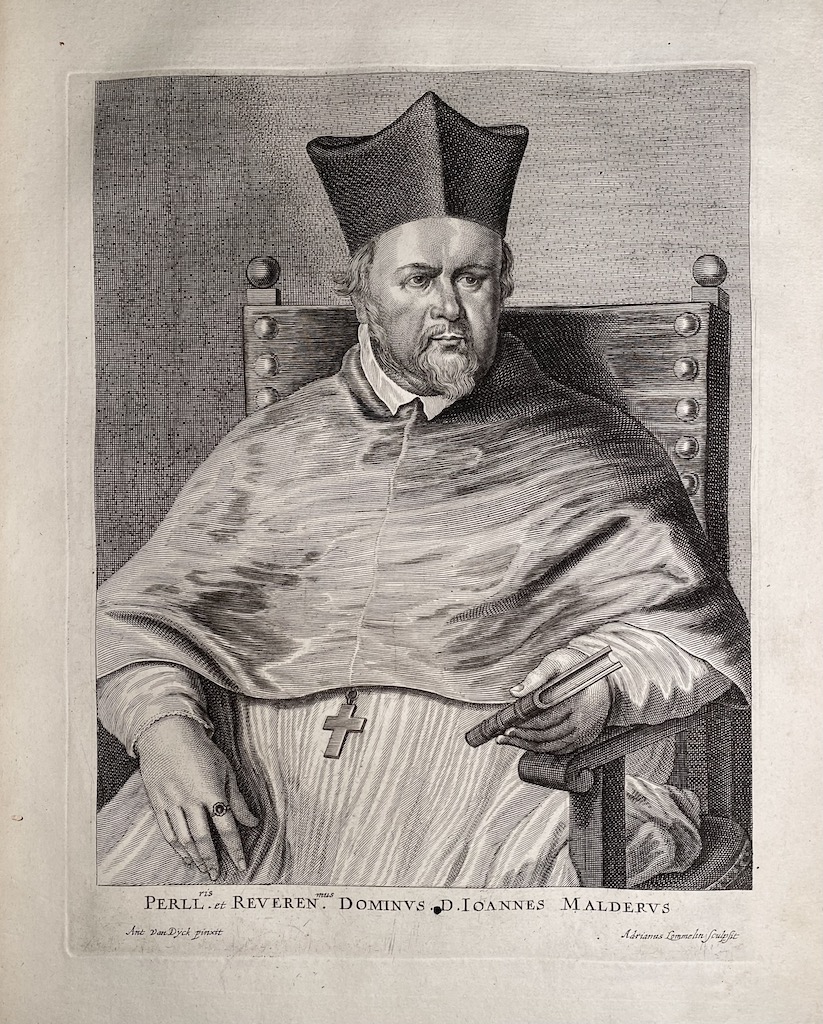
25. Jan van Malderus (Flemish, 1563 – 1633); engraved by Adriaen Lommelin. Inscription: “PERLL.ris et REVEREN.mus DOMINVS. D. IOANNES MALDERVS”. In lower margin: “Ant Van Dÿck pinxit” <–> “Adrianus Lommelin sculpsit”. 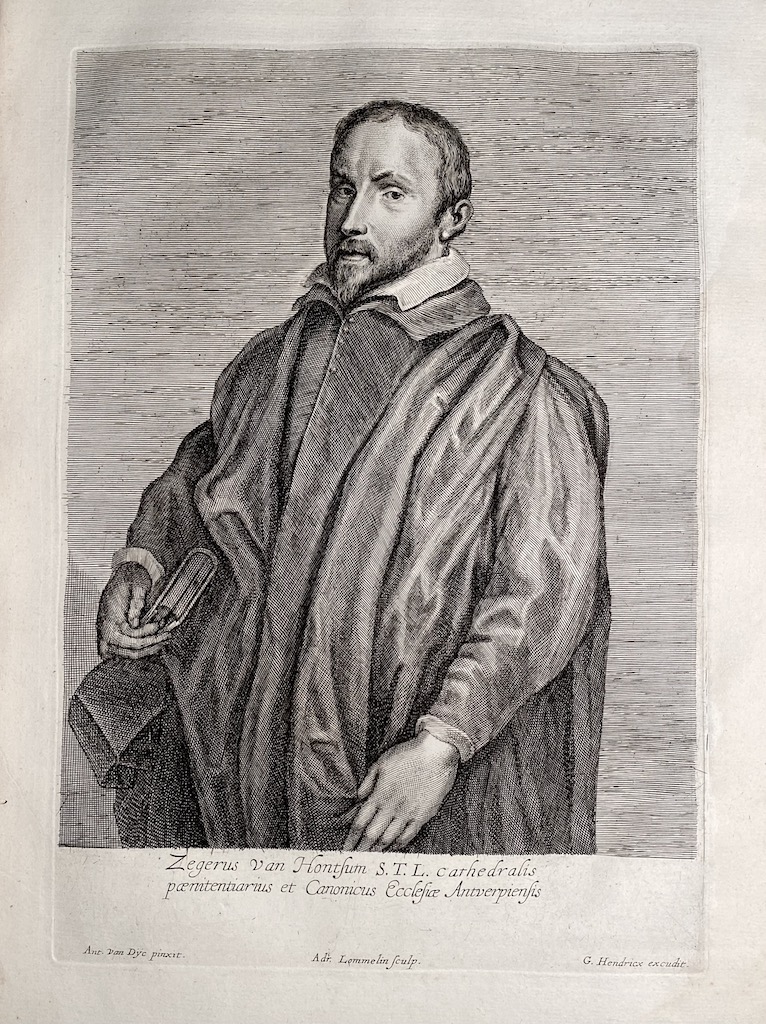
26. Zeger van Hontsum (Flemish, ? – -1643). Engraved by Adriaen Lommelin, published by Gillis Hendricx. Inscription: “Zegerus van Hontsum S.T.L. cathedralis | pænitentiarius et Canonicus Ecclesiæ Antuerpiensis”. In lower margin: “Ant. van Dÿc pinxit” <–> “Adr. Lommelin sculp.” <–> “G. Hendricx excudit”. 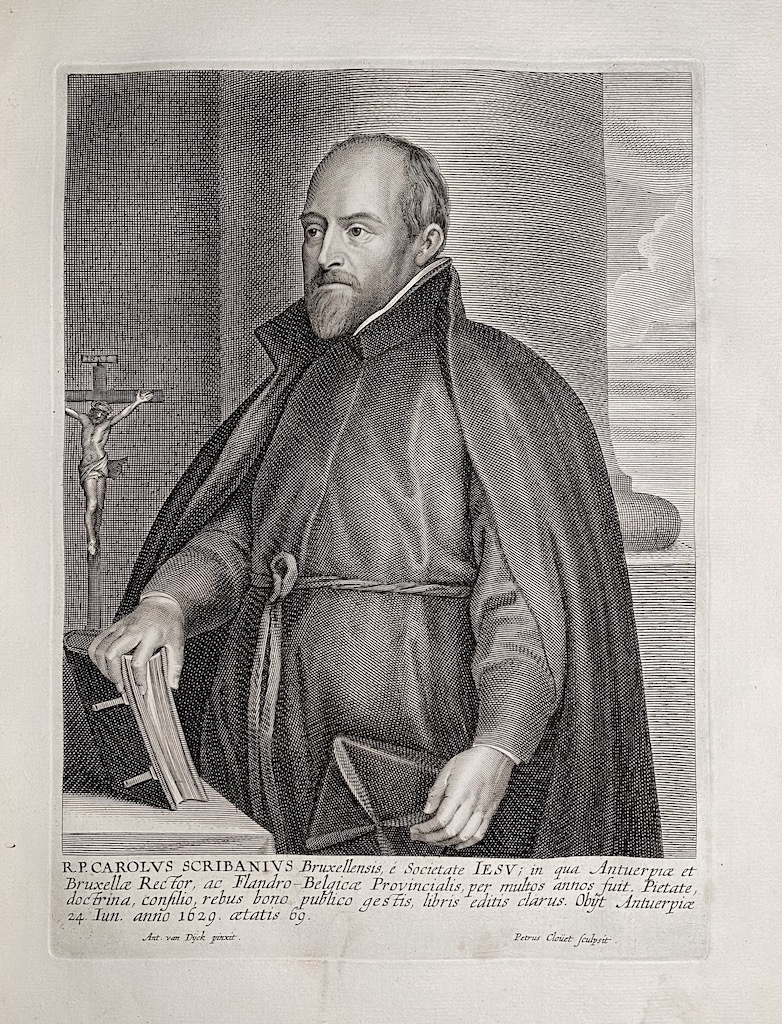
27. Carolus Scribani (Flemish, 1561 – 1629); engraved by Pieter Clouwet. Inscription: “R. P. CAROLVS SCRIBANIVS Bruxellensis, é Societate IESV; in qua Antuerpiæ et I Bruxellæ Rector, ac Flandro-Belgicæ Provincialis, per multos annos fuit. Pietate, | doctrina, consilio, rebus bono publico gestis, libris editis clarus. Obijt Antverpiæ | 24. Iun. anno 1629. ætatis 69.”. In lower margin: “Antonius van Dÿck pinxit.” <–> “Petrus Cloüet Sculpsit.”. Second, lettered state with the title and production details. 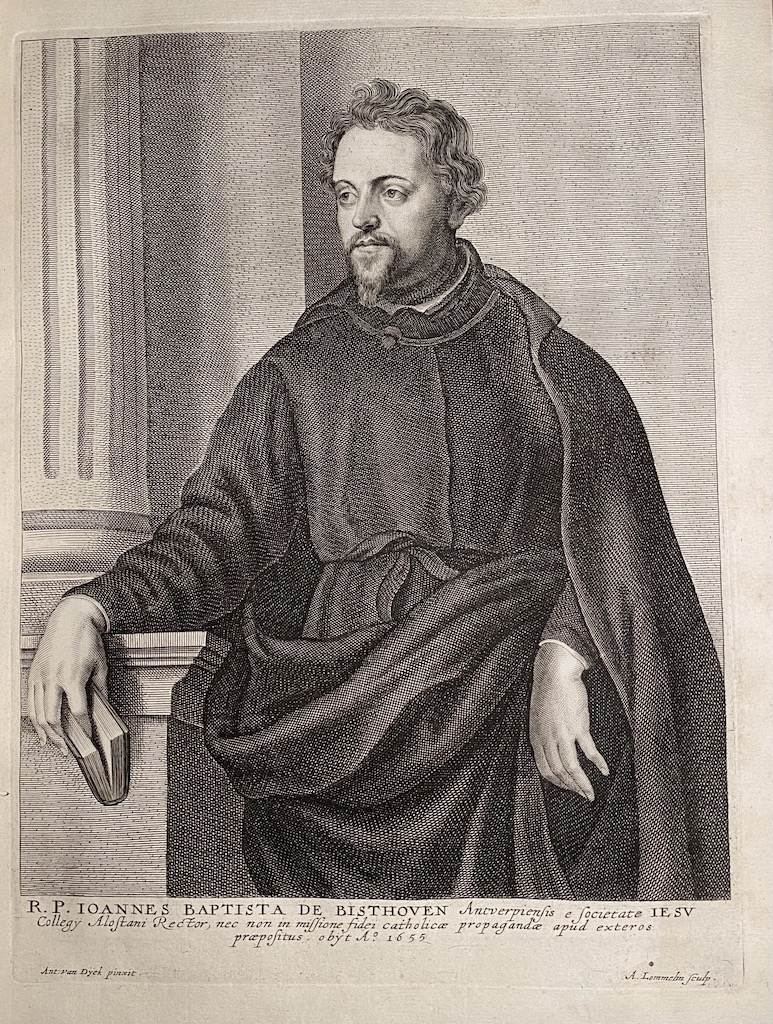
28. Jan Baptist van Bisthoven (Flemish, 1602 – 1655); engraved by Adriaen Lommelin. Inscription: “R.P. IOANNES BAPTISTA DE BISTHOVEN Antverpiensis e societate IESV | Collegÿ Alostani Rector, nec non in missione fidei catholicæ propagandæ apud exteros | præpositus obÿt A.o 1655”. In lower margin: “Ant:van Dÿck pinxit”, and “A. Lommelin sculp”. Second, lettered state with the title and production details. 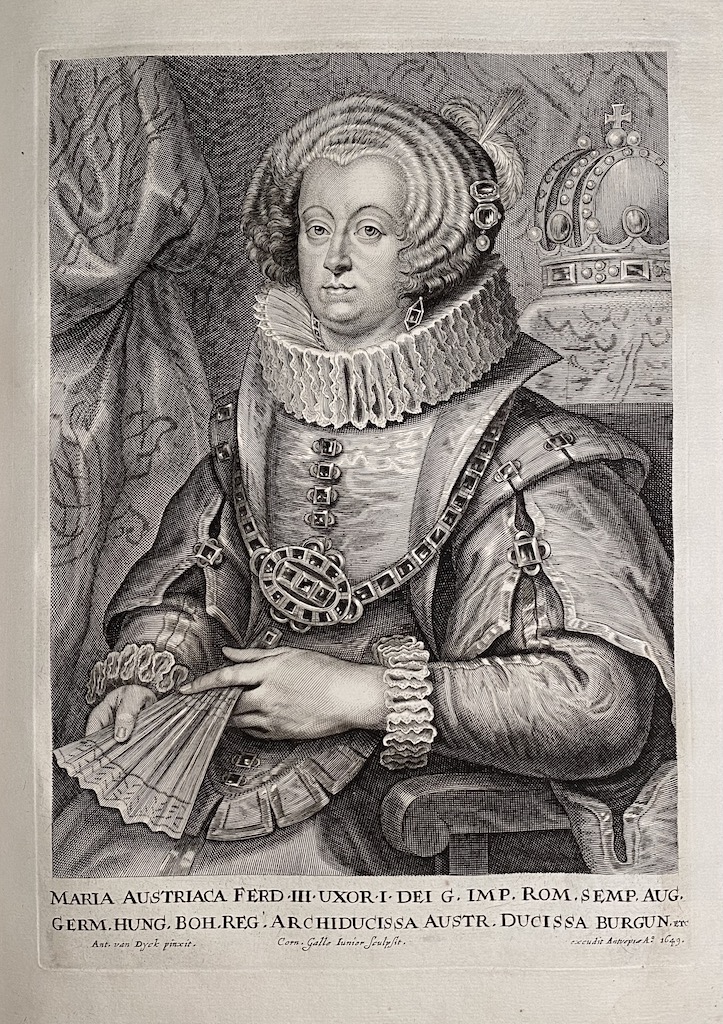
29. Maria of Austria (Spanish, 1606 – 1646); engraved by Cornelis Galle the Younger, published by Johannes Meyssens. Inscription: “MARIA AUSTRIACA FERD. III. UXOR. I. DEI G. IMP. ROM. SEMP. AUG. | GERM. HUNG. BOH. REG. ARCHIDUCISSA AUTR. DUCISSA BURGUN. ETC”. In lower margin: “Ant. van Dyck pinxit.” <–> “Corn. Galle Iunior sculpsit.” <–> “...excudit Antuerpiæ A.o 1649”. Third, lettered state with Meyssens’ name burnished badly. 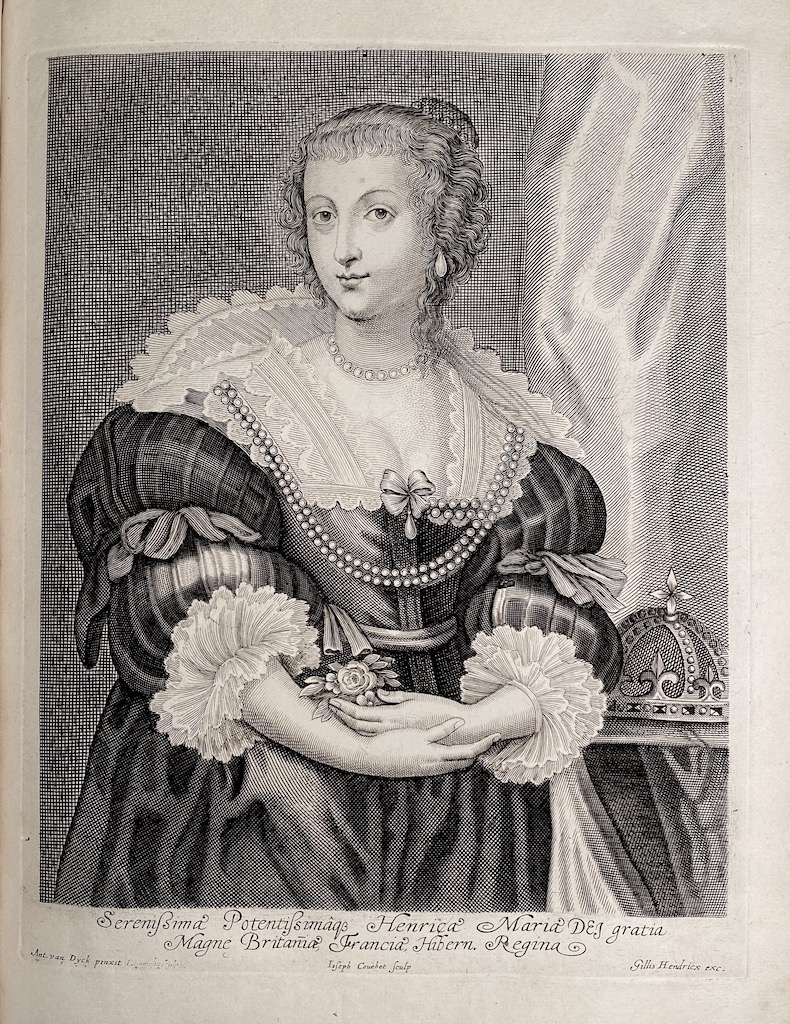
30. Henriette Marie de Bourbon, Queen of Charles I (French, 1609 – 1669); engraved by Antoine Couchet and Adriaen Lommelin, published by Gillis Hendricx. Inscription: “Serenißima Potenti∫simâq Henrica Maria Dei gratia | Magne Britaniæ, Franciæ, Hibern. Regina”. In lower margin: “Ant. van Dyck pinxit” <–> “Ioseph Couchet sculp” <–> “Gillis Hendricx exc.”. State with “Lommelin sculp.” right after “Ant. van Dyck pinxit” burnished, but still legible. 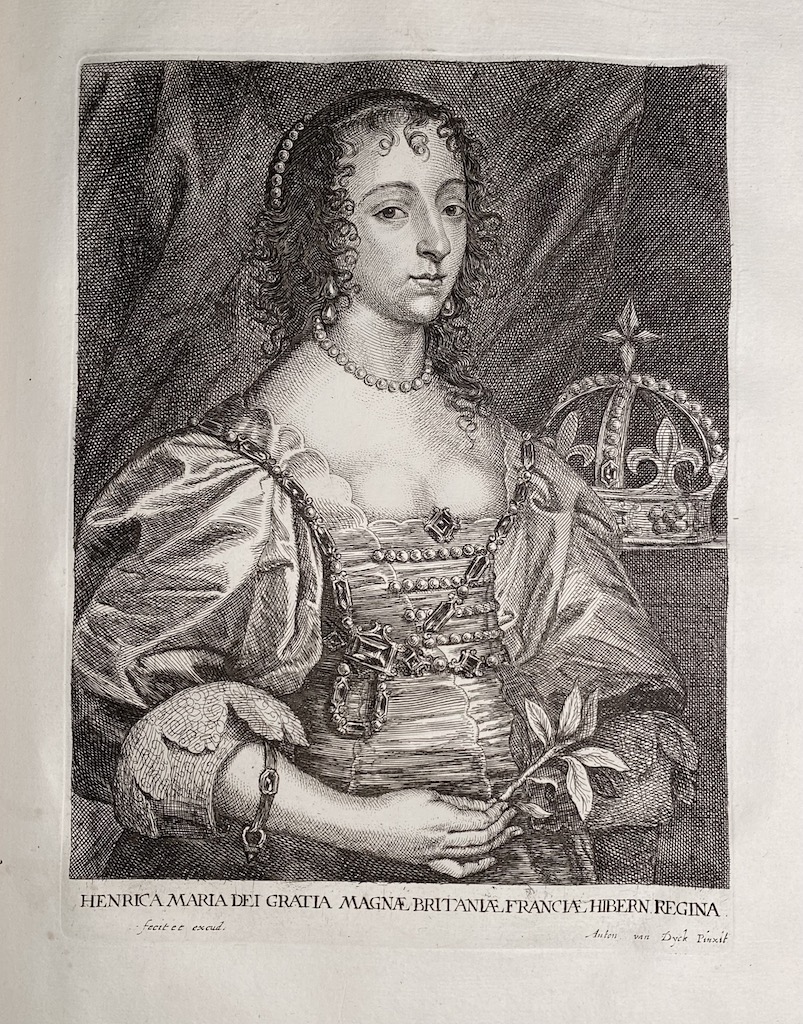
31. Henriette Marie de Bourbon, engraved and published by Ioannes Meyssens. Inscription: “HENRICA MARIA DEI GRATIA MAGNÆ BRITANIÆ FRANCIAÆ HIBERN. REGINA.”. In lower margin: “fecit et excud.” <–> “Anton van Dyck Pinxit”. Third state, finished with a burin; with Meyssens’ name burnished. [Similar to print №62 which has "Ioan. Mey∫ens" signature present]. 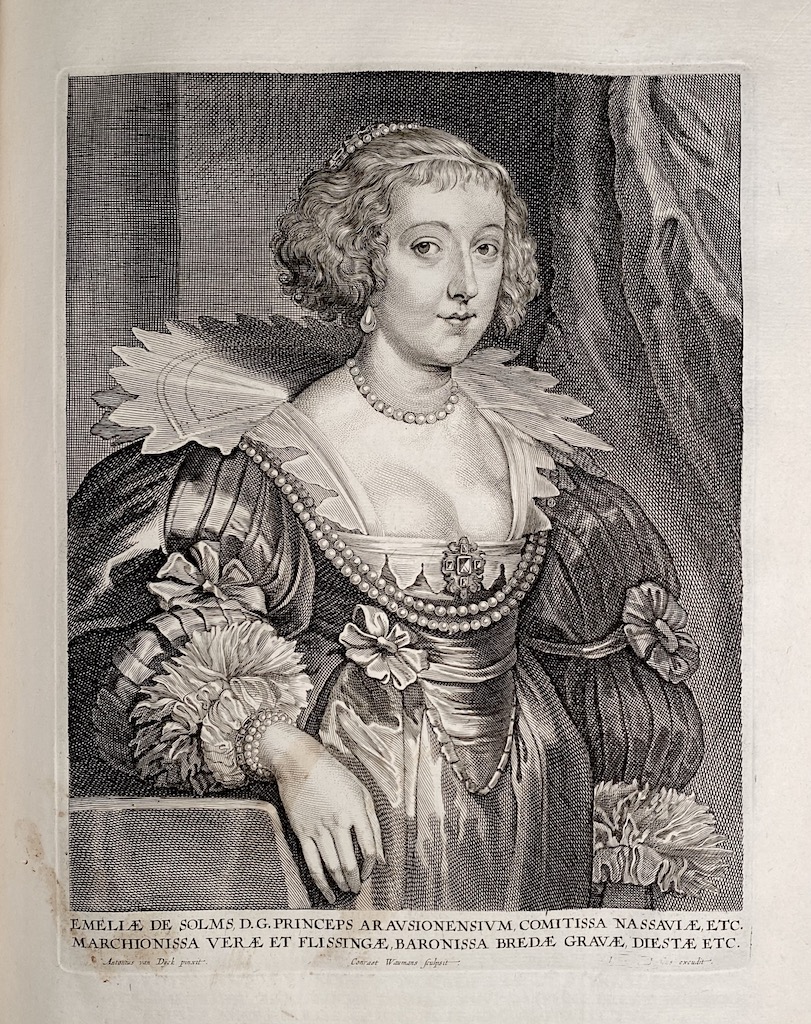
32. Amalia van Solms, Princess of Orange (German, 1602 – 1675), engraved by Conraad Waumans and published by Johannes Meyssens. Inscription: “EMELIÆ DE SOLMS, D. G. PRINCPES ARAVSIONENSIVM, COMITISSA NASSAUVIÆ, ETC. | MARCHIONISSA VERÆ ET FLISSINGÆ, BARONISSA BREDÆ, GRAVÆ, DIESTÆ ETC.”. In lower margin: “Antonius van Dijck pinxit.” <–> “Conraet Waumans sculpsit.” <–> “… excudit”. First, lettered state with the title and production details, with Meyssens’ name burnished. [Similar to №66, which has Ioannes Meysens name present]. 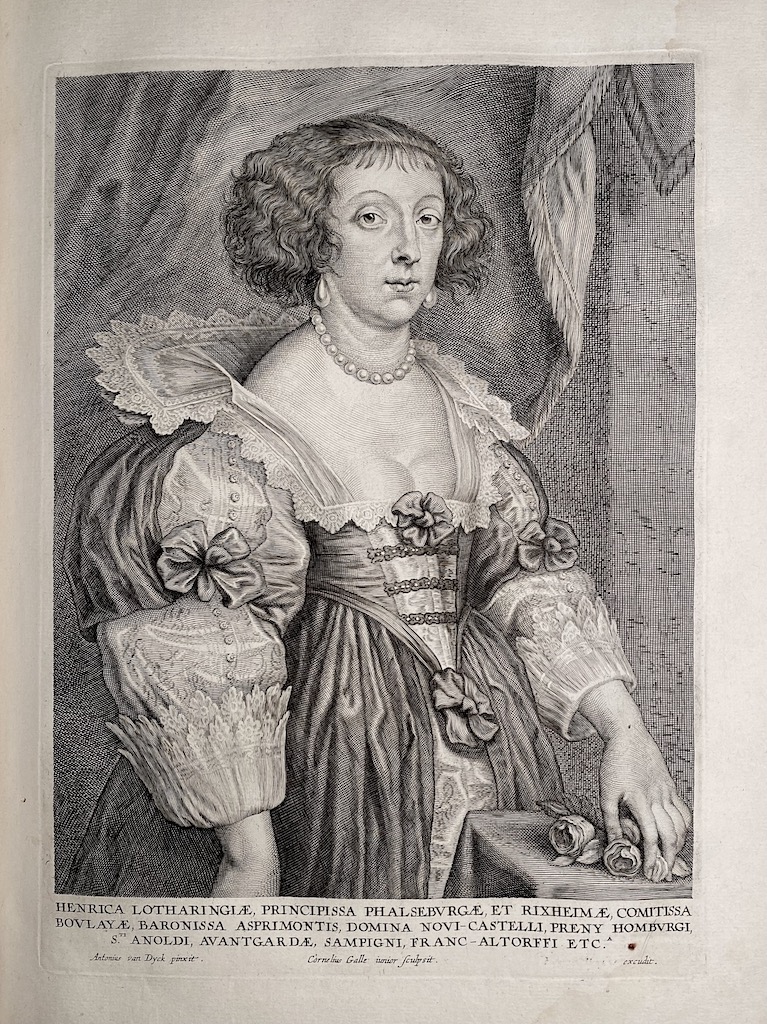
33. Henriette de Lorraine, Princess of Phalsbourg (or Pfalzburg) (French, 1605 – 1660); engraved by Cornelis Galle the Younger, published by Ioannes Meyssens. Inscription: “HENRICA LOTHARINGIÆ, PRINCIPISSA PHALSEBVRGÆ, ET RIXHEIMÆ, COMITISSA | BOVLAYÆ, BARONISSA ASPIRIMONTIS, DOMINA NOVI-CASTELLI, PRENY | HOMBVRGI, S.TI ANOLDI, AVANTGARDÆ, SAMPIGNI, FRANC-ALTORFFI ETC.A”. In lower margin: “Antonius van Dyck pinxit.” <–> “Cornelius Galle iunior sculpsit.” <–> “… excudit.”. First state with the title and production details, with Ioannes Meyssens’ name burnished. British Museum # R,1a.248. 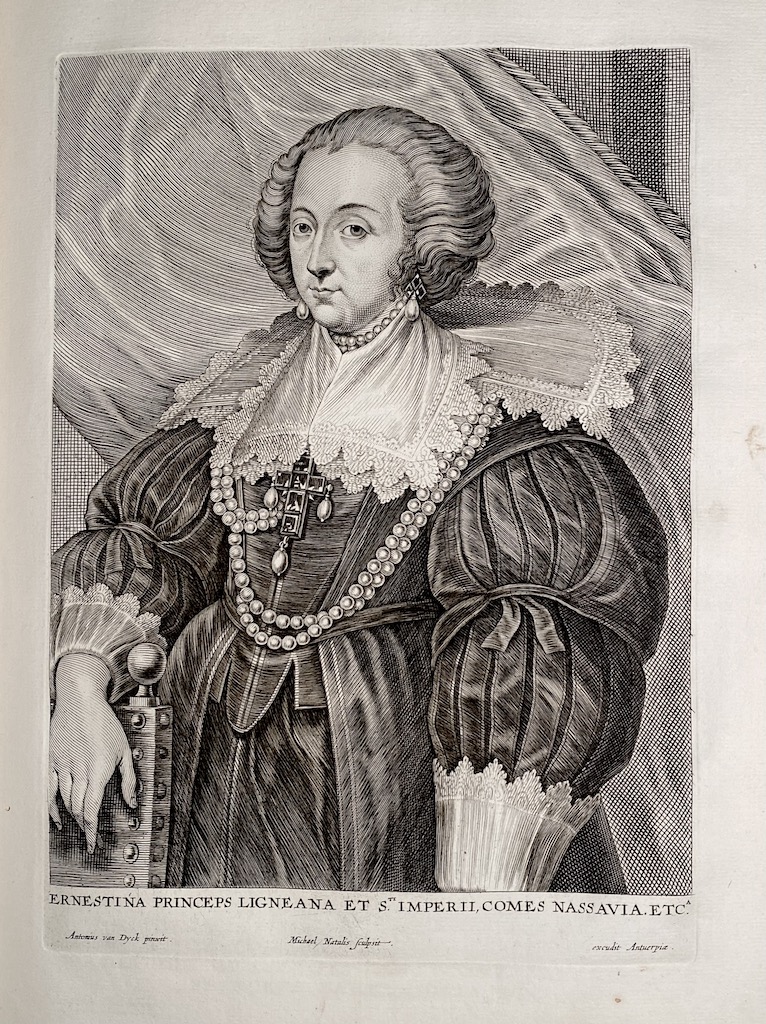
34. Ernestine Yolande de Ligne, Countess of Nassau-Siegen (Flemish, 1594 – 1668); engraved by Michiel Natalis, published by Jan Meyssens. Inscription: “ERNESTINA PRINCEPS LIGNEANA ET S.TI IMPERII, COMES NASSAVI. ETC.A”. In lower margin: “Antonius van Dyck pinxit.” <–> “Michael Natalis sculpsit.” <–> “…excudit Antuerpiæ.”. Second state with the initials of Ioannes Meyssens erased. 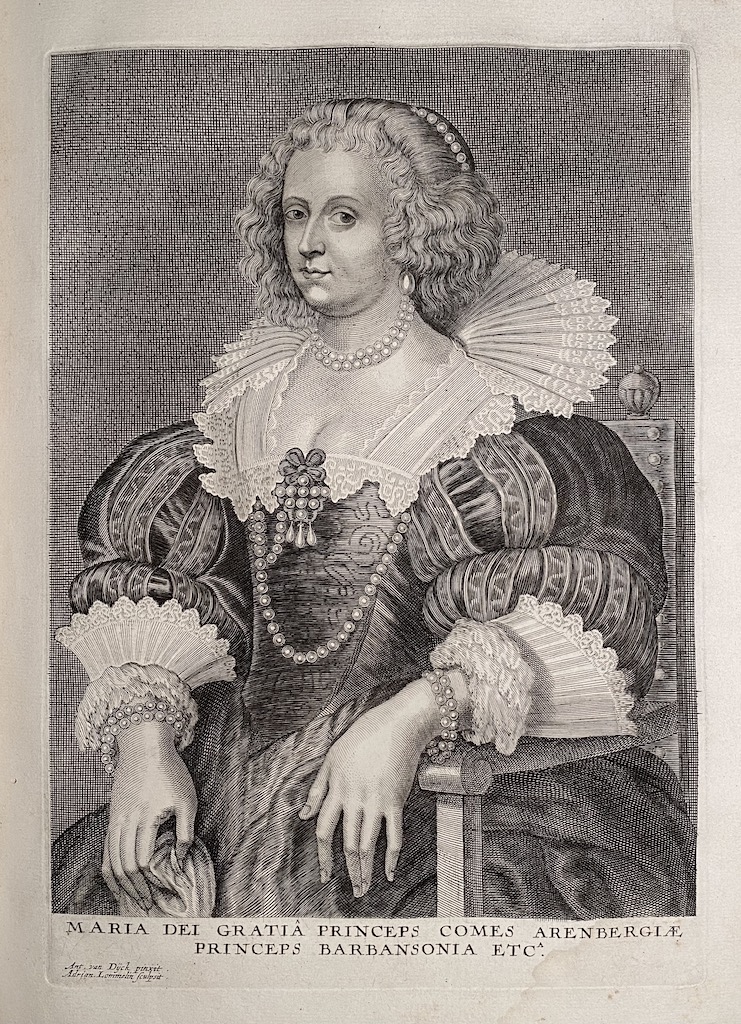
35. Marie de Barbançon, Princess of Arenberg (1602 – 1675); engraved by Adriaen Lommelin. Inscription: “MARIA DEI GRATIÂ PRINCEPS COMES ARENBERGIÆ | PRINCEPS BARBASONIA ETC.A”. In lower margin: “Ant. van Dÿck pinxit. | Adrian. Lommelin sculpsit.”. Second, lettered state with title and production details and adjustments made in the face. British Museum # 1876,1014.181 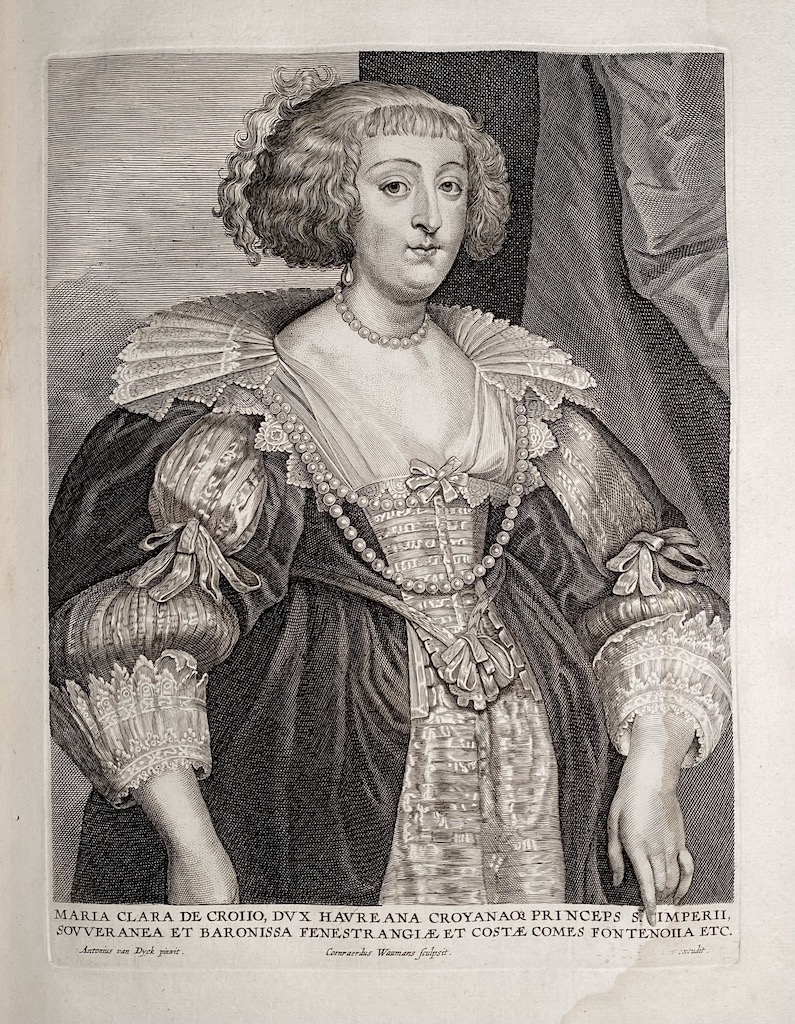
36. Marie-Claire de Croy, Duchess of Havré (Flemish, 1605 – 1664); engraved by Conraad Waumans, published by Ioannes Meyssens. Inscription: “MARIA CLARA DE CROIIO, DVX HAVREANA CROYANAQ3 PRINCEPS STE. IMPERII, | SOVVERANEA ET BARONISSA FENESTRANGIÆ ET COSTÆ COMES FONTENOIIA ETC.”. In lower margin: “Antonius van Dyck pinxit.” <–> “Coenraerdus Waumans sculpsit.” <–> “…excudit.”. Third state with Ioannes Meyssens’ name burnished. British Museum # 1891,1015.21. [Similar to №64, which has Ioannes Meysens’ name present]. 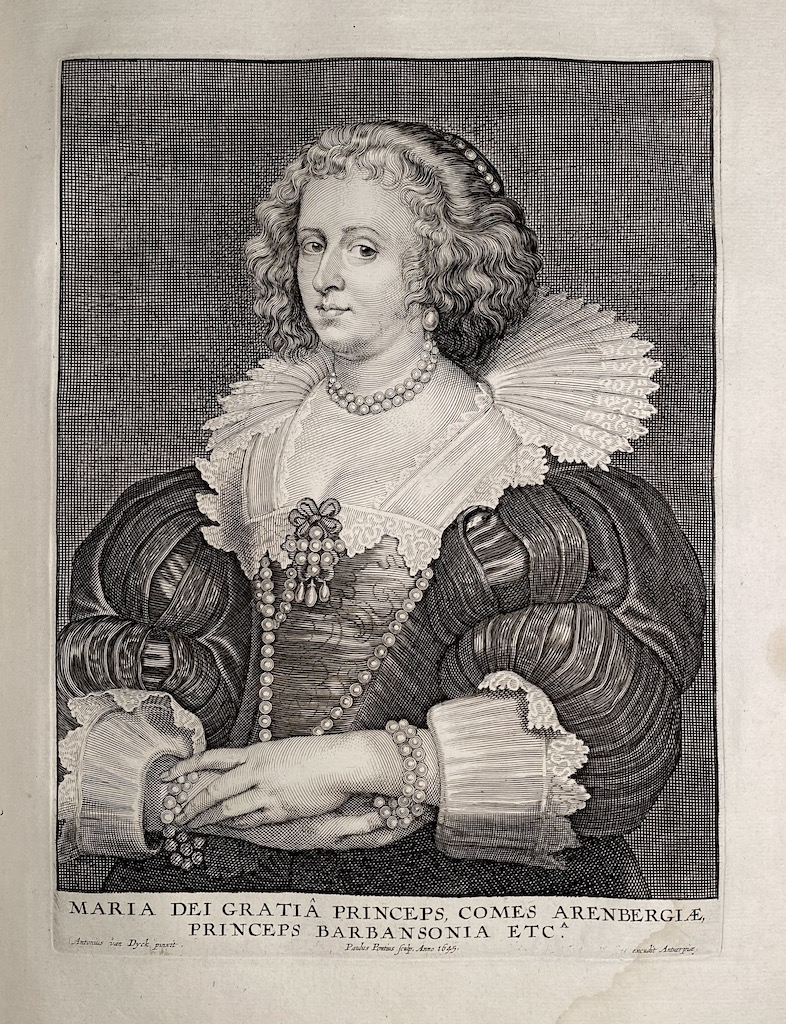
37. Marie de Barbançon, Princess of Arenberg (1602 – 1675); engraved by Paulus Pontius, published by Ioannes Meyssens. Inscription: “MARIA DEI GRATIÂ PRINCEPS COMES ARENBERGIÆ, | PRINCEPS BARBASONIA ETC.A”. In lower margin: “Antonius van Dyck pinxit. | Paulus Pontius sculp. Anno 1645.” <–> “… excudit Antuerpiæ”. Second state with a thick borderline, title and production details added, Ioannes Meyssens’s name burnished. 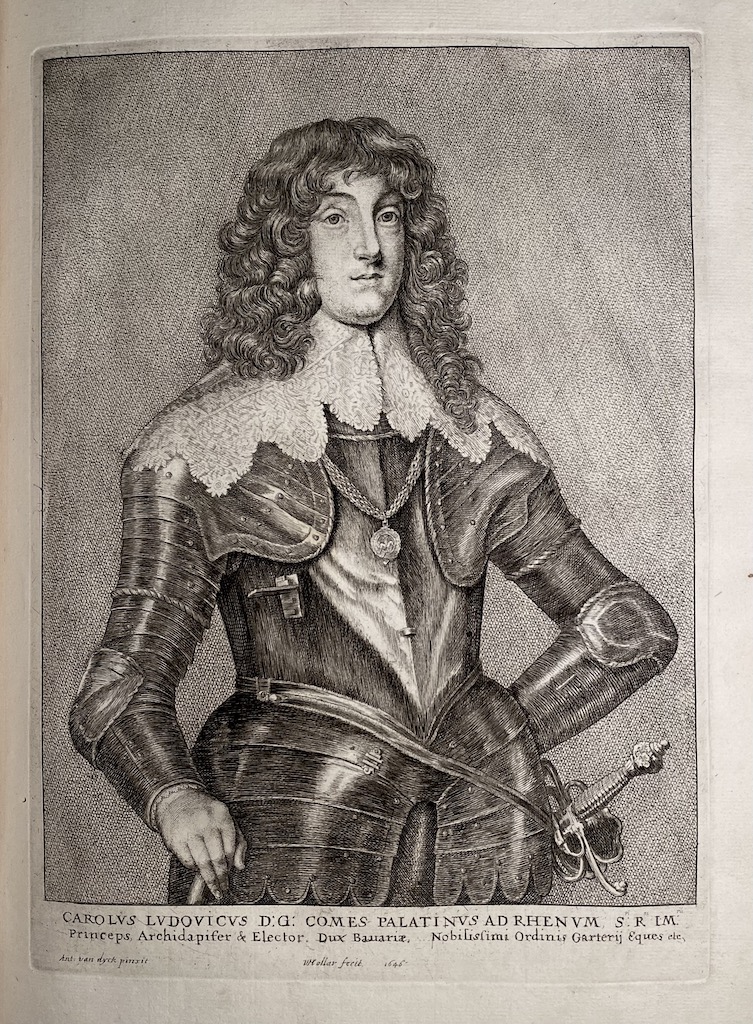
38. Karl I Ludwig, Elector Palatine (German, 1617 – 1680); engraved by Wenceslaus Hollar (Bohemian, 1607 – 1677). Inscription: “CAROLVS LVDOVICVS D:G: COMES PALATINVS AD RHENVM, S:ri R.ni IM:rii | Princeps, Archidapifer & Elector, Dux Bauariæ, …Nobilissimi Ordinis Garterij Eques etc.”. Below: “Ant: van Dyck pinxit” <–> “WHollar fecit,” <–> “1646”. First, lettered state with the title and production details, without “H: van de Borcht excu:”. British Museum # 1867,1012.598. Hendrik van der Borcht II (Dutch, 1614 – c. 1690) 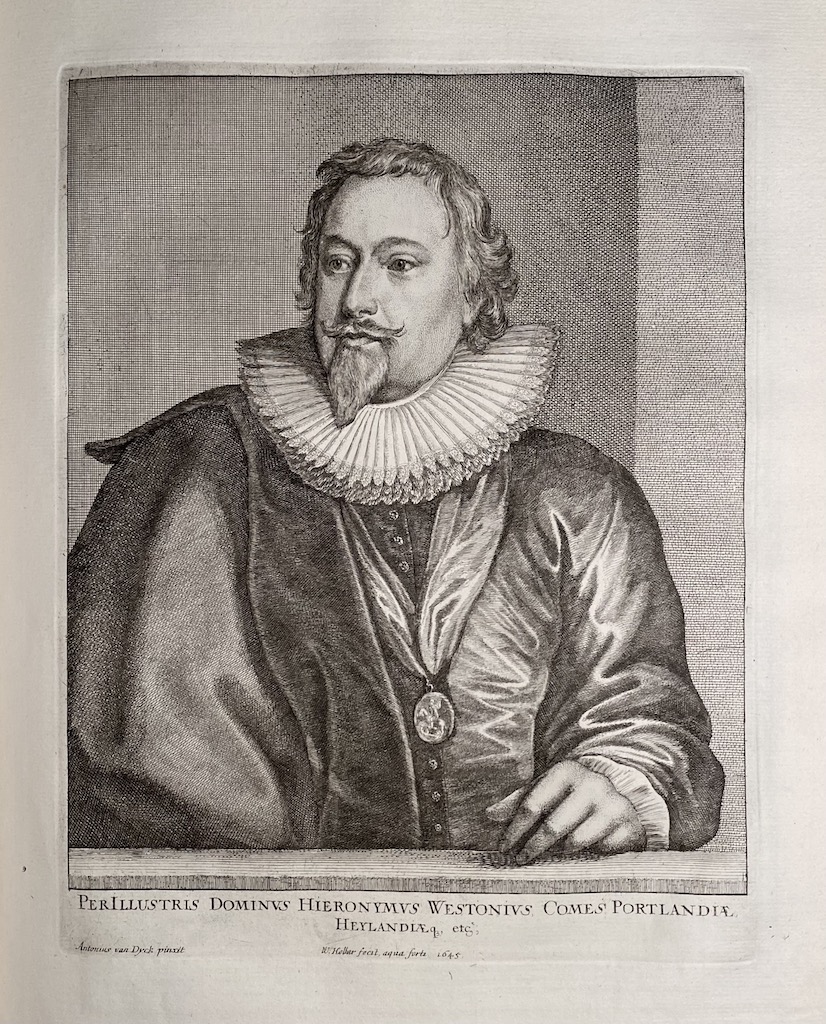
39. Richard Weston, 1st Earl of Portland (British, 1577 – 1635); engraved by Wenceslaus Hollar, published by Ioannes Meyssens. Inscription: “PERILLUSTRIS DOMINVS HIERONYMVS WESTONIVS, COMES PORTLANDIÆ, | HEYLANDÆq3, etc’,”. Below: “Antonius van Dyck pinxit”<–> “W: Hollar fecit, aqua forte. 1645”. Ioannes Meyssens’s name completely burnished. 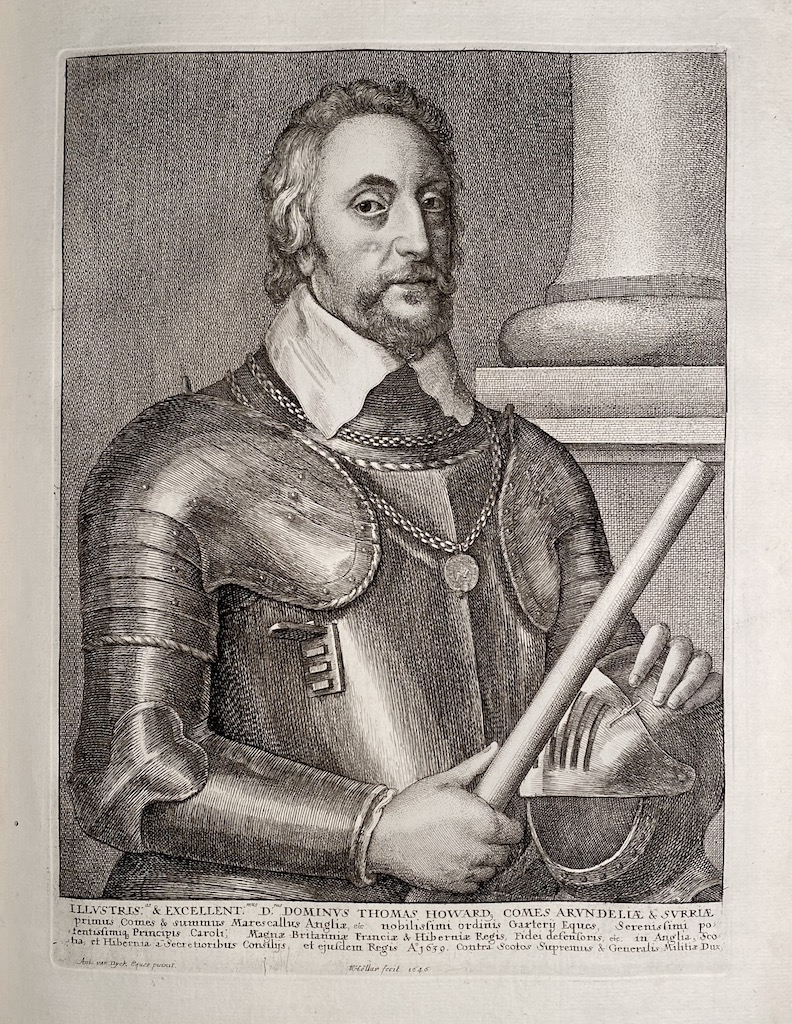
40. Thomas Howard, 14th Earl of Arundel (British, 1585 – 1646); engraved by Wenceslaus Hollar, published by Ioannes Meyssens. Inscription: "ILLVSTRIS:us & EXCELLENT:mus D:nus. DOMINVS THOMAS HOWARD, COMES ARXNDELIÆ & SVRRIÆ | primus Comes & summus Marescallus Angliæ, etc nobilisimi ordiuis Garterÿ Eques, Serenis∫imi po: | tentis∫imq3 Principis Caroli: Magnæ Britanniæ & Hiberniæ Regis, Fidei defen∫oris, etc. in Anglia, Sco | tia et Hibernia a Secretioribus Consilijs, et eju∫dem Regis Ao1639. Contra | Scotos Supremus & Generalis Militiæ Dux,”. In lower margin: “Ant: van Dyck Eques pinxit” <–> “WHollar fecit 1646”. Second state with Ioannes Meyssens’s name completely burnished. 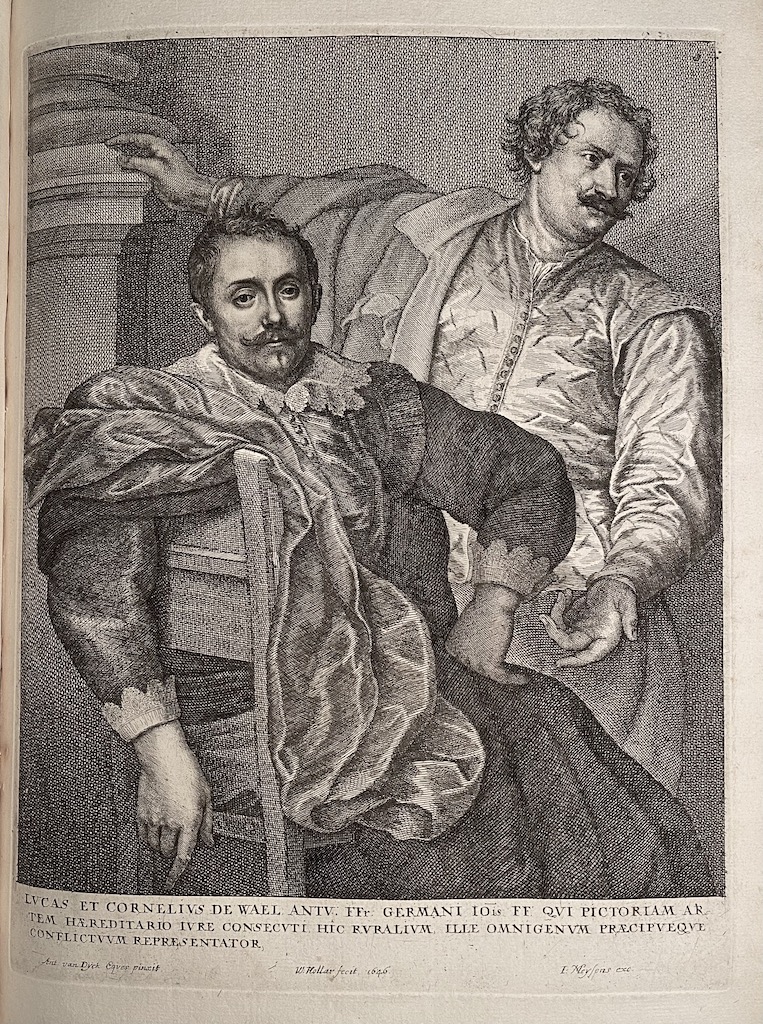
41. Lucas de Wael (Flemish, 1591 – 1661) and Cornelis de Wael (Flemish, 1592 – 1667); engraved by Wenceslaus Hollar, published by Ioannes Meyssens. Inscription: “LVCAS ET CORNELIVS DE WAEL ANTV: FFr. GERMANI IOis QUI PICTORIAM AR | TEM HÆREDITARIO IVRE CONSECVTI HIC RVRALIVM, ILLE OMNIGENVM PRÆCIPVEQVE / CONFLICTVVM REPRÆSENTATOR.”. In lower margin: “Ant. van Dyck Eques pinxit.” <–> “W: Hollar fecit, 1646.” <–> “I: Meysens exc”. First, lettered state with the title and production details. 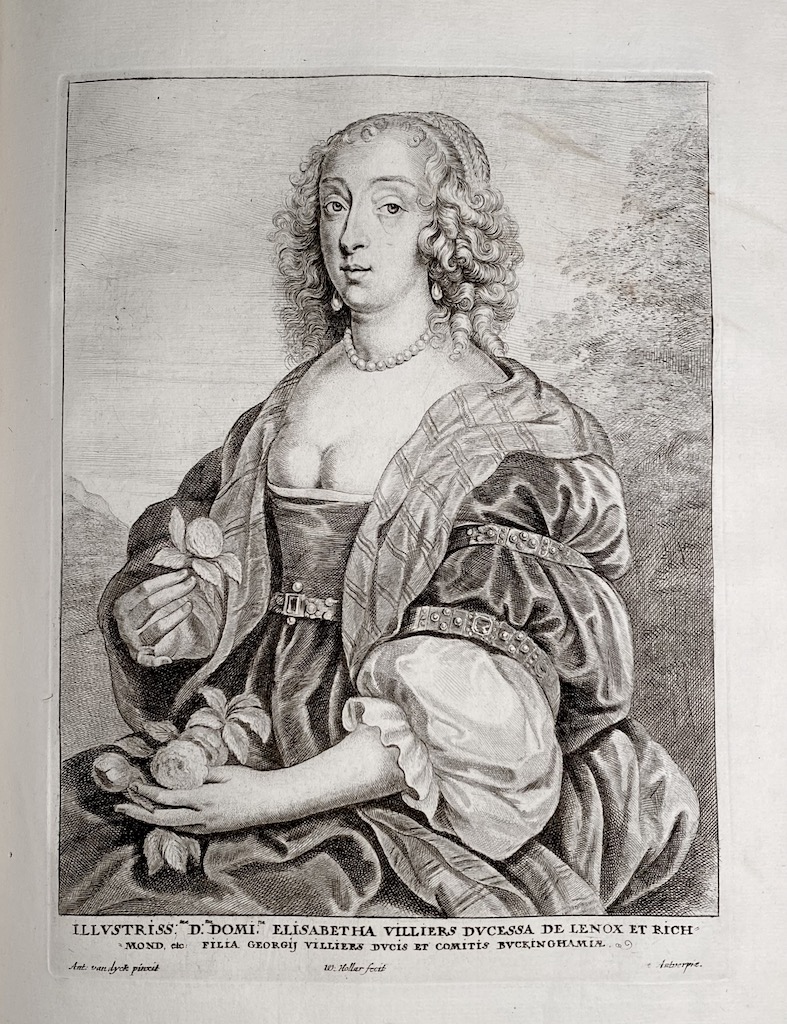
42. Mary (Elisabetha ) Villiers, Duchess of Lennox and Richmond (British, 1622 – 1685); engraved by Wenceslaus Hollar, published by Ioannes Meyssens. Inscription: “ILLUSTRISS: ma D:ma DOMI.na ELISABETHA VILLIERS DVCESSA DE LENOX ET RICH | MOND. etc: FILIA GEORGIJ VILLIERS DVCIS ET COMITIS BVCKINGHAMIÆ.”. In lower margin: “Ant: van dyck pinxit” <–> “W:Hollar fecit” <–> “… Antverpiæ.”. Ioannes Meyssens’ name completely burnished. First state with the title and production details. 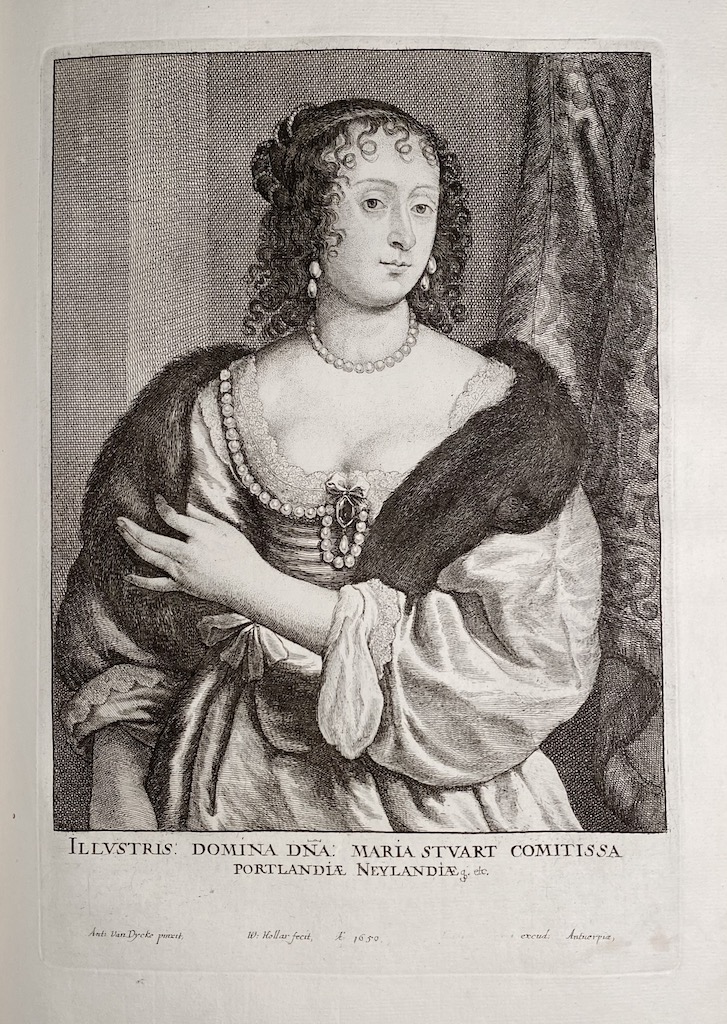
43. Frances (Maria) Stuart, Countess of Portland (British, 1617 – 1694); engraved by Wenceslaus Hollar, published by Ioannes Meyssens. Inscription: “ILLVSTRIS: DOMINA DNA: MARIA STVART COMITISSA | PORTLANDIÆ NEYLANDIÆ, etc.”. Below: “Ant: Van Dycke pinxit,” <–> “W: Hollar fecit, A:o 1650,”, “...excud: Antuerpiæ,”. Second state with Meyssens’ name burnished. British Museum # 1853,0112.1761 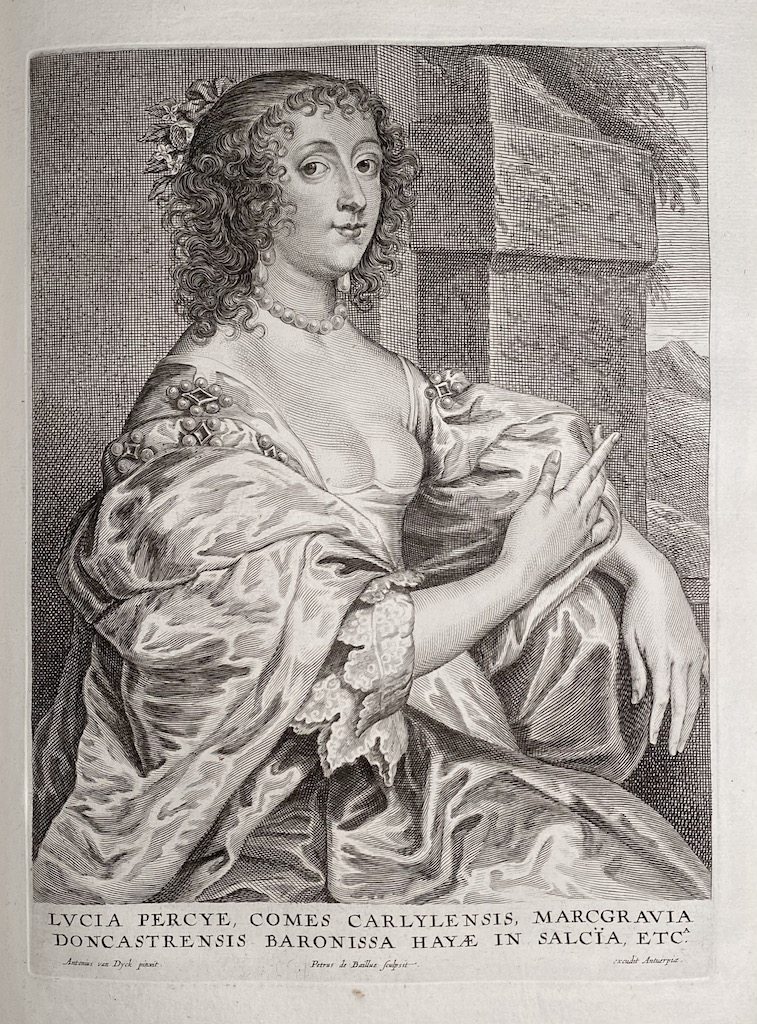
44. Lucy Percy, Countess of Carlisle (British, 1599 – 1660); engraved by Pieter de Bailliu, published by Ioannes Meyssens. Inscription: “LVCIA PERCYE, COMES CARLYLENSIS, MARCGRAVIA | DONCASTRENSIS BARONISSA HAYÆ IN SALCÏA, ETC.A”. In lower margin: “Antonius van Dyck pinxit.” <–> “Petrus de Baillue sculpsit.” <–> “...excudit Antuerpia.”. Third, lettered state with Joannes Meyssens’ name burnished. 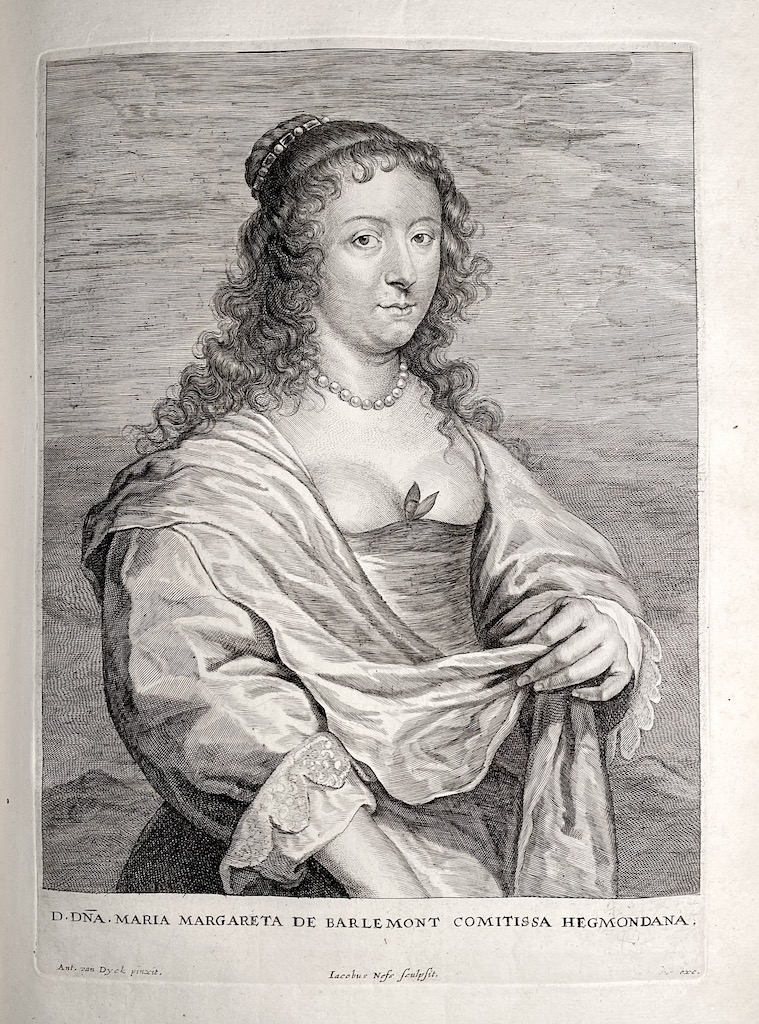
45. Marie-Marguerite de Berlaymont ( ? – 1654); engraved by Jacobus Neeffs, published by Ioannes Meyssens. Inscription: “D.DNA. MARIA MARGARETA DE BARLEMONT COMITISSA HEGMONDANA.” In lower margin: “Ant. van Dyck pinxit.” <–> “Iacobus Nefs sculpsit.”<–> “...exc.”. Fourth state with Ioannes Meyssens’ name erased. British Museum # 1876,1014.206. [Similar to №67, which has Ioannes Meysens name present]. 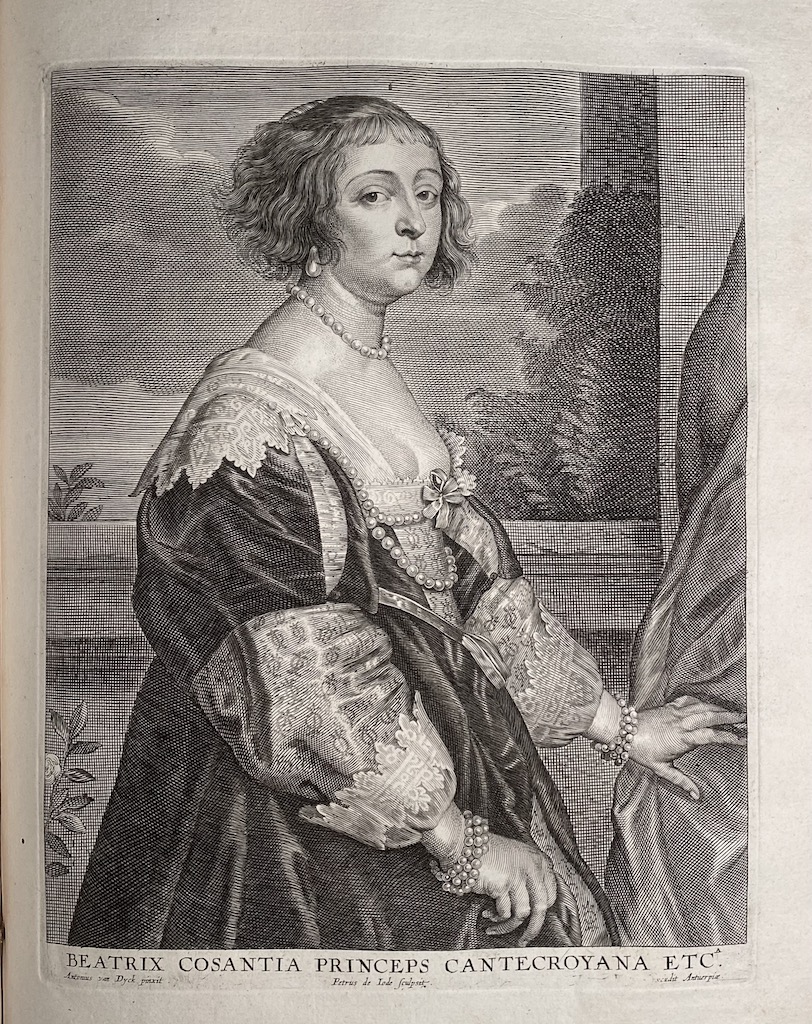
46. Béatrix Constance de Cussance, Princess of Cantecroix (French, 1614 – 1663); engraved by Pieter de Jode II, published by Ioannes Meyssens. Inscription: “BEATRIX COSANTIA PRINCEPS CANTECROYANA ETC.A”. In lower margin: “Antonius van Dyck pinxit” <–>“Petrus de Iode sculpsit.” <–> “… excudit Antuerpiæ.”. Second, lettered state with Meyssens’ name burnished. 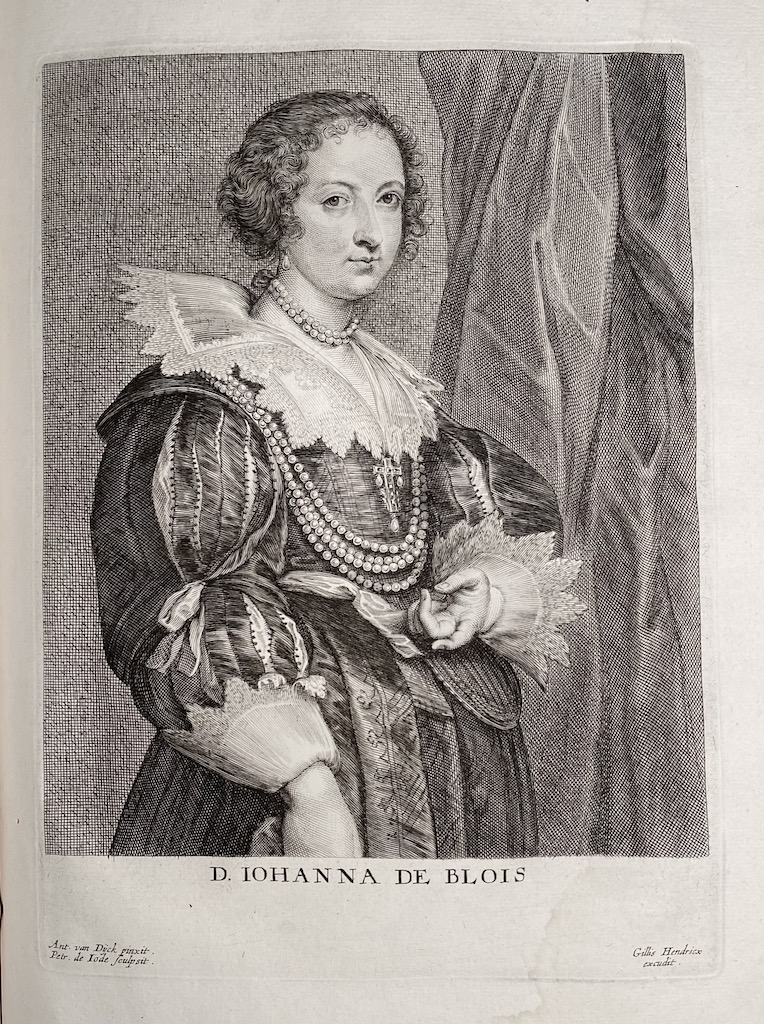
47. Johanna de Blois; engraved by Pieter de Jode II, published by Gillis Hendricx. Inscription: “D. IOHANNA DE BLOIS”. In the lower margin: “Ant. van Dÿck pinxit | Petr. de Iode sculpsit” <–> “Gillis Hendricx | excudit.”. British Museum # 1876,1014.189. 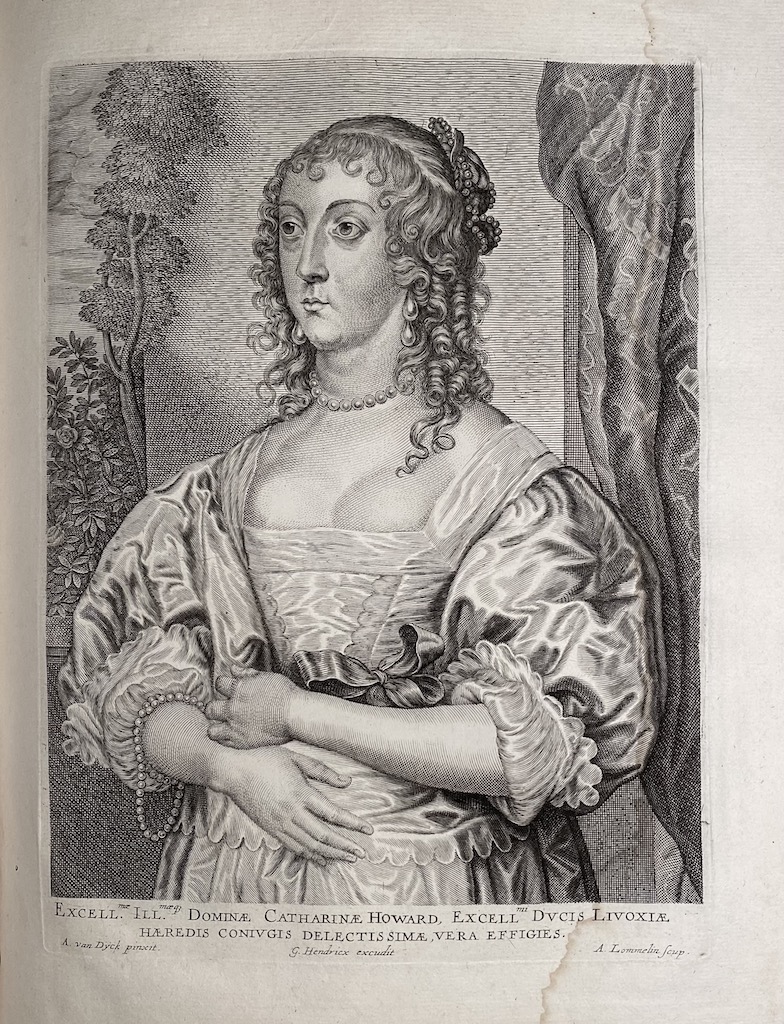
48. Katherine Howard, Countess of Newburgh, Lady d’Aubigny (British, ? – 1650); engraved by Adriaen Lommelin, published by Gillis Hendricx. Inscription: “EXCELLmæ ILL.mæq3 DOMINÆ CATHARINÆ HOWARD, EXCELLmi DUCIS LIVOXIÆ | HÆREDIS CONIUGIS DELECTISSIMÆ, VERA EFFIGIES.” In lower margin: “A. van Dÿck pinxit.” <–> “G. Hendricx excudit” <–> “A. Lommelin scup.”. British Museum # P,3.326 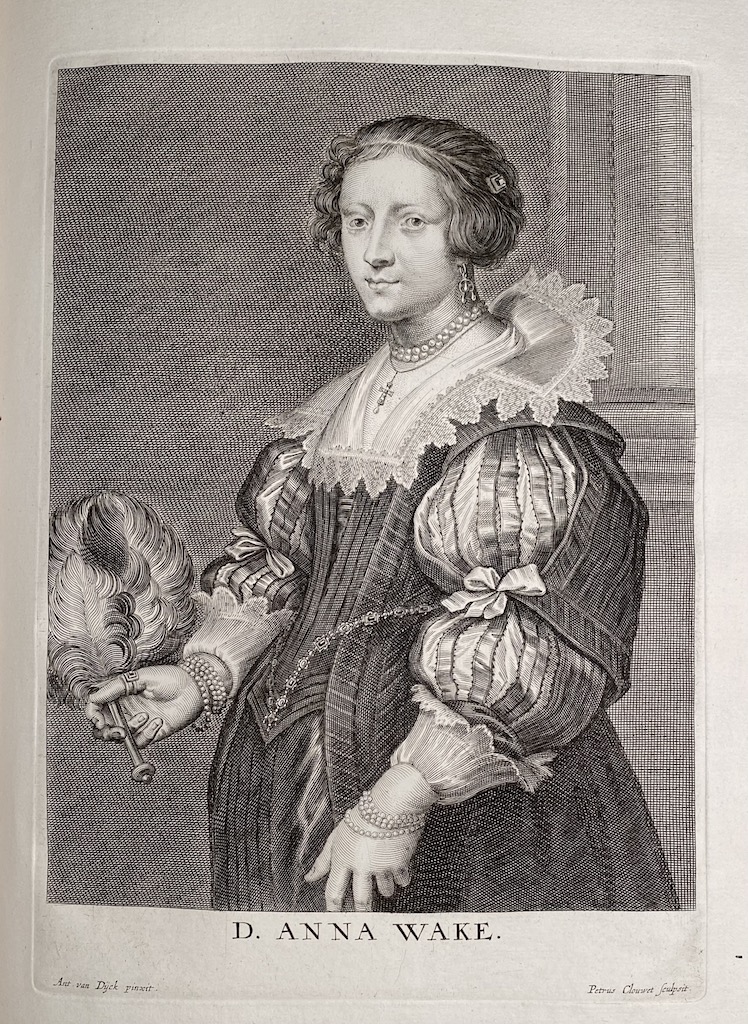
49. Anna Wake (Flemish, 1606 – 1680); engraved by Pieter Clouwet. Inscription: “D. ANNA WAKE.”. In lower margin: “Ant. van Dÿck pinxit.” <–> “Petrus Clouwet sculpsit”. 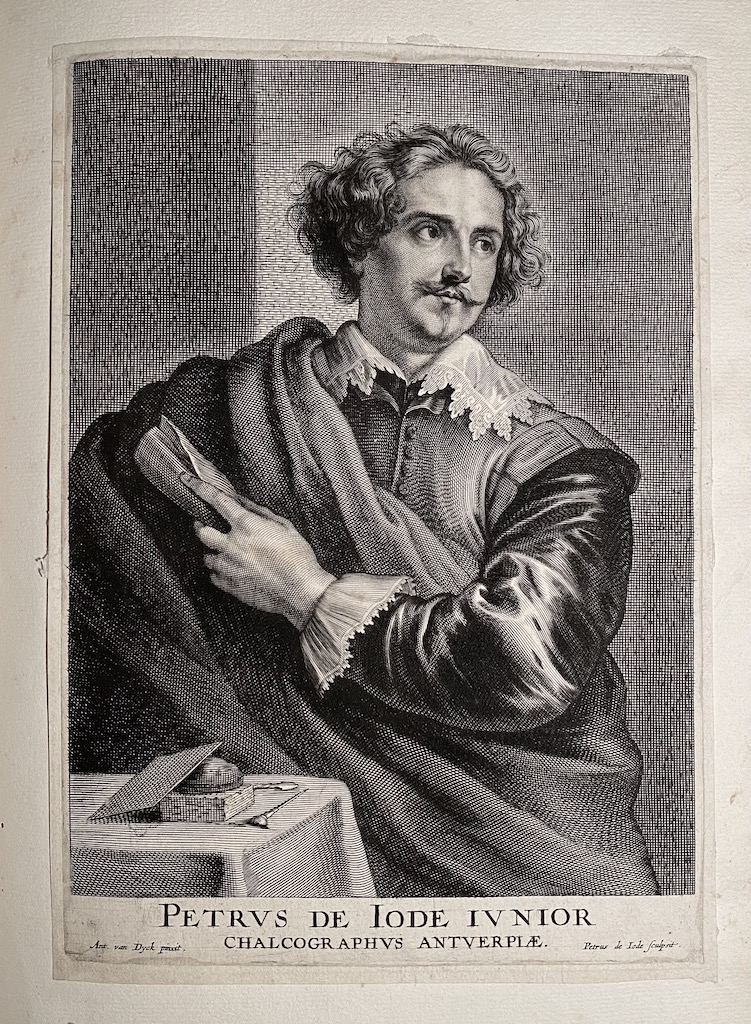
50. Pieter de Jode II (Flemish, 1606-1670/74); engraved by Pieter de Jode II. Inscription: “PETRVS DE IODE IVNIOR / CHALCOGRAPHVS ANTVERPIÆ.”. In lower margin: “Ant. van Dyck pinxit.”<–> “Petrus de Iode sculpsit.”. Third state (before the initials G.H. (of Gillis Hendricx) added. The print with cut off margins pasted to the bound-in leaf. 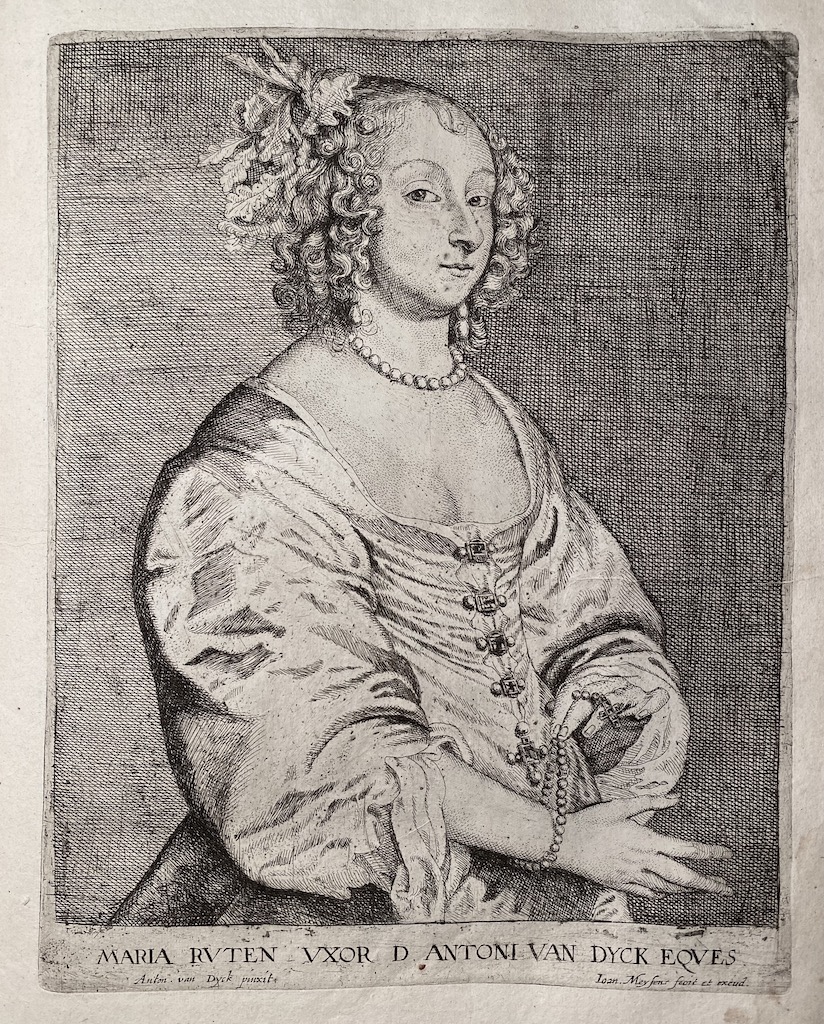
51. Mary Ruthven, Lady van Dyck (Scottish, c. 1622 – 1645); engraved and published by Ioannes Meyssens. Inscription: “MARIA RVTEN VXOR D. ANTONI VAN DYCK EQVES”. In lower margin: “Anton.van Dyck pinxit” <–> “Ioan. Meysens fecit et excud.”. First, lettered state with the title and production details. Tired plate. British Museum # 1863,0725.747. Van Dyck's wife. 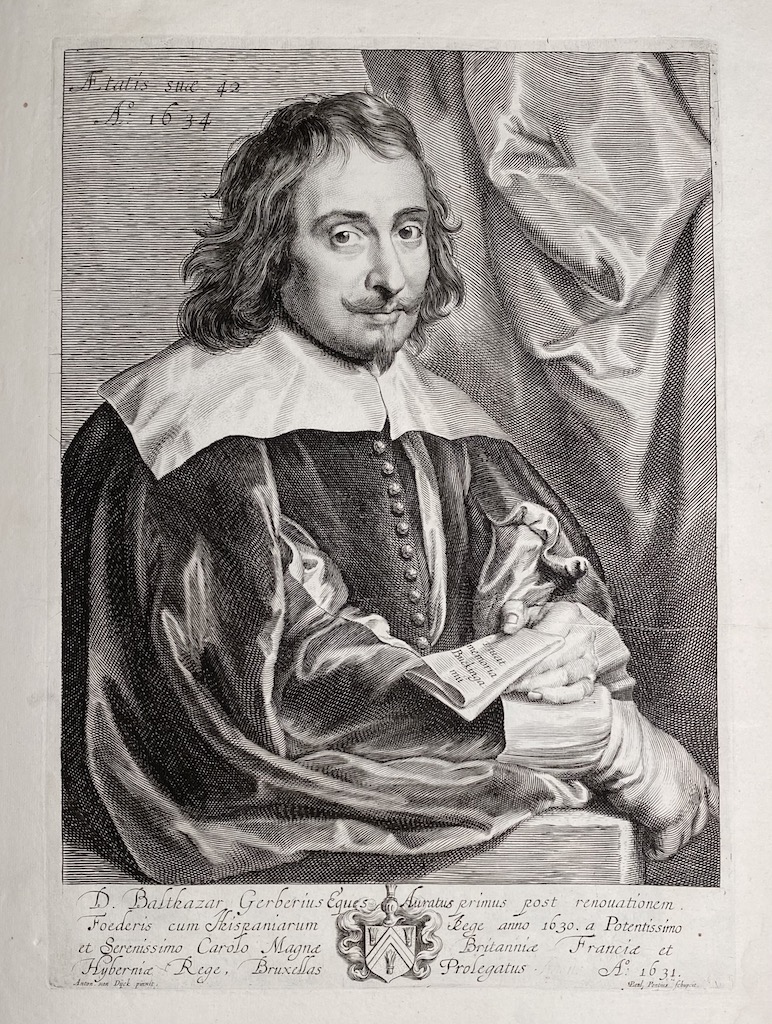
52. Sir Balthazar Gerbier (British, Flemish, 1592 – 1663); engraved by Paulus Pontius. Inscription: “D. Balthazar Gerberius Eques Auratus primus post renouationem. | Foederis cum Hispaniarum Rege anno 1630. A Potentissimo | et Serenissimo Carolo Magnæ Britanniæ Franciæ et Hiberniæ. Rege, Bruxellas Prolegatus. A:o 1631”. Below “Anton van Dyck pinxit”<–> “Paul Pontius schupcit.”. Top left corner: “Ætatis suæ 42 | A.o 1634”. The paper in Gerbier’s hand is lettered “viuat | memoria | Buckinga: | mii”. 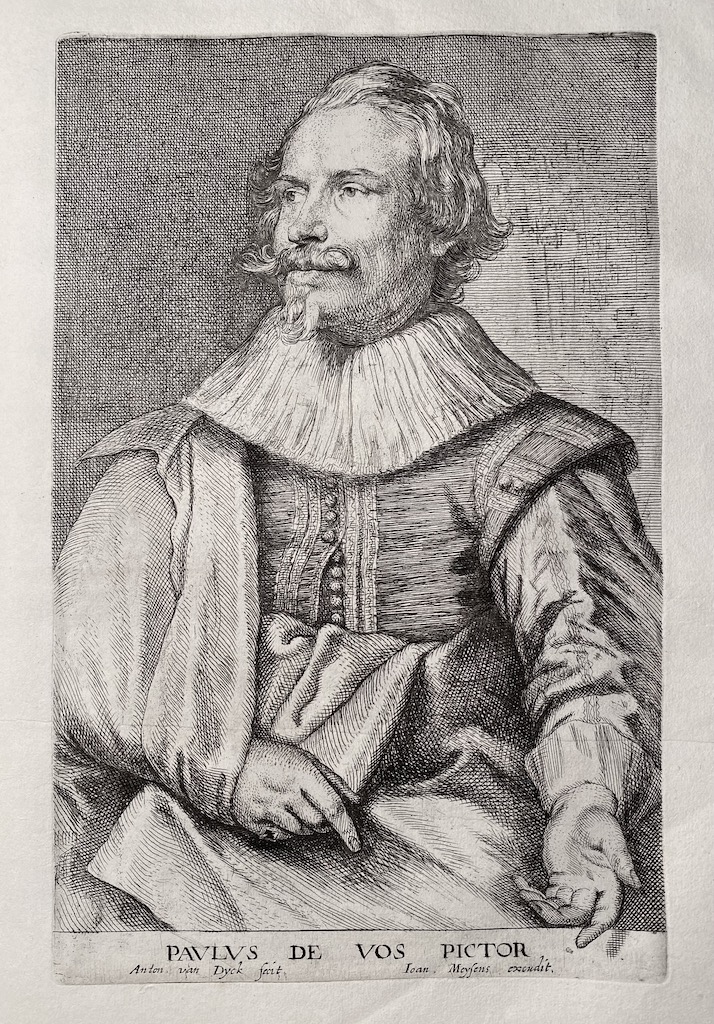
53. Paul de Vos (Flemish, 1596 – 1678); printed by Ioannes Meyssens, face and collar engraved by Anthony van Dyck, the body engraved by Ioannes Meyssens. Second, lettered state. Inscription: PAVLVS DE VOS PICTOR”. In lower margin: “Anton. van Dyck pinxit fecit.”, and “Ioan. Meysens excudit.”. British Museum # R,1b.95. [Look s very much alike №68, but with a one-line inscription and engraved by Meyssens instead of Bolswert]. 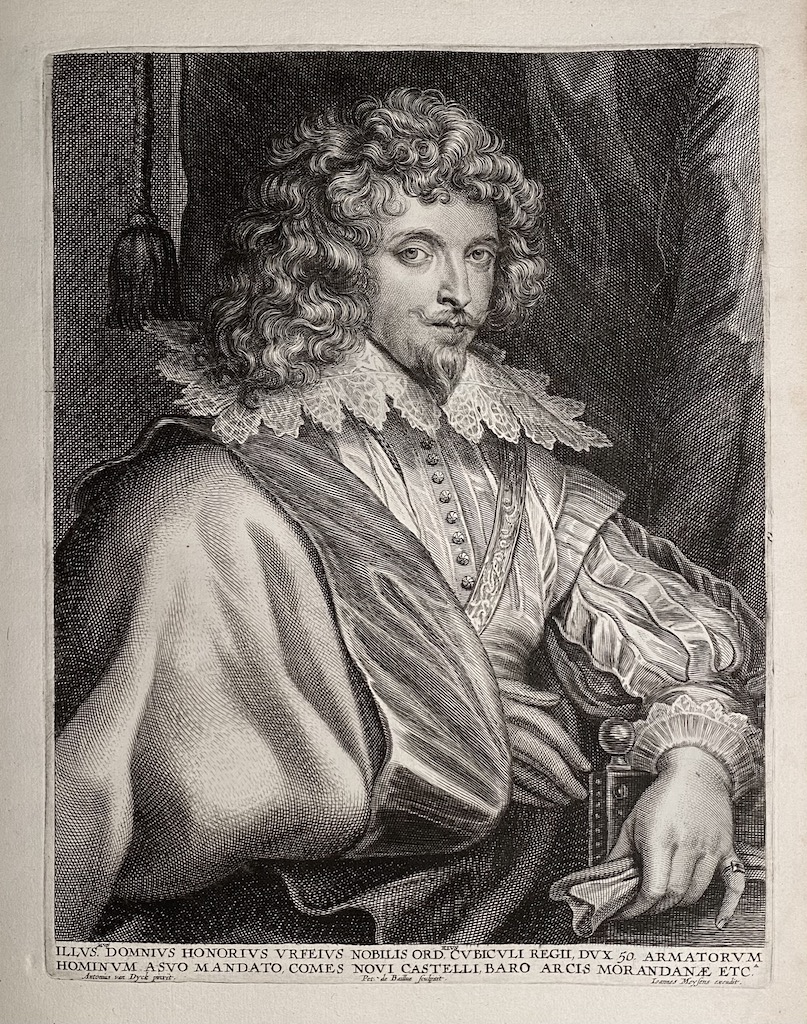
54. Honoré d’Urfé, marquis de Valromey, comte de Châteauneuf (French, 1568 – 1625); engraved by Pieter de Bailliu (Flemish, 1613 – 1660). Inscription: “ILLVS.MVS DOMNIVS HONORIVS VRFEIVS NOBILIS ORD.RIVS CVBICVLI REGII, DVX 50. ARMATORVM | HOMINVM A SVO MANDATO, COMES NOVI CASTELLI, BARO ARCIS MORANDANÆ ETC.A”. Below: “Antonius van Dyck pinxit” <–> “Pet. de Bailliue sculpsit.” <–> “Ioanes Meysens excudit.”. Second lettered state with title and production details. [Similar to №14, but with Ioanes Meysens name in place]. 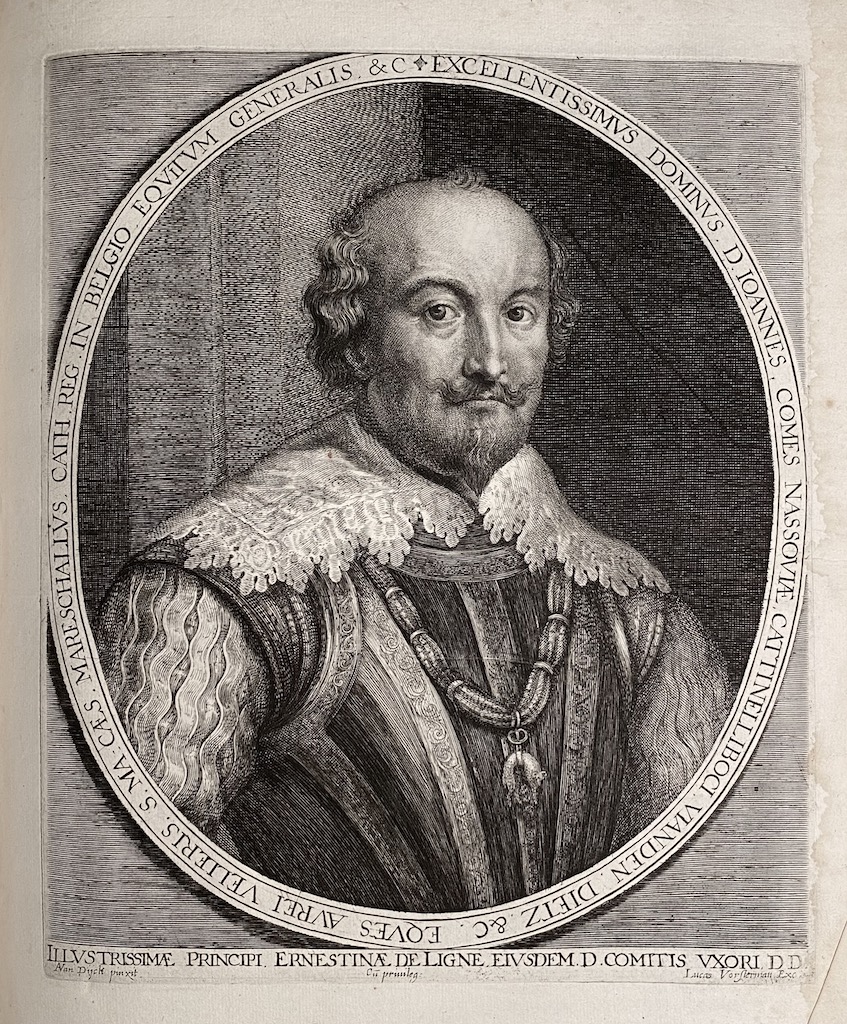
55. Johannes [John VIII], Count of Nassau-Siegen (German, 1583 – 1638); engraved by Lucas Vorsterman I (Flemish, 1595 – 1675). Inscription: in the oval around the portrait “EXCELLENTISSIMVS DOMINVS: D. IOANNES, COMES NASSAOVIÆ, CATTNELLIBOCI: VIANDEN, DIETZ, &C. EQVES AVREI VELLERIS. S. MA: CÆS, MARESCHALIVS, CATH. REG. IN BELGIO. EQVITVM GENERALIS. &C”, in lower margin: “ILLVSTRISSIMÆ PRINCIPI ERNESTINÆ DE LIGNE EIVSDEM D. COMITIS VXORI DD.”. Below: “AVan Dÿck pinxit.” <–> “Cū Priuleg” <–> “Lucas Vorsterman exc”. Third state. [For the fourth state with Lucas “Vorsterman exc” burnished see № 15]. 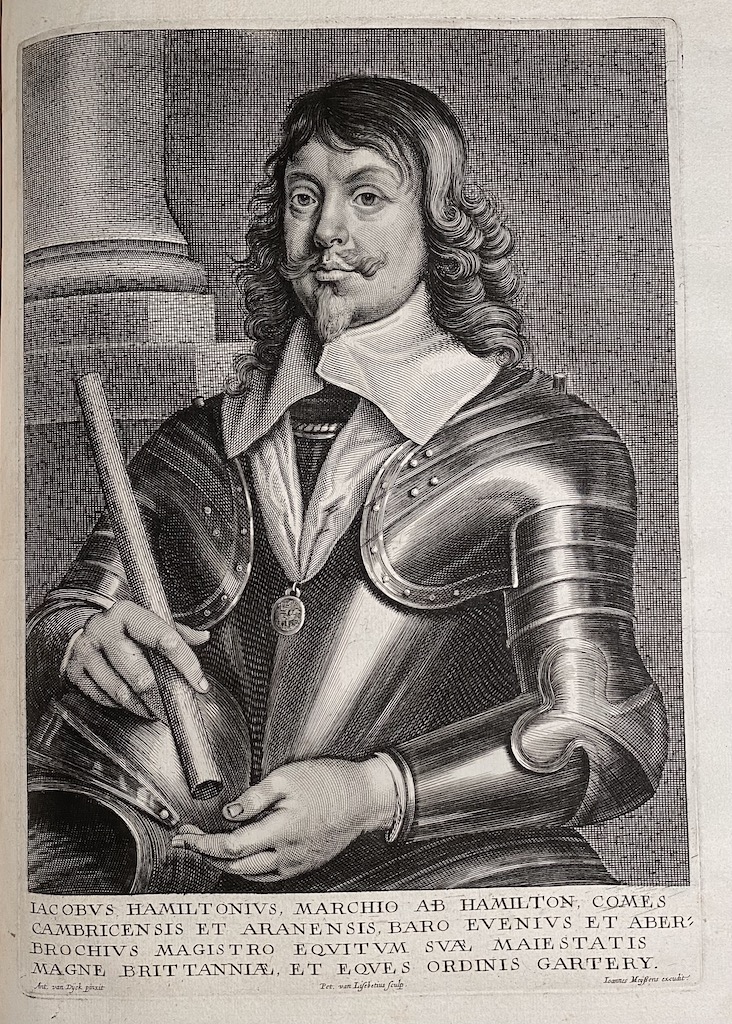
56. James Hamilton, 1st Duke of Hamilton (British, 1606 – 1649); engraved by Peeter van Lisebetten (Flemish,(1630 – 1678), published by Ioannes Meysens. Inscription: “IACOBVS HAMILTONIVS, MARCHIO AB HAMILTON, COMES | CAMBRICENSIS ET ARANENSIS, BARO EVENIVS ET ABER: | BROCHIVS MAGISTRO EQVITVM SVÆ MAIESTATIS | MAGNE BRITTANIÆ, ET EQUES ORDINIS GARTERY.”.In lower margin: “Ant. van Dÿck pinxit” <–> “Pet. van Lisebetius sculp.”<–> “Ioannes Meÿssens excudit.”. Second state with title and signatures. British Museum # P,2.208. 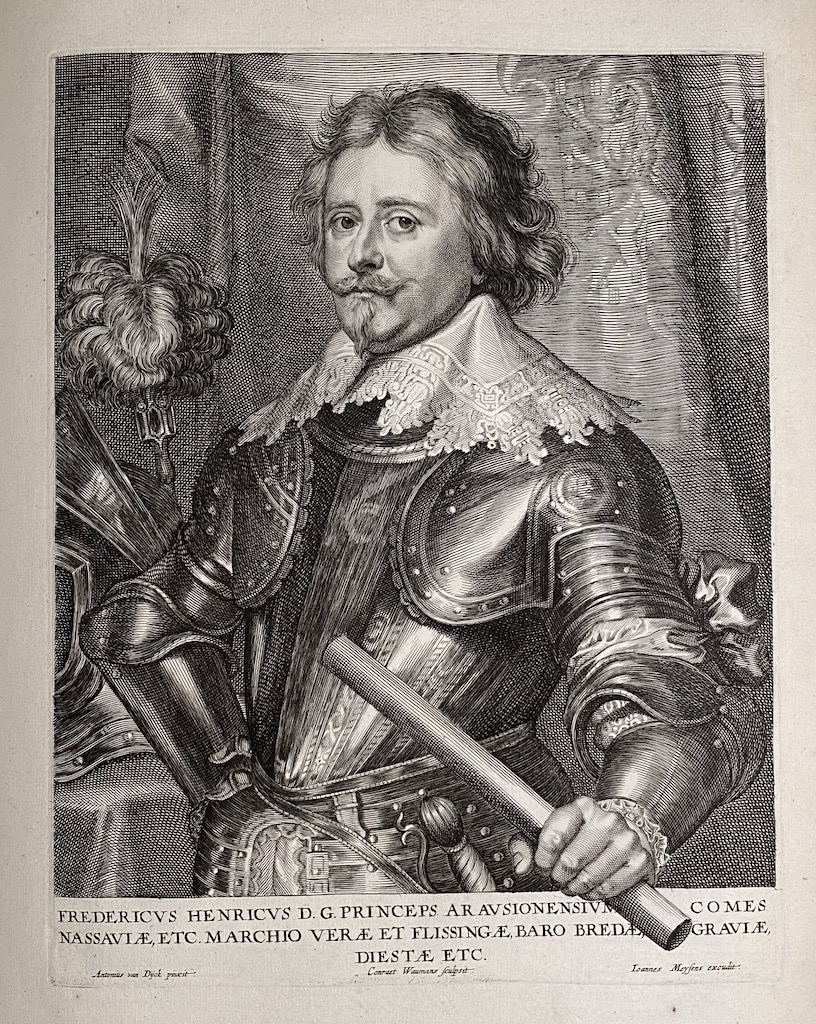
57. Frederick Henry, Prince of Orange, Count of Nassau (Dutch, 1584 – 1647); engraved by Conrad Waumans [Woumans] (Flemish, 1619 – after 1675). Inscription: “FREDERICVS HENRICVS, D.G. PRINCEPS ARAVSIONENSIVM, COMES | NASSAVIÆ, ETC. | MARCHIO VERÆ ET FLISSINGÆ, BARO BREDÆ GRAVÆ, | DIESTÆ ETC.”. Below: “Antonius van Dÿck pinxit” <–> “Conraet Waumans sculpsit” <–> “Ioannes Meyssens excudit.” First, lettered state with title and production details. [Similar to №5, but this one with Ioannes Meyssens name present]. 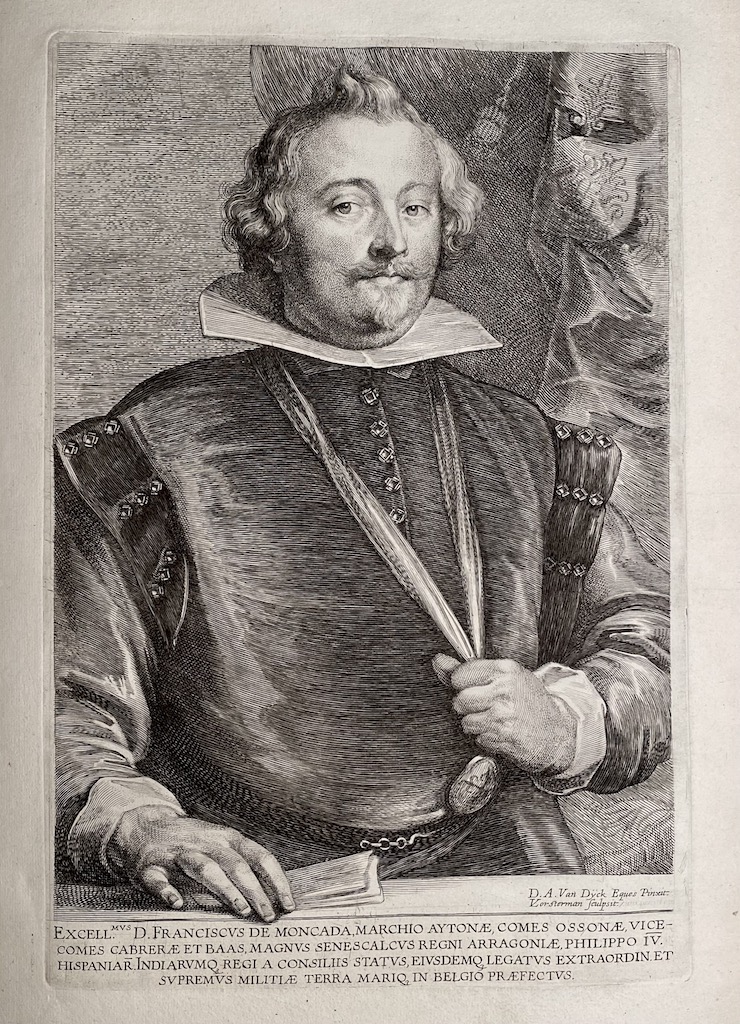
58. Francisco de Moncada, Count d’Osuna (Spanish, 1568 – 1635); engraved by Lucas Vorsterman I. Inscription: “EXCELL.MVS D. FRANCISCVS DE MONCADA MARCHIO AYTONÆ, COMES OSSONÆ VICE– | COMES CABRERÆ ET BAAS, MAGNVS SENESCALCVS REGNI ARRAGONIÆ, PHILIPPO IV. | HISPANIAR.INDIARVMQ3 REGI A CONSILIIS STATVS, EIVSDEMQ3 LEGATVS EXTRAORDIN,ET | SVPREMVS MILITIÆ TERRA MARIQ3 IN BELGIO PRÆFECTVS". Above within portrait frame, to the right: “D.A.van Dÿck pinxit. | LVorsterman sculpsit.”. 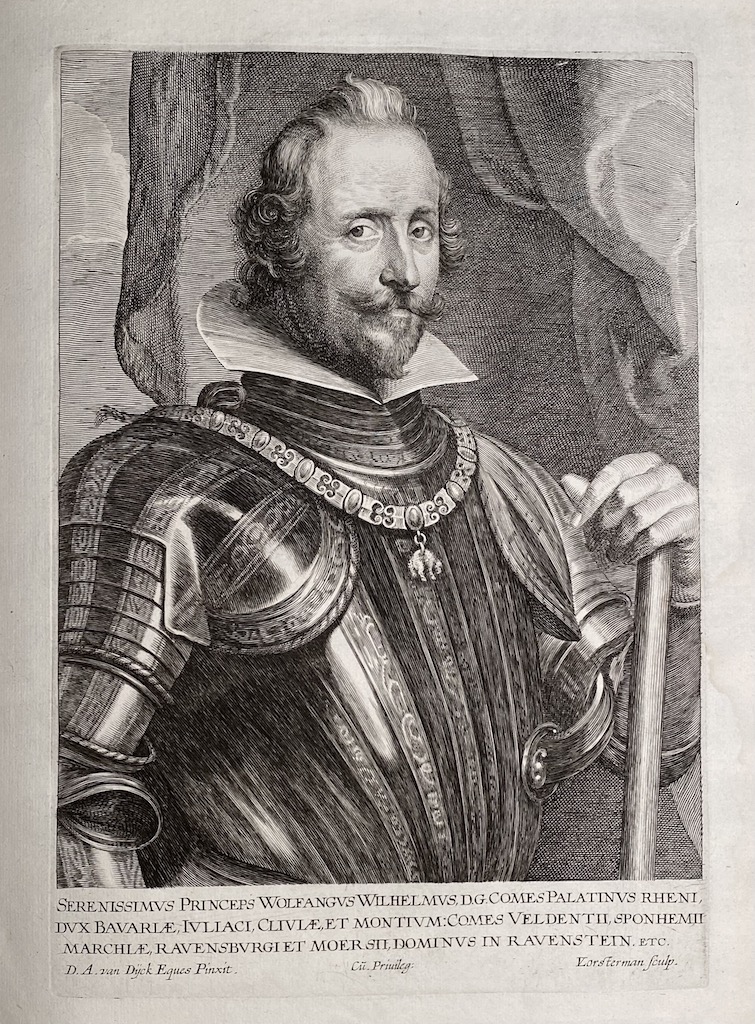
59. Wolfgang Wilhelm, Count of Pfalz-Neuburg and Duke of Jülich (German, 1578 – 1653); engraved by Lucas Vorsterman I. Inscription: "SERENISSIMVS PRINCEPS WOLFGANGVS WILHELMVS, D.G. COMES PALATINVS RHENI, | DVX BAVARIÆ, IVLIACÆ, ET MONTIVM :COMES VELDENTII, SPONHEMII | MARCHIÆ, RAVENSBVRGI ET MOERSII, DOMINVS IN RAVENSTEIN. ETC." In lower margin: "D. A. van Dÿck Eques Pinxit." <–> "Cū. Priuileg:" <–> "LVorsterman sculp.". Fifth state with initials of Gillis Hendricx burnished. British Museum # 1863,0509.825. 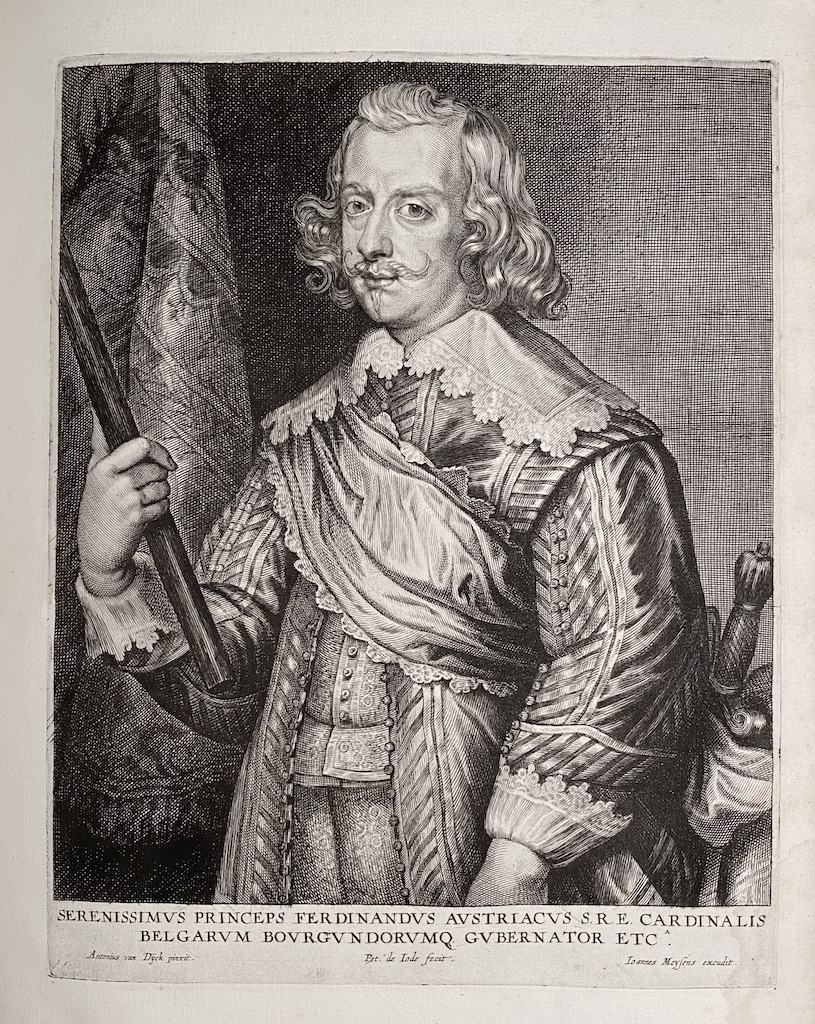
60. Ferdinand, Cardinal Infante of Spain and Archduke of Austria (Spanish, 1609 – 1641); engraved by Pieter de Jode II, published by Ioannes Meyssens. Inscription: “SERENISSIMVS PRINCEPS FERDINANDVS AVSTRIACVS S.R.E CARDINALIS | BELGARVM BORGVNDIORVMQ3 GVBERNATOR ETC.A”. In lower margin: “Antonius van Dÿck pinxit” <–> “Pet. de Iode fecit” <–> “Ioannes Meysens excudit”. Third, lettered state with title and production details. British Museum # R,1a.28. 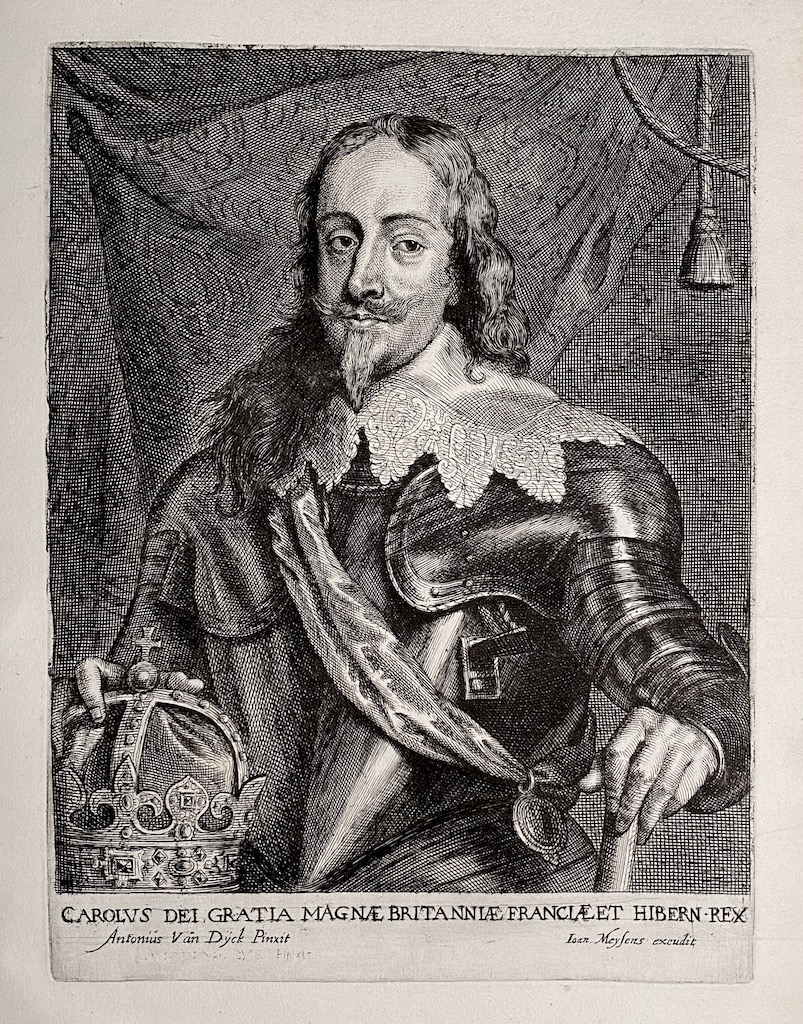
61. Charles I, King of England, Scotland, and Ireland (British, 1600 – 1649); engraved by Johannes [Jan] Meyssens (Flemish, 1612 – 1670). Inscription: “CAROLVS DEI GRATIA MAGNÆ BRITANNIÆ, FRANCIÆ ET HIBERNIÆ REX”. Below: “Antonius Van Dÿck eques pinxit” <–> “Ioan. Meysens excudit”. [Similar to №4, but with Ioannes Meysens name present]. 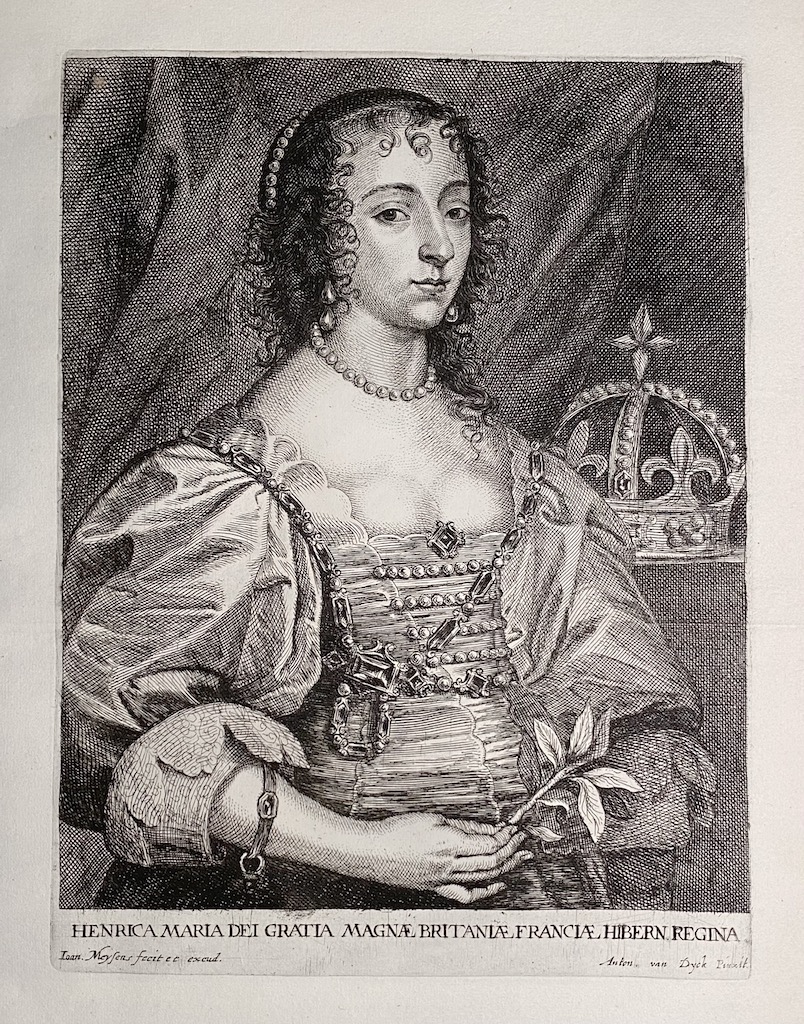
62. Henriette Marie de Bourbon, engraved and published by Ioannes Meyssens. Inscription: “HENRICA MARIA DEI GRATIA MAGNÆ BRITANIÆ FRANCIAÆ HIBERN. REGINA.” Lettered with production details in lower margin: “Ioan. Meysens fecit et excud.” <–> “Anton van Dyck Pinxit”. Third state, finished with a burin. [Similar to print №31, but this one with Ioan. Mey∫ens signature present]. 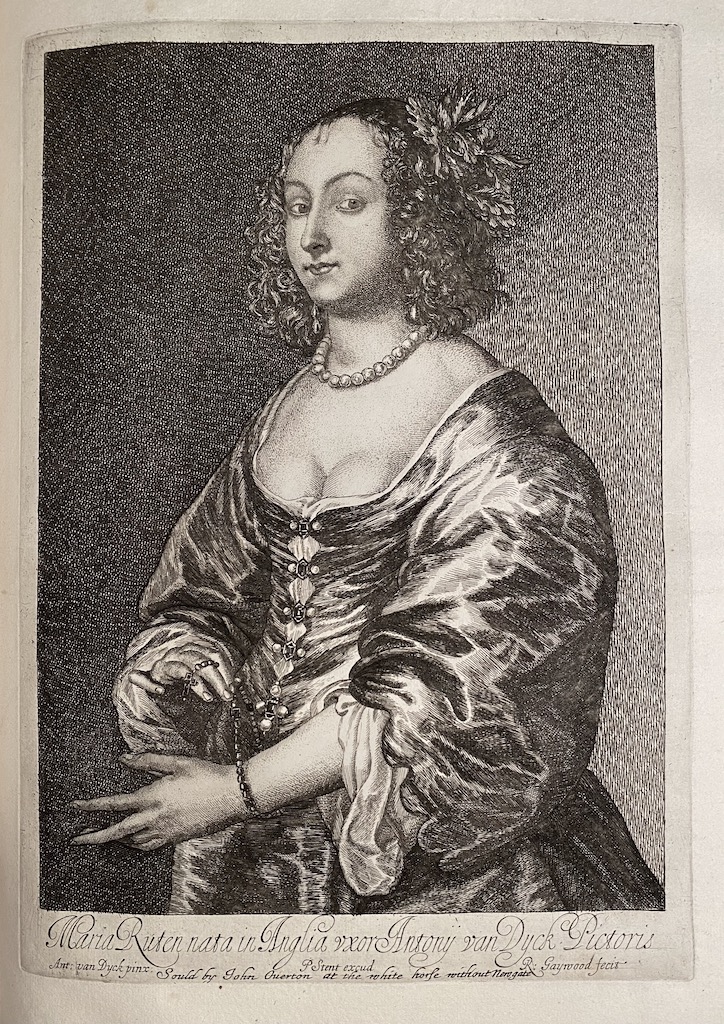
63. Mary Ruthven, Lady van Dyck (Scottish, c. 1622 – 1645); copy in reverse by Richard Gaywood after Bolswert (see also №51 by Meyssens) published by Peter Stent. Inscription: “Maria Ruten nata in Anglia vxor Antonÿ van Dyck Pictoris”. Below: “Ant: van Dyck pinx:”, “P Stent excud”, “R: Gaywood fecit”. Below centre: “Sould by John Ouerton at the white horse without New gate”. John Overton, publisher (British, 1639/40 – 1713); Richard Gaywood (British, fl. c. 1644 – 1677). Peter Stent (British, fl. c. 1637 – 1665). See BM # P,3.351. 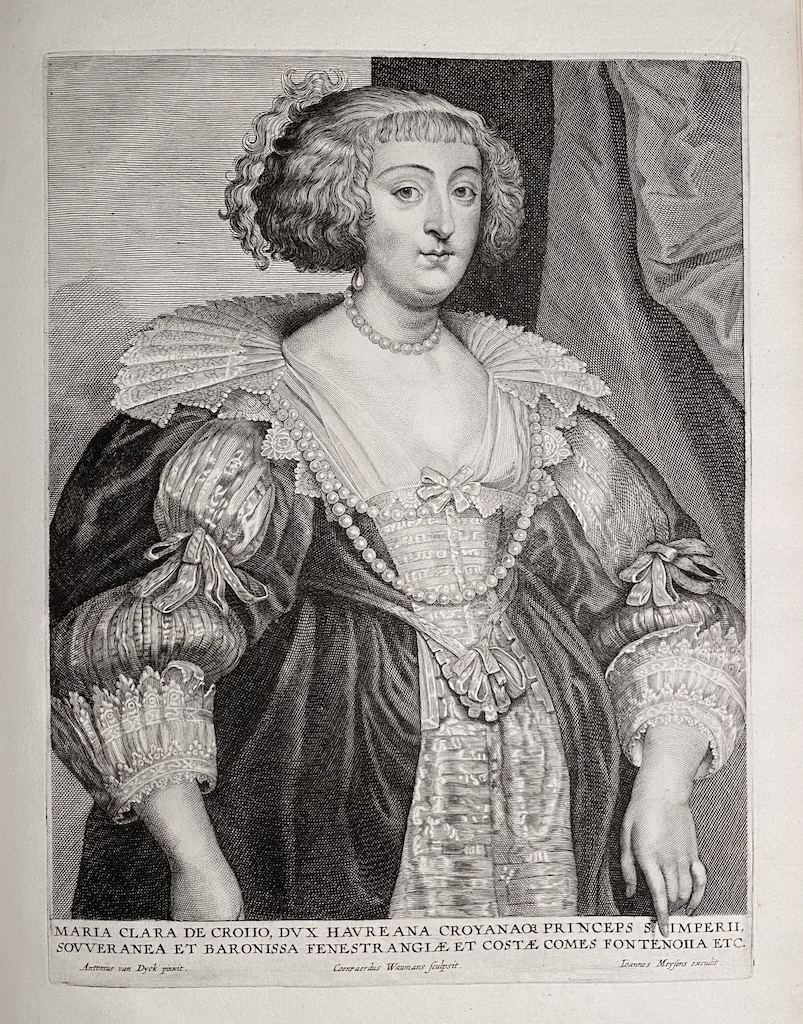
64. Marie-Claire de Croy, Duchess of Havré (Flemish, 1605 – 1664); engraved by Conraad Waumans, published by Ioannes Meyssens. Inscription: “MARIA CLARA DE CROIIO, DVX HAVREANA CROYANAQ3 PRINCEPS STE. IMPERII, | SOVVERANEA ET BARONISSA FENESTRANGIÆ ET COSTÆ COMES FONTENOIIA ETC”. In lower margin: “Antonius van Dyck pinxit.” <–> “Coenraerdus Waumans sculpsit.” <–> “Ioannes Meysens excudit.”. Second state. British Museum # R,1a.188. [Similar to №36, but this one with Ioannes Meysens name present]. 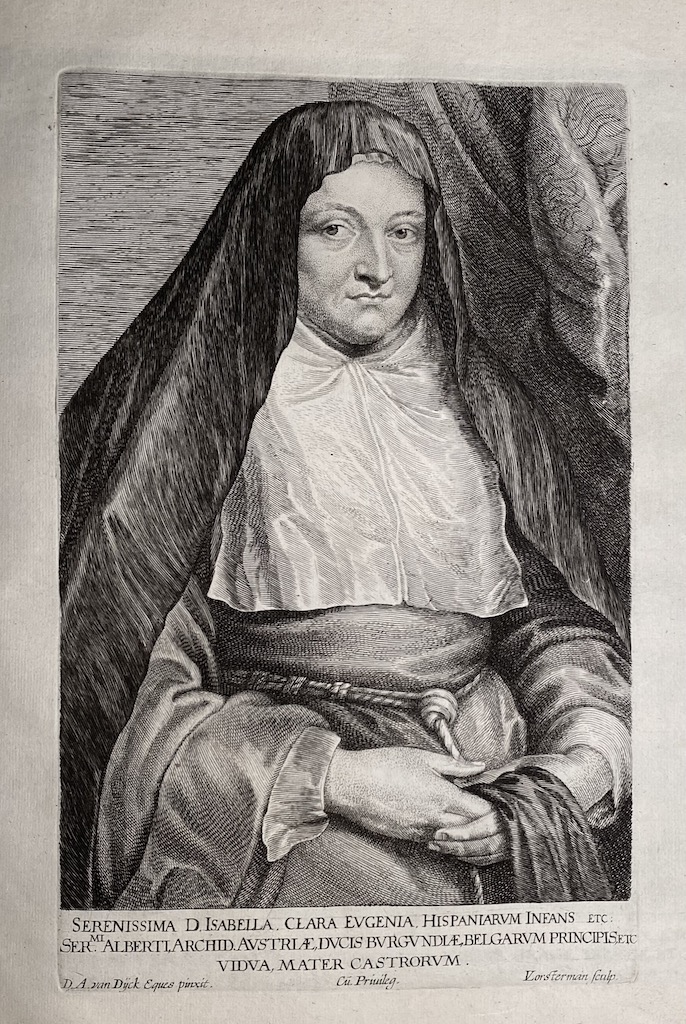
65. Isabel Clara Eugenia, ruler of the Spanish Netherlands (Spanish, 1566 – 1633); engraved by Lucas Vorsterman I. “SERENISSIMA D. ISABELLA. CLARA. EVGENIA. HISPANIARVM INFANS ETC. | SER.MI ALBERTI. ARCHID. AVSTRIÆ, DVCIS BVRGVNDIÆ, BELGARVM PRINCIPIS, ETC. | VIDVA, MATER CASTRORVM.” In lower margin: “D. A.van Dÿck Eques pinxit.” <–> “Cū Priuileg.” <–> “LVorsterman sculp.”. Fourth state with initials of Gillis Hendricx burnished. British Museum # 1863,0509.820. 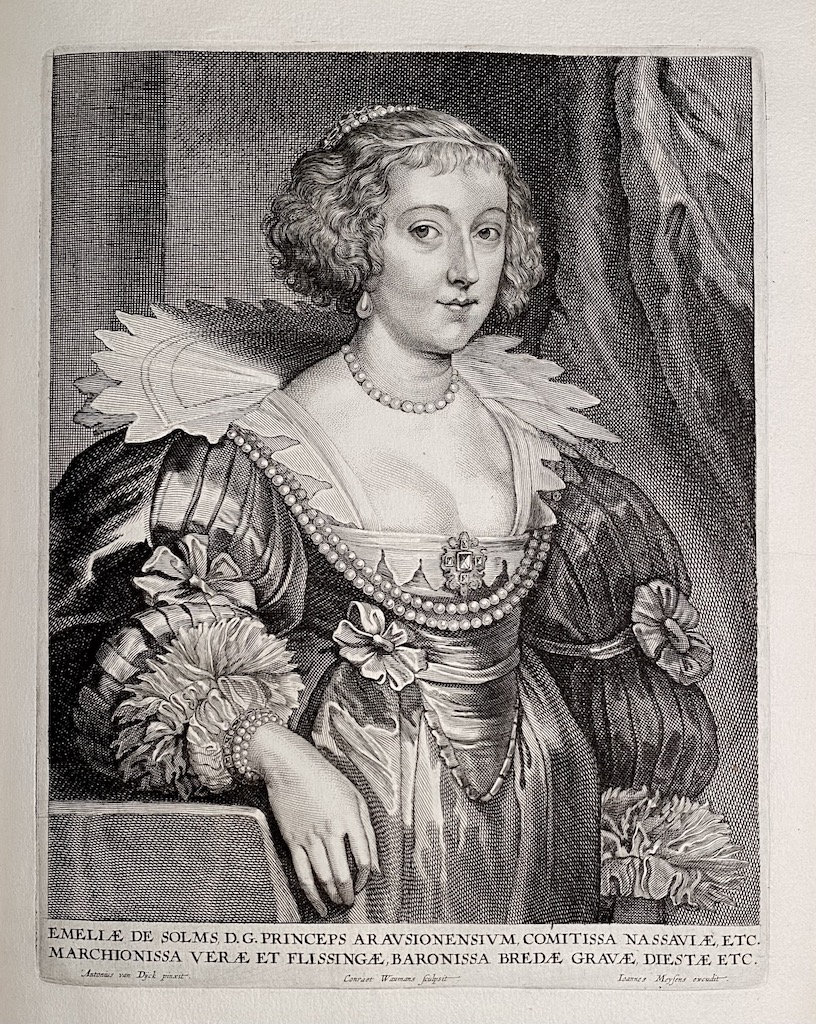
66. Amalia van Solms, Princess of Orange (German, 1602 – 1675), engraved by Conraad Waumans and published by Johannes Meyssens. Inscription: “EMELIÆ DE SOLMS, D. G. PRINCPES ARAVSIONENSIVM, COMITISSA NASSAUVIÆ, ETC. | MARCHIONISSA VERÆ ET FLISSINGÆ, BARONISSA BREDÆ, GRAVÆ, DIESTÆ ETC.” In lower margin: “Antonius van Dijck pinxit.”, “Conraet Waumans sculpsit.” and “Ioannes Meysens excudit.”. First, lettered state with the title and production details lettered. [Similar to №32, but this one with Ioannes Meysens name present]. 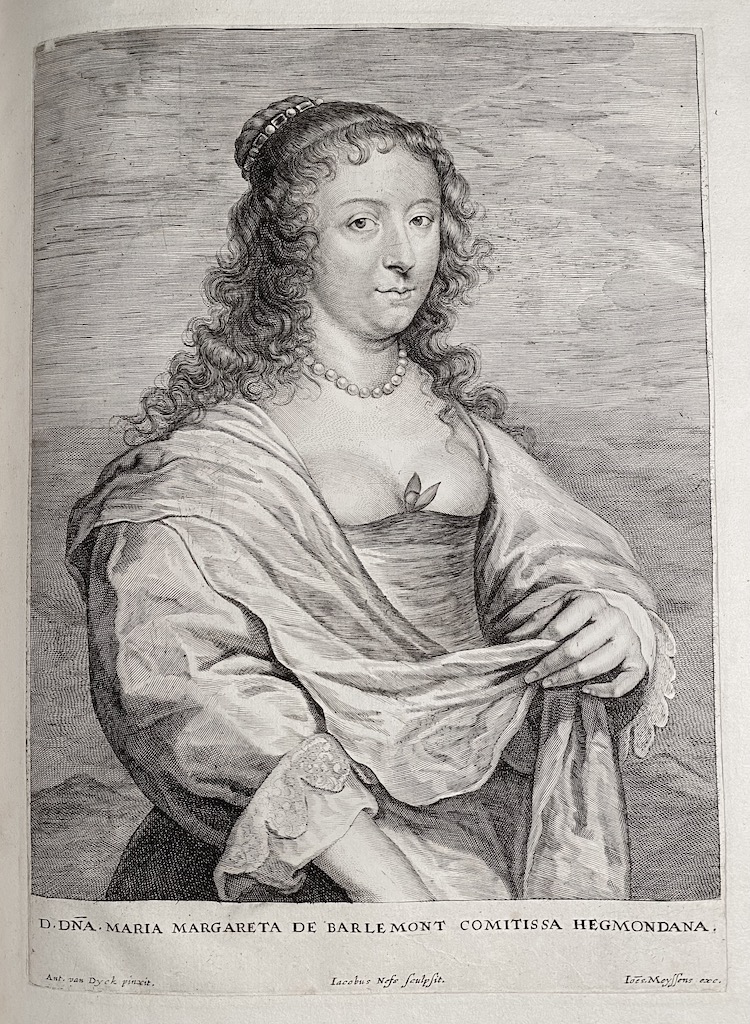
67. Marie-Marguerite de Berlaymont ( ? – 1654); engraved by Jacobus Neeffs, published by Ioannes Meyssens. Inscription: “D.DNA. MARIA MARGARETA DE BARLEMONT COMITISSA HEGMONDANA.” In lower margin: “Ant. van Dyck pinxit.” <–> “Iacobus Nefs sculpsit.” <–> “Ioes Meyssens exc.”. Fourth state. [Similar to №45, but this one with Ioannes Meysens name present]. 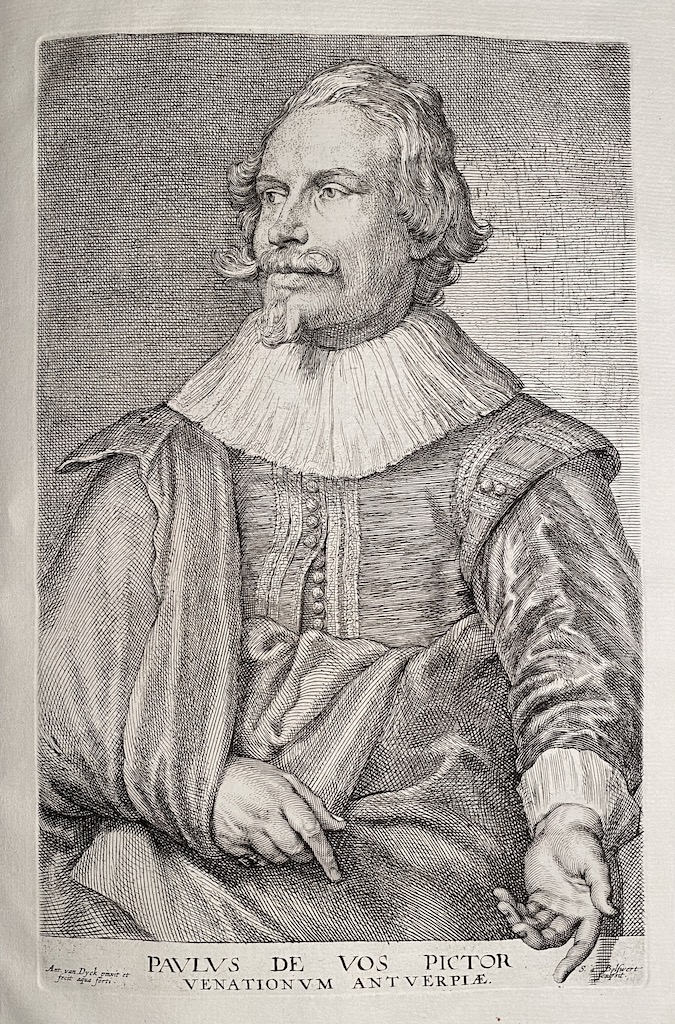
68. Paul de Vos (Flemich, 1596-1678); engraved and etched by Anthony van Dyck and by Schelte Adamsz. Bolswert, published by Gillis Hendricx. Eighth state with the initials of Gillis Hendricx burnished. Inscription: PAVLVS DE VOS PICTOR | VENATIONVM ANTVERPIÆ.”. “Ant. van Dyck pinxit et | fecit aqua forti.” <–> “S. à Bol∫wert | sculpsit. ”. [Look s very much alike №53, but with a two-line inscription and engraved by Bolswert instead of Meyssens, etc.]. 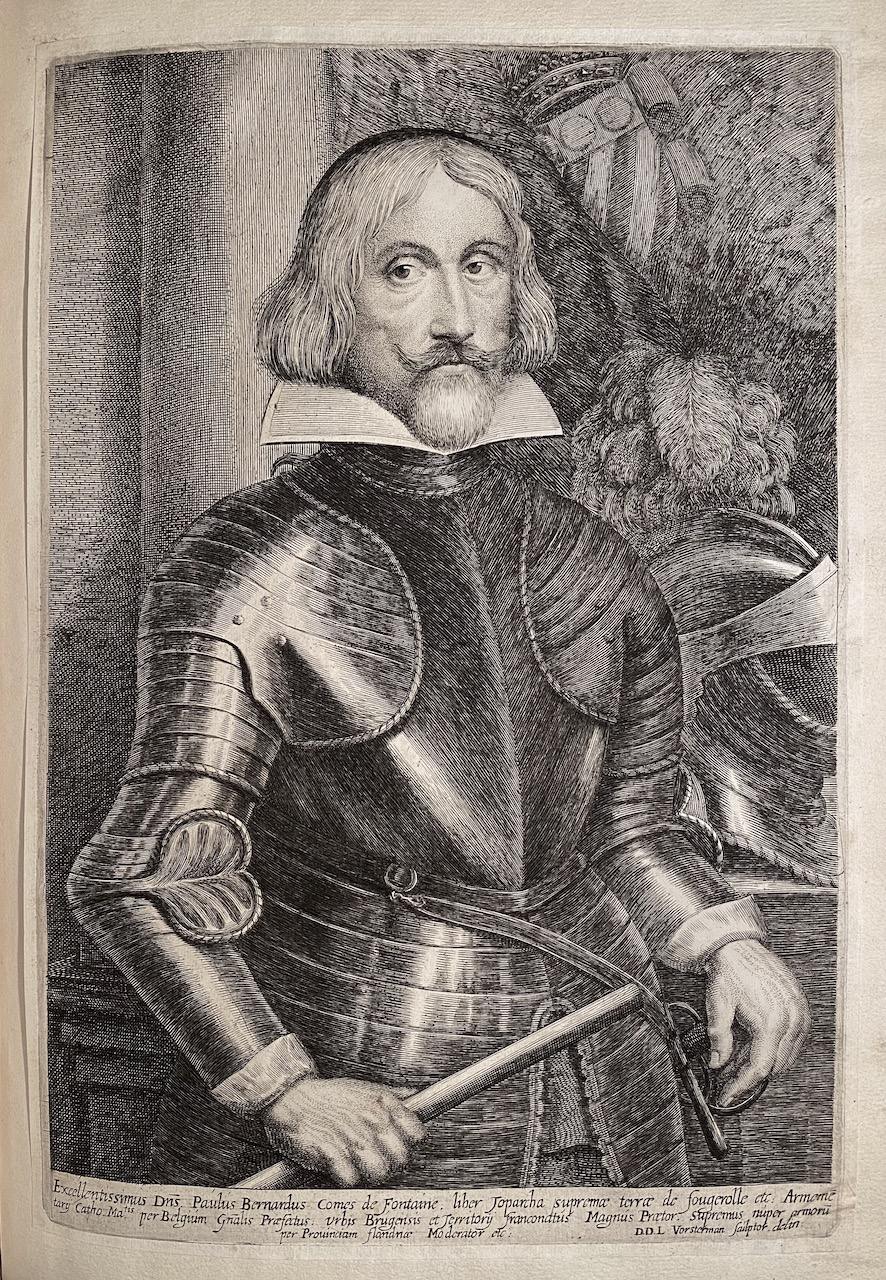
69. Paul-Bernard de Fontaines (French, 1566 – 1643) delineated and engraved by Lucas Vorsterman I (Flemish, 1595 – 1675) in 1615–75. Inscription: “Excellentissimus Dns. Paulus Bernardus Comes de Fontaine. liber Toparcha supremae terrae de fougerolle etc: Armeme tarij Catho. Matis. per Belgium Gnalis Praefectus: Vrbis Brugensis et Territorij fraconatus Magnus Praetor. Supremus nuper armpru Prouinciam flandriae Moderator etc: D.D.L Vorsterman sculptor. delin”. Cut without margins and pasted to inbound leaf. See: MET: Accession Number: 51.501.1332 -
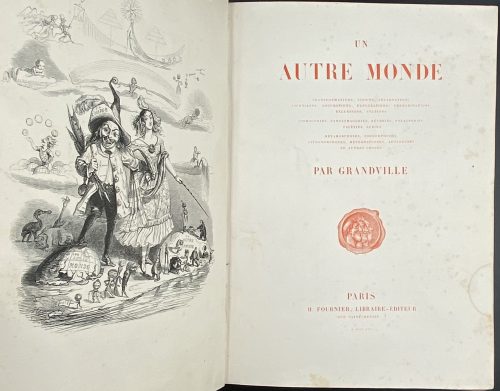 Description: One volume, collated 4t0, 27.3 x 20 cm, bound in contemporary quarter black chagrin, gilt ornaments and lettering to spine (reliure à l'époque romantique), marbled end-papers; printed on wove paper (vélin fort). Title-page (red): UN | AUTRE MONDE | TRANSFORMATIONS, VISIONS, INCARNATIONS | ASCENSIONS, LOCOMOTIONS, EXPLORATIONS, PÉRÉGRINATIONS | EXCURSIONS, STATIONS || COSMOGONIES, FANTASMAGORIES, RÈVERIES, FOLATRERIES | FACÉCIES, LUBIES || MÉTAMORPHOSES, ZOOMORPHOSES | LITHOMORPHOSES, MÉTEMPSYCHOSES, APOTHÉOSES | ET AUTRES CHOSES | PAR GRANDVILLE | [device] | PARIS | H. FOURNIER, LIBRAIRE-ÉDITEUR | RUE SAINT-BENOIT, 7 | M DCCC XLIV Pagination: ff, [2] half-title in red / imprim., [2] blank / frontis. in black, [2] title page in red / blank, [1] 2-295, [1] explication and erratum, bf, illustrations. Collation: 4to, (1)-(37)4 with frontispiece, 133 woodcut vignettes, 15 full-page black woodcuts, and 36 hand-coloured plates. Catalogue raisonné: Carteret (p. 285) describes the book as 'in-8', but the collation is actually in quarto (in-4, or 4to) with series signed in Arabic numerals. Ray (French): p. 275-7. The publication is anonymous, however, Grandville reveals the author's name (that's Taxile Delord) on the vignette on p. 292 at the bottom of the plate (under ICI).
Description: One volume, collated 4t0, 27.3 x 20 cm, bound in contemporary quarter black chagrin, gilt ornaments and lettering to spine (reliure à l'époque romantique), marbled end-papers; printed on wove paper (vélin fort). Title-page (red): UN | AUTRE MONDE | TRANSFORMATIONS, VISIONS, INCARNATIONS | ASCENSIONS, LOCOMOTIONS, EXPLORATIONS, PÉRÉGRINATIONS | EXCURSIONS, STATIONS || COSMOGONIES, FANTASMAGORIES, RÈVERIES, FOLATRERIES | FACÉCIES, LUBIES || MÉTAMORPHOSES, ZOOMORPHOSES | LITHOMORPHOSES, MÉTEMPSYCHOSES, APOTHÉOSES | ET AUTRES CHOSES | PAR GRANDVILLE | [device] | PARIS | H. FOURNIER, LIBRAIRE-ÉDITEUR | RUE SAINT-BENOIT, 7 | M DCCC XLIV Pagination: ff, [2] half-title in red / imprim., [2] blank / frontis. in black, [2] title page in red / blank, [1] 2-295, [1] explication and erratum, bf, illustrations. Collation: 4to, (1)-(37)4 with frontispiece, 133 woodcut vignettes, 15 full-page black woodcuts, and 36 hand-coloured plates. Catalogue raisonné: Carteret (p. 285) describes the book as 'in-8', but the collation is actually in quarto (in-4, or 4to) with series signed in Arabic numerals. Ray (French): p. 275-7. The publication is anonymous, however, Grandville reveals the author's name (that's Taxile Delord) on the vignette on p. 292 at the bottom of the plate (under ICI).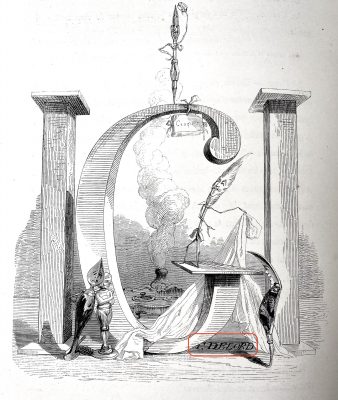
-
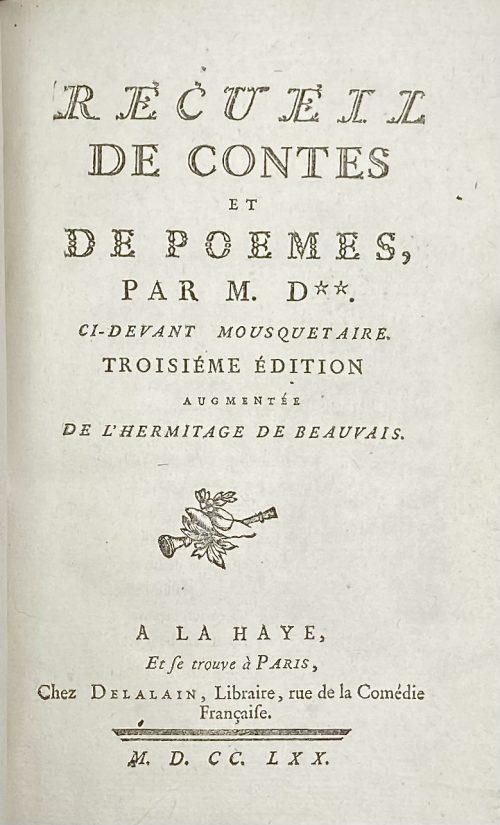 Title page: RECUEIL | DE CONTES | ET | DE POEMES, | PAR M. D**. | CI-DEVANT MOUSQUETAIRE. | TROSIÉME ÉDITION | AUGUMENTÉE | DE L'HERMITAGE DE BEAUVAIS. | [device] | A LA HAYE, | Et se trouve à Paris, | Chez Delalain, Libraire, rue de la Comédie | Française. | — | M. D. CC. LXX. IRZA | ET MARSIS , | POËME, includes: L'isle merveilleuse, Poëme, Chant 1re et Chant 2nd, Invocation a La Fontaine, and Alphonse, Conte – Cohen and De Ricci (#317) describe 2nd edition by the same publisher, 1769, 77 p., with similar illustrations after Charles Eisen: (1) engraved title by Louis Claude Legrand (2) L’Isle 1er: Frontispiece by Joseph de Longueil, (3) headpiece and (4) tailpiece by Emmanuel de Ghendt, and (5) L’Isle 2nd: Frontispiece by Jean Massard, (6) headpiece by Emmanuel de Ghendt + (7) tailpiece unsigned. Les Cerises et la Méprise, Contes en vers – Cohen and De Ricci (#311) also describe the 2nd edition of 1769, with the same (8) frontispiece by De Longueil after Eisen. Sélim et Sélima, Poeme imité de l'allemand; L'hermitage de beauvais, Conte –Cohen and De Ricci (#322) describe edition of 1769 by Sébastien Jorry, with the same (9) frontispiece by Emmanuel de Ghendt after Eisen. Size: 18.6 x 12.3 cm, small 8vo. Binding: polished, multi-coloured stained calf with gilt triple fillet border to boards; gilt floral arabesque and gilt lettering to flat spine: "Oeuvres de Dorat | Contes"; all edges gilt; blue-and-white marbled endpapers. Pagination: ffl, [2] IRZA ET MARSIS engraved half-title / blank, [1-2] - RECUEIL title page / blank, 3-8 (avis sur cette édition); [1 - L'Isle...] 2-184, bfl; Illustrations (copperplate engravings): 5 plates, 2 headpieces and 2 tailpieces. Collation: Octavo; a8 (title and avis sur cette édition); A-L8, M4. Author of the text: Claude Joseph Dorat, (French, 1734 – 1780) Artist: Charles-Dominique-JosephEisen (French, 1720 – 1778) Engravers: Emmanuel Jean Nepomucène de Ghendt (French, 1738 – 1815) Louis Claude Legrand (French, 1723 – 1807) Joseph de Longueil (French, 1730 – 1792) Jean Massard (French, 1740 – 1822)
Title page: RECUEIL | DE CONTES | ET | DE POEMES, | PAR M. D**. | CI-DEVANT MOUSQUETAIRE. | TROSIÉME ÉDITION | AUGUMENTÉE | DE L'HERMITAGE DE BEAUVAIS. | [device] | A LA HAYE, | Et se trouve à Paris, | Chez Delalain, Libraire, rue de la Comédie | Française. | — | M. D. CC. LXX. IRZA | ET MARSIS , | POËME, includes: L'isle merveilleuse, Poëme, Chant 1re et Chant 2nd, Invocation a La Fontaine, and Alphonse, Conte – Cohen and De Ricci (#317) describe 2nd edition by the same publisher, 1769, 77 p., with similar illustrations after Charles Eisen: (1) engraved title by Louis Claude Legrand (2) L’Isle 1er: Frontispiece by Joseph de Longueil, (3) headpiece and (4) tailpiece by Emmanuel de Ghendt, and (5) L’Isle 2nd: Frontispiece by Jean Massard, (6) headpiece by Emmanuel de Ghendt + (7) tailpiece unsigned. Les Cerises et la Méprise, Contes en vers – Cohen and De Ricci (#311) also describe the 2nd edition of 1769, with the same (8) frontispiece by De Longueil after Eisen. Sélim et Sélima, Poeme imité de l'allemand; L'hermitage de beauvais, Conte –Cohen and De Ricci (#322) describe edition of 1769 by Sébastien Jorry, with the same (9) frontispiece by Emmanuel de Ghendt after Eisen. Size: 18.6 x 12.3 cm, small 8vo. Binding: polished, multi-coloured stained calf with gilt triple fillet border to boards; gilt floral arabesque and gilt lettering to flat spine: "Oeuvres de Dorat | Contes"; all edges gilt; blue-and-white marbled endpapers. Pagination: ffl, [2] IRZA ET MARSIS engraved half-title / blank, [1-2] - RECUEIL title page / blank, 3-8 (avis sur cette édition); [1 - L'Isle...] 2-184, bfl; Illustrations (copperplate engravings): 5 plates, 2 headpieces and 2 tailpieces. Collation: Octavo; a8 (title and avis sur cette édition); A-L8, M4. Author of the text: Claude Joseph Dorat, (French, 1734 – 1780) Artist: Charles-Dominique-JosephEisen (French, 1720 – 1778) Engravers: Emmanuel Jean Nepomucène de Ghendt (French, 1738 – 1815) Louis Claude Legrand (French, 1723 – 1807) Joseph de Longueil (French, 1730 – 1792) Jean Massard (French, 1740 – 1822) -
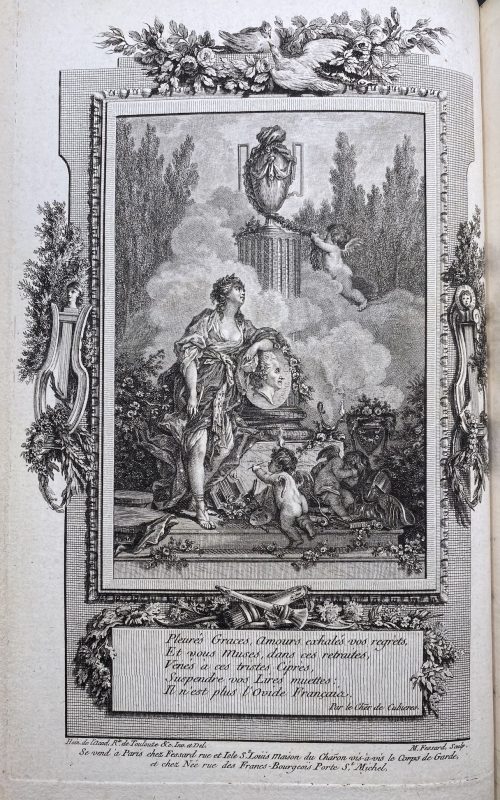 Title page: LES | BAISERS , | PRÉCÉDES | DU MOIS DE MAI, | POËME. | [vignette] | A LA HAYE , | Et se trouve à Paris | Chez Lambert , Imprimeur, rue de la Harpe. | Et Delalain , rue de la Comédie Françoise. | M. DCC. LXX Size: 8vo; 24.5 x 15.5 cm; Binding by Hippolyte Duru – stamp at the back of the front end paper DURU, 1855; full red calf, boards decorated in gilt, raised bands and gilt decorations in compartments, gilt lettering, AEG, peacock marbled end papers, text and illustrations printed on Holland paper. Collation: 2 ffls, engraved half-title by N. Ponce after Ch. Eisen, frontispiece by Etienne Fessard after Claude-Jean-Baptiste Hoin (French, 1750 – 1817) w/guard tissue, t.p. by J. Aliamet after Ch. Eisen, Réflexions préliminaires: A8, B4; 'Le Mois de Mai' half-title, imprim. note on verso, frontispice by De Longueil after Ch. Eisen w/guard tissue, A4 C-F(8) H4; 2bfls. Frontispiece by Etienne Fessard is unique in this edition. Pagination: [2] 3-24, [27]/28, 5/6, 31/32 31/34 11/12 37-119 [120], 22 head-pieces after Ch. Eisen and 22 end-pieces after Marillier, engraved by Baquoy, Binet, Delaunay, Lingée, De Longueil, Masquelier, Massard, and Née. Mistakes in pagination likely confirms first printing first edition. Catalogue raisonné: Cohen, De Ricci (1912): 308-311). Artists: Charles Eisen (French, 1720–1778); Clément Pierre Marillier (French, 1740–1808), and Claude-Jean-Baptiste Hoin (French, 1750–1817). Engravers: Jacques Aliamet (French, 1726–1788); Jean Charles Baquoy (French, 1721–1777); Louis Binet (French, 1744–about 1800); Nicolas Delaunay (French, 1739–1792); Etienne Fessard (French, 1714–1777); Charles Louis Lingée (French, 1748–1819); Joseph de Longueil (French, 1730–1792); Louis Joseph Masquelier (French, 1741–1811); Jean Massard (1740–1822); François Denis Née (French, 1735–1818); Nicholas Ponce (French, 1746–1831).
Title page: LES | BAISERS , | PRÉCÉDES | DU MOIS DE MAI, | POËME. | [vignette] | A LA HAYE , | Et se trouve à Paris | Chez Lambert , Imprimeur, rue de la Harpe. | Et Delalain , rue de la Comédie Françoise. | M. DCC. LXX Size: 8vo; 24.5 x 15.5 cm; Binding by Hippolyte Duru – stamp at the back of the front end paper DURU, 1855; full red calf, boards decorated in gilt, raised bands and gilt decorations in compartments, gilt lettering, AEG, peacock marbled end papers, text and illustrations printed on Holland paper. Collation: 2 ffls, engraved half-title by N. Ponce after Ch. Eisen, frontispiece by Etienne Fessard after Claude-Jean-Baptiste Hoin (French, 1750 – 1817) w/guard tissue, t.p. by J. Aliamet after Ch. Eisen, Réflexions préliminaires: A8, B4; 'Le Mois de Mai' half-title, imprim. note on verso, frontispice by De Longueil after Ch. Eisen w/guard tissue, A4 C-F(8) H4; 2bfls. Frontispiece by Etienne Fessard is unique in this edition. Pagination: [2] 3-24, [27]/28, 5/6, 31/32 31/34 11/12 37-119 [120], 22 head-pieces after Ch. Eisen and 22 end-pieces after Marillier, engraved by Baquoy, Binet, Delaunay, Lingée, De Longueil, Masquelier, Massard, and Née. Mistakes in pagination likely confirms first printing first edition. Catalogue raisonné: Cohen, De Ricci (1912): 308-311). Artists: Charles Eisen (French, 1720–1778); Clément Pierre Marillier (French, 1740–1808), and Claude-Jean-Baptiste Hoin (French, 1750–1817). Engravers: Jacques Aliamet (French, 1726–1788); Jean Charles Baquoy (French, 1721–1777); Louis Binet (French, 1744–about 1800); Nicolas Delaunay (French, 1739–1792); Etienne Fessard (French, 1714–1777); Charles Louis Lingée (French, 1748–1819); Joseph de Longueil (French, 1730–1792); Louis Joseph Masquelier (French, 1741–1811); Jean Massard (1740–1822); François Denis Née (French, 1735–1818); Nicholas Ponce (French, 1746–1831). -
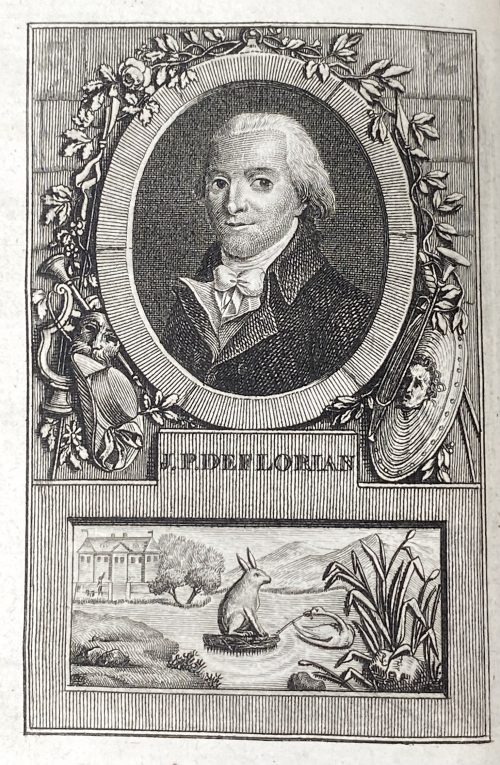 Title: FABLES | DE | M. DE FLORIAN , | de l’académie françoise, de celles de Madrid , | Florence, etc. | — | Je tâche d'y tourner le vice ridicule , | Ne pouvant l'attaquer avec des bras d'Hercule. | La Font. Fables , liv. V , I. — | [publisher's device ] | A PARIS, | DE L'IMPRIMERIE DE P. DIDOT L'AINÉ, | 1792. Pagination: ffl, [2 - h.t. / Imp.] [2 - blank / frontis.] [2 - tp. / blank] [5] 6-224 [2 - advert. / blank], bfl. Collation: numbered 1(5), 2-18(6), 19(3); engarved frontispiece portrait of Florian after François Hüet-Villiers, 5 engraved plates by Longueil, Delignon, and Gaucher after Flouest. Binding: Contemporary full mottled calf, all margins red, gilt floral ornaments to flat spine, red label with gilt lettering. Catalogue raisonné: Cohen, de Ricci 1912: p. 398-9.
Title: FABLES | DE | M. DE FLORIAN , | de l’académie françoise, de celles de Madrid , | Florence, etc. | — | Je tâche d'y tourner le vice ridicule , | Ne pouvant l'attaquer avec des bras d'Hercule. | La Font. Fables , liv. V , I. — | [publisher's device ] | A PARIS, | DE L'IMPRIMERIE DE P. DIDOT L'AINÉ, | 1792. Pagination: ffl, [2 - h.t. / Imp.] [2 - blank / frontis.] [2 - tp. / blank] [5] 6-224 [2 - advert. / blank], bfl. Collation: numbered 1(5), 2-18(6), 19(3); engarved frontispiece portrait of Florian after François Hüet-Villiers, 5 engraved plates by Longueil, Delignon, and Gaucher after Flouest. Binding: Contemporary full mottled calf, all margins red, gilt floral ornaments to flat spine, red label with gilt lettering. Catalogue raisonné: Cohen, de Ricci 1912: p. 398-9. -
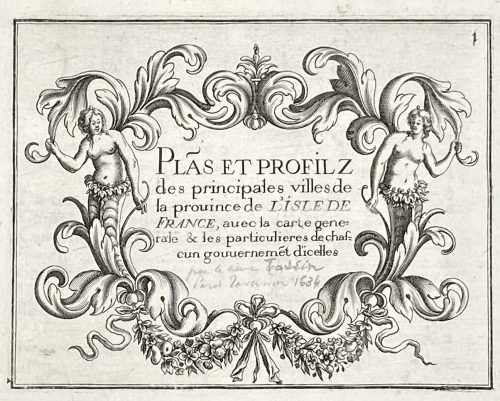 Title page: Text engraved within a vignette with two naked female torses in garlands: Plãs et profilz | des principales villes de | la prouince de L'ISLE DE | FRANCE, auec la carte gene~ | rale & les particulieres de chaf~ | cun gouuernement d'icelles. Below handwritten pencil inscription by a previous owner: "par ... Tassin ... 1634". Size: 17.6 x 23.7 cm, Binding: Italian style, green half-vellum, burgundy morocco title label with vertical gilt lettering to spine, peacock marbled boards. Pagination: Two blank flyleaves in the front and two in the back; 18 numbered engraved plates, including:
Title page: Text engraved within a vignette with two naked female torses in garlands: Plãs et profilz | des principales villes de | la prouince de L'ISLE DE | FRANCE, auec la carte gene~ | rale & les particulieres de chaf~ | cun gouuernement d'icelles. Below handwritten pencil inscription by a previous owner: "par ... Tassin ... 1634". Size: 17.6 x 23.7 cm, Binding: Italian style, green half-vellum, burgundy morocco title label with vertical gilt lettering to spine, peacock marbled boards. Pagination: Two blank flyleaves in the front and two in the back; 18 numbered engraved plates, including:- Title page
- Table of Contents
- Normandie
- Environs de Paris
- Folding map of Paris – a simplified copy of Mathieu Merian's 1615 perspective plan, with minor updates, notably on the current housing estate of Ile Saint-Louis.
- Paris
- Gouvernment de Soissons
- Soissons
- Gouvernment de Beauvais
- Beauvais
- Gouvernment de Compiègne
- Compiègne
- Gouvernment de Noyon
- Noyon
- Gouvernment de Coussi
- Coussi
- Gouvernment de Senlis
- Senlis
-
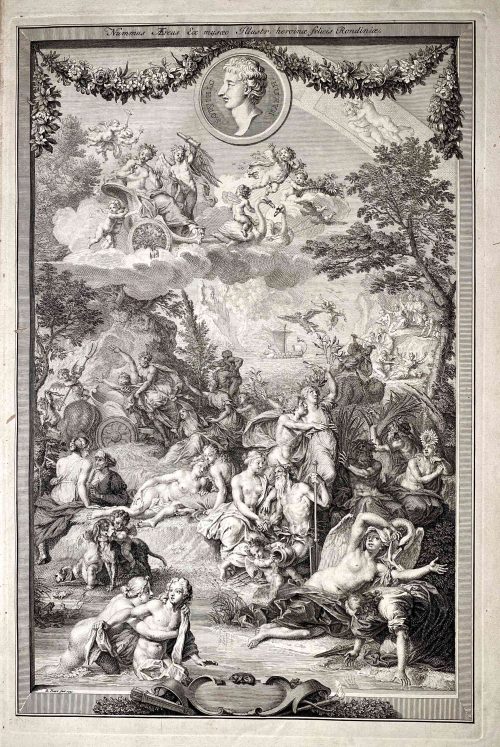 Vol. 1 title: OVID'S | METAMORPHOSES | IN LATIN AND ENGLISH, | TRANSLATED BY | THE MOST EMINENT HANDS. | With HISTORICAL EXPLICATIONS | Of the FABLES, | WRITTEN IN FRENCH BY | The ABBOT BANIER, | MEMBER OF THE ACADEMY OF INSCRIPTIONS | AND BELLES LETTRES. | TRANSLATED INTO ENGLISH. | Adorned with Sculptures, by B. Picart, and other able Masters. | VOLUME THE FIRST. | [Device] | AMSTERDAM, | Printed for the WETSTEINS and SMITH. | MD CC XXII || — Pagination: [26 – Half-title, frontis., t.p., dedic., The Bookseller's Preface To This Edition, Mr. Banier's Preface To The French Translation, Contents], [1] 2-247 – Text of books 1-7, with illus., [1 blank]. Vol. 2 half-title: OVID'S | METAMORPHOSES | IN LATIN AND ENGLISH | TWO VOLUMES || — Pagination: [2 – half-title / blank], 249-524 – Text of books 8-15, with illus., incl. 3 leaves of pl., [4 – Index]. Three leaves between pages 264 and 271 are included in the pagination as pp. [265-70] but do not carry page-numbers or letterpress text. They each carry two prints on their rectos and are blank on the verso. Vol. II without the engraved title page. The names of the translators are given in the list of Contents as Dryden, Addison, Eusden, Arthur Mainwaring, Croxall, Tate, Stonestreet, Vernon, Gay, Pope, Stephen Harvey, Congreve, Ozel, Temple Stanyan, , Catcot, Rowe, Samuel Garth, Welsted. The frontispiece is signed as made by B. Picart. The six plates on pages [265, 267, 269] are all signed as painted by C. Le Brun and engraved by Iakob Folkema. Of the 124 illustrations, most are unsigned by a draughtsman, but some are signed as designed by G. Maas, one as designed by Jul. Romain, two as designed by G. Maas and drawn by J. de Wit, one as drawn by 'HA', one as painted by C. le Brun, one as made by B. Picart, one as designed by P. Testa and drawn by B. Picart, one as designed by S. Le Clerc, one as designed by B. Picart. Many are signed by their engravers - Philip à Gunst (one as directed by B. Picart and engraved by Phil. à Gunst), J. Vandelaar (or I. Wandelaar), Martin Bouche, Jan Schenck, 'MB', Petr. Paul. Bouche, Iakob Folkema, W. Jongman, Fred. Bouttats. The title-page vignette of Volume I is signed as drawn by B. v. Overbeke and engraved by F. Mulder. Many tailpieces are signed 'VLS'. The book is dedicated by the publishers, R. and J. Wetstein and W. Smith, to the Countess of Pembroke. [Description is cited from the Royal Academy of Arts] Physical description: Two large 4to volumes, first title page printed in red and black, added engraved title in the first volume; half-title in the second volume; illustrated throughout with copperplate engravings in text; text printed in parallel columns in Latin and English; three leaves extraneous to collation each with two engravings in the second volume; bookplate pasted to the front endpaper in each volume: Ex Libris Theodore C. Tebbetts (Theodore Charles Tebbetts, American, 1871 – 1920) designed after Francis Carruthers Gould (British, 1844 – 1925); pages 517-520 of the second volume torn with loss of bottom blank corners and a word or two; original full leather, spines tooled elaborately in gilt; some boards detached, endcaps and corners rather worn, contents bright and fresh. Size: Large 4to; 47.5 x 31 cm.
Vol. 1 title: OVID'S | METAMORPHOSES | IN LATIN AND ENGLISH, | TRANSLATED BY | THE MOST EMINENT HANDS. | With HISTORICAL EXPLICATIONS | Of the FABLES, | WRITTEN IN FRENCH BY | The ABBOT BANIER, | MEMBER OF THE ACADEMY OF INSCRIPTIONS | AND BELLES LETTRES. | TRANSLATED INTO ENGLISH. | Adorned with Sculptures, by B. Picart, and other able Masters. | VOLUME THE FIRST. | [Device] | AMSTERDAM, | Printed for the WETSTEINS and SMITH. | MD CC XXII || — Pagination: [26 – Half-title, frontis., t.p., dedic., The Bookseller's Preface To This Edition, Mr. Banier's Preface To The French Translation, Contents], [1] 2-247 – Text of books 1-7, with illus., [1 blank]. Vol. 2 half-title: OVID'S | METAMORPHOSES | IN LATIN AND ENGLISH | TWO VOLUMES || — Pagination: [2 – half-title / blank], 249-524 – Text of books 8-15, with illus., incl. 3 leaves of pl., [4 – Index]. Three leaves between pages 264 and 271 are included in the pagination as pp. [265-70] but do not carry page-numbers or letterpress text. They each carry two prints on their rectos and are blank on the verso. Vol. II without the engraved title page. The names of the translators are given in the list of Contents as Dryden, Addison, Eusden, Arthur Mainwaring, Croxall, Tate, Stonestreet, Vernon, Gay, Pope, Stephen Harvey, Congreve, Ozel, Temple Stanyan, , Catcot, Rowe, Samuel Garth, Welsted. The frontispiece is signed as made by B. Picart. The six plates on pages [265, 267, 269] are all signed as painted by C. Le Brun and engraved by Iakob Folkema. Of the 124 illustrations, most are unsigned by a draughtsman, but some are signed as designed by G. Maas, one as designed by Jul. Romain, two as designed by G. Maas and drawn by J. de Wit, one as drawn by 'HA', one as painted by C. le Brun, one as made by B. Picart, one as designed by P. Testa and drawn by B. Picart, one as designed by S. Le Clerc, one as designed by B. Picart. Many are signed by their engravers - Philip à Gunst (one as directed by B. Picart and engraved by Phil. à Gunst), J. Vandelaar (or I. Wandelaar), Martin Bouche, Jan Schenck, 'MB', Petr. Paul. Bouche, Iakob Folkema, W. Jongman, Fred. Bouttats. The title-page vignette of Volume I is signed as drawn by B. v. Overbeke and engraved by F. Mulder. Many tailpieces are signed 'VLS'. The book is dedicated by the publishers, R. and J. Wetstein and W. Smith, to the Countess of Pembroke. [Description is cited from the Royal Academy of Arts] Physical description: Two large 4to volumes, first title page printed in red and black, added engraved title in the first volume; half-title in the second volume; illustrated throughout with copperplate engravings in text; text printed in parallel columns in Latin and English; three leaves extraneous to collation each with two engravings in the second volume; bookplate pasted to the front endpaper in each volume: Ex Libris Theodore C. Tebbetts (Theodore Charles Tebbetts, American, 1871 – 1920) designed after Francis Carruthers Gould (British, 1844 – 1925); pages 517-520 of the second volume torn with loss of bottom blank corners and a word or two; original full leather, spines tooled elaborately in gilt; some boards detached, endcaps and corners rather worn, contents bright and fresh. Size: Large 4to; 47.5 x 31 cm. -
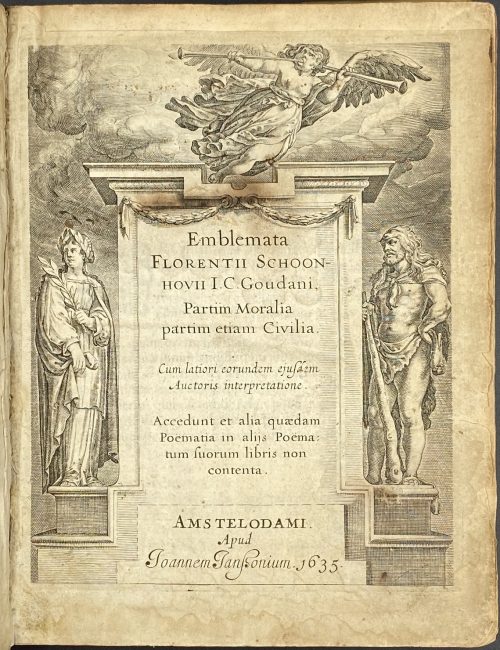 Title: Emblemata | Florentii Schoon~ | hovii I. C. Goudani, | Partim moralia | partim etiam Civilia. | Cum latiori eorundem ejusdem | Auctoris interpretatione. | Accedunt et alia quædam | Poëmatia in alijs Poëma | tum suorum libris non | contenta. | Amstelodami. | Apud | Joannem Janßonium •1635• Size: 20 x15.5 cm, small 4to Edition: 3rd edition (the first two editions being by Burier, Gouda, 1618 and by Elzevir, Leiden, 1626. Collation: ¶/*6, A-Z4, Aa-Ff4, Gg2. Pagination: [2] - enrgaved t.p. / blank, [6] - dedication, [2] - lectori benevolo, [2] - in commend. / frontis. engraved portrait of Gerardus Traudenius – academic/intellectual; author/poet (Dutch, fl. 1615 – 1623), 1-235. Illustrated with engraved title, portrait of dedicatee, and 74 engraved emblems by Crispijn van de Passe the Younger (1594/5 – 1670). Binding: bound in full contemporary Dutch blind-stamped parchment over thin boards, laced case construction, inked title to spine, no flyleaves, signature washed from the title, the blank margin of title trimmed away at head, slight marginal water stain to the first signature, front bottom board corner bumped.
Title: Emblemata | Florentii Schoon~ | hovii I. C. Goudani, | Partim moralia | partim etiam Civilia. | Cum latiori eorundem ejusdem | Auctoris interpretatione. | Accedunt et alia quædam | Poëmatia in alijs Poëma | tum suorum libris non | contenta. | Amstelodami. | Apud | Joannem Janßonium •1635• Size: 20 x15.5 cm, small 4to Edition: 3rd edition (the first two editions being by Burier, Gouda, 1618 and by Elzevir, Leiden, 1626. Collation: ¶/*6, A-Z4, Aa-Ff4, Gg2. Pagination: [2] - enrgaved t.p. / blank, [6] - dedication, [2] - lectori benevolo, [2] - in commend. / frontis. engraved portrait of Gerardus Traudenius – academic/intellectual; author/poet (Dutch, fl. 1615 – 1623), 1-235. Illustrated with engraved title, portrait of dedicatee, and 74 engraved emblems by Crispijn van de Passe the Younger (1594/5 – 1670). Binding: bound in full contemporary Dutch blind-stamped parchment over thin boards, laced case construction, inked title to spine, no flyleaves, signature washed from the title, the blank margin of title trimmed away at head, slight marginal water stain to the first signature, front bottom board corner bumped. -
 Magazine article by Edgar Jepson: The Iron Tsuba of Japan (Section: Oriental Art), published in volume Vol. 70 (September–December) of The Connoisseur: An Illustrated Magazine for Collectors, Vol. 70 (September–December); pp. 143-152 / C. Reginald Grundy [ed.] — London: Published by the Proprietor, W. CLAUSE JOHNSON, at the Editorial and Advertisement Offices of The Connoisseur, 1924. Owner's half black morocco, gilt lettering to spine, blue cloth boards. Two volumes bound together without original covers. Size 28.5 x 22 cm. Vol. 1: The Connoisseur | An Illustrated Magazine | For Collectors | Edited by C. Reginald Grundy | Vol. LXIX. | (MAY—AUGUST, 1924) | LONDON | Published by the Proprietor, W. CLAUSE JOHNSON, at the | Editorial and Advertisement Offices of The Connoisseur, | at 1, Duke Street, St. James's, S.W. 1 | 1924 || Pp.: [i-ii] iii-xviii [xix] [1, 2 - plate] 3-249 [250]. Vol. 2: The Connoisseur | An Illustrated Magazine | For Collectors | Edited by C. Reginald Grundy | Vol. LXX. | (SEPTEMBER—DECEMBER, 1924) | LONDON | Published by the Proprietor, W. CLAUSE JOHNSON, at the | Editorial and Advertisement Offices of The Connoisseur, | at 1, Duke Street, St. James's, S.W. 1 | 1924 || Pp.: [i-ii] iii-xxii [2 blanks] [1, 2 - plate] 3-261 [262]. The Iron Tsuba of Japan by Edgar Jepson The heart of Japan was in the sword. However admirable may be the paintings, the prints, the netsuke, the lacquer, or the bronzes of the Japanese masters, the supreme artistic achievements of Japan were the blades of Masamune, Muramasa, Sadamune, and Rai Kunitsugu. But not a little of the heart of Japan went also in the tsuba, the guard which protected the hand that wielded the blade, into the iron tsuba of the fighting Samurai. Beside the forgers of the iron tsuba of Japan the ironsmiths of the rest of the world have been mere children. The earliest tsuba were of bronze or copper, often gilded. It is probable that they were replaced by iron tsuba during the Kamakura period, the great fighting era, which lasted from A.D. 1185 to 1333. During the later half of the twelfth century leather tsuba, strengthened by thin iron plates or a metal rim, also replaced the bronze and copper tsuba. It was at this time that a family of armourers of the name of Masuda, and in particular Masuda Munesuke, the founder of the Myochin family, began to forge iron tsuba — thin, round plates of great hardness and density. But it is probable that no tsuba perforated with a view to decorative effects were forged before the end of the fourteenth century. These fourteenth-century tsuba are exceedingly rare in England. I have seen none in the museums, none in the famous collections that have been sold during the last ten years. Those photographed in Herr Oeder's book might easily be the fifteenth century. No. 1 is a curious cup-shape tsuba decorated with a bronze and copper inlay. No. 2, with its edges curiously twisted in the forging, looks like Myochin work. But it is not of the Myochin iron. The Myochin family produced some of the greatest ironsmiths of Japan. Armourers first of all, tsubasmiths, forgers of sake-kettles, articulated reptiles, crustacea, and insects — everything that can be done with iron they did; they pushed their medium to its limit. They were forging iron tsuba in 1160, and they were still forging them in 1860. And it was their own iron, or rather their own steel. They discovered the secret of it early, and they kept that secret in the family for all those hundreds of years. There is no mistaking a Myochin tsuba: balance it on your finger and tap it with a piece of metal, always it gives forth a clear bell-like ring that you get from the work of no other ironsmith, Japanese or European. Always the Myochin tsuba is before everything a protection to the hand of the swordsman; to that everything is, as it should be, subordinated. No. 3 is a Myochin tsuba of the fifteenth century, and probably of the early fifteenth century. No. 4, by Myochin Munetaka, perforated with a grotesque figure, is an example of that twisting and twisting of the iron in the forging till it forms a pattern like the grain of wood. The Myochin smiths invented these wood-grain tsuba, and no other smiths equalled them in their forging. In the sixteenth century, the fighting tsuba was probably at its best. It was a century of great tsubasmiths. Then the first Nobuiye, whose tsuba fetched £100 apiece, circa 1800, in Japan, and the first Kaneiye flourished. No. 5 is a tsuba forged by a great smith, Iyesada of Sotome, in the manner of Nobuiye I, decorated with the karakusa tendrils that Nobuiye delighted in, with lightning and clouds. No. 6 is a guard of Sanada Tembo, the chief smith of the Tembo family, stamped, punning fashion, with the character Tembo. Akin to the Tembo tsuba were those of the Kiami and Hoan smiths. Then also the Heianjo smiths and the Owari smiths, especially those of Nagoya and the Yamakichi family, forged their strongest tsuba. Those of the Yamakichi were tested after the forging by being pounded in iron mortars — at least, so the legend runs. But they were a sternly utilitarian family, and I have never seen a Yamakichi tsuba of any beauty. In the later half of the fifteenth century arose the fashion of decorating tsuba with an inlay, zogan, of bronze. The Heianjo tsuba, forged at Kyoto in the latter half of the fifteenth and the beginning of the sixteenth century, were often thus inlaid. The earliest of them were called "Onin", of which No. 7 is an example. In addition to the bronze inlay around the edge, it is inlaid with a representation, some say, of snow; others say, of the duckweed on a pond. No. 8 is probably a Heianjo tsuba, but I am not quite sure about it. The inlaid acacia branches might be very early Shoami work. But to judge by the iron, it is a fifteenth-century tsuba; and the authorities place the beginning of the Shoami school not later than early in the sixteenth century. No. 10 is an example of the Fushimi-zogan, a flat inlay of a light-coloured bronze. These tsuba took their name from the fact that they were first forged at Fushimi, in Yamashiro, in the sixteenth century. It is of the type known as Mon-zukashi, perforated with crests (mon) à jour. The Yoshiro-zogan tsuba were also first forged at Fushimi by Yoshiro Naomasa. They were distinguished from the Fushimi-zogan by the fact that their inlay was generally a little raised-not always-for the inlay of No. 9, a tsuba forged by a later nineteenth-century Yoshiro, is quite flat. It is an interesting tsuba, for, with its decoration grown florid and excessive, it marks the intermediate stage between the simple and delightful designs of the genuine fighting tsuba and the elaborate pictures in gold and silver on the tsuba of the eighteenth-century smiths of Awa and Kyoto, which have become mere ornaments of the goldsmith. The Gomoku-zogan (No. 11) tsuba were probably first forged earlier than the Fushimi and Yoshiro-zogan tsuba. This inlay, in slight relief, is a representation in a light-coloured bronze and copper of twigs caught in the eddies of streams. The seventeenth century and early eighteenth century were the great periods of perforated tsuba. The designs, and they are often admirable, are for the most part in plain fretwork; but they are also chased. No. 12, a crane under an acacia, is a tsuba of a Higo smith, great forgers of fighting tsuba during this period. These smiths also excelled in nunome zogan, a very thin gold and silver inlay, with which they further decorated their perforated guards. The smiths of the Umetada and Shoami families also forged iron tsuba during this period; but their designs, though sometimes pleasing enough, are rarely fine. The best work of Myoju Umetada is in sentoku, not iron. The Choshu smiths, coming later, surpass the perforated guards of both the Umetada and Shoami smiths in beauty of design. No. 13, a lotus in the round, not only fretwork, but also engraved, is a good example of the admirable balance they so often attained in their designs. It is a sufficiently realistic lotus, but yet of a delightful simplicity. In considerable contrast is No. 14, the dragon by Soheishi Soten — one of the only two authentic tsuba of his forging known — the first forger of hikone-bori tsuba, which were in extraordinary favour in Japan during the eighteenth century, and illustrated every important event in Japanese history. It is on the elaborate side, but fine, strong work, and an excellent guard to the hand, for the lighter and more open part, which gives the design its admirable balance, is on the inside, and not exposed to the full swing of an opponent's blade. A few years ago there was a tendency to decry the Namban tsuba as having sprung too directly from foreign sources. But though the original suggestion may have been Chinese, or, as some say, Portuguese, the Japanese made it entirely their own, as characteristically Japanese as anything can well be, but, it must be admitted, of a decadent period. The school took its rise at the beginning of the seventeenth century, and the early tsuba were forged of a specially hard iron, the Wootz, imported from Southern India. No. 15, the signs of the Zodiac, is an excellent tsuba from the fighting point of view. Both it and No. 16 are of quite charming, if elaborate, design, and both of them, with their delicate scroll-work, so astonishingly undercut, are the very last word in the work of the ironsmith-veritable iron lace. To return to the simpler perforated tsuba, the smiths of Akasaka, a suburb of Tokyo, produced probably the most charming designs. Their style derives considerably from the Higo smiths, and their earlier fighting tsuba are very like the Higo tsuba. But always their work was just a little lighter than that of the Higo smiths, and in the end they moved right away from them and became the forgers of very light guards indeed. No. 17, is a representation of the Hiyokudori, the fabulous double bird, in which were reincarnated the souls of the two lovers, Gompachi and Komurasaki; and No. 18, “the tsuba of a hundred ducks "— there are about forty — are characteristic designs of the school. In the work of the Akasaka smiths the balance, which makes the design of a good tsuba so admirable and delightful, attains its height. This admirable balance seems often to be obtained by a deliberate sacrifice of symmetry. About nine hundred and ninety-nine European ironsmiths out of a thousand would have made the right and left sides of the Hiyoku-dori line by line, and perforation by perforation, exactly alike; he would have cut out exactly as many ducks on the one side of “the tsuba of a hundred ducks” as on the other, and made each duck on the right side correspond exactly in position and attitude with a duck on the left side. By variations the tsubasmith attained a finer balance, almost a higher symmetry. No. 19, often called by collectors the "rose-window" tsuba, but really a stylised chrysanthemum, is a favourite design of the Akasaka smiths, but Hizen work and inlaid in the Hizen manner with gold nunome. No. 20 is a Satsuma tsuba of the middle period. The Satsuma smiths of the nineteenth century produced probably the most ornate of all the iron guards, for the most part calibashes and beans with their leaves and tendrils realistic in the extreme, but of charming design. Few crafts have been carried further than that of the tsubasmith; few crafts working in a difficult medium have handled more subjects with greater feeling for beauty or greater liveliness of fancy. It is interesting to note again and again how school influences school, and smith influences smith. But, as in all the applied arts, the finest tsuba were forged by men who never lost sight of the purpose of a tsuba, that it is before everything a protection to the hand, and never subjected that purpose to a passion for virtuosity. Illustrations: No 1. FOURTEENTH-CENTURY TSUBA, WITH BRONZE AND COPPER INLAY No. 2. FOURTEENTH-CENTURY TSUBA, RESEMBLING MYOCHIN WORK No. 3. MYOCHIN TSUBA, FIFTEENTH CENTURY No. 4. MYOCHIN TSUBA, NINETEENTH CENTURY No. 5. SIXTEENTH-CENTURY TSUBA No. 6. SIXTEENTH-CENTURY TSUBA BY IYESADA OF SOTOME BY SANADA TEMBO No. 7. ONIN TSUBA No. 8. HEIANJO (?) TSUBA No. 9. YOSHIRO TSUBA, NINETEENTH CENTURY No. 10. FUSHIMI-ZOGAN, NINETEENTH CENTURY No. 11.- GOMOKU-ZOGAN, SIXTEENTH CENTURY No. 12. HIGO TSUBA, SEVENTEENTH CENTURY No. 13. CHOSHU TSUBA, SEVENTEENTH CENTURY No. 14. SOTEN TSUBA, SEVENTEENTH CENTURY No. 15. NAMBAN TSUBA, EIGHTEENTH CENTURY No. 16. NAMBAN TSUBA, NINETEENTH CENTURY Nos. 17. AND 18. AKASAKA TSUBA, EIGHTEENTH CENTURY No. 19. HIZEN TSUBA, EIGHTEENTH CENTURY No. 20. SATSUMA TSUBA, EIGHTEENTH CENTURY
Magazine article by Edgar Jepson: The Iron Tsuba of Japan (Section: Oriental Art), published in volume Vol. 70 (September–December) of The Connoisseur: An Illustrated Magazine for Collectors, Vol. 70 (September–December); pp. 143-152 / C. Reginald Grundy [ed.] — London: Published by the Proprietor, W. CLAUSE JOHNSON, at the Editorial and Advertisement Offices of The Connoisseur, 1924. Owner's half black morocco, gilt lettering to spine, blue cloth boards. Two volumes bound together without original covers. Size 28.5 x 22 cm. Vol. 1: The Connoisseur | An Illustrated Magazine | For Collectors | Edited by C. Reginald Grundy | Vol. LXIX. | (MAY—AUGUST, 1924) | LONDON | Published by the Proprietor, W. CLAUSE JOHNSON, at the | Editorial and Advertisement Offices of The Connoisseur, | at 1, Duke Street, St. James's, S.W. 1 | 1924 || Pp.: [i-ii] iii-xviii [xix] [1, 2 - plate] 3-249 [250]. Vol. 2: The Connoisseur | An Illustrated Magazine | For Collectors | Edited by C. Reginald Grundy | Vol. LXX. | (SEPTEMBER—DECEMBER, 1924) | LONDON | Published by the Proprietor, W. CLAUSE JOHNSON, at the | Editorial and Advertisement Offices of The Connoisseur, | at 1, Duke Street, St. James's, S.W. 1 | 1924 || Pp.: [i-ii] iii-xxii [2 blanks] [1, 2 - plate] 3-261 [262]. The Iron Tsuba of Japan by Edgar Jepson The heart of Japan was in the sword. However admirable may be the paintings, the prints, the netsuke, the lacquer, or the bronzes of the Japanese masters, the supreme artistic achievements of Japan were the blades of Masamune, Muramasa, Sadamune, and Rai Kunitsugu. But not a little of the heart of Japan went also in the tsuba, the guard which protected the hand that wielded the blade, into the iron tsuba of the fighting Samurai. Beside the forgers of the iron tsuba of Japan the ironsmiths of the rest of the world have been mere children. The earliest tsuba were of bronze or copper, often gilded. It is probable that they were replaced by iron tsuba during the Kamakura period, the great fighting era, which lasted from A.D. 1185 to 1333. During the later half of the twelfth century leather tsuba, strengthened by thin iron plates or a metal rim, also replaced the bronze and copper tsuba. It was at this time that a family of armourers of the name of Masuda, and in particular Masuda Munesuke, the founder of the Myochin family, began to forge iron tsuba — thin, round plates of great hardness and density. But it is probable that no tsuba perforated with a view to decorative effects were forged before the end of the fourteenth century. These fourteenth-century tsuba are exceedingly rare in England. I have seen none in the museums, none in the famous collections that have been sold during the last ten years. Those photographed in Herr Oeder's book might easily be the fifteenth century. No. 1 is a curious cup-shape tsuba decorated with a bronze and copper inlay. No. 2, with its edges curiously twisted in the forging, looks like Myochin work. But it is not of the Myochin iron. The Myochin family produced some of the greatest ironsmiths of Japan. Armourers first of all, tsubasmiths, forgers of sake-kettles, articulated reptiles, crustacea, and insects — everything that can be done with iron they did; they pushed their medium to its limit. They were forging iron tsuba in 1160, and they were still forging them in 1860. And it was their own iron, or rather their own steel. They discovered the secret of it early, and they kept that secret in the family for all those hundreds of years. There is no mistaking a Myochin tsuba: balance it on your finger and tap it with a piece of metal, always it gives forth a clear bell-like ring that you get from the work of no other ironsmith, Japanese or European. Always the Myochin tsuba is before everything a protection to the hand of the swordsman; to that everything is, as it should be, subordinated. No. 3 is a Myochin tsuba of the fifteenth century, and probably of the early fifteenth century. No. 4, by Myochin Munetaka, perforated with a grotesque figure, is an example of that twisting and twisting of the iron in the forging till it forms a pattern like the grain of wood. The Myochin smiths invented these wood-grain tsuba, and no other smiths equalled them in their forging. In the sixteenth century, the fighting tsuba was probably at its best. It was a century of great tsubasmiths. Then the first Nobuiye, whose tsuba fetched £100 apiece, circa 1800, in Japan, and the first Kaneiye flourished. No. 5 is a tsuba forged by a great smith, Iyesada of Sotome, in the manner of Nobuiye I, decorated with the karakusa tendrils that Nobuiye delighted in, with lightning and clouds. No. 6 is a guard of Sanada Tembo, the chief smith of the Tembo family, stamped, punning fashion, with the character Tembo. Akin to the Tembo tsuba were those of the Kiami and Hoan smiths. Then also the Heianjo smiths and the Owari smiths, especially those of Nagoya and the Yamakichi family, forged their strongest tsuba. Those of the Yamakichi were tested after the forging by being pounded in iron mortars — at least, so the legend runs. But they were a sternly utilitarian family, and I have never seen a Yamakichi tsuba of any beauty. In the later half of the fifteenth century arose the fashion of decorating tsuba with an inlay, zogan, of bronze. The Heianjo tsuba, forged at Kyoto in the latter half of the fifteenth and the beginning of the sixteenth century, were often thus inlaid. The earliest of them were called "Onin", of which No. 7 is an example. In addition to the bronze inlay around the edge, it is inlaid with a representation, some say, of snow; others say, of the duckweed on a pond. No. 8 is probably a Heianjo tsuba, but I am not quite sure about it. The inlaid acacia branches might be very early Shoami work. But to judge by the iron, it is a fifteenth-century tsuba; and the authorities place the beginning of the Shoami school not later than early in the sixteenth century. No. 10 is an example of the Fushimi-zogan, a flat inlay of a light-coloured bronze. These tsuba took their name from the fact that they were first forged at Fushimi, in Yamashiro, in the sixteenth century. It is of the type known as Mon-zukashi, perforated with crests (mon) à jour. The Yoshiro-zogan tsuba were also first forged at Fushimi by Yoshiro Naomasa. They were distinguished from the Fushimi-zogan by the fact that their inlay was generally a little raised-not always-for the inlay of No. 9, a tsuba forged by a later nineteenth-century Yoshiro, is quite flat. It is an interesting tsuba, for, with its decoration grown florid and excessive, it marks the intermediate stage between the simple and delightful designs of the genuine fighting tsuba and the elaborate pictures in gold and silver on the tsuba of the eighteenth-century smiths of Awa and Kyoto, which have become mere ornaments of the goldsmith. The Gomoku-zogan (No. 11) tsuba were probably first forged earlier than the Fushimi and Yoshiro-zogan tsuba. This inlay, in slight relief, is a representation in a light-coloured bronze and copper of twigs caught in the eddies of streams. The seventeenth century and early eighteenth century were the great periods of perforated tsuba. The designs, and they are often admirable, are for the most part in plain fretwork; but they are also chased. No. 12, a crane under an acacia, is a tsuba of a Higo smith, great forgers of fighting tsuba during this period. These smiths also excelled in nunome zogan, a very thin gold and silver inlay, with which they further decorated their perforated guards. The smiths of the Umetada and Shoami families also forged iron tsuba during this period; but their designs, though sometimes pleasing enough, are rarely fine. The best work of Myoju Umetada is in sentoku, not iron. The Choshu smiths, coming later, surpass the perforated guards of both the Umetada and Shoami smiths in beauty of design. No. 13, a lotus in the round, not only fretwork, but also engraved, is a good example of the admirable balance they so often attained in their designs. It is a sufficiently realistic lotus, but yet of a delightful simplicity. In considerable contrast is No. 14, the dragon by Soheishi Soten — one of the only two authentic tsuba of his forging known — the first forger of hikone-bori tsuba, which were in extraordinary favour in Japan during the eighteenth century, and illustrated every important event in Japanese history. It is on the elaborate side, but fine, strong work, and an excellent guard to the hand, for the lighter and more open part, which gives the design its admirable balance, is on the inside, and not exposed to the full swing of an opponent's blade. A few years ago there was a tendency to decry the Namban tsuba as having sprung too directly from foreign sources. But though the original suggestion may have been Chinese, or, as some say, Portuguese, the Japanese made it entirely their own, as characteristically Japanese as anything can well be, but, it must be admitted, of a decadent period. The school took its rise at the beginning of the seventeenth century, and the early tsuba were forged of a specially hard iron, the Wootz, imported from Southern India. No. 15, the signs of the Zodiac, is an excellent tsuba from the fighting point of view. Both it and No. 16 are of quite charming, if elaborate, design, and both of them, with their delicate scroll-work, so astonishingly undercut, are the very last word in the work of the ironsmith-veritable iron lace. To return to the simpler perforated tsuba, the smiths of Akasaka, a suburb of Tokyo, produced probably the most charming designs. Their style derives considerably from the Higo smiths, and their earlier fighting tsuba are very like the Higo tsuba. But always their work was just a little lighter than that of the Higo smiths, and in the end they moved right away from them and became the forgers of very light guards indeed. No. 17, is a representation of the Hiyokudori, the fabulous double bird, in which were reincarnated the souls of the two lovers, Gompachi and Komurasaki; and No. 18, “the tsuba of a hundred ducks "— there are about forty — are characteristic designs of the school. In the work of the Akasaka smiths the balance, which makes the design of a good tsuba so admirable and delightful, attains its height. This admirable balance seems often to be obtained by a deliberate sacrifice of symmetry. About nine hundred and ninety-nine European ironsmiths out of a thousand would have made the right and left sides of the Hiyoku-dori line by line, and perforation by perforation, exactly alike; he would have cut out exactly as many ducks on the one side of “the tsuba of a hundred ducks” as on the other, and made each duck on the right side correspond exactly in position and attitude with a duck on the left side. By variations the tsubasmith attained a finer balance, almost a higher symmetry. No. 19, often called by collectors the "rose-window" tsuba, but really a stylised chrysanthemum, is a favourite design of the Akasaka smiths, but Hizen work and inlaid in the Hizen manner with gold nunome. No. 20 is a Satsuma tsuba of the middle period. The Satsuma smiths of the nineteenth century produced probably the most ornate of all the iron guards, for the most part calibashes and beans with their leaves and tendrils realistic in the extreme, but of charming design. Few crafts have been carried further than that of the tsubasmith; few crafts working in a difficult medium have handled more subjects with greater feeling for beauty or greater liveliness of fancy. It is interesting to note again and again how school influences school, and smith influences smith. But, as in all the applied arts, the finest tsuba were forged by men who never lost sight of the purpose of a tsuba, that it is before everything a protection to the hand, and never subjected that purpose to a passion for virtuosity. Illustrations: No 1. FOURTEENTH-CENTURY TSUBA, WITH BRONZE AND COPPER INLAY No. 2. FOURTEENTH-CENTURY TSUBA, RESEMBLING MYOCHIN WORK No. 3. MYOCHIN TSUBA, FIFTEENTH CENTURY No. 4. MYOCHIN TSUBA, NINETEENTH CENTURY No. 5. SIXTEENTH-CENTURY TSUBA No. 6. SIXTEENTH-CENTURY TSUBA BY IYESADA OF SOTOME BY SANADA TEMBO No. 7. ONIN TSUBA No. 8. HEIANJO (?) TSUBA No. 9. YOSHIRO TSUBA, NINETEENTH CENTURY No. 10. FUSHIMI-ZOGAN, NINETEENTH CENTURY No. 11.- GOMOKU-ZOGAN, SIXTEENTH CENTURY No. 12. HIGO TSUBA, SEVENTEENTH CENTURY No. 13. CHOSHU TSUBA, SEVENTEENTH CENTURY No. 14. SOTEN TSUBA, SEVENTEENTH CENTURY No. 15. NAMBAN TSUBA, EIGHTEENTH CENTURY No. 16. NAMBAN TSUBA, NINETEENTH CENTURY Nos. 17. AND 18. AKASAKA TSUBA, EIGHTEENTH CENTURY No. 19. HIZEN TSUBA, EIGHTEENTH CENTURY No. 20. SATSUMA TSUBA, EIGHTEENTH CENTURY -
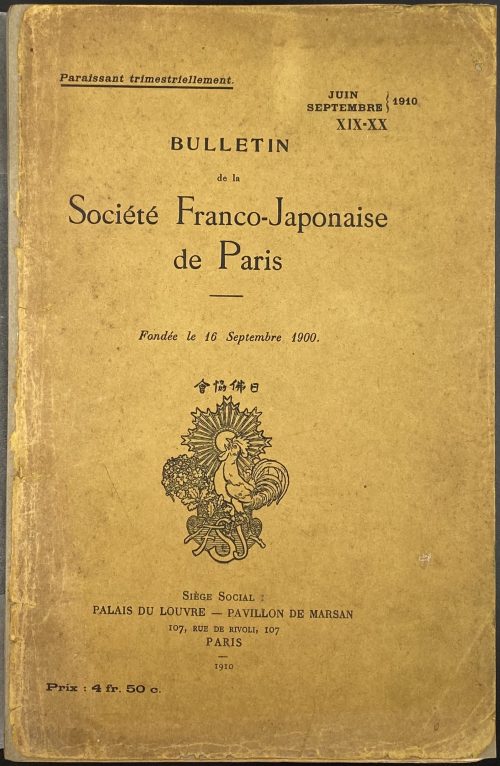 Comte de Tressan. L'évolution de la garde de sabre japonaise de la fin du XVe siècle au commencement du XVIIe (suite), 34 illustr. – pp. 7-35. // Bulletin de la Société Franco-Japonaise de Paris; №№ 19-20, Juin–Septembre 1910, 216 p. — Paris: Société Franco-Japonaise de Paris, Siège Social, 1910. Publisher's original green wrappers with black lettering: On top: Paraissant trimestriellement. | JUIN | SEPTEMBRE | } 1920 | XIX-XX | In the middle: BULLETIN | de la | Société Franco-Japonaise | de Paris | [—] Fondée le 16 Septembre 1900 | [device] | Bottom: Siège Social : | PALAIS DU LOUVRE — PAVILLON DE MARSAN | 107, RUE DE RIVOLI, 107 | Paris | 1910 | Prix : 4 fr 50 c || — Pp.: [4] [1-5] 6-216 [2 - errata / blank] [2 - imprim./ blank] [6]. Size: 27 x 17.5 cm.
Comte de Tressan. L'évolution de la garde de sabre japonaise de la fin du XVe siècle au commencement du XVIIe (suite), 34 illustr. – pp. 7-35. // Bulletin de la Société Franco-Japonaise de Paris; №№ 19-20, Juin–Septembre 1910, 216 p. — Paris: Société Franco-Japonaise de Paris, Siège Social, 1910. Publisher's original green wrappers with black lettering: On top: Paraissant trimestriellement. | JUIN | SEPTEMBRE | } 1920 | XIX-XX | In the middle: BULLETIN | de la | Société Franco-Japonaise | de Paris | [—] Fondée le 16 Septembre 1900 | [device] | Bottom: Siège Social : | PALAIS DU LOUVRE — PAVILLON DE MARSAN | 107, RUE DE RIVOLI, 107 | Paris | 1910 | Prix : 4 fr 50 c || — Pp.: [4] [1-5] 6-216 [2 - errata / blank] [2 - imprim./ blank] [6]. Size: 27 x 17.5 cm. -
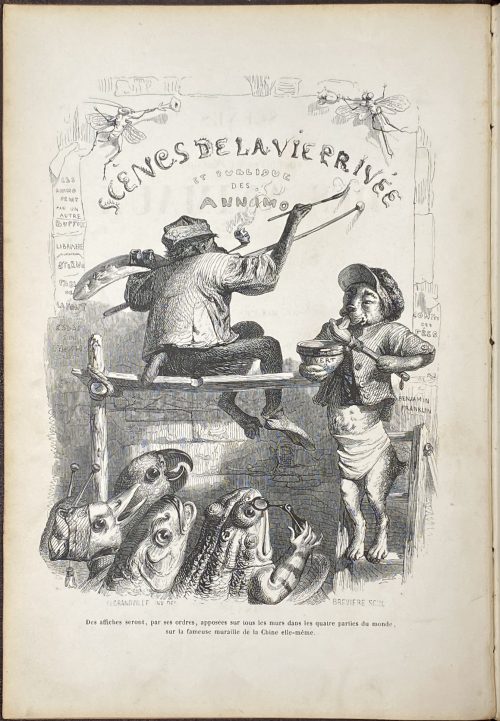 A two-volume set in the contemporary full calf, imitating the editorial cloth binding. Vol. 1: SCÈNES | DE LA | VIE PRIVÉE ET PUBLIQUE | DES ANIMAUX | VIGNETTES | PAR GRANDVILLE. | — | ÉTUDES DE MŒURS CONTEMPORAINES | PUBLIÉES | SOUS LA DIRECTION DE M. P. – J. STAHL , | AVEC LA COLLABORATION | DE MESSIEURS | DE BALZAC. – L. BAUDE. – E. DE LA BEDOLLIERE. – P. BERNARD. – J. JANIN. | ED. LEMOINE. – CHARLES NODIER. – GEORGE SAND. | [VIGNETTE] | PARIS. | J. HETZEL ET PAULIN , ÉDITEURS , | RUE DE SEINE-SAINT-GERMAIN , 33. | 1842 Pagination: [2 blanks] [2 - ht. / imprim.] [2 - blank / frontis.] [2 - t.p. / blank] [4] [1] 2-386 [6 - table] [2 blanks], 96 whole-page wood-engravings after Grandville, vignettes within the text including head and tailpieces, together with a frontispiece. VOL. 2: SCÈNES | DE LA | VIE PRIVÉE ET PUBLIQUE | DES ANIMAUX | VIGNETTES | PAR GRANDVILLE. | — | ÉTUDES DE MŒURS CONTEMPORAINES | PUBLIÉES | SOUS LA DIRECTION DE M. P. – J. STAHL , | AVEC LA COLLABORATION | DE | MM. DE BALZAC, – L' HERITIER (DE L' AIN), – ALFRED DE MUSSET – PAUL DE MUSSET, | CHARLES NODIER, – MADAME M. MENESSIER NODIER, – LOUIS VIARDOT. | [VIGNETTE] | PARIS, | J. HETZEL , ÉDITEUR , | RUE DE SEINE-SAINT-GERMAIN , 33. | 1842 Pagination: [2 - ht. / imprim.] [2 - blank / frontis.] [2 - t.p. / blank] [1] 2-390 [6 - table], 105 whole-page wood-engravings after Grandville, vignettes within the text including head and tailpieces, together with a frontispiece. Size: Each volume 27 x 18 cm; In-4to (usually classified as 8vo, however, the numeric signatures provide for gathering in-quarto). Binding: Full burgundy calf, gilt embossed Grandville's characters to boards and spine, lettering to spine, white moire end-papers to vol. 1, and yellow end-papers to vol. 2, all margins gilt. Combination of the 1st and 2nd print-runs of the 1st edition. Ref.: L. Carteret, 1927: pp. 552-558. Wikipedia; Gallica; Hathi Trust. In: British Museum, MET, RISD Museum, Fine Arts Museums of San Francisco.
A two-volume set in the contemporary full calf, imitating the editorial cloth binding. Vol. 1: SCÈNES | DE LA | VIE PRIVÉE ET PUBLIQUE | DES ANIMAUX | VIGNETTES | PAR GRANDVILLE. | — | ÉTUDES DE MŒURS CONTEMPORAINES | PUBLIÉES | SOUS LA DIRECTION DE M. P. – J. STAHL , | AVEC LA COLLABORATION | DE MESSIEURS | DE BALZAC. – L. BAUDE. – E. DE LA BEDOLLIERE. – P. BERNARD. – J. JANIN. | ED. LEMOINE. – CHARLES NODIER. – GEORGE SAND. | [VIGNETTE] | PARIS. | J. HETZEL ET PAULIN , ÉDITEURS , | RUE DE SEINE-SAINT-GERMAIN , 33. | 1842 Pagination: [2 blanks] [2 - ht. / imprim.] [2 - blank / frontis.] [2 - t.p. / blank] [4] [1] 2-386 [6 - table] [2 blanks], 96 whole-page wood-engravings after Grandville, vignettes within the text including head and tailpieces, together with a frontispiece. VOL. 2: SCÈNES | DE LA | VIE PRIVÉE ET PUBLIQUE | DES ANIMAUX | VIGNETTES | PAR GRANDVILLE. | — | ÉTUDES DE MŒURS CONTEMPORAINES | PUBLIÉES | SOUS LA DIRECTION DE M. P. – J. STAHL , | AVEC LA COLLABORATION | DE | MM. DE BALZAC, – L' HERITIER (DE L' AIN), – ALFRED DE MUSSET – PAUL DE MUSSET, | CHARLES NODIER, – MADAME M. MENESSIER NODIER, – LOUIS VIARDOT. | [VIGNETTE] | PARIS, | J. HETZEL , ÉDITEUR , | RUE DE SEINE-SAINT-GERMAIN , 33. | 1842 Pagination: [2 - ht. / imprim.] [2 - blank / frontis.] [2 - t.p. / blank] [1] 2-390 [6 - table], 105 whole-page wood-engravings after Grandville, vignettes within the text including head and tailpieces, together with a frontispiece. Size: Each volume 27 x 18 cm; In-4to (usually classified as 8vo, however, the numeric signatures provide for gathering in-quarto). Binding: Full burgundy calf, gilt embossed Grandville's characters to boards and spine, lettering to spine, white moire end-papers to vol. 1, and yellow end-papers to vol. 2, all margins gilt. Combination of the 1st and 2nd print-runs of the 1st edition. Ref.: L. Carteret, 1927: pp. 552-558. Wikipedia; Gallica; Hathi Trust. In: British Museum, MET, RISD Museum, Fine Arts Museums of San Francisco. -
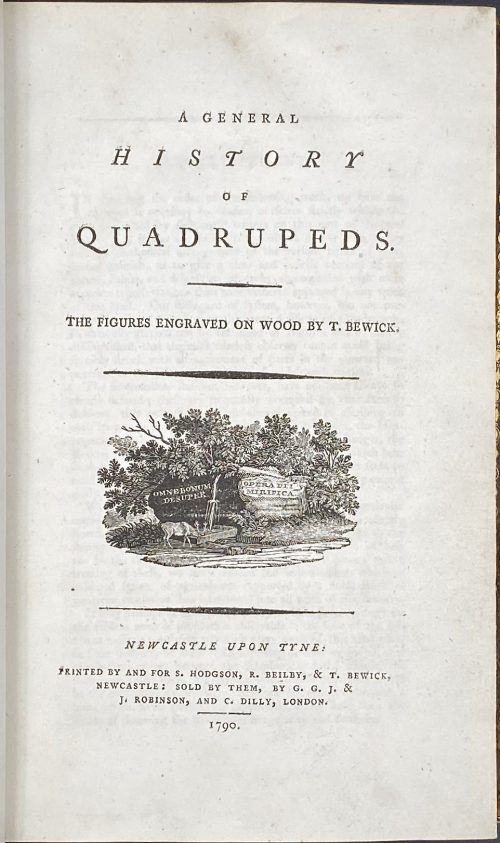 Title: A GENERAL | HISTORY | OF | QUADRUPEDS. | – | THE FIGURES ENGRAVED ON WOOD BY THOMAS BEWICK. | {vignette} | — | NEWCASTLE UPON TYNE : | PRINTED BY AND FOR S. HODGSON, R. BEILBY, & T. BEWICK, | NEWCASTLE: SOLD BY THEM, BY G. G. J. & | J. ROBINSON, AND C. DILLY, LONDON. | 1790. Pagination: [4 blanks], [i, ii] – t.p. / blank, [iii, iv] – advertisement / index, v-viii – index, [1] 2-456 [4 blanks]. Collation: demi 8vo; a⁴ A-Ee⁸ Ff⁴. A3 unsigned, catchword at p.375 THE instead of WE. Variant A (with a fly facing upward). Size: 21.8 x 14 cm; page 21.2 x 13 cm. Woodcuts: 260 descriptions of quadrupeds; 200 figures of quadrupeds, 104 vignettes, tailpieces, etc. Binding: Full marbled calf, gilt double border, black label with gilt lettering to flat spine. There were 1,500 copies Demy copies printed. Catalogue raisonné: S. Roscoe (1953): pp. 5-11; Hugo (1866): pp. 22-23.
Title: A GENERAL | HISTORY | OF | QUADRUPEDS. | – | THE FIGURES ENGRAVED ON WOOD BY THOMAS BEWICK. | {vignette} | — | NEWCASTLE UPON TYNE : | PRINTED BY AND FOR S. HODGSON, R. BEILBY, & T. BEWICK, | NEWCASTLE: SOLD BY THEM, BY G. G. J. & | J. ROBINSON, AND C. DILLY, LONDON. | 1790. Pagination: [4 blanks], [i, ii] – t.p. / blank, [iii, iv] – advertisement / index, v-viii – index, [1] 2-456 [4 blanks]. Collation: demi 8vo; a⁴ A-Ee⁸ Ff⁴. A3 unsigned, catchword at p.375 THE instead of WE. Variant A (with a fly facing upward). Size: 21.8 x 14 cm; page 21.2 x 13 cm. Woodcuts: 260 descriptions of quadrupeds; 200 figures of quadrupeds, 104 vignettes, tailpieces, etc. Binding: Full marbled calf, gilt double border, black label with gilt lettering to flat spine. There were 1,500 copies Demy copies printed. Catalogue raisonné: S. Roscoe (1953): pp. 5-11; Hugo (1866): pp. 22-23. -
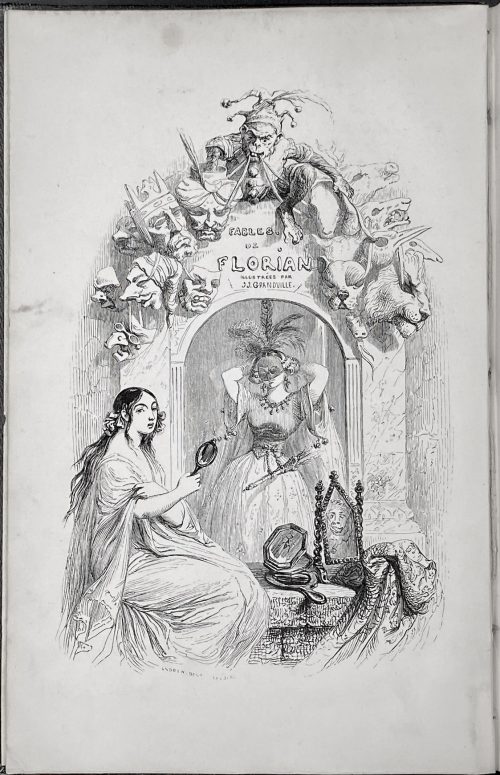 FABLES | DE FLORIAN | ILLUSTRÉES | PAR J.-J. GRANDVILLE , | SUIVIES | DE TOBIE ET RUTH , | Poëmes tirés de l'Ecriture Sainte | ET | PRECEDEES D'UNE NOTICE SUR LA VIE ET LES OUVRAGES DE FLORIAN , | PAR P.-J. STAHL. | [Vignette] PARIS. | J.-J. DUBOCHET ET Cie , ÉDITEURS , | 1842. Pagination: ffl, [2 blanks] [i, ii - ht/imp.] [2 - blank/engr. t.p. by Grandville] [iii, iv - t.p./blank] [v] vi-xx; 2 sheets of plates, [3] 4-292, bfl; engraved t.p. + [79] leaves of plates + 5 faux t.p. (total 85 plates) Size: In-8vo, 23.8 x 15 cm. Binding: Orig. blind-stamped navy cloth with gilt Grandville characters to boards and spine. First edition, first printing. Reference: Léopold Carteret (Le trésor du bibliophile. Epoque romantique. 1801-1875 / Livres illustrés du XIXe siècle. – Paris: L. Carteret; imprim. Lahure, 1927). Wood engravers: Adolphe Best (French, 1808 – 1860): 22 plates Louis-Henri Brévière (French, 1797 – 1869): 3 plates Brugnot (French, active 19th century): 7 plates Prosper-Adolphe-Léon Cherrier (French, born 1806): 6 + Tobie et Ruth + vignettes Louis Dujardin (French, 1808 – 1859): 2 plates Monogram GO–> (possibly for Godard) : 1 plate Halley-Hiback (French, 19th century): 1 + vignette Henri-Désiré Porret (French, 1800–1867): 2 + vignette Lacoste père et fils aîné et Auguste-Alexandre Guillaumot (French, 1815 – 1892): 5 plates Quichon (French, 19th century): 10 plates + Tobie et Ruth François Rouget (Belgian, born bef., 1825): 19 + vignette Unsigned or with an illegible signature: 6 plates
FABLES | DE FLORIAN | ILLUSTRÉES | PAR J.-J. GRANDVILLE , | SUIVIES | DE TOBIE ET RUTH , | Poëmes tirés de l'Ecriture Sainte | ET | PRECEDEES D'UNE NOTICE SUR LA VIE ET LES OUVRAGES DE FLORIAN , | PAR P.-J. STAHL. | [Vignette] PARIS. | J.-J. DUBOCHET ET Cie , ÉDITEURS , | 1842. Pagination: ffl, [2 blanks] [i, ii - ht/imp.] [2 - blank/engr. t.p. by Grandville] [iii, iv - t.p./blank] [v] vi-xx; 2 sheets of plates, [3] 4-292, bfl; engraved t.p. + [79] leaves of plates + 5 faux t.p. (total 85 plates) Size: In-8vo, 23.8 x 15 cm. Binding: Orig. blind-stamped navy cloth with gilt Grandville characters to boards and spine. First edition, first printing. Reference: Léopold Carteret (Le trésor du bibliophile. Epoque romantique. 1801-1875 / Livres illustrés du XIXe siècle. – Paris: L. Carteret; imprim. Lahure, 1927). Wood engravers: Adolphe Best (French, 1808 – 1860): 22 plates Louis-Henri Brévière (French, 1797 – 1869): 3 plates Brugnot (French, active 19th century): 7 plates Prosper-Adolphe-Léon Cherrier (French, born 1806): 6 + Tobie et Ruth + vignettes Louis Dujardin (French, 1808 – 1859): 2 plates Monogram GO–> (possibly for Godard) : 1 plate Halley-Hiback (French, 19th century): 1 + vignette Henri-Désiré Porret (French, 1800–1867): 2 + vignette Lacoste père et fils aîné et Auguste-Alexandre Guillaumot (French, 1815 – 1892): 5 plates Quichon (French, 19th century): 10 plates + Tobie et Ruth François Rouget (Belgian, born bef., 1825): 19 + vignette Unsigned or with an illegible signature: 6 plates -
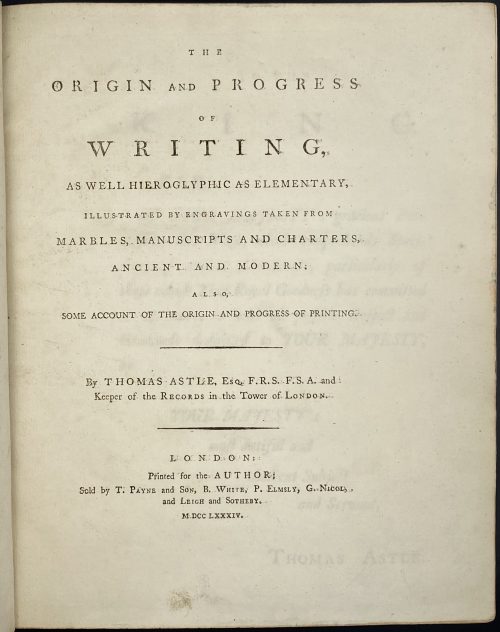 Full Title: THE | ORIGIN AND PROGRESS | OF | WRITING, | AS WELL HIEROGLYPHIC AS ELEMENTARY, | ILLUSTRATED BY ENGRAVINGS TAKEN FROM | MARBLES, MANUSCRIPTS AND CHARTERS, | ANCIENT AND MODERN. | ALSO, | SOME ACCOUNT OF THE ORIGIN AND PROGRESS OF PRINTING. | – | By THOMAS ASTLE, Esq. F.R.S. F.S.A. and | Keeper of the RECORDS in the Tower of LONDON. | – | LONDON: | Printed for the AUTHOR; | Sold by T. PAYNE and SON, B. White, P. Elmsly, G. Nicol, | and LEIGH and SOTHEBY. | M DCC LXXXIV. Pagination: ffl [i, ii] - t.p., blank, [iii, iv] - dedication, blank, [v] vi, vii - contents, [viii] - blank; [i] -xxv - introduction, [xxvi] blank; 1 - of the origin and progress... - 235 [236] blank (229-235 additions and corrections); on p. 235 imprint: FROM THE PRESS OF J. NICHOLS, MDCCLXXXIV; bfl; 31 plates: op. p. 64 (folding), 66, 70, 72 (2), 76, 80 (2, on recto and verso), 82 (2, on recto and verso), 84, 92, 94, 96 (folding), 98 (folding), 100, 102, 104 (folding), 106 (folding), 108 (folding), 112 (folding), 128 (folding), 140 (2, on recto and verso), 142, 146, 150 (folding), 158, 160, 176, 178, folding platessigned "B. T. Pouncy". Collation: [A4] a–c4 π1 B-Z4 Aa-Ff4 Gg2 Hh4. Size: 4to, 29.1 x 24.3 cm. Binding: contemporary full polished brown calf professionally re-backed, single-fillet gilt border to covers, raised bands, black title label with gilt lettering and gilt fillets, gilt year lettering to bottom. Printed on laid paper, margins marbled. Bookplates: "Alex-r Carlile" to front pastedown, "Nicholas Wall. Sometime his book" to back pastedown. To front pastedown: pencil inscriptions and pasted clipping about the book.
Full Title: THE | ORIGIN AND PROGRESS | OF | WRITING, | AS WELL HIEROGLYPHIC AS ELEMENTARY, | ILLUSTRATED BY ENGRAVINGS TAKEN FROM | MARBLES, MANUSCRIPTS AND CHARTERS, | ANCIENT AND MODERN. | ALSO, | SOME ACCOUNT OF THE ORIGIN AND PROGRESS OF PRINTING. | – | By THOMAS ASTLE, Esq. F.R.S. F.S.A. and | Keeper of the RECORDS in the Tower of LONDON. | – | LONDON: | Printed for the AUTHOR; | Sold by T. PAYNE and SON, B. White, P. Elmsly, G. Nicol, | and LEIGH and SOTHEBY. | M DCC LXXXIV. Pagination: ffl [i, ii] - t.p., blank, [iii, iv] - dedication, blank, [v] vi, vii - contents, [viii] - blank; [i] -xxv - introduction, [xxvi] blank; 1 - of the origin and progress... - 235 [236] blank (229-235 additions and corrections); on p. 235 imprint: FROM THE PRESS OF J. NICHOLS, MDCCLXXXIV; bfl; 31 plates: op. p. 64 (folding), 66, 70, 72 (2), 76, 80 (2, on recto and verso), 82 (2, on recto and verso), 84, 92, 94, 96 (folding), 98 (folding), 100, 102, 104 (folding), 106 (folding), 108 (folding), 112 (folding), 128 (folding), 140 (2, on recto and verso), 142, 146, 150 (folding), 158, 160, 176, 178, folding platessigned "B. T. Pouncy". Collation: [A4] a–c4 π1 B-Z4 Aa-Ff4 Gg2 Hh4. Size: 4to, 29.1 x 24.3 cm. Binding: contemporary full polished brown calf professionally re-backed, single-fillet gilt border to covers, raised bands, black title label with gilt lettering and gilt fillets, gilt year lettering to bottom. Printed on laid paper, margins marbled. Bookplates: "Alex-r Carlile" to front pastedown, "Nicholas Wall. Sometime his book" to back pastedown. To front pastedown: pencil inscriptions and pasted clipping about the book. -
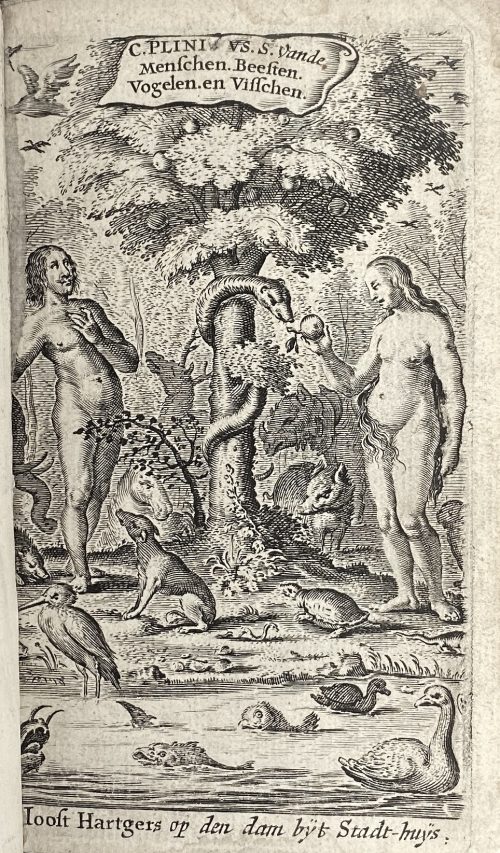 Pliny's Historia Naturalis. Engraved Title: C. PLINIUS S. Vande Menfchen, Beeften, Vogelen en Viffchen. [Pliny the Elder. Of Men, Beasts, Birds, and Fish]. Title: C. PLINII | SECUNDI | Des wijd-vermaerden Na- | tuur-kondigers vijf boecken handelende van de nature. | Handelende van de Nature | I. Vande Manfchen. | II. Vande viervoetige en kruypende Dieren. | III. Vande Vogelen. | IV. Vande kleyne Beeftjes of Ongedierten. | V. Vande Viffchen, Oefters, Kreeften, &c. | Hier zijn by ghevoeght / de Schriften | van verscheyden andere oude autheuren / de | natuer der dieren aengaende; | En nu in defen leften Druck wel het vierde part | vermeerdert , uyt verscheyden nieuwe Schrijvers | en eyghen ondervindinge : en met veel | kopere Plaeten verciert. {Device} | t' AMSTELREDAM , | By Iooft Hartgers, Boeck-verkooper op den Dam | bezijden het Stadthuys, 1650. Pagination: [1, 2] - engraved t.p. / blank, [3, 4] - text t.p. / Aen den nauw-keuringem Lefer..., 5-802, 52 engraved plates; colophon on p. 802 bottom: "Gedruckt by Chiftoffel Cunradus, ..." Collation: A-Z1-12, Aa-Kk1-12 Size: 12mo, 14 x 9 cm Binding: Vellum The first Dutch version, consisting of extracts from books 7-11 from Pliny's "Natural History" was published in Arnheim by Jans Janzen in quarto in 1610. Our copy is one of the Amsterdam editions and the only one in duodecimo. According to WorldCat, there is not a single copy of this edition in the US libraries. Printed by Christoffel Cunradus ( Freiberg , c. 1615 - Amsterdam , 1684) for publisher Joost Hartgers (Dutch, fl. 1650). See Gudger, E. W. "Pliny's Historia Naturalis. The Most Popular Natural History Ever Published." Isis 6, no. 3 (1924): 269-81. Accessed September 23, 2020. http://www.jstor.org/stable/224311.
Pliny's Historia Naturalis. Engraved Title: C. PLINIUS S. Vande Menfchen, Beeften, Vogelen en Viffchen. [Pliny the Elder. Of Men, Beasts, Birds, and Fish]. Title: C. PLINII | SECUNDI | Des wijd-vermaerden Na- | tuur-kondigers vijf boecken handelende van de nature. | Handelende van de Nature | I. Vande Manfchen. | II. Vande viervoetige en kruypende Dieren. | III. Vande Vogelen. | IV. Vande kleyne Beeftjes of Ongedierten. | V. Vande Viffchen, Oefters, Kreeften, &c. | Hier zijn by ghevoeght / de Schriften | van verscheyden andere oude autheuren / de | natuer der dieren aengaende; | En nu in defen leften Druck wel het vierde part | vermeerdert , uyt verscheyden nieuwe Schrijvers | en eyghen ondervindinge : en met veel | kopere Plaeten verciert. {Device} | t' AMSTELREDAM , | By Iooft Hartgers, Boeck-verkooper op den Dam | bezijden het Stadthuys, 1650. Pagination: [1, 2] - engraved t.p. / blank, [3, 4] - text t.p. / Aen den nauw-keuringem Lefer..., 5-802, 52 engraved plates; colophon on p. 802 bottom: "Gedruckt by Chiftoffel Cunradus, ..." Collation: A-Z1-12, Aa-Kk1-12 Size: 12mo, 14 x 9 cm Binding: Vellum The first Dutch version, consisting of extracts from books 7-11 from Pliny's "Natural History" was published in Arnheim by Jans Janzen in quarto in 1610. Our copy is one of the Amsterdam editions and the only one in duodecimo. According to WorldCat, there is not a single copy of this edition in the US libraries. Printed by Christoffel Cunradus ( Freiberg , c. 1615 - Amsterdam , 1684) for publisher Joost Hartgers (Dutch, fl. 1650). See Gudger, E. W. "Pliny's Historia Naturalis. The Most Popular Natural History Ever Published." Isis 6, no. 3 (1924): 269-81. Accessed September 23, 2020. http://www.jstor.org/stable/224311. -
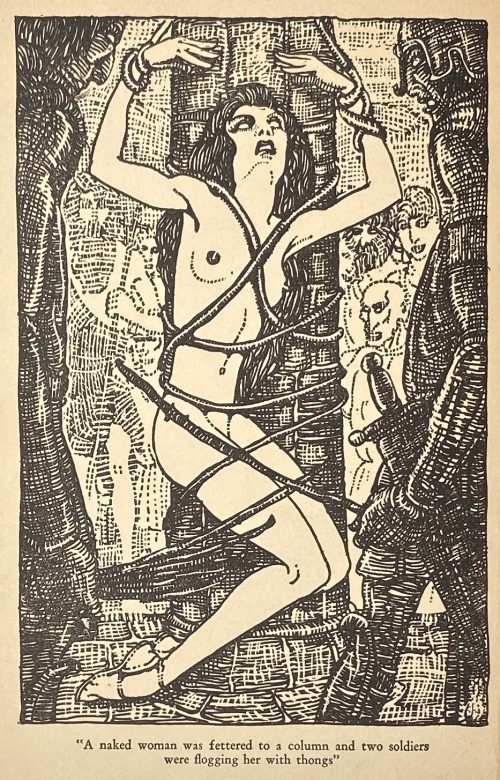 Title (in a frame): THE TEMPTATION | OF ST. ANTHONY | BY | GUSTAVE FLAUBERT | TRANSLATED BY | LAFCADIO HEARN | ILLUSTRATED BY | MAHLON BLAINE | {vignette} | NEW YORK | WILLIAMS, BELASCO | AND MEYERS || Pagination: ffl, [1, 2 - ht, blank] [2 - blank, frontis.] [3, 4 - t.p., colophon] [5, 6 - plate, blank] [7, 8 - list of ill., blank] [9 'argument'] 10-189 [190] bfl; frontispiece and 4 plates reproduced from Blaine's pen drawings in "woodcut" manner. Binding:25.5 x 17 cm., original black cloth, front cover and spine stamped in gilt; printed on thick paper, margins trimmed unevenly; pink pictorial DJ. Contributors: Gustave Flaubert (French, 1821 – 1880) – author. Mahlon Blaine (American, 1894 – 1969) – artist. Patrick Lafcadio Hearn [Koizumi Yakumo; 小泉 八雲] ( Greek-Irish, 1850 – 1904) – translator. Williams, Belasco and Meyers – publisher. J. J. Little & Ives, Co., NY – printer.
Title (in a frame): THE TEMPTATION | OF ST. ANTHONY | BY | GUSTAVE FLAUBERT | TRANSLATED BY | LAFCADIO HEARN | ILLUSTRATED BY | MAHLON BLAINE | {vignette} | NEW YORK | WILLIAMS, BELASCO | AND MEYERS || Pagination: ffl, [1, 2 - ht, blank] [2 - blank, frontis.] [3, 4 - t.p., colophon] [5, 6 - plate, blank] [7, 8 - list of ill., blank] [9 'argument'] 10-189 [190] bfl; frontispiece and 4 plates reproduced from Blaine's pen drawings in "woodcut" manner. Binding:25.5 x 17 cm., original black cloth, front cover and spine stamped in gilt; printed on thick paper, margins trimmed unevenly; pink pictorial DJ. Contributors: Gustave Flaubert (French, 1821 – 1880) – author. Mahlon Blaine (American, 1894 – 1969) – artist. Patrick Lafcadio Hearn [Koizumi Yakumo; 小泉 八雲] ( Greek-Irish, 1850 – 1904) – translator. Williams, Belasco and Meyers – publisher. J. J. Little & Ives, Co., NY – printer. -
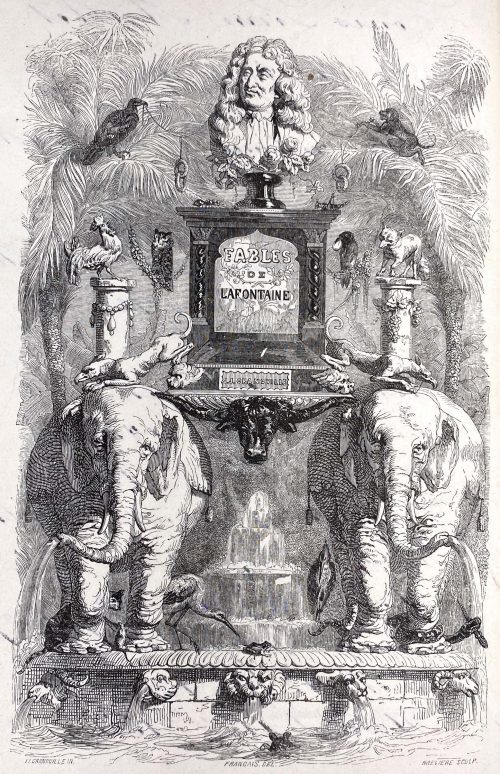 Fables de La Fontaine / édition illustrée par J. J. Grandville (in 2 volumes). – Paris: H. Fournier Ainé, Perronin, 1838. Imp. H. Fournier et Ce, 14 rue de Seine (Premier Tirage). Vol 1: [2 - ht, imprim.] [2 - blank with handwritten inscription, frontis.] [2 - t.p., blank], [ [i] ii-xxviii - épitre, préface, [2 - plate 'fables', [1] 2 - dedication, [3, 4 - pltate: livre 1, blank] [5, 6 - plate: blank, cigale] [7] 8 - fab.1 (the subsequent plates are not paginated) - 292. (245-246 - Avertissement), (247-248 - A mamdam de Montespan); Wood engravings: frontispiece + half-title Fables + 7 running half-titles Livres des Fables + 72 plates. Vol. 2: [2 - ht, imprim.] [2 - t.p., blank] [1, 2 - plate 'livre 8', blank] [3] 4-312 (191-192 épilogue), (195-196 Au duc de Bourgogne), (268 - fin des fables), (269-296 Philemon et Baucis | D. O. M. | La Martone Déphèse | Belphegor), (297 -308 notice), (309-312 table); Wood engravings: 5 running half-titles Livres des Fables + 1 half-title Philemon et Baucis + 48 plates. Size: 8vo, 23.2 x 15 cm. Binding: Full tree-calf, flat spine stamped with gilt, red and brown labels with gilt lettering, marbled endpapers. Handwritten nut ink inscription to blank recto of frontispiece: the history of Millet-Fontaine family (provenance?) There were two print-runs in the year 1838. According to Léopold Carteret (Le trésor du bibliophile. Epoque romantique. 1801-1875 / Livres illustrés du XIXe siècle. – Paris: L. Carteret; imprim. Lahure, 1927, pp. 357-9), the first run (Premier Tirage) published by H. Fournier and Perrotin, while the Second Tirage by H. Fournier Ainé. Though, the initial cap character "N" at p. xiii (vie d'Ésope) in this copy is formed by 'faite de lignes bouclées' as in the first print-run, rather than by 'petits carreaux noirs et blances' as in the second. We can conclude with confidence that this copy belongs to Premier Tirage.
Fables de La Fontaine / édition illustrée par J. J. Grandville (in 2 volumes). – Paris: H. Fournier Ainé, Perronin, 1838. Imp. H. Fournier et Ce, 14 rue de Seine (Premier Tirage). Vol 1: [2 - ht, imprim.] [2 - blank with handwritten inscription, frontis.] [2 - t.p., blank], [ [i] ii-xxviii - épitre, préface, [2 - plate 'fables', [1] 2 - dedication, [3, 4 - pltate: livre 1, blank] [5, 6 - plate: blank, cigale] [7] 8 - fab.1 (the subsequent plates are not paginated) - 292. (245-246 - Avertissement), (247-248 - A mamdam de Montespan); Wood engravings: frontispiece + half-title Fables + 7 running half-titles Livres des Fables + 72 plates. Vol. 2: [2 - ht, imprim.] [2 - t.p., blank] [1, 2 - plate 'livre 8', blank] [3] 4-312 (191-192 épilogue), (195-196 Au duc de Bourgogne), (268 - fin des fables), (269-296 Philemon et Baucis | D. O. M. | La Martone Déphèse | Belphegor), (297 -308 notice), (309-312 table); Wood engravings: 5 running half-titles Livres des Fables + 1 half-title Philemon et Baucis + 48 plates. Size: 8vo, 23.2 x 15 cm. Binding: Full tree-calf, flat spine stamped with gilt, red and brown labels with gilt lettering, marbled endpapers. Handwritten nut ink inscription to blank recto of frontispiece: the history of Millet-Fontaine family (provenance?) There were two print-runs in the year 1838. According to Léopold Carteret (Le trésor du bibliophile. Epoque romantique. 1801-1875 / Livres illustrés du XIXe siècle. – Paris: L. Carteret; imprim. Lahure, 1927, pp. 357-9), the first run (Premier Tirage) published by H. Fournier and Perrotin, while the Second Tirage by H. Fournier Ainé. Though, the initial cap character "N" at p. xiii (vie d'Ésope) in this copy is formed by 'faite de lignes bouclées' as in the first print-run, rather than by 'petits carreaux noirs et blances' as in the second. We can conclude with confidence that this copy belongs to Premier Tirage.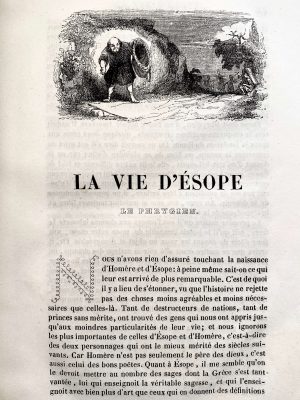 Wood engravings (135 plates, including frontispiece, and numerous headpieces and initial letters) were cut by the following artists (the first number is the number of the chapter ('livre'), the second – the number of the fable within the 'livre':
Wood engravers:
John Bastin, (British, fl. 1840 – 1850): 6-6, 7-13, and 8-9.
Alexandre Belhatte (French, born in 1811): 3-11 and chapter title pages to 'livres' 6, 11, 12, headpices on p. 117 in vol. 2, and 'Philemon et Baucis' section title page.
J. Constantine Beneworth (active France, 19th century): 1-6.
Louis-Henri Brévière (French, 1797 – 1869): 1-10, 2-7, 6-10, 6-21, 7-4, 8-10, 8-27, 9-3, 10-4, 12-11, frontispice, together with François-Louis Français (French, 1814–1897), and 'Fin des fables' tailpiece.
Brévière et Hébert: Louis-Henri Brévière (French, 1797 – 1869) and César-Auguste Hébert (French, active 19th century): 1-1, 1-2, 1-13, 1-18, 2-2, 2-11, 3-1, 3-3, 3-4, 3-18, 4-20, 4-21, 4-22, 5-5, 5-20, 6-2, 6-8, 7-3, 8-7, 8-12, 8-14, 8-17, 9-14, 10-6, 10-16, 11-6, 12-4, 12-25.
Joseph-Hippolyte-Jules Caqué (French, 1814 – 1885): 7-11 and headpieces on p. 251 in vol. 1 and on p. 197 in vol. 2.
Prosper-Adolphe-Léon Cherrier (French, born 1806): 8-6.
Henry Isidore Chevauchet (French, fl. 1837 – 1850): 1-19, 2-4, and 4-5.
Louis Dujardin (French, 1808 – 1859): 10-9.
Pierre-François Godard (French, 1768 – 1838): 1-5, 1-16, 5-2, and 10-11.
Charles David Laing (British, fl. 1836 – 1853): 7-9.
Lacoste père et fils aîné et Auguste-Alexandre Guillaumot (French, 1815 – 1892): 1-4, 1-20, 9-17, and 11-5.
Laisné (Alfred, Adèle, and Aglaé) (French, active 1835–1868): 5-8, 6-5, 6-17, 8-2, 8-15, 9-9, 9-10, 11-1, 11-8, 12-10.
(Alfred, Adèle, and Aglaé) Laisné (French, active 1835–1868): 5-8, 6-5, 6-17, 8-2, 8-15, 9-9, 9-10, 11-1, 11-8, 12-10.
Théodore Maurisset (French, fl. 1834 – 1859): 2-14 and 6-13.
Antoine-Alphée Piaud (French, 1813 – 1867): 1-17, 2-9, 2-16, 4-1, 4-4, 5-15, 5-17, 5-18, 5-21, 8-22, 8-23, 8-25, 9-19, 10-13, 11-3, 11-9, 12-13, 12-15, 12-21, three 'livres': 3, 9, 10, and headpiece on p. 71 in vol. 2.
Roux-Jourdain: Two 'livre' title pages, 1 and 2.
John Orrin Smith (British, 1799 – 1843): 2-13, 2-18, 3-9, 3-14, 4-9, and 4-14.L. Chauchefoin (French): 2-3 and 5.13.
Matthew Urlwin Sears (British, 1799 – 1870): 10-1 and 12-9.
Monogram TM or MT (possibly for Théodore Maurisset): 6-16 and 10-3.
Monogram GO–> (possibly for Godard) : 5-3, 7-1, and 9-5.
Monogram B and BV: 4-11, 12-6, 'livre' 4, and headpieces on p. 1 in vol. 1 and on p. 167 in vol. 2.
Unsigned or with an illegible signature: "fables' section title, 1-3, 1-9, 3-5, 3-8, 4-15, 4-18, 5-10, 7-7, 7-16, 9-2, 9-4, 12-2, 12-3, 12-17, and two 'livre' title pages, 5 and 8.
Little is know about Matthew Urlwin Sears. He was a wood engraver of good reputation who is known to have worked in London in the early 1820s, Paris and Leipzig. Listed as "wood engraver" on records of the UK Printing Historical Society. Work The British Museum owns three of his earliest published works, engravings for Northcote's Fables (1828). He authored "Specimen of stereotype ornaments, 1825" which was reprinted as a facsimile in 1990 by the Printing Historical Society (London), with a foreword by James Mosley. He is mentioned by Pierre Gusman in "La Gravure sur Bois en France" (Paris, 1929). Laurent's Histoire de l'Empereur Napoleon, (1839) is one of many publications on which both Sears and his partner John Quartly worked, as well as numerous other engravers. His work appeared in "Aunt Effie's Rhymes" (1852) and "Uncle Tom's Cabin", by Harriet Beech Stowe (Edinburgh: Adam and Charles Black, 1853) [Claire-Juliette Beale, December 2009].
Wood engravings (135 plates, including frontispiece, and numerous headpieces and initial letters) were cut by the following artists (the first number is the number of the chapter ('livre'), the second – the number of the fable within the 'livre':
Wood engravers:
John Bastin, (British, fl. 1840 – 1850): 6-6, 7-13, and 8-9.
Alexandre Belhatte (French, born in 1811): 3-11 and chapter title pages to 'livres' 6, 11, 12, headpices on p. 117 in vol. 2, and 'Philemon et Baucis' section title page.
J. Constantine Beneworth (active France, 19th century): 1-6.
Louis-Henri Brévière (French, 1797 – 1869): 1-10, 2-7, 6-10, 6-21, 7-4, 8-10, 8-27, 9-3, 10-4, 12-11, frontispice, together with François-Louis Français (French, 1814–1897), and 'Fin des fables' tailpiece.
Brévière et Hébert: Louis-Henri Brévière (French, 1797 – 1869) and César-Auguste Hébert (French, active 19th century): 1-1, 1-2, 1-13, 1-18, 2-2, 2-11, 3-1, 3-3, 3-4, 3-18, 4-20, 4-21, 4-22, 5-5, 5-20, 6-2, 6-8, 7-3, 8-7, 8-12, 8-14, 8-17, 9-14, 10-6, 10-16, 11-6, 12-4, 12-25.
Joseph-Hippolyte-Jules Caqué (French, 1814 – 1885): 7-11 and headpieces on p. 251 in vol. 1 and on p. 197 in vol. 2.
Prosper-Adolphe-Léon Cherrier (French, born 1806): 8-6.
Henry Isidore Chevauchet (French, fl. 1837 – 1850): 1-19, 2-4, and 4-5.
Louis Dujardin (French, 1808 – 1859): 10-9.
Pierre-François Godard (French, 1768 – 1838): 1-5, 1-16, 5-2, and 10-11.
Charles David Laing (British, fl. 1836 – 1853): 7-9.
Lacoste père et fils aîné et Auguste-Alexandre Guillaumot (French, 1815 – 1892): 1-4, 1-20, 9-17, and 11-5.
Laisné (Alfred, Adèle, and Aglaé) (French, active 1835–1868): 5-8, 6-5, 6-17, 8-2, 8-15, 9-9, 9-10, 11-1, 11-8, 12-10.
(Alfred, Adèle, and Aglaé) Laisné (French, active 1835–1868): 5-8, 6-5, 6-17, 8-2, 8-15, 9-9, 9-10, 11-1, 11-8, 12-10.
Théodore Maurisset (French, fl. 1834 – 1859): 2-14 and 6-13.
Antoine-Alphée Piaud (French, 1813 – 1867): 1-17, 2-9, 2-16, 4-1, 4-4, 5-15, 5-17, 5-18, 5-21, 8-22, 8-23, 8-25, 9-19, 10-13, 11-3, 11-9, 12-13, 12-15, 12-21, three 'livres': 3, 9, 10, and headpiece on p. 71 in vol. 2.
Roux-Jourdain: Two 'livre' title pages, 1 and 2.
John Orrin Smith (British, 1799 – 1843): 2-13, 2-18, 3-9, 3-14, 4-9, and 4-14.L. Chauchefoin (French): 2-3 and 5.13.
Matthew Urlwin Sears (British, 1799 – 1870): 10-1 and 12-9.
Monogram TM or MT (possibly for Théodore Maurisset): 6-16 and 10-3.
Monogram GO–> (possibly for Godard) : 5-3, 7-1, and 9-5.
Monogram B and BV: 4-11, 12-6, 'livre' 4, and headpieces on p. 1 in vol. 1 and on p. 167 in vol. 2.
Unsigned or with an illegible signature: "fables' section title, 1-3, 1-9, 3-5, 3-8, 4-15, 4-18, 5-10, 7-7, 7-16, 9-2, 9-4, 12-2, 12-3, 12-17, and two 'livre' title pages, 5 and 8.
Little is know about Matthew Urlwin Sears. He was a wood engraver of good reputation who is known to have worked in London in the early 1820s, Paris and Leipzig. Listed as "wood engraver" on records of the UK Printing Historical Society. Work The British Museum owns three of his earliest published works, engravings for Northcote's Fables (1828). He authored "Specimen of stereotype ornaments, 1825" which was reprinted as a facsimile in 1990 by the Printing Historical Society (London), with a foreword by James Mosley. He is mentioned by Pierre Gusman in "La Gravure sur Bois en France" (Paris, 1929). Laurent's Histoire de l'Empereur Napoleon, (1839) is one of many publications on which both Sears and his partner John Quartly worked, as well as numerous other engravers. His work appeared in "Aunt Effie's Rhymes" (1852) and "Uncle Tom's Cabin", by Harriet Beech Stowe (Edinburgh: Adam and Charles Black, 1853) [Claire-Juliette Beale, December 2009]. -
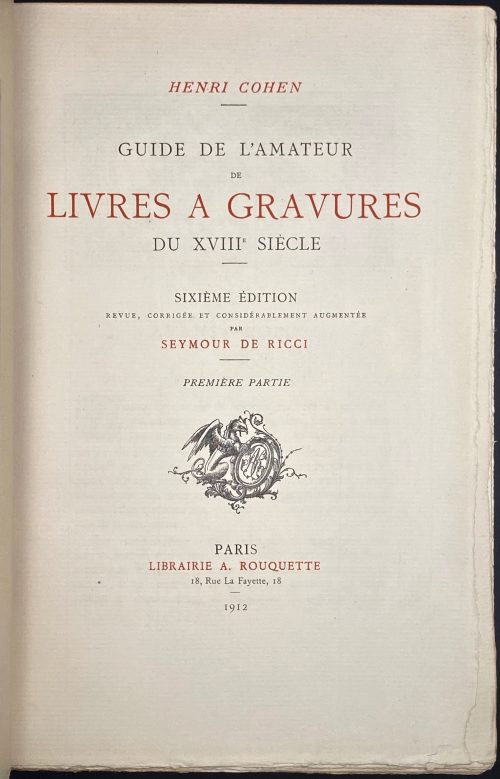 Herni Cohen. Guide de l'amateur de livres à gravures du XVIIIe siècle (6e édition) / Revue, corrigée et considérablement augmentée par Seymour de Ricci, préface par R. Portalis; 2 Volumes. – Paris: Librairie A. Rouquette, 1912. – Achevé d'Imprimer à Melun par Émile Legrand le 25 juin MDCCCCXII [1912]. Vol. 1, Première partie – ABAA-LUY: ffl [4 blanks] [2 - orig. grey front wrapper w/title, verso blank] [2 blanks] [2 - ht, tirage] [2 - blank, frontis. w/protect. sheet] [2 - blank, frontis. w/protect. sheet] (double frontis. - correct), [2 - t.p., blank] [i - avant-propos w/vignette] ii-vi, [vii - préface w/vignette] viii-xxvi; [1-2 - Tome 1, I] 2-668 (two numbers per page), [2 - fin, blank] [2 blanks] [2 - orig. grey back wrapper, recto blank] [orig. spine strip] [4 blanks] bfl. Vol. 2, Seconde partie – MAB-ZUR : ffl [4 blanks] [2 - orig. grey front wrapper w/title, verso blank] [2 blanks] [2 - ht, blank] [2 - t.p., blank] [2 - blank, frontis. w/protect. sheet] [2 - blank, frontis. w/protect. sheet] (double frontis. - correct), [1-2 - Tome II, 22] 671-1248 (two numbers per page), [2 - printer, blank] [2 blanks] [2 - orig. grey back wrapper, recto imprim.] [orig. spine strip] [4 blanks] bfl. Size: Super Royal 8vo, 26.2 x 17.2 x 5.1 cm. Binding: Contemporary blue half morocco over marbled boards, marbled end-papers, top margin gilt, gilt lettering to spine (title, owner: P. R.).; bookplate pasted to verso of the first blank leaf: " Ex Libris R. Decamps Scrive." – for bibliophile René Descamps-Scrive (French, 1853 –1924). Original wrappers preserved. Printed on Hollande paper, copy № 2 of the first 50; total print-run 1050 copies. Catalogue raisonné of French illustrated books of the 18th century.
Herni Cohen. Guide de l'amateur de livres à gravures du XVIIIe siècle (6e édition) / Revue, corrigée et considérablement augmentée par Seymour de Ricci, préface par R. Portalis; 2 Volumes. – Paris: Librairie A. Rouquette, 1912. – Achevé d'Imprimer à Melun par Émile Legrand le 25 juin MDCCCCXII [1912]. Vol. 1, Première partie – ABAA-LUY: ffl [4 blanks] [2 - orig. grey front wrapper w/title, verso blank] [2 blanks] [2 - ht, tirage] [2 - blank, frontis. w/protect. sheet] [2 - blank, frontis. w/protect. sheet] (double frontis. - correct), [2 - t.p., blank] [i - avant-propos w/vignette] ii-vi, [vii - préface w/vignette] viii-xxvi; [1-2 - Tome 1, I] 2-668 (two numbers per page), [2 - fin, blank] [2 blanks] [2 - orig. grey back wrapper, recto blank] [orig. spine strip] [4 blanks] bfl. Vol. 2, Seconde partie – MAB-ZUR : ffl [4 blanks] [2 - orig. grey front wrapper w/title, verso blank] [2 blanks] [2 - ht, blank] [2 - t.p., blank] [2 - blank, frontis. w/protect. sheet] [2 - blank, frontis. w/protect. sheet] (double frontis. - correct), [1-2 - Tome II, 22] 671-1248 (two numbers per page), [2 - printer, blank] [2 blanks] [2 - orig. grey back wrapper, recto imprim.] [orig. spine strip] [4 blanks] bfl. Size: Super Royal 8vo, 26.2 x 17.2 x 5.1 cm. Binding: Contemporary blue half morocco over marbled boards, marbled end-papers, top margin gilt, gilt lettering to spine (title, owner: P. R.).; bookplate pasted to verso of the first blank leaf: " Ex Libris R. Decamps Scrive." – for bibliophile René Descamps-Scrive (French, 1853 –1924). Original wrappers preserved. Printed on Hollande paper, copy № 2 of the first 50; total print-run 1050 copies. Catalogue raisonné of French illustrated books of the 18th century. -
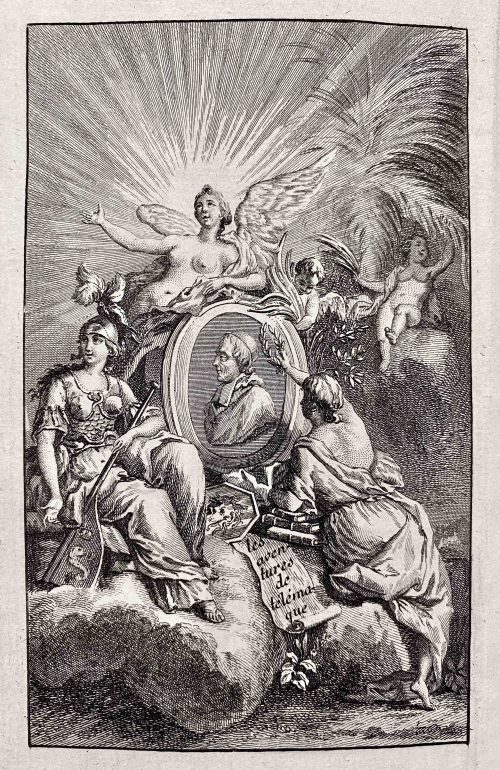 Les Aventures de Télémaque, fils d'Ulysse, Par feu Messire François de Salignac de la Mothe-Fénelon, Précepteur de Messeigneurs les Enfants de France, & depuis Archevêque - Duc de Chabray, Prince du Saint-Empire Romain, &c. / Nouvelle édition enrichie de figures en taille-douce. – À Maestricht, Chez J. E. Dufour & Ph. Roux, Imprimeurs-Libraires associés. M. DCC. LXXXII. Pagination: ffl, [i, ii - ht, explication] [2 - blank, frontis. portrait] [iii, iv - t.p., blank] [v - discours] vi-xxviii, [1] 2-484, bfl; 1 folding map and 24 plates engraved by Jean-Baptiste-Pierre Tardieu. Size: 8vo, 21 x 13 cm. Binding: full contemporary mottled calf, marbled end-papers, all margins red, raised bands, floral gilt elements in compartments, red title label, head- and tail-band absent. Point of issue: the vignette in Liv. 1 is upsidedown. Liv. 1 & 8 plates signed: Gravé par Tardieu résident à Malines. Jean Baptiste Pierre Tardieu (French, 1746 – 1816) - engraver and cartographer from a large family of artists and engravers. For English translation of this book see № LIB-2683-2021 in this collection.
Les Aventures de Télémaque, fils d'Ulysse, Par feu Messire François de Salignac de la Mothe-Fénelon, Précepteur de Messeigneurs les Enfants de France, & depuis Archevêque - Duc de Chabray, Prince du Saint-Empire Romain, &c. / Nouvelle édition enrichie de figures en taille-douce. – À Maestricht, Chez J. E. Dufour & Ph. Roux, Imprimeurs-Libraires associés. M. DCC. LXXXII. Pagination: ffl, [i, ii - ht, explication] [2 - blank, frontis. portrait] [iii, iv - t.p., blank] [v - discours] vi-xxviii, [1] 2-484, bfl; 1 folding map and 24 plates engraved by Jean-Baptiste-Pierre Tardieu. Size: 8vo, 21 x 13 cm. Binding: full contemporary mottled calf, marbled end-papers, all margins red, raised bands, floral gilt elements in compartments, red title label, head- and tail-band absent. Point of issue: the vignette in Liv. 1 is upsidedown. Liv. 1 & 8 plates signed: Gravé par Tardieu résident à Malines. Jean Baptiste Pierre Tardieu (French, 1746 – 1816) - engraver and cartographer from a large family of artists and engravers. For English translation of this book see № LIB-2683-2021 in this collection. -
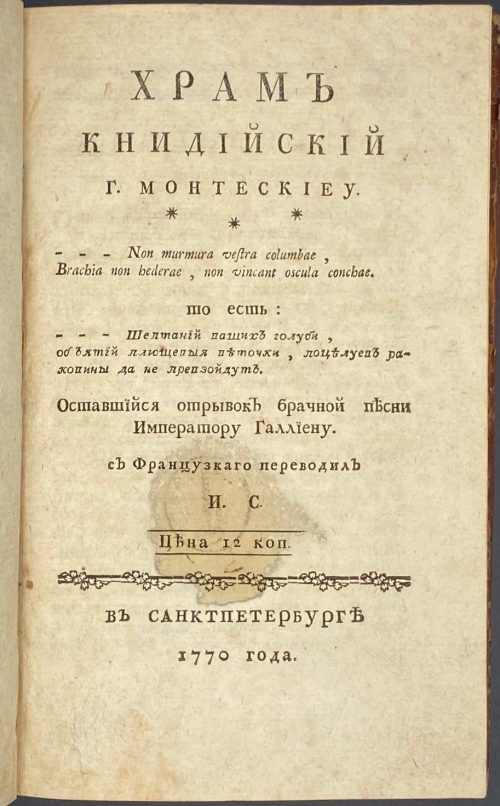 Шарль Монтескье. Храм Книдийский (пер. Иван Сичкарев). Лисимах. Разговор Суллы с Эвкратом. Опыт о вкусе (пер. Семён Башилов). — СПб.: [Тип. Акад. наук], 1770. Pagination: [2 blank] [2 t.p. храм, blank] [4 preface] [1] 2-72, [1, 2 t.p. лисимах, blank] [1] 2-12 [13, 14 t.p. силла] 16-33, [34 blank] [35, 37 t.p. опыт, blank] 38-95 [96 errata] [2 blank]. Size: 12mo, 20 x 12.5 cm, Binding: Contemporary polished brown slightly stained calf, gilt-ruled borders, flat spine with gilt bands and tools in compartments, black title label with gilt lettering to spine, marbled end-papers. Inscriptions and marks: Ink hand-writing to ff: "Люб. Дубенская, Москва XII 1931"; "Ленкнигторг" label glued to the recto of back free leaf; "Антикварная торговля В. И. Клочкова. СПБ., Литейный 55" label pasted to back pastedown. Printed on laid paper with "key" image printed on recto and protruding to the verso to t.p. of Храм Книдийский and Лисимах. Imperial orthography. Engraved head and tailpieces.
Шарль Монтескье. Храм Книдийский (пер. Иван Сичкарев). Лисимах. Разговор Суллы с Эвкратом. Опыт о вкусе (пер. Семён Башилов). — СПб.: [Тип. Акад. наук], 1770. Pagination: [2 blank] [2 t.p. храм, blank] [4 preface] [1] 2-72, [1, 2 t.p. лисимах, blank] [1] 2-12 [13, 14 t.p. силла] 16-33, [34 blank] [35, 37 t.p. опыт, blank] 38-95 [96 errata] [2 blank]. Size: 12mo, 20 x 12.5 cm, Binding: Contemporary polished brown slightly stained calf, gilt-ruled borders, flat spine with gilt bands and tools in compartments, black title label with gilt lettering to spine, marbled end-papers. Inscriptions and marks: Ink hand-writing to ff: "Люб. Дубенская, Москва XII 1931"; "Ленкнигторг" label glued to the recto of back free leaf; "Антикварная торговля В. И. Клочкова. СПБ., Литейный 55" label pasted to back pastedown. Printed on laid paper with "key" image printed on recto and protruding to the verso to t.p. of Храм Книдийский and Лисимах. Imperial orthography. Engraved head and tailpieces. -
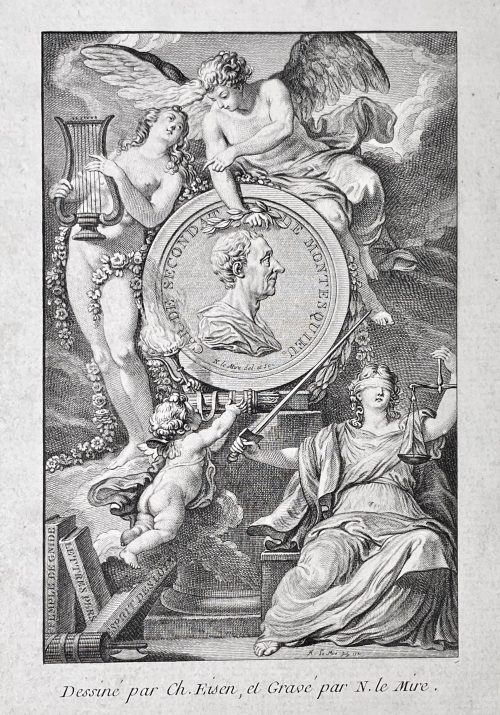 Hardcover volume, 8vo, 24.3 x 16.5 cm, bound in contemporary full marbled calf, spine with raised bands, gilt floral tools in compartments, gilt title lettering, marbled end-papers and all edges, printed on laid paper 23.9 x 5.5 cm with a watermark, entirely engraved (frontispiece, title, nine plates, and text), gatherings not indicated. Title-page (engraved, vignette, tall 's') LE | TEMPLE | DE | GNIDE | Nouvelle Edition, | Avec Figures | Gravées par N. LE MIRE, | des Acad. De Vienne en Autriche et de Rouen, | D’apres les Dessins de Ch. Eisen. | Le Texte Gravé par Droüet. | — | {3 lines quotation from Gallien} | A PARIS | Chez le Mire Graveur | Rue St. Etienne des Gres. | AVEC PRIVELEGE DU ROI. | 1772. || Frontispiece (engraved, vignette): Portrait medallion inscribed "CHARLES SECONDAT DE MONTESQUIEU — N. Le Mire del et sc", signed beneath "N. le Mire sculp 1771"; under the plate: "Dessiné par Ch. Eisen, et Gravé par N. le Mire." Pagination: frontispiece, t.p. / explication, dedication, [i] ii-vii [viii blank] 1-104 [105-6 blanks]; engraved throughout, plus 9 plates by Le Mire after Eisen.Catalogue Raisonné: Cohen-de Ricci 726-27; Ray, French Illustrated Book, №32/p. 61-2.Ref.: MFA (Boston): Accession Number 37.1726.Charles Eisen (French, 1720 – 1778) – artist. Noël Le Mire (French, 1724 – 1801) – engraver, publisher. Droüet (French, 18th century) – text engraver. Charles Louis de Secondat, Baron de La Brède et de Montesquieu (French, 1689 – 1755) – author.
Hardcover volume, 8vo, 24.3 x 16.5 cm, bound in contemporary full marbled calf, spine with raised bands, gilt floral tools in compartments, gilt title lettering, marbled end-papers and all edges, printed on laid paper 23.9 x 5.5 cm with a watermark, entirely engraved (frontispiece, title, nine plates, and text), gatherings not indicated. Title-page (engraved, vignette, tall 's') LE | TEMPLE | DE | GNIDE | Nouvelle Edition, | Avec Figures | Gravées par N. LE MIRE, | des Acad. De Vienne en Autriche et de Rouen, | D’apres les Dessins de Ch. Eisen. | Le Texte Gravé par Droüet. | — | {3 lines quotation from Gallien} | A PARIS | Chez le Mire Graveur | Rue St. Etienne des Gres. | AVEC PRIVELEGE DU ROI. | 1772. || Frontispiece (engraved, vignette): Portrait medallion inscribed "CHARLES SECONDAT DE MONTESQUIEU — N. Le Mire del et sc", signed beneath "N. le Mire sculp 1771"; under the plate: "Dessiné par Ch. Eisen, et Gravé par N. le Mire." Pagination: frontispiece, t.p. / explication, dedication, [i] ii-vii [viii blank] 1-104 [105-6 blanks]; engraved throughout, plus 9 plates by Le Mire after Eisen.Catalogue Raisonné: Cohen-de Ricci 726-27; Ray, French Illustrated Book, №32/p. 61-2.Ref.: MFA (Boston): Accession Number 37.1726.Charles Eisen (French, 1720 – 1778) – artist. Noël Le Mire (French, 1724 – 1801) – engraver, publisher. Droüet (French, 18th century) – text engraver. Charles Louis de Secondat, Baron de La Brède et de Montesquieu (French, 1689 – 1755) – author. -
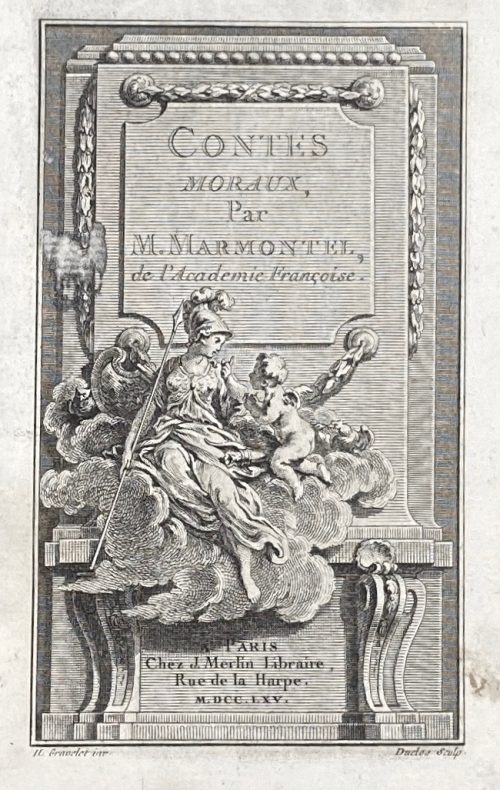 Engraved title-page: Contes | Moraux | Par | M. Marmontel, | de l'Academie Françoise. | A Paris | Chez J. Merlin Libraire, | Rue de la Harpe, | M DCC LXV ||Description: 3 volumes, 8vo, 20.4 x 13 cm, first issue, bound in the contemporary speckled calf, all edges gilt, spines gilt with double red/brown lettering labels (vol 1. labels missing); raised bands, gilt in compartments, double gilt-ruled borders; marbled endpapers. With the contemporary signature in each volume of Caroline Marlborough of Blenheim Palace, and bookplates of Lord F. A. Spencer. This is certainly Lady Caroline Russell, wife of George Spencer, Fourth Duke of Marlborough; she was daughter to the Duke of Bedford and was married in 1762. She died at Blenheim in 1811. The later bookplate in each volume pasted to the front pastedown of her son Francis Almeric Spencer (British, 1779-1845). Pagination: Vol. I: [two blank leaves] [half-title, verso blank] [recto blank, frontispiece on verso: portrait of Marmontel by St. Aubin after Cochin] [engraved t.p. by Duclos after Gravelot, verso blank], [i] ii-xvi, [table des contes with 5-line Errata (autograph Lordine Marlborough), verso blank], [1] 2–345 [346-50 blanks]; 9 plates after Gravelot by: Baquoy, de Longueil (2), Legrand, Leveau (2), Rousseau, Voyez, and unsigned (1). Vol. 2: [two blank leaves] [half-title, verso blank] [engraved t.p. by Duclos after Gravelot, verso blank] [table des contes with 10-line Errata (autograph Lordine Marlborough), verso blank], [1] 2–376 [377-50 blanks]; 9 plates after Gravelot by: de Longueil (5), Leveau (2), Pasquier and Rousseau. Vol. 3: [two blank leaves] [half-title, verso blank] [engraved t.p. by Duclos after Gravelot, verso blank] [table des contes with 9-line Errata, verso blank] [two leaves: approbation and Privilege du Roi] [1] 2–312 [313-16 blanks]; 5 plates after Gravelot by: de Longueil (2), Le Mire (2), and Pasquier. Catalogue raisonné: Cohen-De Ricci 686-7; Gordon N. Ray. The Art of the French Illustrated Book 1700 to 1914. — NY, London: The Pierpont Morgan Library; Cornell University Press, 1982, Vol. 1. pp. 44-5. [In their copy vol. 2 and 3 in a different order]; MFA ACCESSION NUMBER 37.1488a-c Illustrated by: Hubert François Gravelot (French, 1699–1773) Engraved by: Jean Charles Baquoy (French, 1721–1777) Engraved by: Antoine Jean Duclos (French, 1742–1795) Engraved by: Louis Legrand (French, 1723–1807) Engraved by: Noël Le Mire (French, 1724–1801) Engraved by: Jean Jacques André Le Veau (French, 1729–1785) Engraved by: Joseph de Longueil (French, 1730–1792) Engraved by: Jean Jacques Pasquier (French, died in 1785) Engraved by: Jean François Rousseau (French, born in 1740) Engraved by: Nicolas Joseph Voyez l'ainé (French, 1742–1806) Portrait(s) designed by: Charles-Nicolas Cochin le fils (French, 1715–1790) Engraved by: Augustin de Saint-Aubin (French, 1736–1807) Author: Jean-François Marmontel (French, 1723–1799) Publisher: Joseph Merlin (French, 1718–1783) Printer: Pierre-Alexandre Le Prieur (French, born in 1722)
Engraved title-page: Contes | Moraux | Par | M. Marmontel, | de l'Academie Françoise. | A Paris | Chez J. Merlin Libraire, | Rue de la Harpe, | M DCC LXV ||Description: 3 volumes, 8vo, 20.4 x 13 cm, first issue, bound in the contemporary speckled calf, all edges gilt, spines gilt with double red/brown lettering labels (vol 1. labels missing); raised bands, gilt in compartments, double gilt-ruled borders; marbled endpapers. With the contemporary signature in each volume of Caroline Marlborough of Blenheim Palace, and bookplates of Lord F. A. Spencer. This is certainly Lady Caroline Russell, wife of George Spencer, Fourth Duke of Marlborough; she was daughter to the Duke of Bedford and was married in 1762. She died at Blenheim in 1811. The later bookplate in each volume pasted to the front pastedown of her son Francis Almeric Spencer (British, 1779-1845). Pagination: Vol. I: [two blank leaves] [half-title, verso blank] [recto blank, frontispiece on verso: portrait of Marmontel by St. Aubin after Cochin] [engraved t.p. by Duclos after Gravelot, verso blank], [i] ii-xvi, [table des contes with 5-line Errata (autograph Lordine Marlborough), verso blank], [1] 2–345 [346-50 blanks]; 9 plates after Gravelot by: Baquoy, de Longueil (2), Legrand, Leveau (2), Rousseau, Voyez, and unsigned (1). Vol. 2: [two blank leaves] [half-title, verso blank] [engraved t.p. by Duclos after Gravelot, verso blank] [table des contes with 10-line Errata (autograph Lordine Marlborough), verso blank], [1] 2–376 [377-50 blanks]; 9 plates after Gravelot by: de Longueil (5), Leveau (2), Pasquier and Rousseau. Vol. 3: [two blank leaves] [half-title, verso blank] [engraved t.p. by Duclos after Gravelot, verso blank] [table des contes with 9-line Errata, verso blank] [two leaves: approbation and Privilege du Roi] [1] 2–312 [313-16 blanks]; 5 plates after Gravelot by: de Longueil (2), Le Mire (2), and Pasquier. Catalogue raisonné: Cohen-De Ricci 686-7; Gordon N. Ray. The Art of the French Illustrated Book 1700 to 1914. — NY, London: The Pierpont Morgan Library; Cornell University Press, 1982, Vol. 1. pp. 44-5. [In their copy vol. 2 and 3 in a different order]; MFA ACCESSION NUMBER 37.1488a-c Illustrated by: Hubert François Gravelot (French, 1699–1773) Engraved by: Jean Charles Baquoy (French, 1721–1777) Engraved by: Antoine Jean Duclos (French, 1742–1795) Engraved by: Louis Legrand (French, 1723–1807) Engraved by: Noël Le Mire (French, 1724–1801) Engraved by: Jean Jacques André Le Veau (French, 1729–1785) Engraved by: Joseph de Longueil (French, 1730–1792) Engraved by: Jean Jacques Pasquier (French, died in 1785) Engraved by: Jean François Rousseau (French, born in 1740) Engraved by: Nicolas Joseph Voyez l'ainé (French, 1742–1806) Portrait(s) designed by: Charles-Nicolas Cochin le fils (French, 1715–1790) Engraved by: Augustin de Saint-Aubin (French, 1736–1807) Author: Jean-François Marmontel (French, 1723–1799) Publisher: Joseph Merlin (French, 1718–1783) Printer: Pierre-Alexandre Le Prieur (French, born in 1722) -
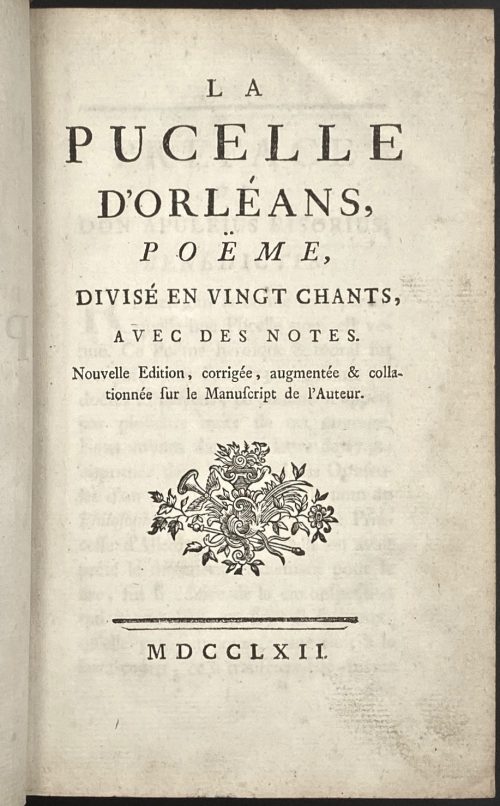 [François Marie Arouet de Voltaire]. La Pucelle d'Orléans, poëme, divisé en vingt chants, avec des notes. Nouvelle édition, corrigée, augmentée & collationnée sur le manuscript de l'auteur. – [Geneva: Gabriel Cramer], 1762.Illustrated book with 20 etchings and numerous woodcut vignettes.Illustrated by: Hubert-François Bourguignon, a.k.a. Gravelot (French, 1699–1773) Author: François Marie Arouet de Voltaire (French, 1694–1778) Printer: Gabriel Cramer (Swiss, 1723–1793)Pagination: [2 blanks, "Ex libris JCP" to recto] [2 - h.t., blank] [2 - t.p., blank], [i] ii-viii, [1] 2-358 [2 blanks]; 20 engraved plates, unsigned, one before every chant, by Gravelot (Hubert-François Bourguignon).Year of Publication: 1762Place of Publication: Geneva, SwitzerlandSize: 8vo, 19.8 x 12.6 x 3.7 cm.Binding: Full mottled calf, restored, flat spine, decorated in gilt, red labels with gilt lettering "Oeuvres de Voltaire; La Pucelle, tom XXII"; marbled endpapers and all margins.CATALOGUE RAISONNÉ: Cohen-de Ricci 1029.Mentions: MFA: ACCESSION NUMBER 25.701.Another copy in this collection: LIB-2580.2020.
[François Marie Arouet de Voltaire]. La Pucelle d'Orléans, poëme, divisé en vingt chants, avec des notes. Nouvelle édition, corrigée, augmentée & collationnée sur le manuscript de l'auteur. – [Geneva: Gabriel Cramer], 1762.Illustrated book with 20 etchings and numerous woodcut vignettes.Illustrated by: Hubert-François Bourguignon, a.k.a. Gravelot (French, 1699–1773) Author: François Marie Arouet de Voltaire (French, 1694–1778) Printer: Gabriel Cramer (Swiss, 1723–1793)Pagination: [2 blanks, "Ex libris JCP" to recto] [2 - h.t., blank] [2 - t.p., blank], [i] ii-viii, [1] 2-358 [2 blanks]; 20 engraved plates, unsigned, one before every chant, by Gravelot (Hubert-François Bourguignon).Year of Publication: 1762Place of Publication: Geneva, SwitzerlandSize: 8vo, 19.8 x 12.6 x 3.7 cm.Binding: Full mottled calf, restored, flat spine, decorated in gilt, red labels with gilt lettering "Oeuvres de Voltaire; La Pucelle, tom XXII"; marbled endpapers and all margins.CATALOGUE RAISONNÉ: Cohen-de Ricci 1029.Mentions: MFA: ACCESSION NUMBER 25.701.Another copy in this collection: LIB-2580.2020. -
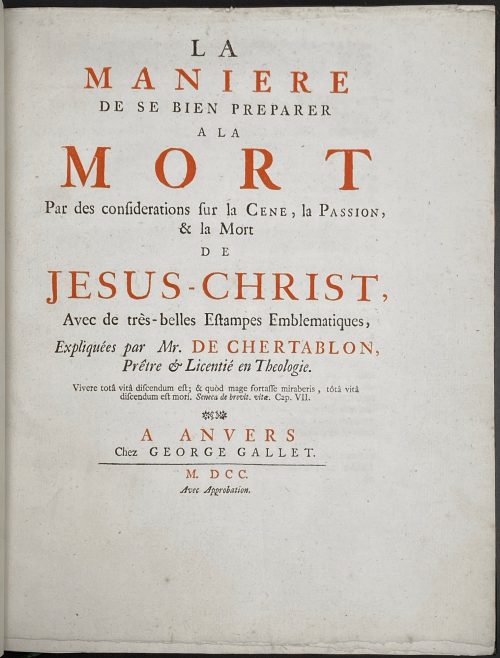 M. de Chertablon. La maniere de se bien preparer a la Mort par des Considerations sur la Cene, la Passion, et la Mort de Jesu-Christ. – Antwerp: George Gallet, 1700. Pagination: ff, [2 - blanks] [2 - t.p., blank] [3 - advert.] 4-63 [64]; 42 copper etched plates by Romeyn de Hooghe: A, B, C, 1-39; [20 - Dutch plate description of the David de la Vigne's Miroir de la bonne mort], bf. Full title: La maniere de se bien preparer a la Mort par des Considerations sur la Cene, la Passion, et la Mort de Jesu-Christ, Avec de très-belles Estampes Emblematiques, Expliquées par Mr. de Chertablon, Piêtre & Licentié en Theologie. Vivere totâ vitâ discendum est; & quòd mage fortasse miraberis, tôtâ vitâ discendum est mori. Seneca de brevit. vitæ. Cap. VII. A Anvers, Chez George Gallet. M DCC, Avec Approbation. / David de La Vigne. Spiegel om wel te sterven, annwyzende met beeltenissen van het lyden onses zaligmaakers Jesu Christi. Verzierd met 42 fyne Geërste Kopere Platen, Door Romain de Hooghe; Te Amsterdam, Voor dezen gedrukt by J. Stigter. Size: 4to, 27.2 x 21.6 cm. Binding: Late 19th century brown calf over marbled boards, spine with gilt lettering, raised bands, double fillet blind panels in compartments; marbled end-papers; bookplate of Samuel Ashton Thompson Yates library, AD 1894. Book illustrated with 42 copperplate etched engravings by Romeyn de Hooghe (Dutch, Amsterdam 1645–1708 Haarlem). According to Bonhams: the plates were "first printed for David de la Vigne's Miroir de la bonne mort. Each of the plates depicts a man contemplating a religious image in order to ease the passing of death, accompanied by commentary and an appropriate verse of scripture for each plate. The present French edition is bound with, as issued, the Dutch translation of David de La Vigne's aforementioned work."
M. de Chertablon. La maniere de se bien preparer a la Mort par des Considerations sur la Cene, la Passion, et la Mort de Jesu-Christ. – Antwerp: George Gallet, 1700. Pagination: ff, [2 - blanks] [2 - t.p., blank] [3 - advert.] 4-63 [64]; 42 copper etched plates by Romeyn de Hooghe: A, B, C, 1-39; [20 - Dutch plate description of the David de la Vigne's Miroir de la bonne mort], bf. Full title: La maniere de se bien preparer a la Mort par des Considerations sur la Cene, la Passion, et la Mort de Jesu-Christ, Avec de très-belles Estampes Emblematiques, Expliquées par Mr. de Chertablon, Piêtre & Licentié en Theologie. Vivere totâ vitâ discendum est; & quòd mage fortasse miraberis, tôtâ vitâ discendum est mori. Seneca de brevit. vitæ. Cap. VII. A Anvers, Chez George Gallet. M DCC, Avec Approbation. / David de La Vigne. Spiegel om wel te sterven, annwyzende met beeltenissen van het lyden onses zaligmaakers Jesu Christi. Verzierd met 42 fyne Geërste Kopere Platen, Door Romain de Hooghe; Te Amsterdam, Voor dezen gedrukt by J. Stigter. Size: 4to, 27.2 x 21.6 cm. Binding: Late 19th century brown calf over marbled boards, spine with gilt lettering, raised bands, double fillet blind panels in compartments; marbled end-papers; bookplate of Samuel Ashton Thompson Yates library, AD 1894. Book illustrated with 42 copperplate etched engravings by Romeyn de Hooghe (Dutch, Amsterdam 1645–1708 Haarlem). According to Bonhams: the plates were "first printed for David de la Vigne's Miroir de la bonne mort. Each of the plates depicts a man contemplating a religious image in order to ease the passing of death, accompanied by commentary and an appropriate verse of scripture for each plate. The present French edition is bound with, as issued, the Dutch translation of David de La Vigne's aforementioned work." -
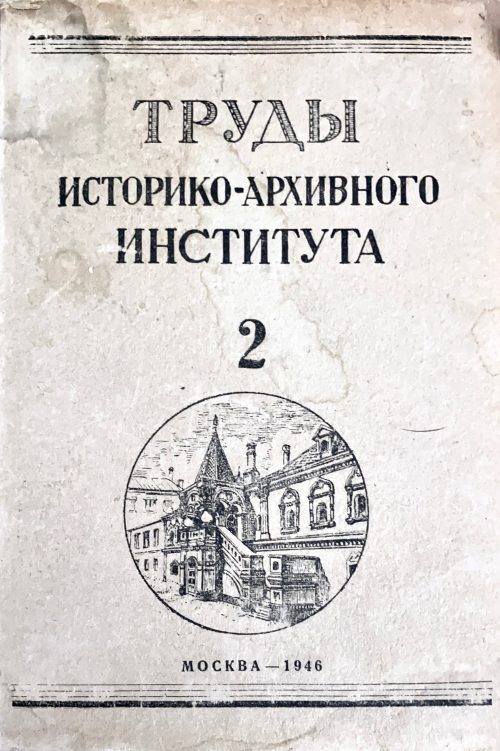 Елизавета Николаевна Данилова. "Завещание" Петра Великого / Под ред. Александр Игнатьевич Андреева. // В сборнике: Труды Историко-архивного института, том 2, 1946. (Кафедра вспомогательных исторических дисциплин). – с. 202-270. Москва: Главное архивное управление МВД Союза ССР. Историко-архивный институт, 1946. Тираж: 3000 экз.
Елизавета Николаевна Данилова. "Завещание" Петра Великого / Под ред. Александр Игнатьевич Андреева. // В сборнике: Труды Историко-архивного института, том 2, 1946. (Кафедра вспомогательных исторических дисциплин). – с. 202-270. Москва: Главное архивное управление МВД Союза ССР. Историко-архивный институт, 1946. Тираж: 3000 экз. -
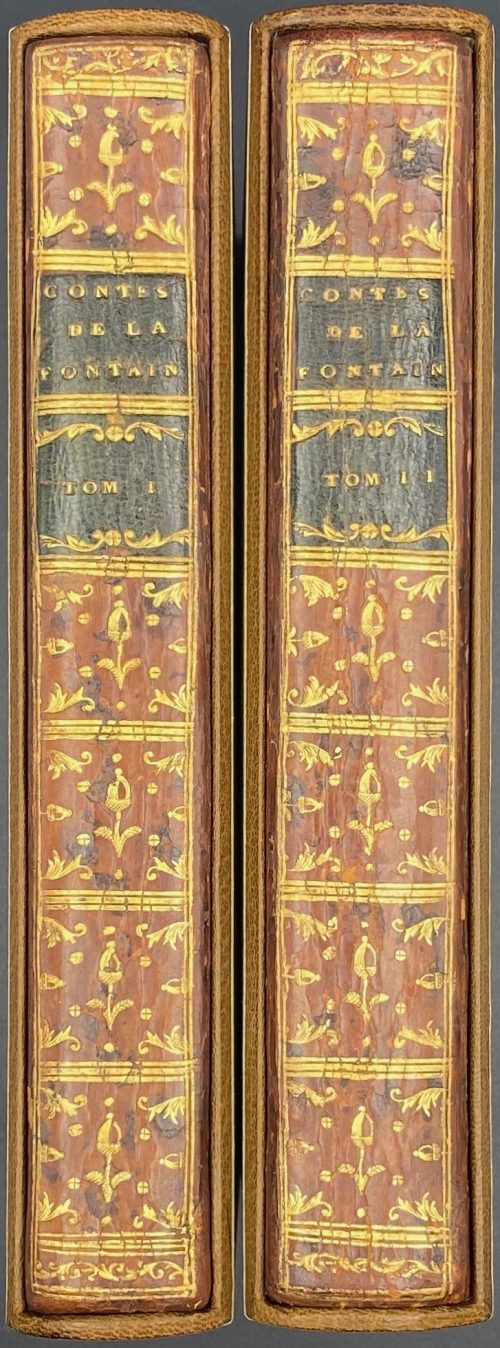 Two-volume edition, financed, arranged and managed by Fermiers généraux. Vol. 1. Title : CONTES | ET | NOUVELLES | EN VERS, | Par M. de La Fontaine. | TOME I. | {vignette} | A AMSTERDAM. | — | M. DCC. LXII. || Pagination: [2] – blanks [i, ii] – h.t. / blank, [iii, iv] – t.p. / blank, v-xiv, [1] 2–268 [269-70] – table, [4] – blanks, plus frontispiece by Fiquet after Rigault, t.p. vignette, vignette, headpiece, and 23 tailpieces by Choffard, 39 plates by various engravers after Charles Eisen. Vol. 2. Title: same but TOME II. Pagination: [2] – blanks] [i, ii] – h.t. / blank, [iii] iv-viii [1] 2–306 [307-10] – épitaphe / table, [4] – blanks, plus frontispiece by Fiquet after Vispré, t.p. vignette, vignette, headpiece, and 29 tailpieces by Choffard, and 42 plates after Charles Eisen (Ray only cite 41 plates). Binding: 2 volumes, 19.8 x 12.2 each, uniformly bound in full Spanish mottled calf, boards triple ruled in gilt, flat spine with triple bands, double ruled and tooled in gilt, black title labels lettered in gilt, all margins gilt, marbled end-papers, in cardboard slipcases, openings leathered. In vol. 1 a manuscript plate 4.8 x 8.2 cm pasted to page [1]: "Cette Édition est très rare n’y ayant | eu que 30 Exemplaires de livres, ou la figure principale dans le Cas de Conscience page 143 Tom 2 est nud tandis que dans les autres Éditions cette Figure est voilée par un feuillage".
Two-volume edition, financed, arranged and managed by Fermiers généraux. Vol. 1. Title : CONTES | ET | NOUVELLES | EN VERS, | Par M. de La Fontaine. | TOME I. | {vignette} | A AMSTERDAM. | — | M. DCC. LXII. || Pagination: [2] – blanks [i, ii] – h.t. / blank, [iii, iv] – t.p. / blank, v-xiv, [1] 2–268 [269-70] – table, [4] – blanks, plus frontispiece by Fiquet after Rigault, t.p. vignette, vignette, headpiece, and 23 tailpieces by Choffard, 39 plates by various engravers after Charles Eisen. Vol. 2. Title: same but TOME II. Pagination: [2] – blanks] [i, ii] – h.t. / blank, [iii] iv-viii [1] 2–306 [307-10] – épitaphe / table, [4] – blanks, plus frontispiece by Fiquet after Vispré, t.p. vignette, vignette, headpiece, and 29 tailpieces by Choffard, and 42 plates after Charles Eisen (Ray only cite 41 plates). Binding: 2 volumes, 19.8 x 12.2 each, uniformly bound in full Spanish mottled calf, boards triple ruled in gilt, flat spine with triple bands, double ruled and tooled in gilt, black title labels lettered in gilt, all margins gilt, marbled end-papers, in cardboard slipcases, openings leathered. In vol. 1 a manuscript plate 4.8 x 8.2 cm pasted to page [1]: "Cette Édition est très rare n’y ayant | eu que 30 Exemplaires de livres, ou la figure principale dans le Cas de Conscience page 143 Tom 2 est nud tandis que dans les autres Éditions cette Figure est voilée par un feuillage".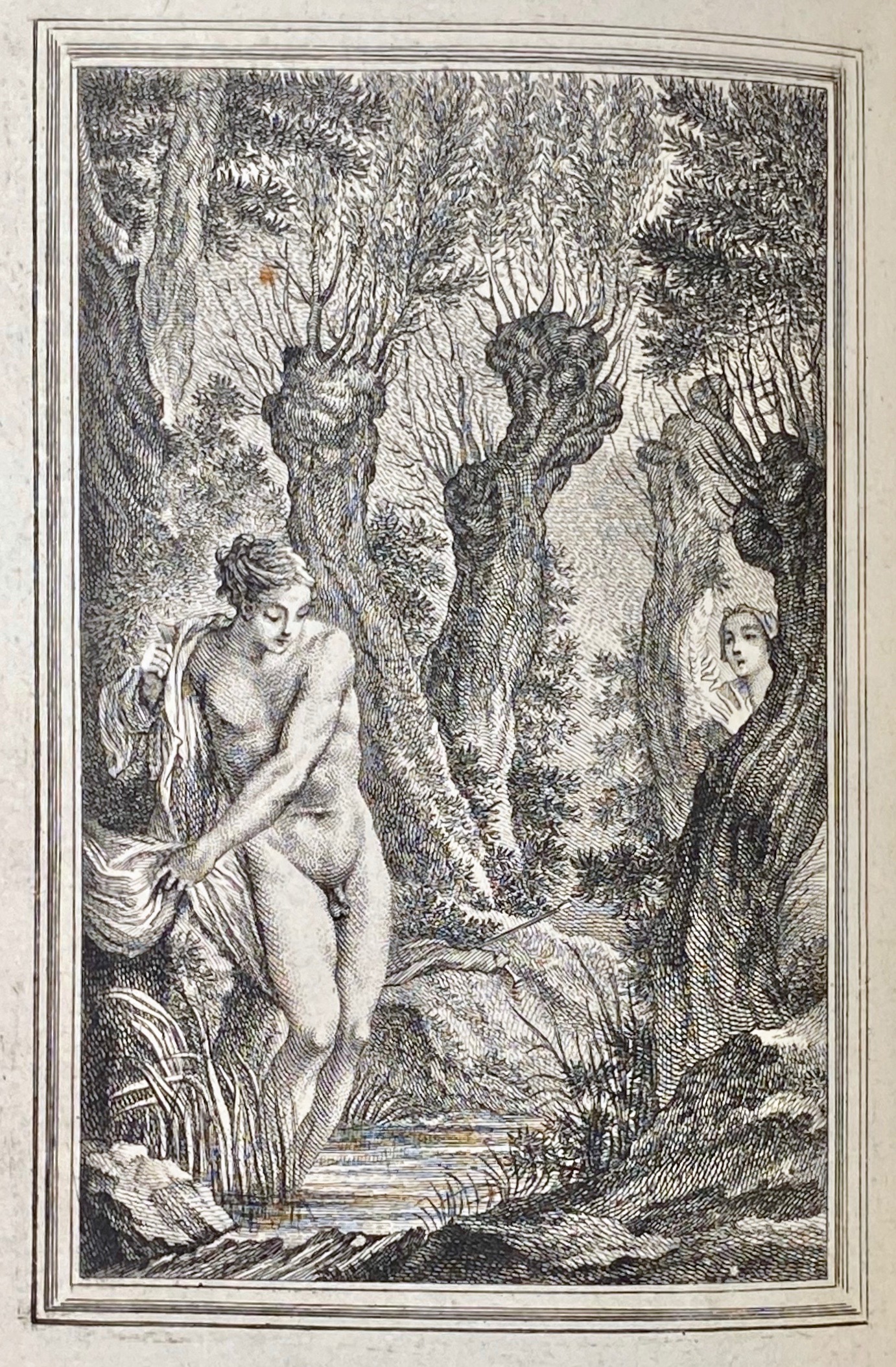
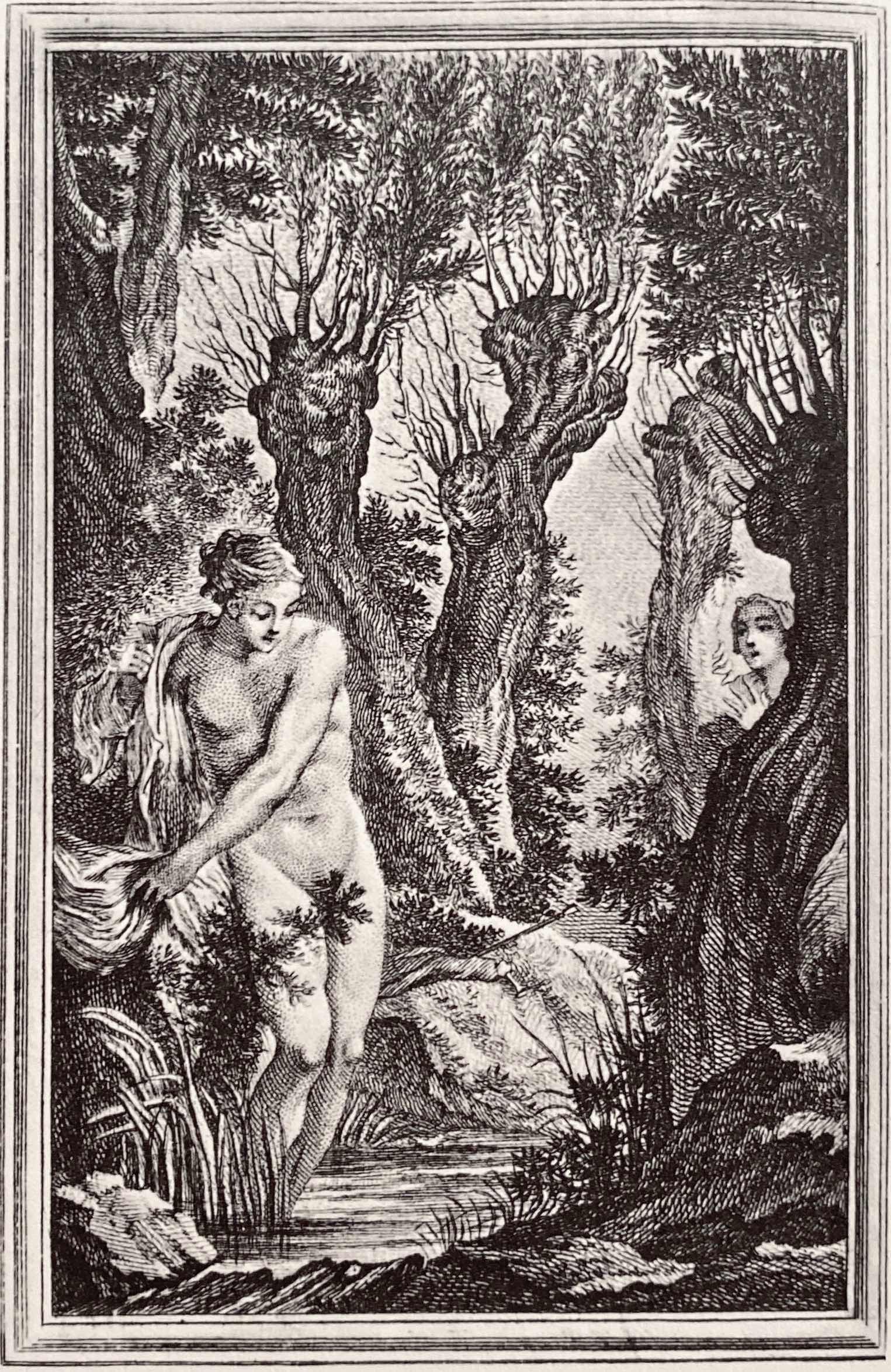 Contributors:
Jean de La Fontaine (French, 1621–1695) – author.
Fermiers généraux and Jean Baptiste Séroux d'Agincourt (French, 1730 – 1814) – publisher.
Joseph Gérard Barbou (French, 1723–1790) – printer.
Artists:
Charles Eisen (French, 1720 – 1778)
François Xavier Vispré (British-French, c.1730 – 1789 or after)
Hyacinthe Rigaud [Jacint Rigau-Ros i Serra] (Catalan-French, 1659 – 1743)
Engravers:
Joseph de Longueil (French, 1730 – 1792)
Noël Le Mire (French, 1724 – 1801)
Jean-Jacques André Le Veau (French, 1729 – 1786)
Jacques Aliamet (French, 1726 – 1788)
Jean Charles Baquoy (French, 1721 – 1777)
Pierre-Philippe Choffard (French, 1730 – 1809)
Jean Jacques Flipart (French, 1719 – 1782)
Louis Simon Lempereur (French, 1725 – 1796)
Jean Ouvrier (French, 1725 – 1784)
Contributors:
Jean de La Fontaine (French, 1621–1695) – author.
Fermiers généraux and Jean Baptiste Séroux d'Agincourt (French, 1730 – 1814) – publisher.
Joseph Gérard Barbou (French, 1723–1790) – printer.
Artists:
Charles Eisen (French, 1720 – 1778)
François Xavier Vispré (British-French, c.1730 – 1789 or after)
Hyacinthe Rigaud [Jacint Rigau-Ros i Serra] (Catalan-French, 1659 – 1743)
Engravers:
Joseph de Longueil (French, 1730 – 1792)
Noël Le Mire (French, 1724 – 1801)
Jean-Jacques André Le Veau (French, 1729 – 1786)
Jacques Aliamet (French, 1726 – 1788)
Jean Charles Baquoy (French, 1721 – 1777)
Pierre-Philippe Choffard (French, 1730 – 1809)
Jean Jacques Flipart (French, 1719 – 1782)
Louis Simon Lempereur (French, 1725 – 1796)
Jean Ouvrier (French, 1725 – 1784)
Étienne Ficquet (French 1719 – 1794)
Catalogue raisonné: Ray (French): №26, pp. 54-56; Cohen-DeRicci: 558-571; Lewine: 278-280. -
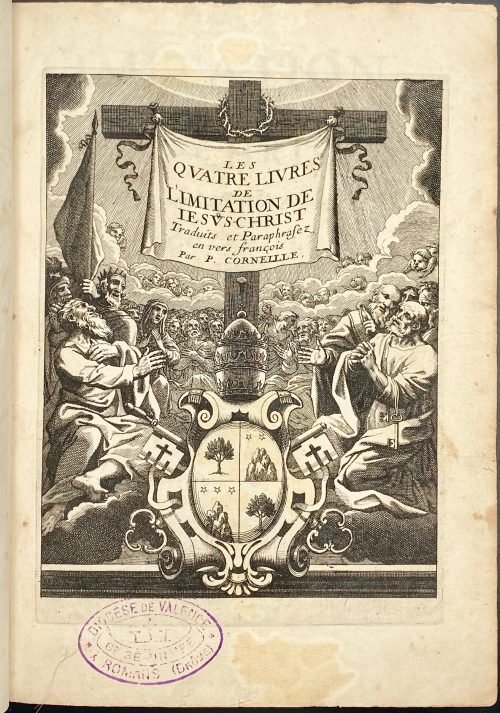 L'Imitation de Jésus-Christ / Traduite et paraphrasée en Vers François Par P. Corneille. — A Paris, Chez Pierre Rocolet, Imprimeur & Libraire ordinaire du Roy, au Palais, en la Gallerie des Prisonniers, aux Armes du Roy & de la Ville. M. DC. LVI. Avec Approbation des Docteurs, et Privelege de sa Majesté. Paris: Pierre Rocolet, 1656. Half-title: Les Quatre Livres de L'Imitation de Iesus-Christ. Traduites et paraphrasez en vers françois Par P. Corneille. — pp.: ff [2 pictorial ht, verso blank] [2 title, blank] [10 epistre] [2 av lecteur] [2 approbation, frontis.] 1-551 [552-60 table, privilege] bf. 8vo, 24.7 x 18.7 cm, hardcover; full speckled brown calf, gilt double-ruled boards, spine with raised bands, gilt double-ruled compartments with lozenges, sprayed margins; pages darkened. Purple ink stamp of Diocèse de Valencia to half-title. Nut ink ex libris handwriting on front paste-down. Plates: Half-title: unsigned copper engraving with the coat of arms of Pope Alexander VII (r. 1655 – 1667) which contains an oak tree in the top left and bottom right quarters (from Della Rovere family, Dukes of Urbino), the top right and bottom left quarters feature a mountain of six coupeaux in base with three stars above (from Chigi family). Four copper engravings inbound at the beginning of each book signed 'F. Chauueau in et fe.': Page 1: Jesus teaches His disciple. Page 113: Annunciation. Page 183: Jesus meets Simon called Peter and his brother Andrew. Page 459: Last Supper. François Chauveau (10 May 1613, Paris – 3 February 1676, Paris), a French painter and engraver. Thomas à Kempis (c. 1380 – 25 July 1471), a German-Dutch canon regular. Pierre Corneille (1606 – 1684), a French poet and playwright. Pierre Rocolet (1610 – 1662, active circa 1638 à 1662), a French publisher and printer.
L'Imitation de Jésus-Christ / Traduite et paraphrasée en Vers François Par P. Corneille. — A Paris, Chez Pierre Rocolet, Imprimeur & Libraire ordinaire du Roy, au Palais, en la Gallerie des Prisonniers, aux Armes du Roy & de la Ville. M. DC. LVI. Avec Approbation des Docteurs, et Privelege de sa Majesté. Paris: Pierre Rocolet, 1656. Half-title: Les Quatre Livres de L'Imitation de Iesus-Christ. Traduites et paraphrasez en vers françois Par P. Corneille. — pp.: ff [2 pictorial ht, verso blank] [2 title, blank] [10 epistre] [2 av lecteur] [2 approbation, frontis.] 1-551 [552-60 table, privilege] bf. 8vo, 24.7 x 18.7 cm, hardcover; full speckled brown calf, gilt double-ruled boards, spine with raised bands, gilt double-ruled compartments with lozenges, sprayed margins; pages darkened. Purple ink stamp of Diocèse de Valencia to half-title. Nut ink ex libris handwriting on front paste-down. Plates: Half-title: unsigned copper engraving with the coat of arms of Pope Alexander VII (r. 1655 – 1667) which contains an oak tree in the top left and bottom right quarters (from Della Rovere family, Dukes of Urbino), the top right and bottom left quarters feature a mountain of six coupeaux in base with three stars above (from Chigi family). Four copper engravings inbound at the beginning of each book signed 'F. Chauueau in et fe.': Page 1: Jesus teaches His disciple. Page 113: Annunciation. Page 183: Jesus meets Simon called Peter and his brother Andrew. Page 459: Last Supper. François Chauveau (10 May 1613, Paris – 3 February 1676, Paris), a French painter and engraver. Thomas à Kempis (c. 1380 – 25 July 1471), a German-Dutch canon regular. Pierre Corneille (1606 – 1684), a French poet and playwright. Pierre Rocolet (1610 – 1662, active circa 1638 à 1662), a French publisher and printer. -
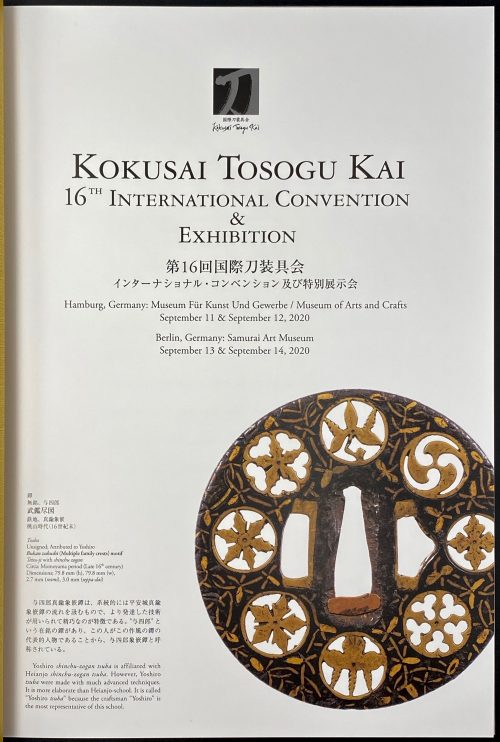 An annual publication of Kokusai Tosogu Kai / 16th International Convention & Exhibition in Hamburg, Germany: Museum Für Kunst Und Gewerbe / Museum of Arts and Crafts, September 11-12, 2020 and Berlin, Germany: Samurai Art Museum, September 13-14, 2020. Publisher: Tokyo: Kokusai Tosogu Kai, 2020. Pagination: [1-3] 4-103 [1]. Size: Medium 4to (30.3 x 21.6 cm), hardcover, original illustrated paper boards, in a slipcase. Tsuba from this collection depicted on the title page and pp. 59-60: TSU-0342.2017, TSU 0376.2018, and TSU 0379.2018. See also here.
An annual publication of Kokusai Tosogu Kai / 16th International Convention & Exhibition in Hamburg, Germany: Museum Für Kunst Und Gewerbe / Museum of Arts and Crafts, September 11-12, 2020 and Berlin, Germany: Samurai Art Museum, September 13-14, 2020. Publisher: Tokyo: Kokusai Tosogu Kai, 2020. Pagination: [1-3] 4-103 [1]. Size: Medium 4to (30.3 x 21.6 cm), hardcover, original illustrated paper boards, in a slipcase. Tsuba from this collection depicted on the title page and pp. 59-60: TSU-0342.2017, TSU 0376.2018, and TSU 0379.2018. See also here. -
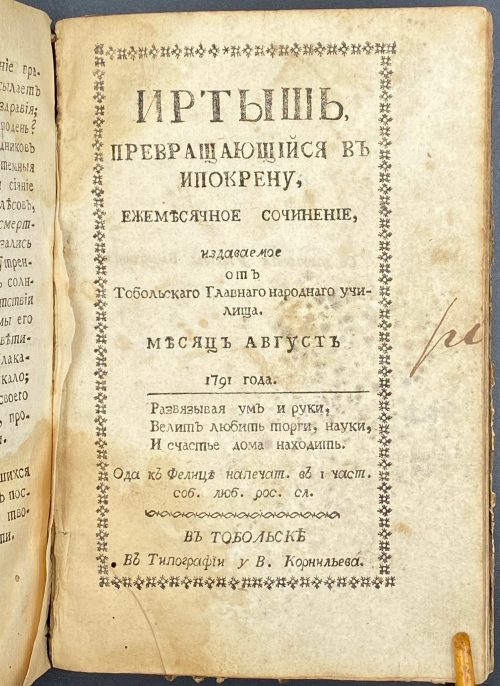 Конволют из 3-х номеров журнала "Иртыш, превращающийся в Ипокрену". Ежемесячное сочинение издаваемое от Тобольского Главного Народного Училища. — В типографии у В. Корнильева. — Тобольск: Тобольское главное народное училище, 1791 г. — 60, 62, 54 с. (Дореформ. орф.). July (Июль) 1791. — pp.: Missing title, table of content unpag., verso blank, [1] 2-60. June (Июнь) 1791. — pp.: Title with censor stat. on verso, table of content unpag., verso blank, [1] 2-62. August (Август) 1791. — pp.: Title, table of content unpag., verso blank, [1] 2-54. Bound in this order. "The Irtysh river turning into Hippocrene" was the first monthly magazine in Russian Siberia published in 1789 — 1791 in Tobolsk. It was featuring journalism, commentary, poetry, the fiction of provincial and metropolitan authors, as well as translations of various articles from foreign journals. It was published by Department of Tobolsk Public Education and printed in the establishment of Kornil'ev (Корнильев), a local merchant. The idea of publication belonged to Pankraty Sumarokov (1765 — 1814), a grandnephew of Alexander Sumarokov, distinguished Russian humanist and homme de lettres of Catherine the Great epoch. Pankraty was also the chief editor of the publication. Initially, the print run was 300 copies; reduced in 1791 to 106 copies only.
Конволют из 3-х номеров журнала "Иртыш, превращающийся в Ипокрену". Ежемесячное сочинение издаваемое от Тобольского Главного Народного Училища. — В типографии у В. Корнильева. — Тобольск: Тобольское главное народное училище, 1791 г. — 60, 62, 54 с. (Дореформ. орф.). July (Июль) 1791. — pp.: Missing title, table of content unpag., verso blank, [1] 2-60. June (Июнь) 1791. — pp.: Title with censor stat. on verso, table of content unpag., verso blank, [1] 2-62. August (Август) 1791. — pp.: Title, table of content unpag., verso blank, [1] 2-54. Bound in this order. "The Irtysh river turning into Hippocrene" was the first monthly magazine in Russian Siberia published in 1789 — 1791 in Tobolsk. It was featuring journalism, commentary, poetry, the fiction of provincial and metropolitan authors, as well as translations of various articles from foreign journals. It was published by Department of Tobolsk Public Education and printed in the establishment of Kornil'ev (Корнильев), a local merchant. The idea of publication belonged to Pankraty Sumarokov (1765 — 1814), a grandnephew of Alexander Sumarokov, distinguished Russian humanist and homme de lettres of Catherine the Great epoch. Pankraty was also the chief editor of the publication. Initially, the print run was 300 copies; reduced in 1791 to 106 copies only. -
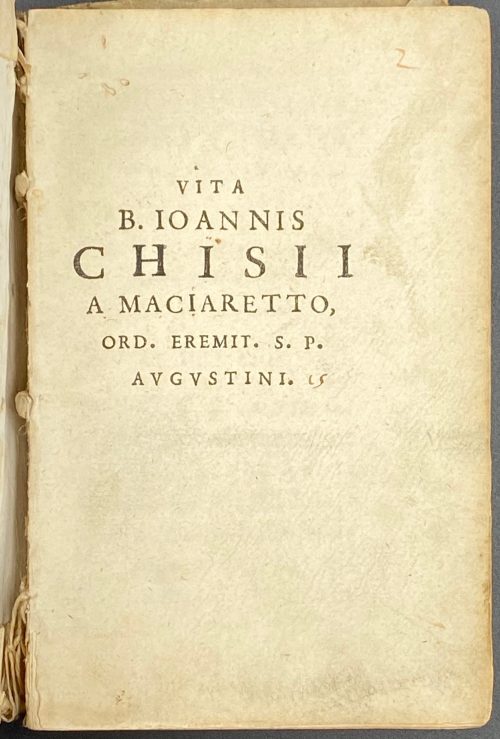 [Michael Hoyer]. Vita B. Ioannis Chisii a Maciaretto, ord. ermit. s. p. Augustini. — Antverpiæ, Apud Henricum Aertssens, Anno MDCXLI [1641]. Pagination: [2] *3+recto unpag. *4+recto unpag., [10], 5-135 [3]. Illustrations: Frontispiece missing, 4 copperplate engravings (pp. 22, 64, 90, and 120) by Pieter de Jode the Younger (1606–1674, Flemish printmaker, draughtsman, painter and art dealer) after Erasmus Quellinus the Younger (1607–1678, Flemish painter, engraver, draughtsman and tapestry designer). Size: Pott 8vo (15.5 x 10 cm), vellum binding. Expanded title: Vita Beati Ioannis Chisii, a Maciaretto, Ordinis Eremitarum Sancti Patris Augustini. [Translation: Life of Blessed Giovanni Chigi from Maciaretto, Order of Hermits of St. Augustine]. Blessed Giovanni Chigi (1300 - 1363) [1] was a lay brother of the Order of Hermits of St. Augustine. The Chigi family is a Roman princely family of Sienese extraction descended from the counts of Ardenghesca. The earliest authentic mention of them is in the 13th century, with one Alemanno, counsellor of the Republic of Siena. The Wikipedia article does not mention Giovanni Chigi, however, it states that one of the Chigi, Cardinal Fabio Chigi, was elected pope as Alexander VII at the Conclave of 1655. The book was published in 1641 with a dedication to the said Cardinal Fabio Chigi before he was elected pope. The town, Maciaretto, where Giovanni Chigi was from, is unclear because there is no such place in modern Italy, and there are two places called Macereto: (1) Macereto Alta/Basso in Perugia province and (2) Macereto in the municipality of Visso, in the province of Macerata, region Marche. I assume that our Giovanni Chigi was from the one that is closer to Siena, i.e. Macereto in Perugia province. Regarding the author. There is no author's name in the book. However, in various sources, the book is mentioned as written by Michel Hoyer, who was born in Hesdin, Flanders in 1593 and died in 1650. He pursued an ecclesiastical career and professed rhetoric at the College of Saint Pierre in Lille. He later joined the Order of Saint Augustine, in the convent of Ypres, and settled in various schools in the Netherlands. His reputation attracted many students, among them Albert Rubens (1614–1657), the eldest son of Peter Paul Rubens and Isabella Brant. Michel Hoyer wrote several books, the most known is Flammulae amoris, S.P. Augustini versibus et iconibus exornatae:
[Michael Hoyer]. Vita B. Ioannis Chisii a Maciaretto, ord. ermit. s. p. Augustini. — Antverpiæ, Apud Henricum Aertssens, Anno MDCXLI [1641]. Pagination: [2] *3+recto unpag. *4+recto unpag., [10], 5-135 [3]. Illustrations: Frontispiece missing, 4 copperplate engravings (pp. 22, 64, 90, and 120) by Pieter de Jode the Younger (1606–1674, Flemish printmaker, draughtsman, painter and art dealer) after Erasmus Quellinus the Younger (1607–1678, Flemish painter, engraver, draughtsman and tapestry designer). Size: Pott 8vo (15.5 x 10 cm), vellum binding. Expanded title: Vita Beati Ioannis Chisii, a Maciaretto, Ordinis Eremitarum Sancti Patris Augustini. [Translation: Life of Blessed Giovanni Chigi from Maciaretto, Order of Hermits of St. Augustine]. Blessed Giovanni Chigi (1300 - 1363) [1] was a lay brother of the Order of Hermits of St. Augustine. The Chigi family is a Roman princely family of Sienese extraction descended from the counts of Ardenghesca. The earliest authentic mention of them is in the 13th century, with one Alemanno, counsellor of the Republic of Siena. The Wikipedia article does not mention Giovanni Chigi, however, it states that one of the Chigi, Cardinal Fabio Chigi, was elected pope as Alexander VII at the Conclave of 1655. The book was published in 1641 with a dedication to the said Cardinal Fabio Chigi before he was elected pope. The town, Maciaretto, where Giovanni Chigi was from, is unclear because there is no such place in modern Italy, and there are two places called Macereto: (1) Macereto Alta/Basso in Perugia province and (2) Macereto in the municipality of Visso, in the province of Macerata, region Marche. I assume that our Giovanni Chigi was from the one that is closer to Siena, i.e. Macereto in Perugia province. Regarding the author. There is no author's name in the book. However, in various sources, the book is mentioned as written by Michel Hoyer, who was born in Hesdin, Flanders in 1593 and died in 1650. He pursued an ecclesiastical career and professed rhetoric at the College of Saint Pierre in Lille. He later joined the Order of Saint Augustine, in the convent of Ypres, and settled in various schools in the Netherlands. His reputation attracted many students, among them Albert Rubens (1614–1657), the eldest son of Peter Paul Rubens and Isabella Brant. Michel Hoyer wrote several books, the most known is Flammulae amoris, S.P. Augustini versibus et iconibus exornatae: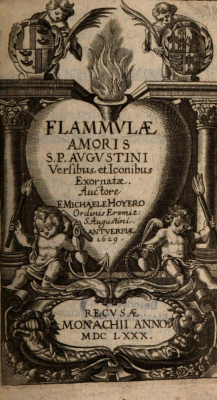 Surprisingly, there is only limited information about Michel Hoyer in Spanish Wikipedia; other language versions of his biography do not exist. Another author mentioned in the book is some anonymous Augustinian from Cologne.
Regarding the illustrations. In our copy, the frontispiece is missing. It was probably ripped off by some unscrupulous seller of antique prints.
The image on the missing frontispiece is this:
Surprisingly, there is only limited information about Michel Hoyer in Spanish Wikipedia; other language versions of his biography do not exist. Another author mentioned in the book is some anonymous Augustinian from Cologne.
Regarding the illustrations. In our copy, the frontispiece is missing. It was probably ripped off by some unscrupulous seller of antique prints.
The image on the missing frontispiece is this:
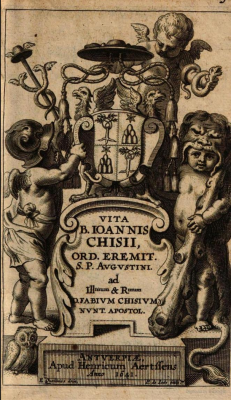 The names of the artists engraved in the bottom of the stone: E. Quellinus, delin. to the left and P. de Jode, fecit. to the right. We can infer that the other illustrations in that book are produced by the same duo. The image represents three cherubs: one with Athena's serpent in his left hand and a cardinal's hat in his right hand; another in Athen's helmet on his head and her owl beside his feet, with the staff of Mercurius (serpent-twined staff adorned with a winged hat) in his left hand, and the House of Chigi - Della Rovere coat of arms in his right hand; the third cherub depicted with the Hercules attributes - lion pelt and a club.
Regarding the publisher. Henricum Aertssens or Hendrik Aertssen, 1586-1658. Besides the other books, he published PIA DESIDERIA by Herman Hugo in 1636 [1621 french edition by Jean Cnobbartin in Antwerp in his collection LIB-1657.2018]. According to Nina Lamal [2], nothing is known about career of this publisher, besides what's said in Adresboek van zeventiende-eeuwse drukkers, uitgevers en boekverkopers in Vlaanderen / Directory of seventeenth-century Printers, Publishers and Booksellers in Flanders / Vlieger-De Wilde, Koen De (editor). The list of his publications can be seen here.
Other artists who turned to the figure of Blessed Giovanni Chigi were Abraham van Diepenbeeck (painter) and Conrad Lauwers (engraver). The print is in Rijksmuseum, in Amsterdam.
The names of the artists engraved in the bottom of the stone: E. Quellinus, delin. to the left and P. de Jode, fecit. to the right. We can infer that the other illustrations in that book are produced by the same duo. The image represents three cherubs: one with Athena's serpent in his left hand and a cardinal's hat in his right hand; another in Athen's helmet on his head and her owl beside his feet, with the staff of Mercurius (serpent-twined staff adorned with a winged hat) in his left hand, and the House of Chigi - Della Rovere coat of arms in his right hand; the third cherub depicted with the Hercules attributes - lion pelt and a club.
Regarding the publisher. Henricum Aertssens or Hendrik Aertssen, 1586-1658. Besides the other books, he published PIA DESIDERIA by Herman Hugo in 1636 [1621 french edition by Jean Cnobbartin in Antwerp in his collection LIB-1657.2018]. According to Nina Lamal [2], nothing is known about career of this publisher, besides what's said in Adresboek van zeventiende-eeuwse drukkers, uitgevers en boekverkopers in Vlaanderen / Directory of seventeenth-century Printers, Publishers and Booksellers in Flanders / Vlieger-De Wilde, Koen De (editor). The list of his publications can be seen here.
Other artists who turned to the figure of Blessed Giovanni Chigi were Abraham van Diepenbeeck (painter) and Conrad Lauwers (engraver). The print is in Rijksmuseum, in Amsterdam.
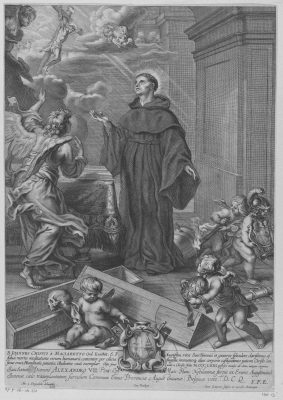 Here we see a more complex composition but with a clear reference to the work of Quellinus and de Jode: The cherub in Athena's helmet takes away the old coat of arms of the Chigi, and the other cherub points out to the new one, with papal symbols of St. Peter's keys, another cherub carries the papal tiara. Rijksmuseum dates the image as 1642 - 1685; most probably it is ca. 1655, when Fabio Chigi became Pope Alexander VII, and propaganda was focused on promoting his outstanding ancestor Giovanni, who died 300 years before. Giovanni Chigi is depicted here resurrected, accompanied by the archangel, and receiving the blessing from Jesus on the cross.
1 - Michael J. Walsh. A New Dictionary of Saints: East and West, p. 308.
2 - Nina Lamal. Publishing military books in the Low Countries and in Italy in the early seventeenth century in 'Specialist Markets in the Early Modern Book World', ed. Richard Kirwan, Sophia Mullins, Leiden: Koninklijke Brill, 2015, pp. 232-233.
Here we see a more complex composition but with a clear reference to the work of Quellinus and de Jode: The cherub in Athena's helmet takes away the old coat of arms of the Chigi, and the other cherub points out to the new one, with papal symbols of St. Peter's keys, another cherub carries the papal tiara. Rijksmuseum dates the image as 1642 - 1685; most probably it is ca. 1655, when Fabio Chigi became Pope Alexander VII, and propaganda was focused on promoting his outstanding ancestor Giovanni, who died 300 years before. Giovanni Chigi is depicted here resurrected, accompanied by the archangel, and receiving the blessing from Jesus on the cross.
1 - Michael J. Walsh. A New Dictionary of Saints: East and West, p. 308.
2 - Nina Lamal. Publishing military books in the Low Countries and in Italy in the early seventeenth century in 'Specialist Markets in the Early Modern Book World', ed. Richard Kirwan, Sophia Mullins, Leiden: Koninklijke Brill, 2015, pp. 232-233.


